Search Result
Results for "
emission
" in MedChemExpress (MCE) Product Catalog:
16
Biochemical Assay Reagents
| Cat. No. |
Product Name |
Target |
Research Areas |
Chemical Structure |
-
- HY-W140203
-
|
|
Fluorescent Dye
|
Others
|
|
2-(2′-Hydroxyphenyl)benzimidazole is some of the most extensively studied excited state intramolecular proton transfer (ESIPT) molecules exhibiting normal and tautomer emissions. 2-(2′-Hydroxyphenyl)benzimidazole has been applied as a fluorescent probe in various systems .
|
-
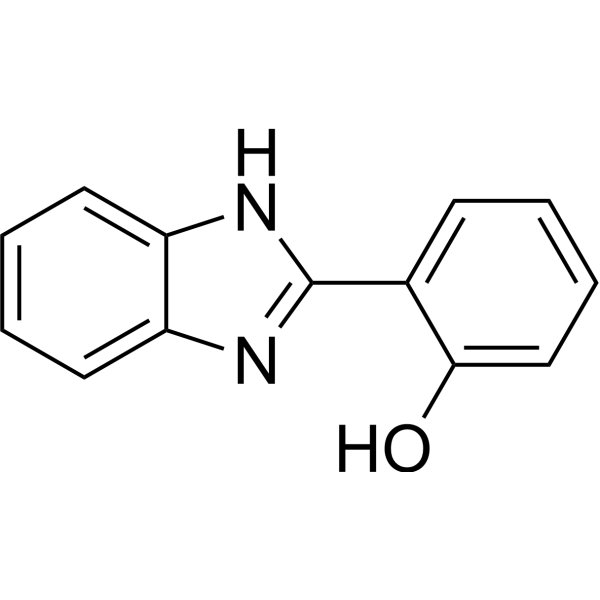
-
- HY-160607
-
|
|
Others
|
Others
|
|
MMA-NODAGA is a chelator for site-specific labeling of targeting proteins containing unpaired cysteine. MMA-NODAGA can be used to conjugate with exosome and 64Cu in image with positron emission tomography (PET) <[2].
|
-
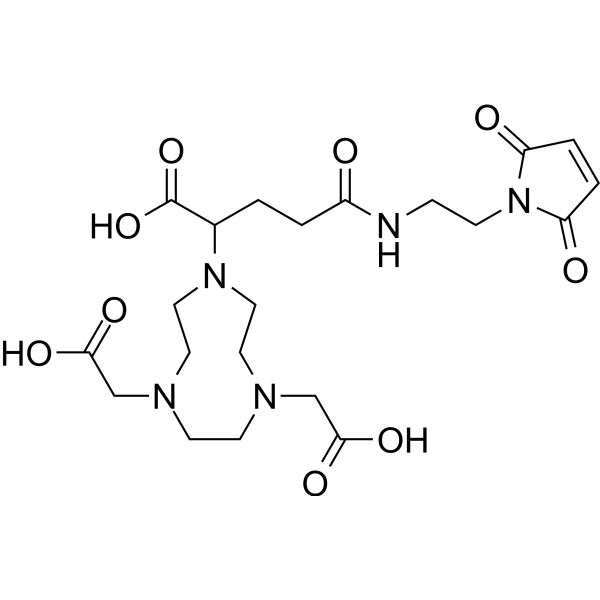
-
- HY-W110781
-
|
|
DNA Stain
|
Others
|
|
Basic Blue 20 is a very convenient red-emitting DNA stains. Basic Blue 20 has relatively narrow excitation and emission spectra, with peaks at 633 and 677 nm, respectively. Basic Blue 20 also has a very high resistance to photobleaching .
|
-
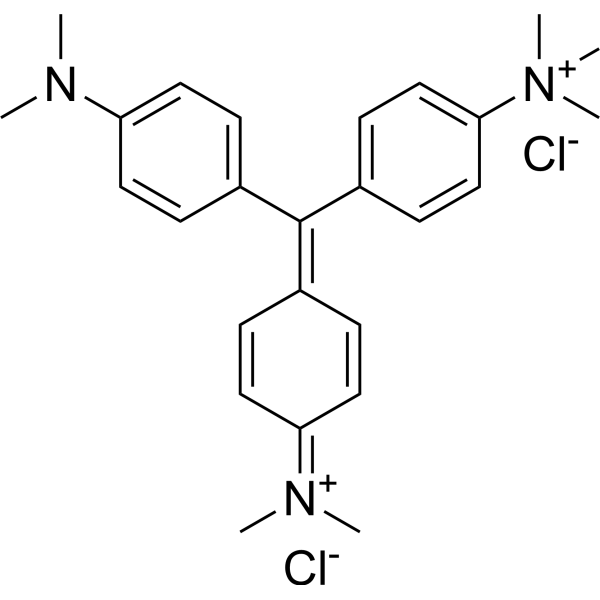
-
- HY-D1067
-
|
|
Fluorescent Dye
|
Others
|
|
NIR dye-1 (Compound 1h) is a near-infrared (NIR) fluorescent dye. NIR dye-1 has absorption and emission in the NIR region, while retaining an optically tunable hydroxyl group .
|
-
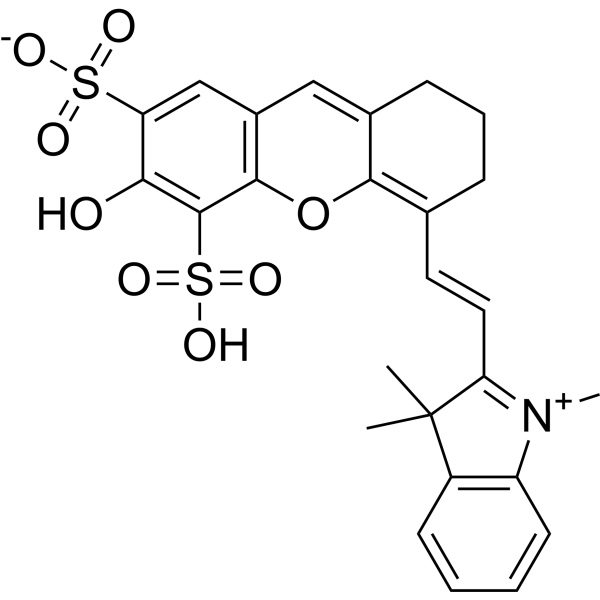
-
- HY-149766
-
|
|
HDAC
|
Neurological Disease
|
|
PB94 is a selective HDAC11 inhibitor (IC50=108 nM). PB94 can be radiolabeled as [11C]-PB94 for use in positron emission tomography (PET), as well as brain uptake and metabolic properties in administered live animals. PB94 improves neuropathic pain in mice and could be used to study neurological indications .
|
-

-
- HY-119190
-
|
|
Phosphodiesterase (PDE)
|
Neurological Disease
|
|
PF-06445974, a promising positron emission tomography (PET) lead, has exquisite potency at PDE4B with an IC50 <1 nM. The IC50 values are 36, 4.7 and 17 nM for PDE4D, PDE4A and PDE4C, respectively. PF-06445974 has good selectivity over PDE4D, excellent brain permeability, and a high level of specific binding in the "cold tracer" study .
|
-
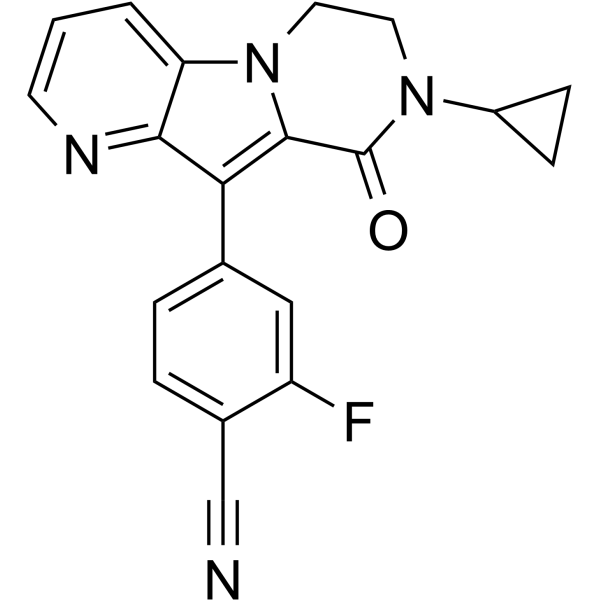
-
- HY-117756
-
|
DCFPYL
|
PSMA
|
Others
|
|
Piflufolastat (DCFPYL) can be used to the preparation of piflufolastat F 18 (DCFPyL F-18). piflufolastat F 18. Piflufolastat F-18 is an 18F-labelled diagnostic imaging agent. Piflufolastat F-18 can be used for positron emission tomography (PET) that targets prostate-specific membrane antigen (PSMA) .
|
-
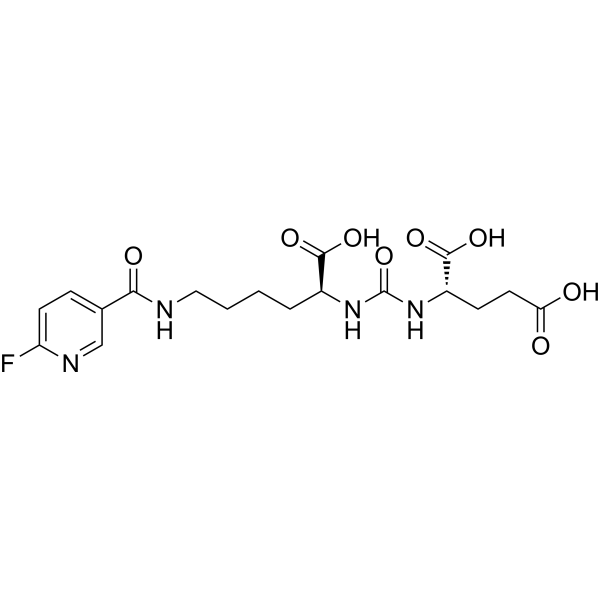
-
- HY-152152
-
|
|
MAGL
|
Neurological Disease
|
|
JZP-MA-13 is a selective α/β-hydrolase domain 6 (ABHD6) inhibitor with an IC50 of 392 nM. JZP-MA-13 shows no inhibition of MAGL, ABHD12, FAAH, or other serine hydrolases. JZP-MA-13 is a positron emission tomography (PET) ligand for in vivo imaging of the ABHD6 .
|
-
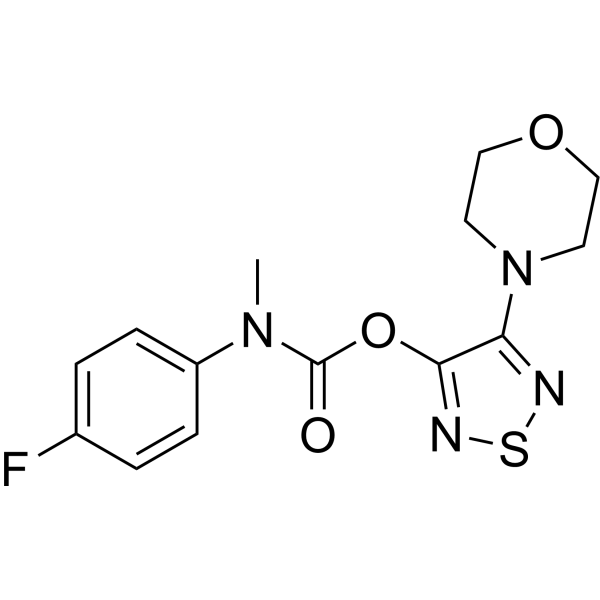
-
- HY-W728451
-
|
|
FAAH
|
Cardiovascular Disease
Neurological Disease
|
|
URB694 is a carbamate FAAH inhibitor that irreversibly carbamoylate the nucleophile catalytic serine in FAAH active site. URB694 exhibits antidepressant-like activity and cardioprotective effects. URB694 can be used to prepare 11C-Carbonyl-URB694 for in vivo positron emission tomography (PET) imaging studies of the brain FAAH .
|
-
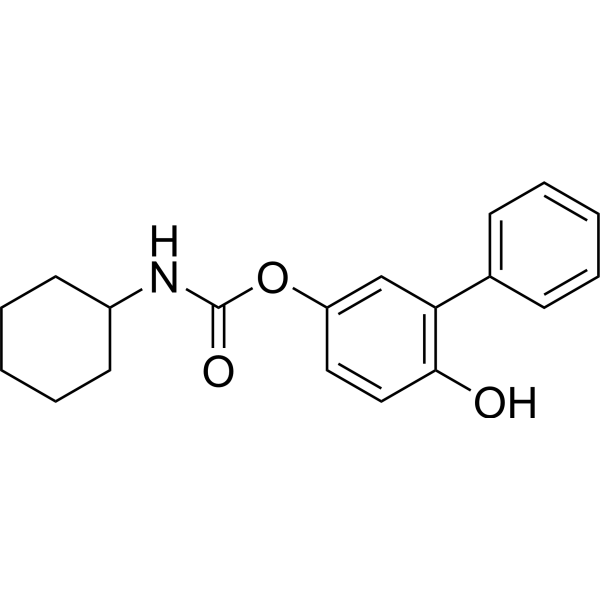
-
- HY-D1468
-
|
|
Reactive Oxygen Species
|
Cancer
|
|
Phototherapeutic agent-1 is a multi-modal light diagnosis agent with aggregation-induced emission properties. have certain Phototherapeutic agent-1 has certain reactive oxygen species (ROS) generation capacity in illumination condition. Phototherapeutic agent-1 can effectively kill cancer cells and tumor tissue .
|
-
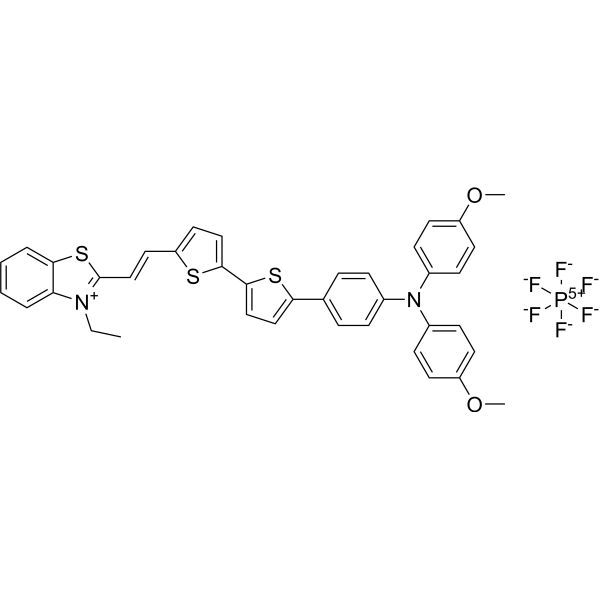
-
- HY-D1251
-
|
|
Fluorescent Dye
|
Others
|
|
TRFS-red, a red fluorescence emission off-on probe, is selective for thioredoxin reductase (TrxR). TRFS-red exhibits high response rate and sensitivity. TRFS-red can be used for imaging live cells .
|
-
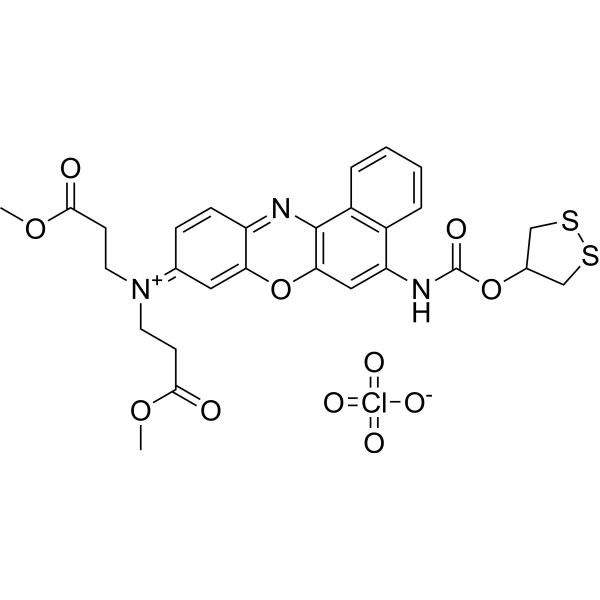
-
- HY-123012
-
|
LY-488756
|
Adrenergic Receptor
|
Others
|
|
Lubabegron is a potent modulator of β-adrenergic receptor (β -AR). Lubabegron demonstrates antagonistic behavior at the β1 and β 2 receptor subtypes and agonistic behavior at the β 3 receptor subtype in cattle. Lubabegron reduces NH3 gas emissions from an animal or its waste .
|
-
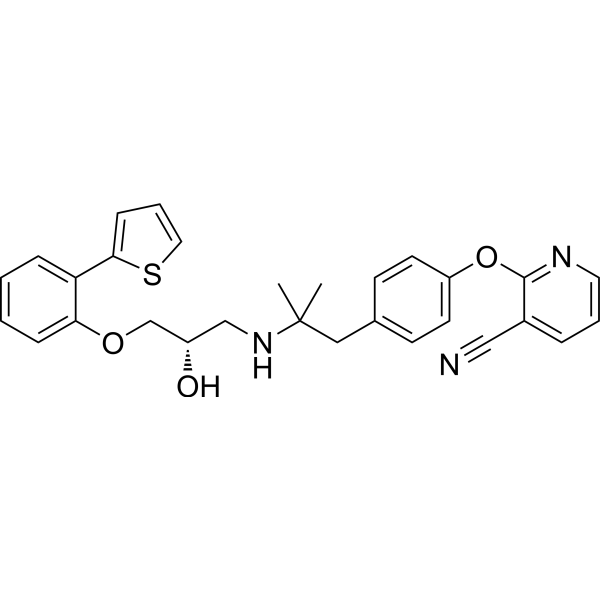
-
- HY-146180
-
|
|
FAP
|
Cancer
|
|
FSDD0I is an albumin-binding fibroblast activation protein (FAP) ligand. FSDD0I can be labeled with 68Ga and 177Lu for single photon emission computed tomography (SPECT) imaging .
|
-

-
- HY-146181
-
|
|
FAP
|
Cancer
|
|
FSDD1I is an albumin-binding fibroblast activation protein (FAP) ligand. FSDD1I can be labeled with 68Ga and 177Lu for single photon emission computed tomography (SPECT) imaging .
|
-
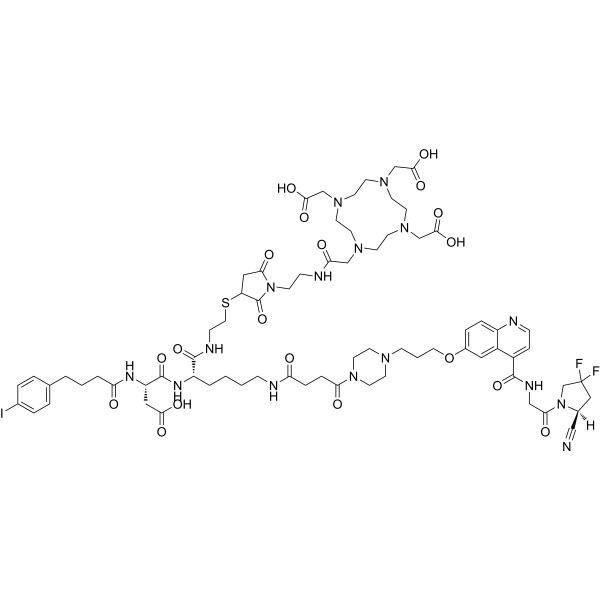
-
- HY-146182
-
|
|
FAP
|
Cancer
|
|
FSDD3I is an albumin-binding fibroblast activation protein (FAP) ligand. FSDD3I can be labeled with 68Ga and 177Lu for single photon emission computed tomography (SPECT) imaging .
|
-
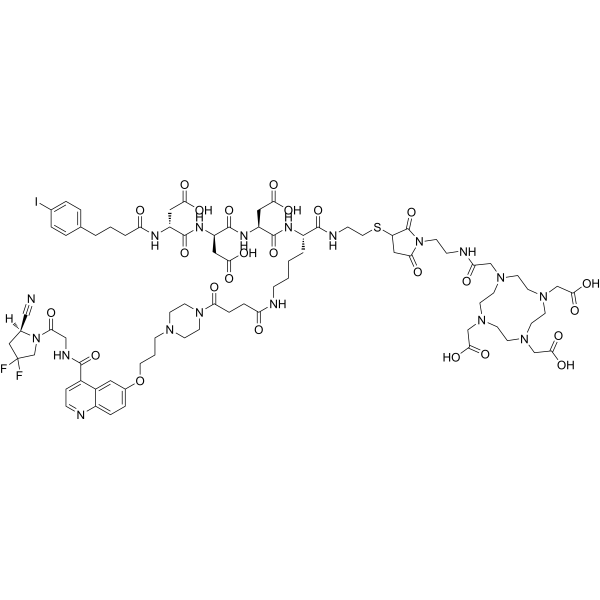
-
- HY-139048
-
|
|
iGluR
|
Neurological Disease
|
|
Fluoroethylnormemantine, a derivative of Memantine, is an antagonist of the N-methyl-D-aspartate (NMDA) receptor. [ 18F]-Fluoroethylnormemantine can be used as a positron emission tomography (PET) tracer. Fluoroethylnormemantine exhibits anti-amnesic, neuroprotective, antidepressant-like and fear-attenuating effects .
|
-
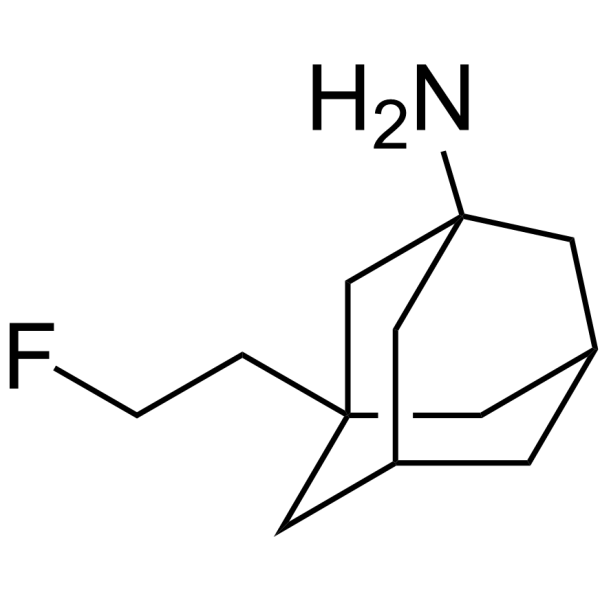
-
- HY-139048A
-
|
|
iGluR
|
Neurological Disease
|
|
Fluoroethylnormemantine hydrochloride, a derivative of Memantine, is an antagonist of the N-methyl-D-aspartate (NMDA) receptor. [ 18F]-Fluoroethylnormemantine hydrochloride can be used as a positron emission tomography (PET) tracer. Fluoroethylnormemantine hydrochloride exhibits anti-amnesic, neuroprotective, antidepressant-like and fear-attenuating effects .
|
-
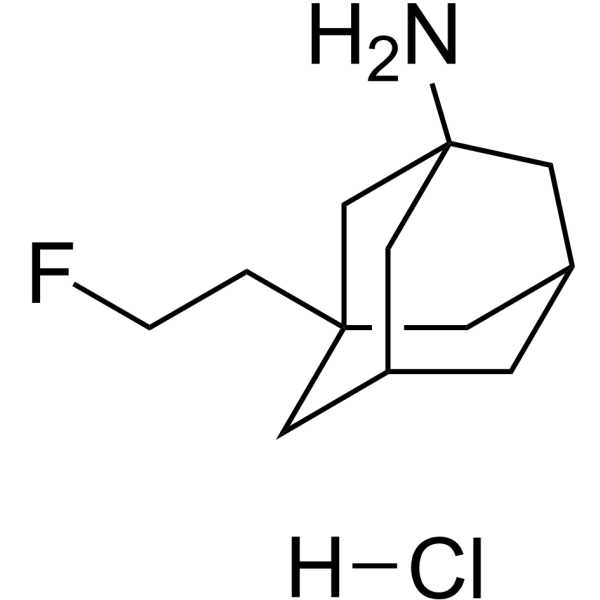
-
- HY-146102
-
|
|
mAChR
|
Others
|
|
M1 ligand 1 (compound 3b-b) is a muscarinic acetylcholine receptor M1 ligand. M1 ligand 1 is a N-desmethyl congener of arecoline derivative. M1 ligand 1 can be used as PET (positron emission tomography) radiotracer .
|
-

-
- HY-D1682
-
|
|
Fluorescent Dye
|
Others
|
|
NFQ1 is a non-fluorescent quencher (absorption wavelength: 474 nm), and is used for a new type of One Sample Fluorescence Resonance Energy Transfer (OS-FRET) method. OS-FRET enable measurement of unquenched donor emission in the same sample. NFQ1 shows broad absorption spectrum ensuring its utility as a dark acceptor for many donors .
|
-
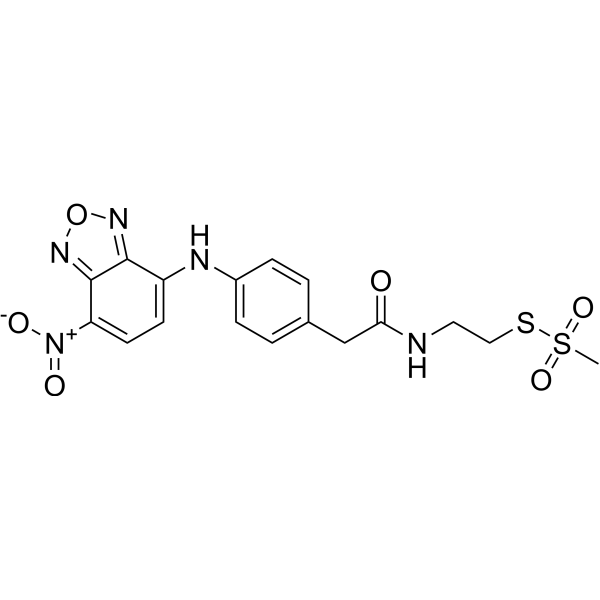
-
- HY-151468
-
|
|
Others
|
Others
|
|
AIECbz-LD-C7 is an aggregation-induced emission (AIE) probe based on the conjugation of quinoline-malononitrile (QM) and carbazole. AIECbz-LD-C7 has excellent LD-specificity. AIECbz-LD-C7 can be used for tracking the dynamic changes of LDs and studying the association between LDs and lysosome/endoplasmic reticulum (ER) .
|
-
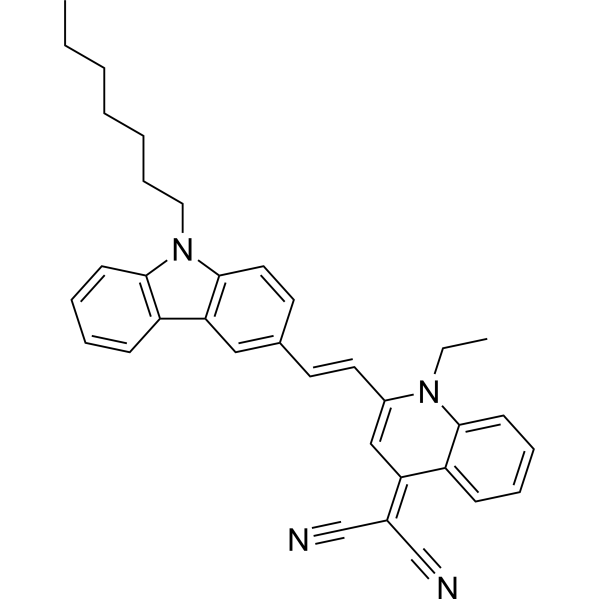
-
- HY-75706
-
|
|
E3 Ligase Ligand-Linker Conjugates
PARP
|
Cancer
|
|
N-Descyclopropanecarbaldehyde Olaparib is an analogue of Olaparib containing DOTA moiety. N-Descyclopropanecarbaldehyde Olaparib is a CRBN-based ligand for synthesizing novel dual EGFR and PARP PROTAC, DP-C-4 . N-Descyclopropanecarbaldehyde Olaparib can be radiolabeled F-18 or fluorophore for positron emission tomography (PET) or optical imaging in several types of tumor .
|
-

-
- HY-D1456
-
|
|
Pyruvate Kinase
|
Cancer
|
|
TEPC466 is a novel TEPP-46-based aggregation-induced emission (AIE) probe. TEPC466 shows a high degree of selectivity and sensitivity for the detection of PKM2 protein via the AIE effect. EPC466 can be used for the detection of PKM2. TEPC466 is successfully applied in imaging the PKM2 protein in colorectal cancer cells with low toxicity. TEPC466 is a useful tool for cancer diagnosis and research .
|
-
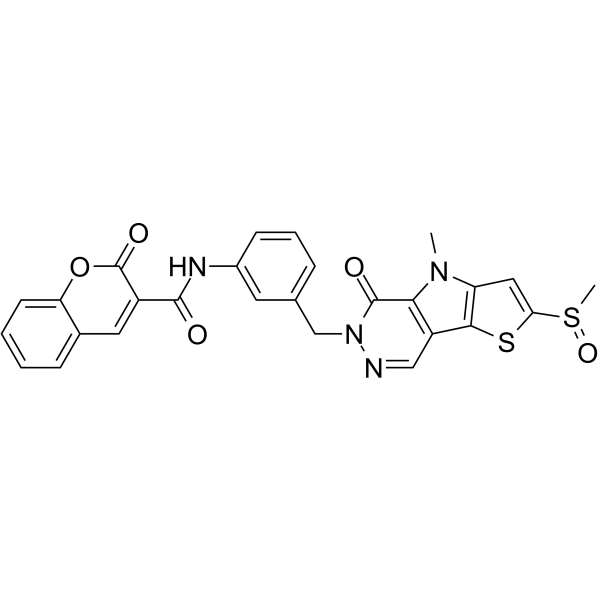
-
- HY-120993
-
|
1,N6-Etheno-AMP sodium; 1,N6-ε-AMP sodium
|
Fluorescent Dye
|
Others
|
|
1,N6-Ethenoadenosine 5'-monophosphate (1,N6-Etheno-AMP) sodium is a highly fluorescent analog of adenosine 5'-monophosphate (AMP). 1,N6-Ethenoadenosine 5'-monophosphate sodium is a powerful probe for systems involving adenosine 5'-monophosphate and can be detected at low concentration. 1,N6-Ethenoadenosine 5'-monophosphate sodium has long wavelength of excitation (250-300 nm), and emission at 415 nm .
|
-

-
- HY-151536
-
|
|
Fluorescent Dye
|
Neurological Disease
|
|
meso-Benzothiazole-BODIPY 505/515 is a boron dipyrromethenes (BODIPY) -based fluorescent probeemission (AIE) properties. meso-Benzothiazole-BODIPY 505/515 can monitor cellular viscosity changes and autophagy. meso-Benzothiazole-BODIPY 505/515 can be used for the research of Alzheimer’s diseases, lysosomal storage diseases and neural degeneration diseases .
|
-

-
- HY-152148
-
|
|
MAGL
|
Neurological Disease
|
|
JZP-MA-11 is a positron emission tomography (PET) ligand targeting the endocannabinoid α/β-hydrolase domain 6 (ABHD6) enzyme. JZP-MA-11 selectively inhibits ABHD6 with an IC50 value of 126 nM. JZP-MA-11 can cross the blood-brain barrier (BBB). [18F]JZP-MA-11 has the potential for preclinical evaluation targeting the brain ABHD6 in mice and nonhuman primate (NHP) .
|
-
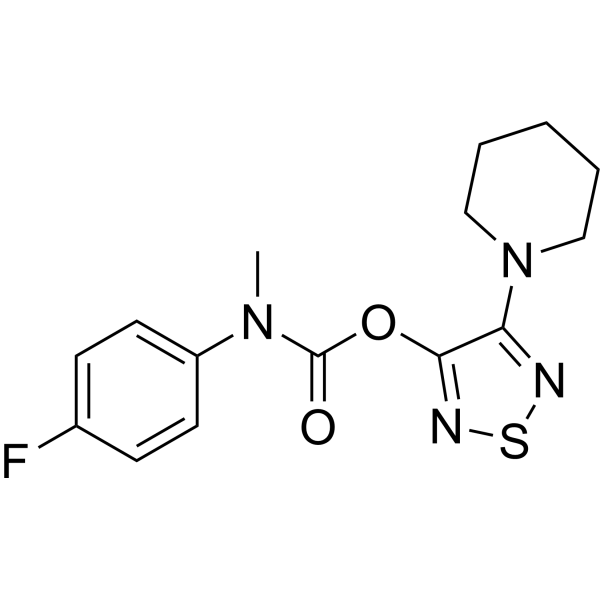
-
- HY-101184
-
-
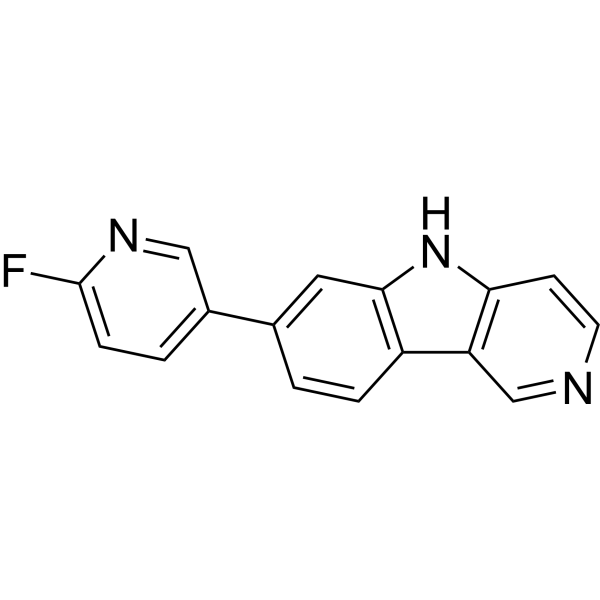
-
- HY-139673
-
|
|
Fluorescent Dye
|
Others
|
|
BG dimer is a molecular dimer organic luminogen with aggregation-induced emission.
|
-
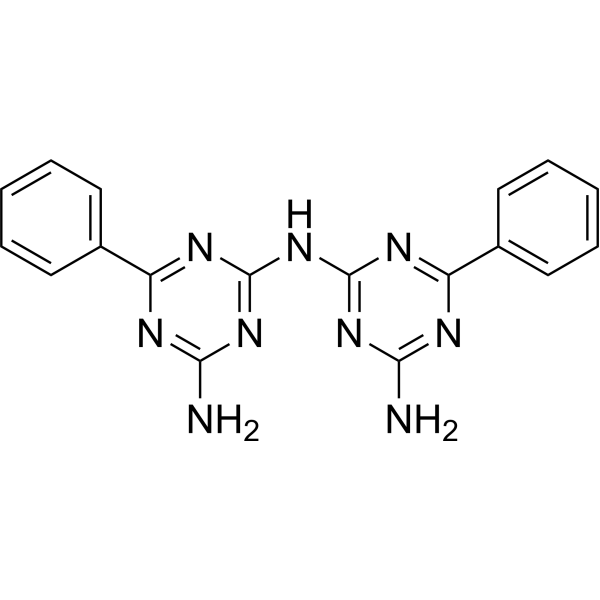
-
- HY-133532
-
|
Ocean Blue, SE
|
Fluorescent Dye
|
Others
|
|
PB succiniMidyl ester (Ocean Blue, SE) is a fluorophore with the λexcitation/emission of ~405/455 nm .
|
-
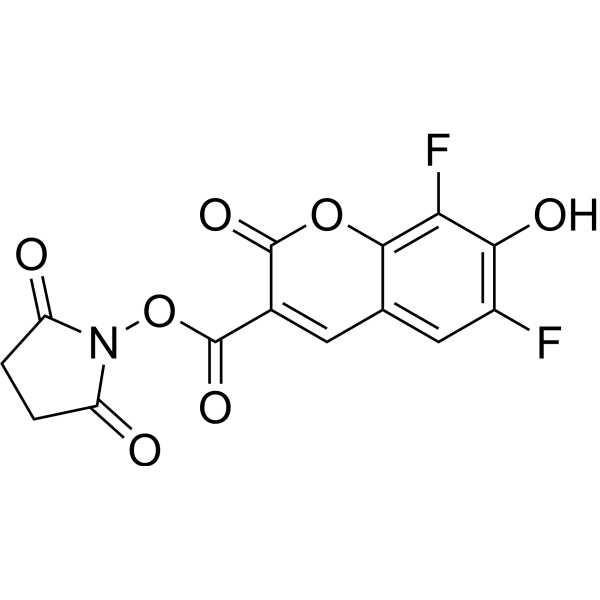
-
- HY-D1662
-
|
BODIPY 558/568SE
|
Fluorescent Dye
|
Others
|
|
BDP 558/568 NHS ester is a borondipyrromethene fluorophore with emission in the yellow part of the spectrum. BDP 558/568 NHS ester is an amine reactive NHS ester, and the absorption and emission spectra of BDP 558/568 NHS ester are similar with TAMRA, BDP TMR, Cyanine3, and sulfo-Cyanine3 .
|
-
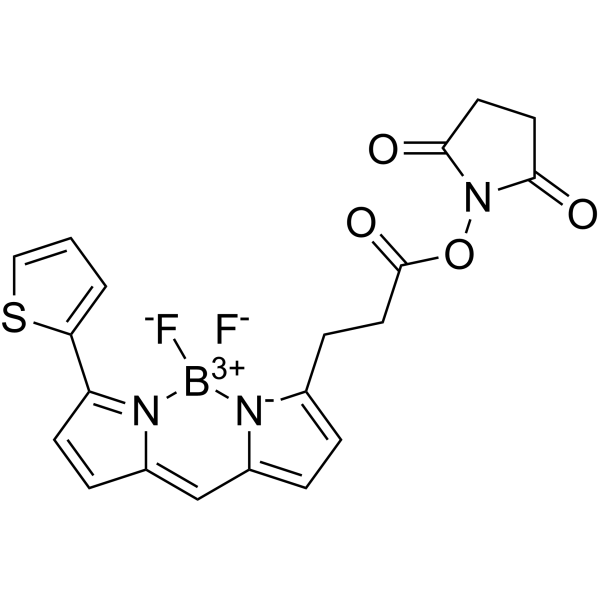
-
- HY-D1483
-
|
|
Fluorescent Dye
|
Others
|
|
3,3-Dibutylthiacarbocyanine iodide is a fluorescent dye with an excitation of 559 nm and an emission 604 nm .
|
-

-
- HY-D1499
-
|
|
Fluorescent Dye
|
Others
|
|
Fluorescent red 610 is a fluorescent dye with an excitation peak at 590 nm and an emission peak at 610 nm .
|
-

-
- HY-D1922
-
|
|
Fluorescent Dye
|
Others
|
|
ATTO 390 streptavidin is a streptavidin derivative of ATTO 390 with excitation/emission maxima at 390/476 nm.
|
-
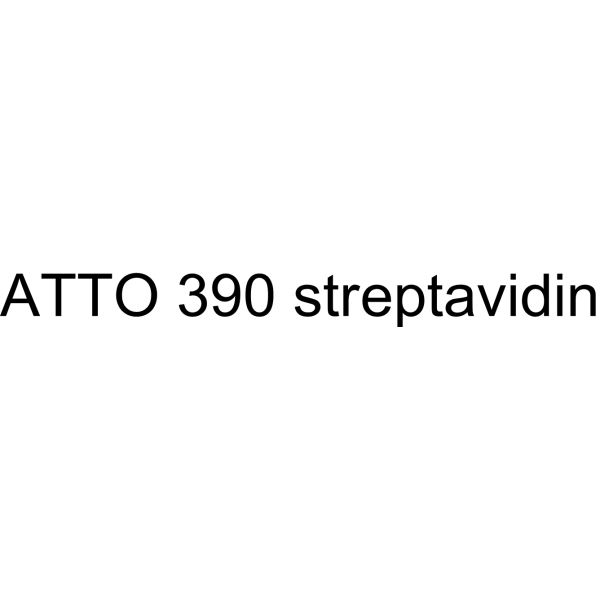
-
- HY-D1953
-
|
|
Fluorescent Dye
|
Others
|
|
ATTO 594 Azide is an azide derivative of ATTO 594 with excitation/emission maxima at 603/626 nm.
|
-

-
- HY-D1967
-
|
|
Fluorescent Dye
|
Others
|
|
ATTO 633 Azide is an azide derivative of ATTO 520 with excitation/emission maxima at 630/651 nm.
|
-

-
- HY-D1981
-
|
|
Fluorescent Dye
|
Others
|
|
ATTO 633 Iodacetamid is an iodoacetamide derivative of ATTO 594 with excitation/emission maxima at 630/651 nm.
|
-
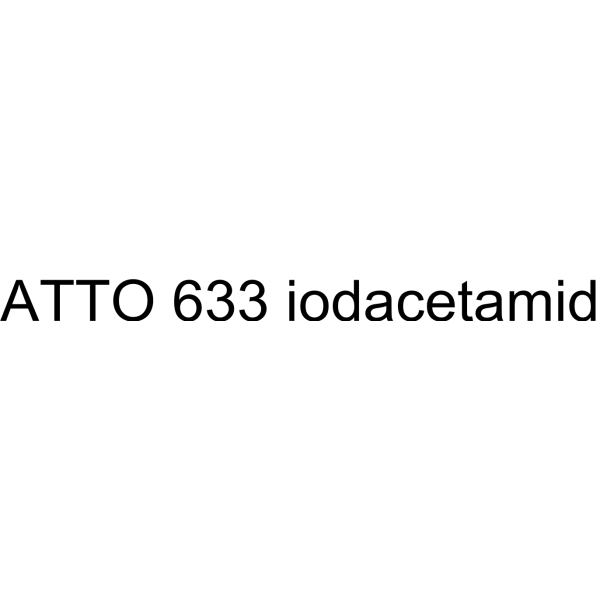
-
- HY-D1984
-
|
|
Fluorescent Dye
|
Others
|
|
ATTO 633 Alkin is an alkyne derivative of ATTO 594 with excitation/emission maxima at 630/651 nm.
|
-
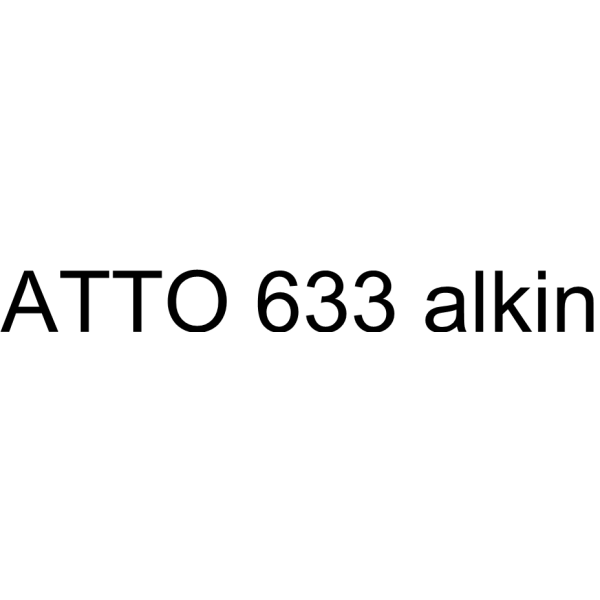
-
- HY-D1990
-
|
|
Fluorescent Dye
|
Others
|
|
ATTO 620 Azide is an azide derivative of ATTO 520 with excitation/emission maxima at 620/642 nm.
|
-

-
- HY-D2006
-
|
|
Fluorescent Dye
|
Others
|
|
ATTO 565 azide is an azide derivative of ATTO 565 with excitation/emission maxima at 564/590 nm.
|
-

-
- HY-D2013
-
|
|
Fluorescent Dye
|
Others
|
|
ATTO 488 hydrazid is a hydrazide derivative of ATTO 488 with excitation/emission maxima at 500/520 nm.
|
-

-
- HY-D2079
-
|
|
Fluorescent Dye
|
Others
|
|
ATTO 665 azide is an azide derivative of ATTO 665 with excitation/emission maxima at 663/680 nm.
|
-

-
- HY-145241
-
|
|
Others
|
Neurological Disease
|
|
TBTDC is a highly efficient multifunctional organic photosensitizer with aggregation-induced emission for in vivo bioimaging and photodynamic research.
|
-

-
- HY-D1919
-
|
|
Fluorescent Dye
|
Others
|
|
ATTO 390 amine is a biotin derivative of ATTO 390 with maximum excitation/emission wavelengths: 390/476 nm.
|
-

-
- HY-D1921
-
|
|
Fluorescent Dye
|
Others
|
|
ATTO 390 iodoacetamide is the iodoacetamide derivative of ATTO 390, the maximum excitation/emission wavelength: 390/476 nm.
|
-
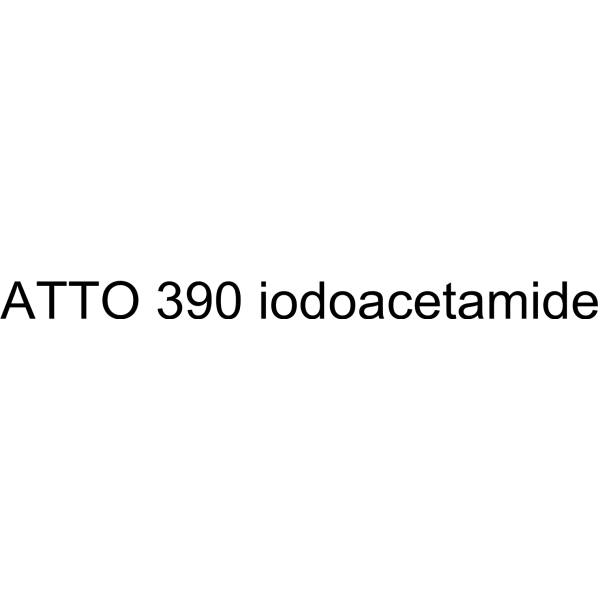
-
- HY-D1926
-
|
|
Fluorescent Dye
|
Others
|
|
ATTO 425 Streptavidin is a streptavidin derivative of ATTO 425, the maximum excitation emission wavelength: 439/489 nm.
|
-
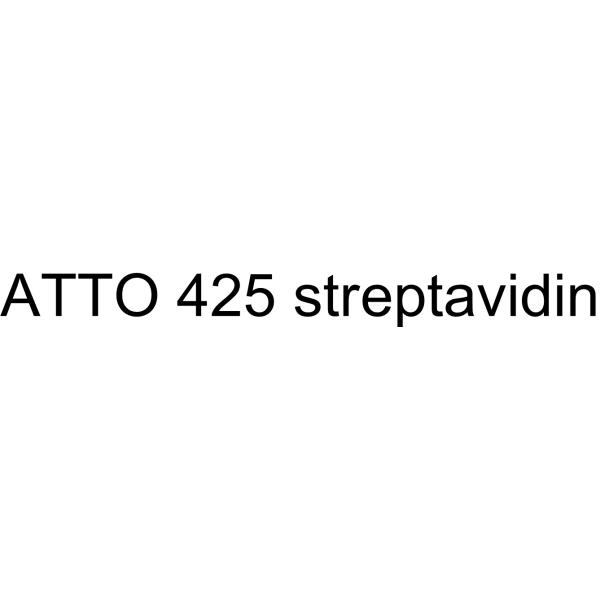
-
- HY-D1928
-
|
|
Fluorescent Dye
|
Others
|
|
ATTO 425 Amine is an amine derivative of ATTO 425, the maximum excitation emission wavelength: 439/489 nm.
|
-
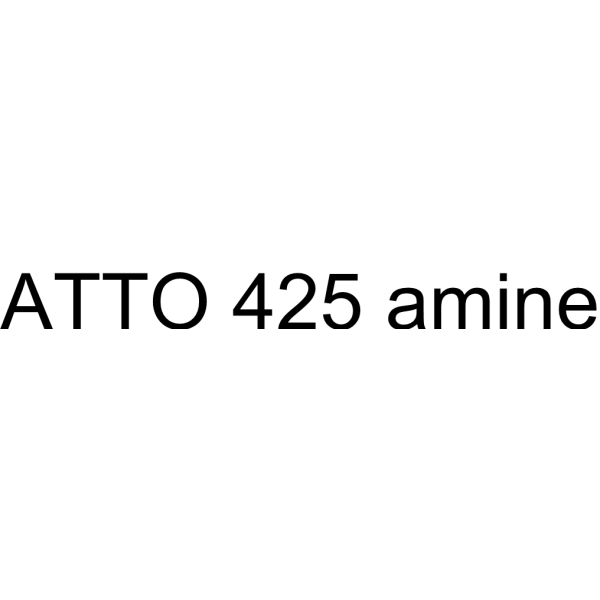
-
- HY-D1934
-
|
|
Fluorescent Dye
|
Others
|
|
ATTO 465 is a new fluorescent dye with good photostability and maximum excitation/emission wavelength: 453/506 nm.
|
-
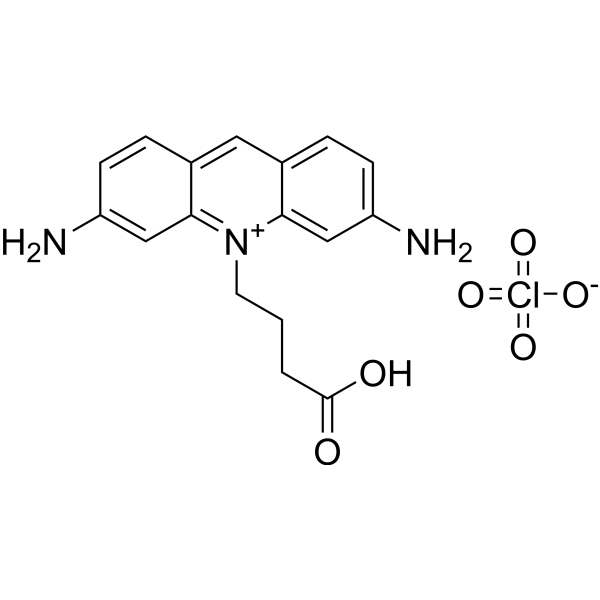
-
- HY-D1937
-
|
|
Fluorescent Dye
|
Others
|
|
ATTO 465 Streptavidin is a streptavidin derivative of ATTO 465, the maximum excitation/emission wavelength: 453/506 nm.
|
-
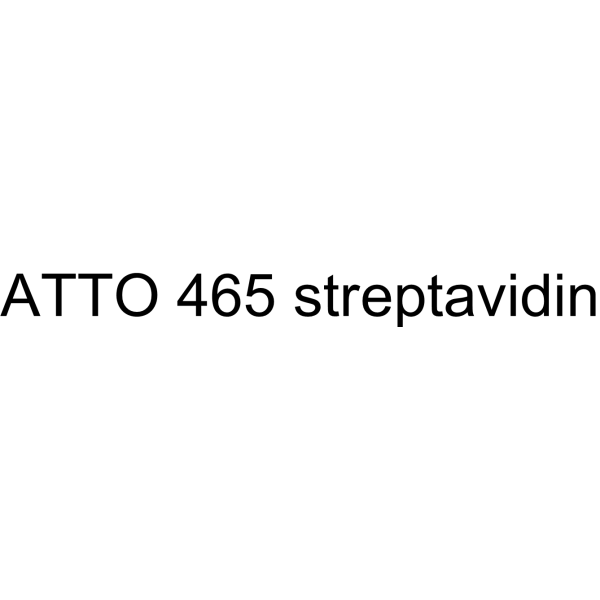
-
- HY-D1938
-
|
|
Fluorescent Dye
|
Others
|
|
ATTO 465 Biotin is a biotin derivative of ATTO 465 with maximum excitation/emission wavelengths: 453/506 nm.
|
-

-
- HY-D1942
-
|
|
Fluorescent Dye
|
Others
|
|
ATTO 590 Biotin is a biotin derivative of ATTO 590 with maximum excitation/emission wavelengths: 594/622 nm.
|
-
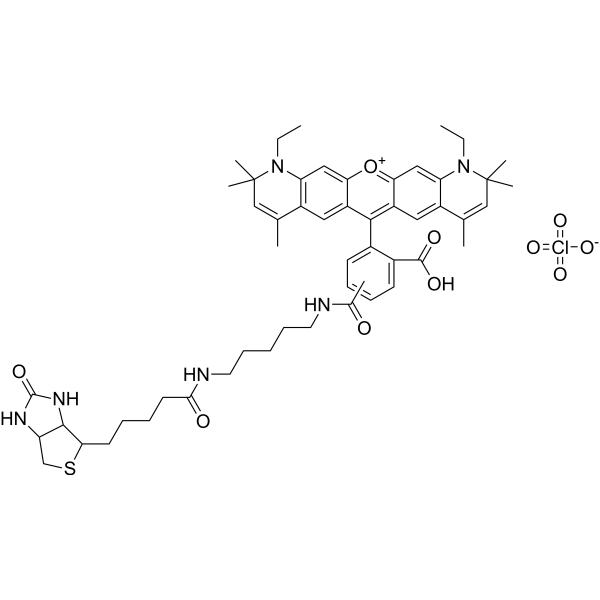
-
- HY-D1943
-
|
|
Fluorescent Dye
|
Others
|
|
ATTO 590 Amine is an amine derivative of ATTO 590, the maximum excitation/emission wavelength: 594/622 nm.
|
-
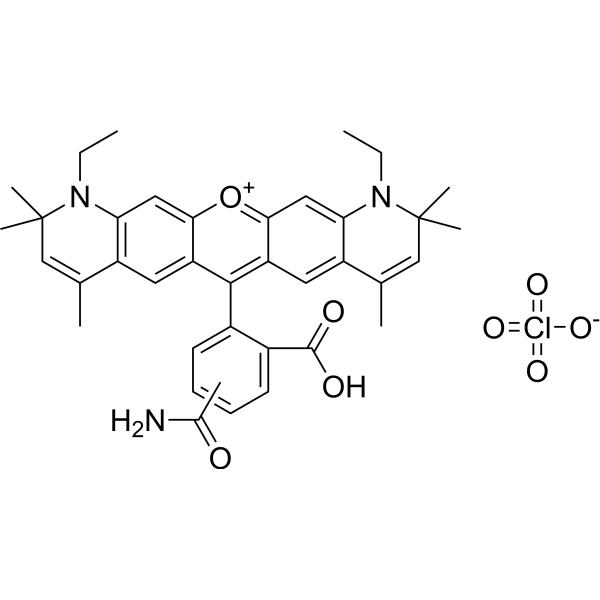
- HY-D1945
-
|
|
Fluorescent Dye
|
Others
|
|
ATTO 590 Iodacetamid is an iodoacetamide derivative of ATTO 590 with maximum excitation/emission wavelengths: 594/622 nm.
|
-
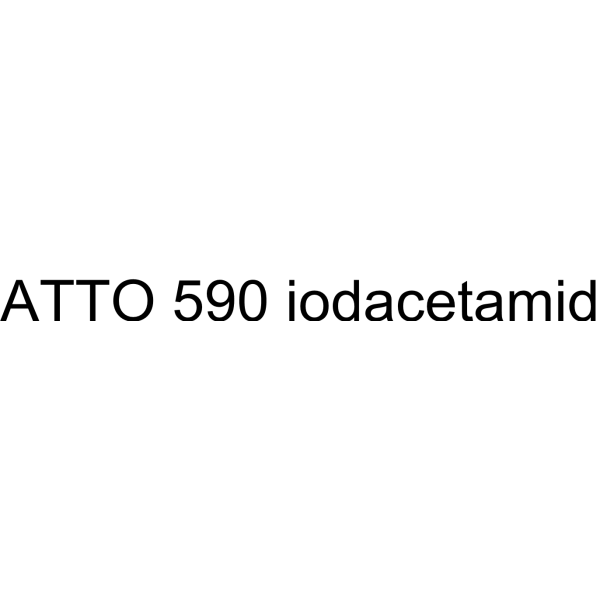
- HY-D1951
-
|
|
Fluorescent Dye
|
Others
|
|
ATTO 594 Biotin is a biotin derivative of ATTO 594 with maximum excitation/emission wavelengths: 603/626 nm.
|
-
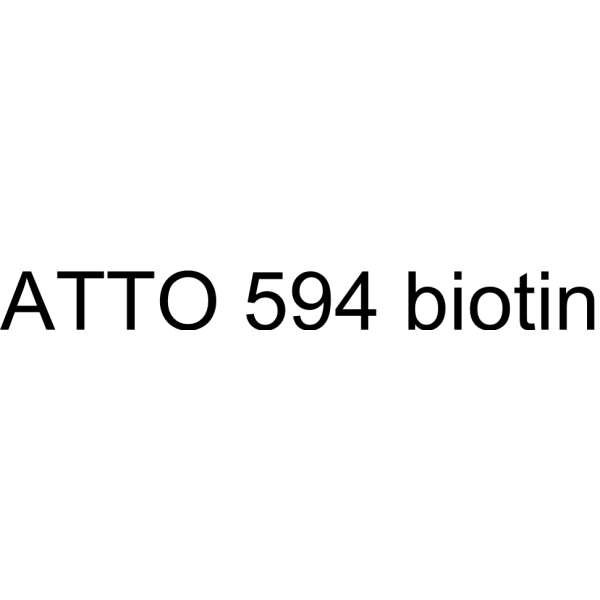
- HY-D1952
-
|
|
Fluorescent Dye
|
Others
|
|
ATTO 594 Amine is an amine derivative of ATTO 594, the maximum excitation/emission wavelength: 603/626 nm.
|
-

- HY-D1956
-
|
|
Fluorescent Dye
|
Others
|
|
ATTO 594 Alkin is an alkyne derivative of ATTO 594 with maximum excitation/emission wavelengths: 603/626 nm.
|
-
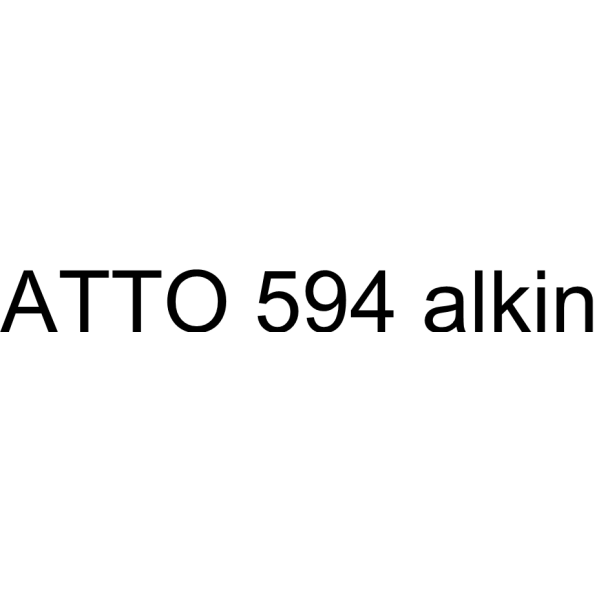
- HY-D1964
-
|
|
Fluorescent Dye
|
Others
|
|
ATTO 633 Biotin is a biotin derivative of ATTO 633 with maximum excitation/emission wavelengths: 630/651 nm.
|
-
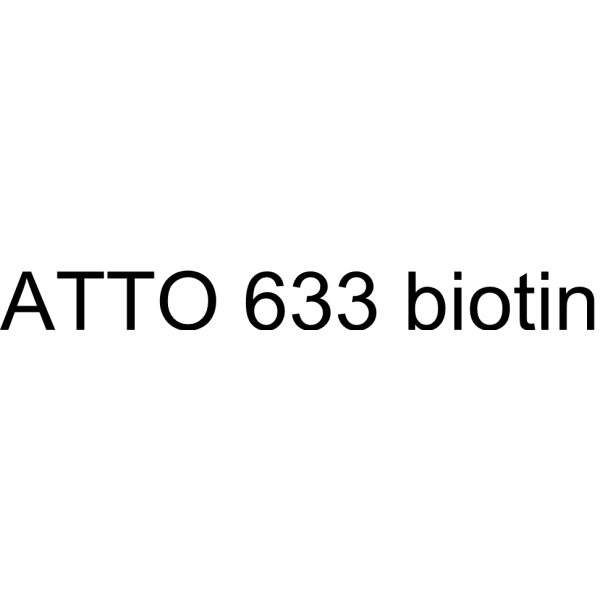
- HY-D1965
-
|
|
Fluorescent Dye
|
Others
|
|
ATTO 700 Biotin is a biotin derivative of ATTO 700 with maximum excitation/emission wavelengths: 700/716 nm.
|
-
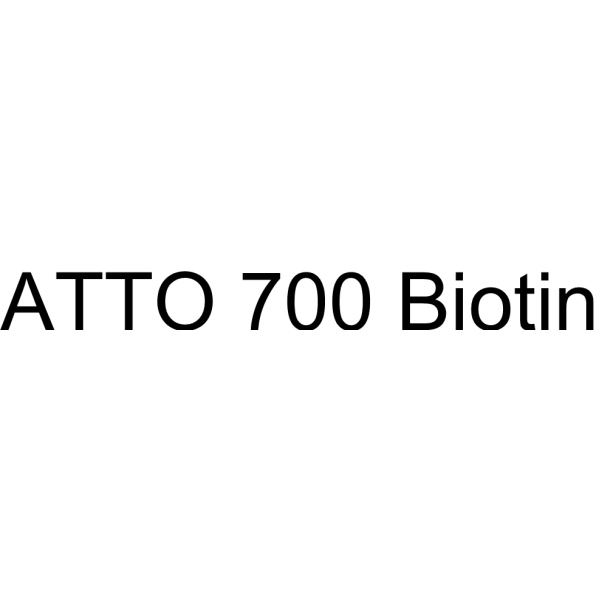
- HY-D1972
-
|
|
Fluorescent Dye
|
Others
|
|
ATTO 610 Carboxy is a carboxyl derivative of ATTO 610 with maximum excitation/emission wavelengths: 616/633 nm.
|
-

- HY-D1975
-
|
|
Fluorescent Dye
|
Others
|
|
ATTO 725 Carboxy is a carboxyl derivative of ATTO 725, the maximum excitation/emission wavelength is: 728/751 nm.
|
-

- HY-D1978
-
|
|
Fluorescent Dye
|
Others
|
|
ATTO 610 Biotin is a biotin derivative of ATTO 610 with maximum excitation/emission wavelengths: 616/633 nm.
|
-

- HY-D1980
-
|
|
Fluorescent Dye
|
Others
|
|
ATTO 620 Carboxy is a carboxyl derivative of ATTO 620, the maximum excitation/emission wavelength is: 620/642 nm.
|
-

- HY-D1988
-
|
|
Fluorescent Dye
|
Others
|
|
ATTO 620 Biotin is a biotin derivative of ATTO 620 with maximum excitation/emission wavelengths: 620/642 nm.
|
-

- HY-D1989
-
|
|
Fluorescent Dye
|
Others
|
|
ATTO 725 Biotin is a biotin derivative of ATTO 725 with maximum excitation/emission wavelengths: 728/751 nm.
|
-
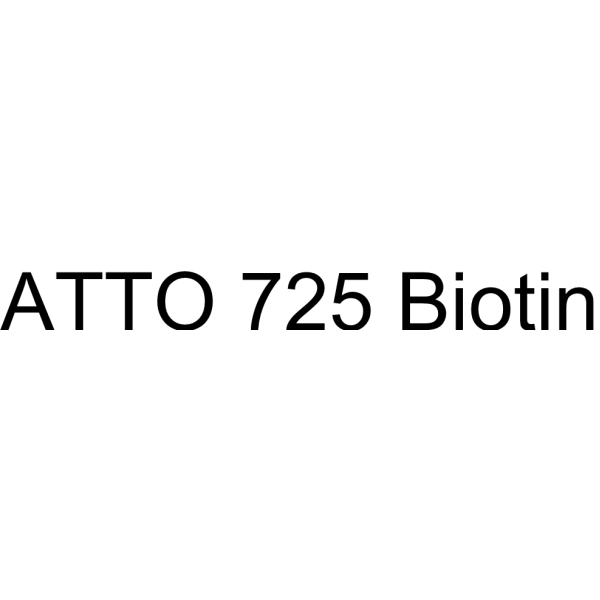
- HY-D1996
-
|
|
Fluorescent Dye
|
Others
|
|
ATTO 647 Biotin is a biotin derivative of ATTO 647 with maximum excitation/emission wavelengths: 630/651 nm.
|
-

- HY-D2003
-
|
|
Fluorescent Dye
|
Others
|
|
ATTO 565 biotin is a biotin derivative of ATTO 565 with maximum excitation/emission wavelengths: 564/590 nm.
|
-
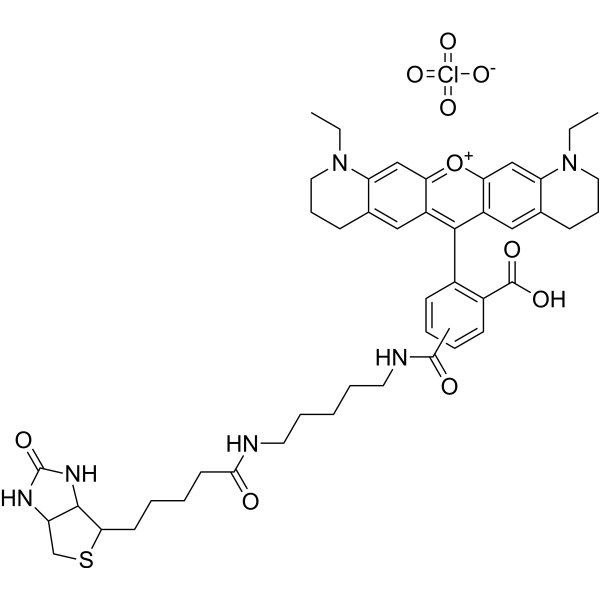
- HY-D2007
-
|
|
Fluorescent Dye
|
Others
|
|
ATTO 488 biotin is a biotin derivative of ATTO 488 with maximum excitation/emission wavelengths: 500/520 nm.
|
-

- HY-D2005
-
|
|
Fluorescent Dye
|
Others
|
|
ATTO 565 amine is an amine derivative of ATTO 565, the maximum excitation/emission wavelength: 564/590 nm.
|
-
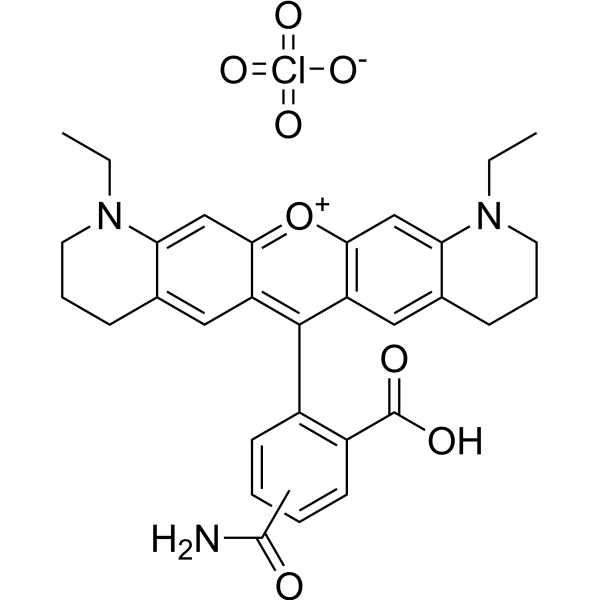
- HY-D2009
-
|
|
Fluorescent Dye
|
Others
|
|
ATTO 565 iodacetamid is an iodoacetamide derivative of ATTO 565 with maximum excitation/emission wavelengths: 564/590 nm.
|
-
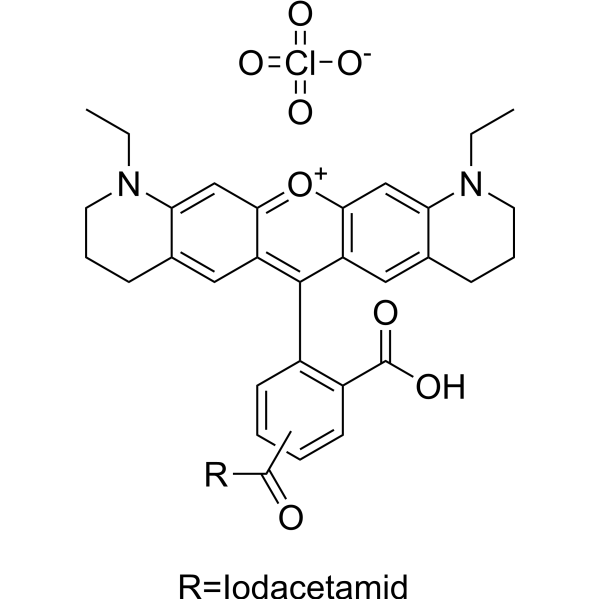
- HY-D2045
-
|
|
Fluorescent Dye
|
Others
|
|
ATTO 532 carboxy is a carboxyl derivative of ATTO 532, the maximum excitation/emission wavelength is: 532/552 nm.
|
-

- HY-D2025
-
|
|
Fluorescent Dye
|
Others
|
|
ATTO 550 biotin is a biotin derivative of ATTO 550 with maximum excitation/emission wavelengths: 554/576 nm.
|
-
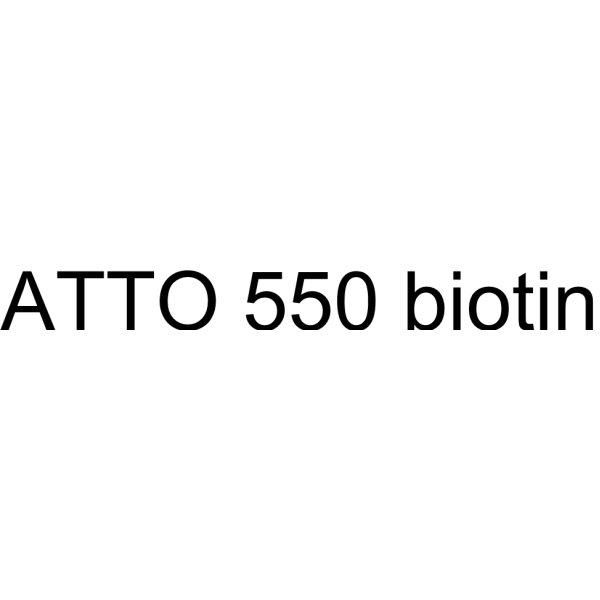
- HY-D2032
-
|
|
Fluorescent Dye
|
Others
|
|
ATTO 514 amine is an amine derivative of ATTO 514, the maximum excitation/emission wavelength: 511/531 nm.
|
-

- HY-D2053
-
|
|
Fluorescent Dye
|
Others
|
|
ATTO 532 hydrazid is a hydrazide derivative of ATTO 532 with maximum excitation/emission wavelengths: 532/552 nm.
|
-
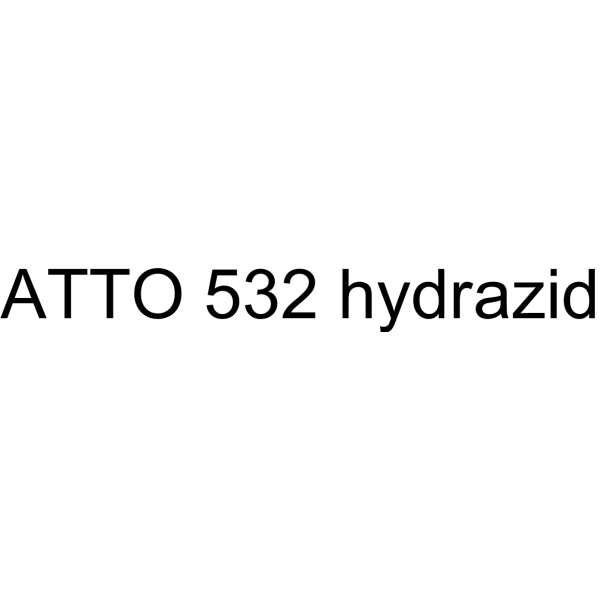
- HY-D2011
-
|
|
Fluorescent Dye
|
Others
|
|
ATTO 565 hydrazid is a hydrazide derivative of ATTO 565 with maximum excitation/emission wavelengths: 564/590 nm.
|
-
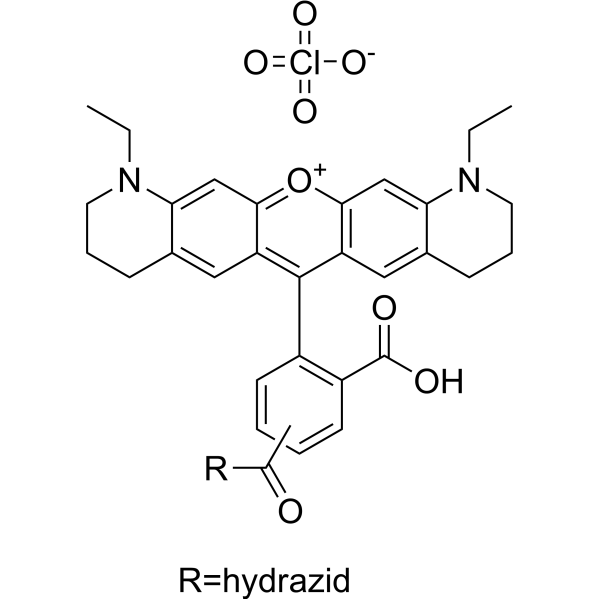
- HY-D2057
-
|
|
Fluorescent Dye
|
Others
|
|
ATTO 700 carboxy is a carboxyl derivative of ATTO 700 with maximum excitation/emission wavelengths: 700/716 nm.
|
-

- HY-D2072
-
|
|
Fluorescent Dye
|
Others
|
|
ATTO 680 carboxy is a carboxyl derivative of ATTO 680, the maximum excitation/emission wavelength is: 681/698 nm.
|
-

- HY-D2076
-
|
|
Fluorescent Dye
|
Others
|
|
ATTO 740 biotin is a biotin derivative of ATTO 740 with maximum excitation/emission wavelengths: 743/763 nm.
|
-
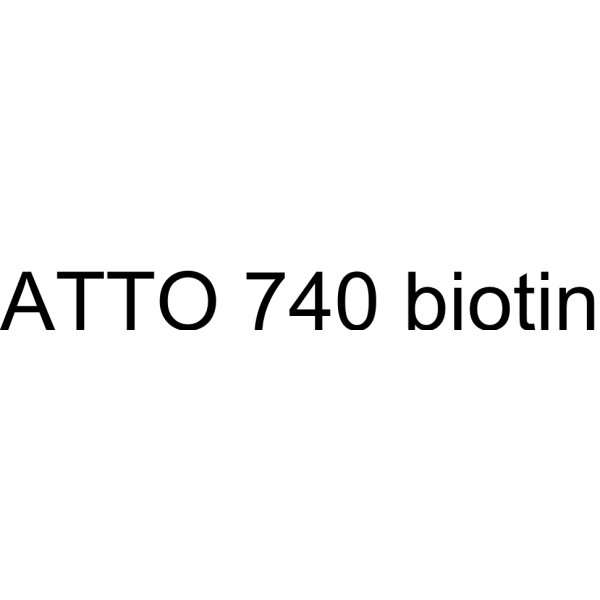
- HY-D2078
-
|
|
Fluorescent Dye
|
Others
|
|
ATTO 665 amine is an amine derivative of ATTO 665, the maximum excitation/emission wavelength: 663/680 nm.
|
-
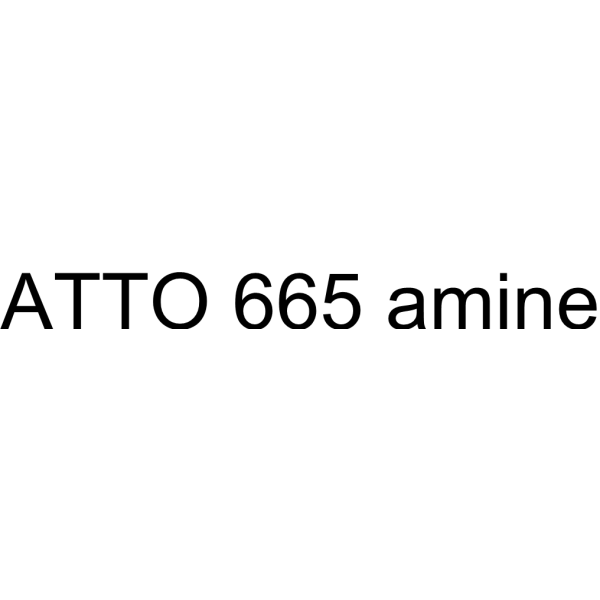
- HY-D2081
-
|
|
Fluorescent Dye
|
Others
|
|
ATTO 665 alkin is an alkyne derivative of ATTO 665 with maximum excitation/emission wavelengths: 663/680 nm.
|
-
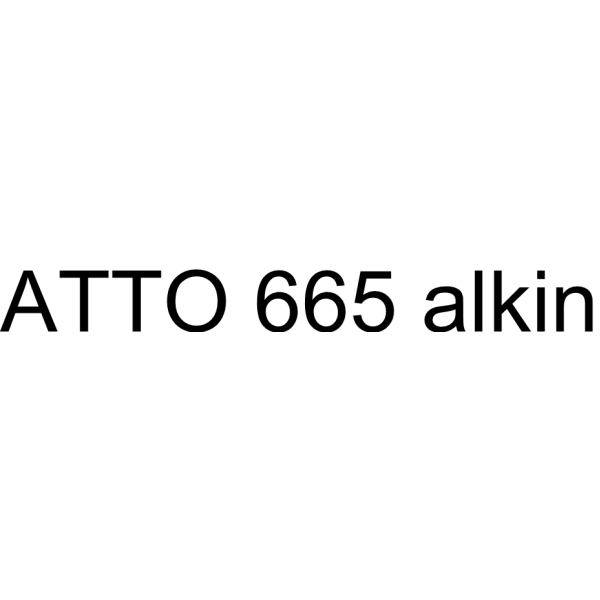
- HY-D2008
-
|
|
Fluorescent Dye
|
Others
|
|
ATTO 488 amine is an amine derivative of ATTO 488, the maximum excitation/emission wavelength: 500/520 nm.
|
-
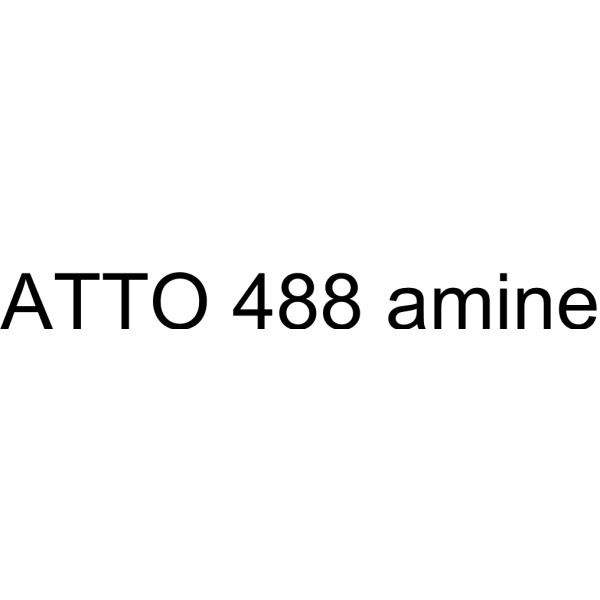
- HY-D2031
-
|
|
Fluorescent Dye
|
Others
|
|
ATTO 514 biotin is a biotin derivative of ATTO 514 with maximum excitation/emission wavelengths: 511/531 nm.
|
-
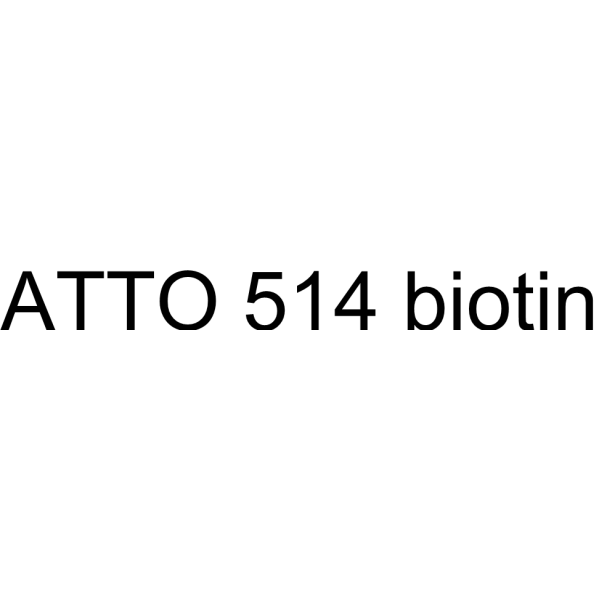
- HY-D2037
-
|
|
Fluorescent Dye
|
Others
|
|
ATTO 550 hydrazid is a hydrazide derivative of ATTO 550 with maximum excitation/emission wavelengths: 554/576 nm.
|
-
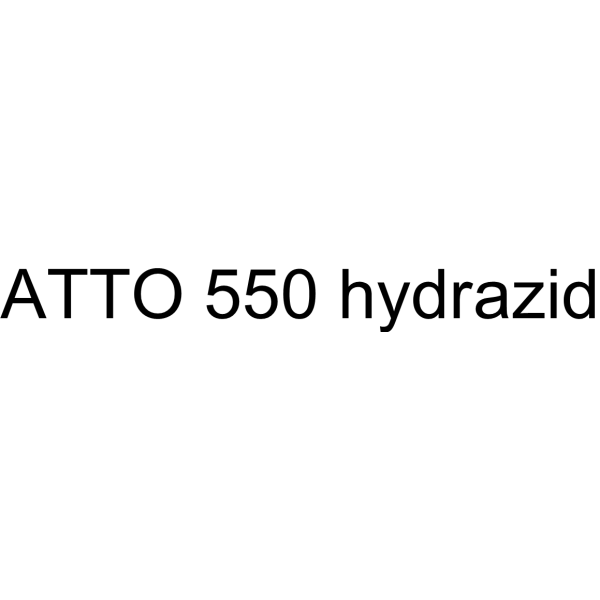
- HY-D2034
-
|
|
Fluorescent Dye
|
Others
|
|
ATTO 514 hydrazid is a hydrazide derivative of ATTO 514 with maximum excitation/emission wavelengths: 511/531 nm.
|
-

- HY-D2018
-
|
|
Fluorescent Dye
|
Others
|
|
ATTO 550 carboxy is a carboxyl derivative of ATTO 550 with maximum excitation/emission wavelengths: 554/576 nm.
|
-

- HY-D2069
-
|
|
Fluorescent Dye
|
Others
|
|
ATTO 680 alkin is an alkyne derivative of ATTO 680 with maximum excitation/emission wavelengths: 681/698 nm.
|
-
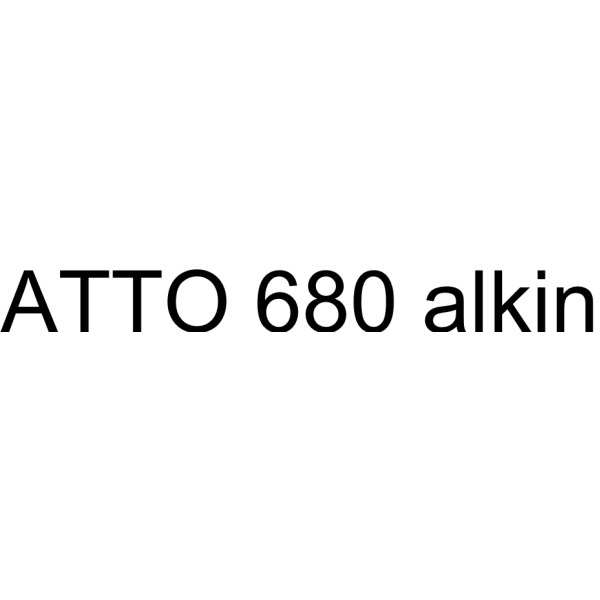
- HY-D2049
-
|
|
Fluorescent Dye
|
Others
|
|
ATTO 532 biotin is a biotin derivative of ATTO 532 with maximum excitation/emission wavelengths: 532/552 nm.
|
-
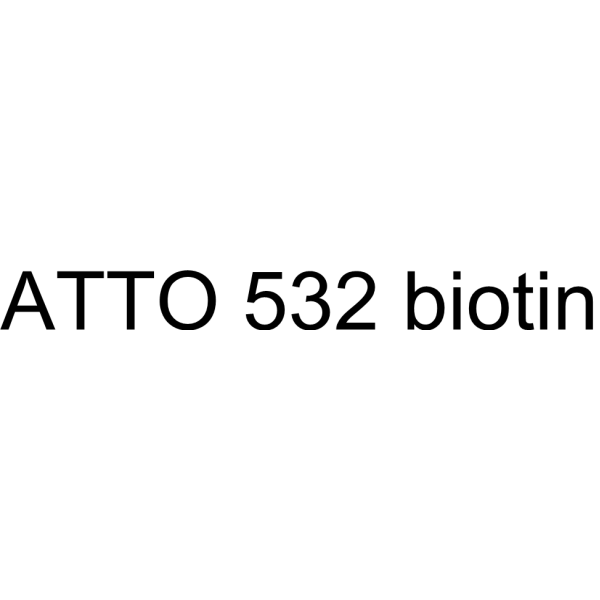
- HY-D2068
-
|
|
Fluorescent Dye
|
Others
|
|
ATTO 680 iodacetamid is an iodoacetamide derivative of ATTO 680 with maximum excitation/emission wavelengths: 681/698 nm.
|
-
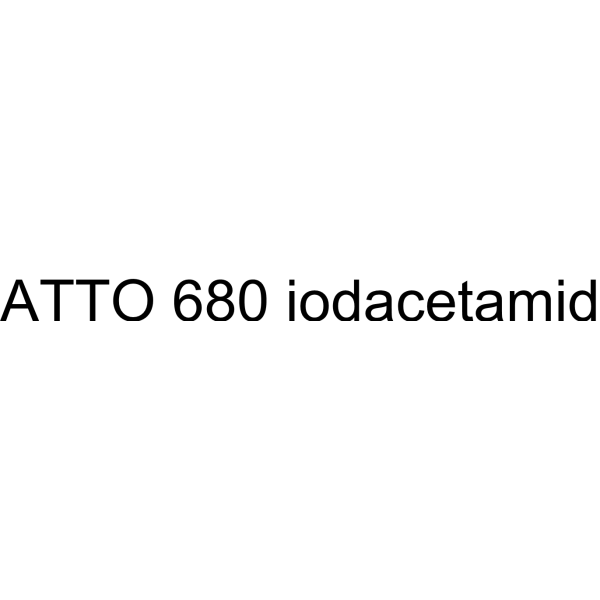
- HY-D1911
-
|
|
Fluorescent Dye
|
Others
|
|
ATTO 665 Biotin is a biotin derivative of ATTO 665 with maximum excitation/emission wavelengths: 663/680 nm.
|
-
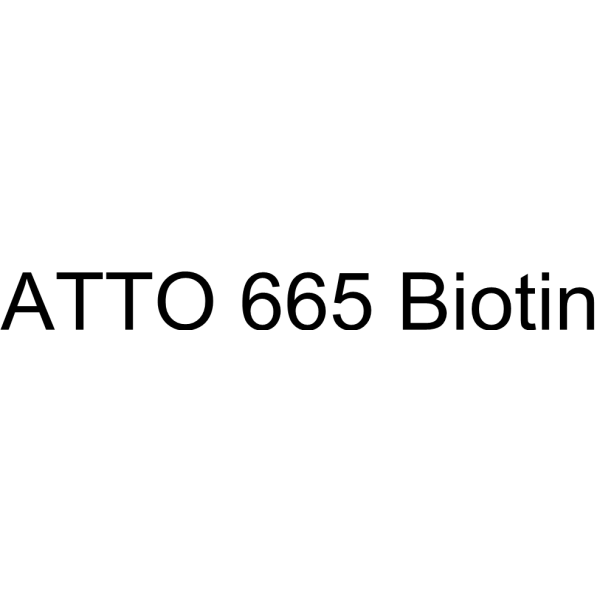
- HY-D2066
-
|
|
Fluorescent Dye
|
Others
|
|
ATTO 680 amine is an amine derivative of ATTO 680, the maximum excitation/emission wavelength: 681/698 nm.
|
-

- HY-D2036
-
|
|
Fluorescent Dye
|
Others
|
|
ATTO 550 iodacetamid is an iodoacetamide derivative of ATTO 550 with maximum excitation/emission wavelengths: 554/576 nm.
|
-

- HY-D2061
-
|
|
Fluorescent Dye
|
Others
|
|
ATTO 740 carboxy is a carboxyl derivative of ATTO 740, the maximum excitation/emission wavelength is: 743/763 nm.
|
-

- HY-D2050
-
|
|
Fluorescent Dye
|
Others
|
|
ATTO 532 amine is an amine derivative of ATTO 532, the maximum excitation/emission wavelength: 532/552 nm.
|
-
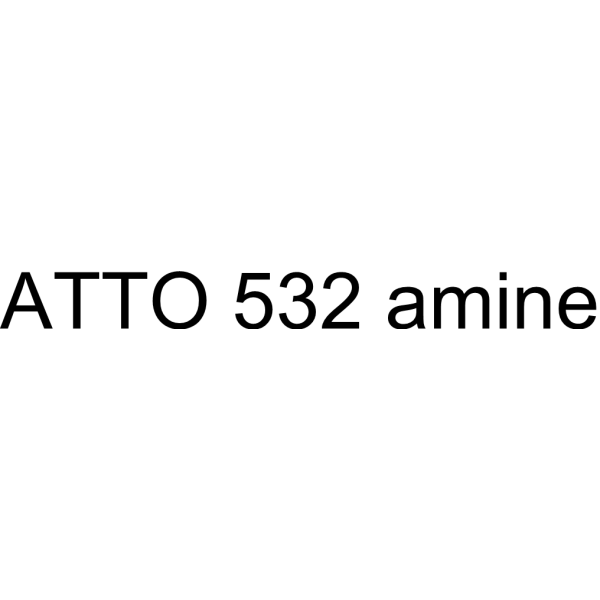
- HY-D2065
-
|
|
Fluorescent Dye
|
Others
|
|
ATTO 680 biotin is a biotin derivative of ATTO 680 with maximum excitation/emission wavelengths: 681/698 nm.
|
-
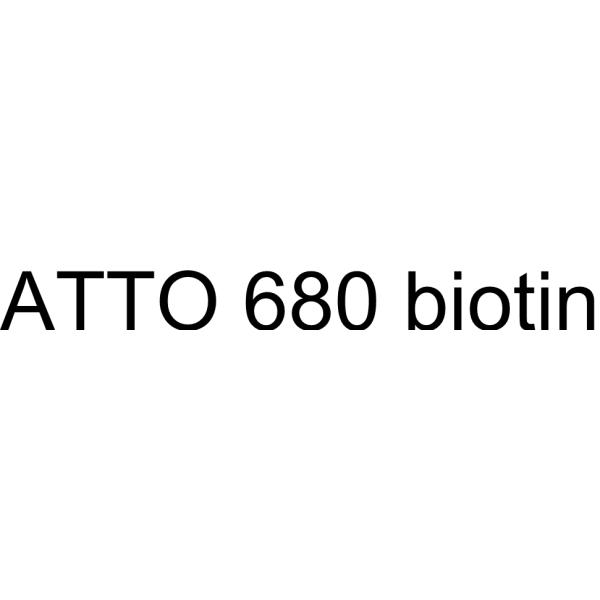
- HY-D2027
-
|
|
Fluorescent Dye
|
Others
|
|
ATTO 550 amine is an amine derivative of ATTO 550, the maximum excitation/emission wavelength: 554/576 nm.
|
-
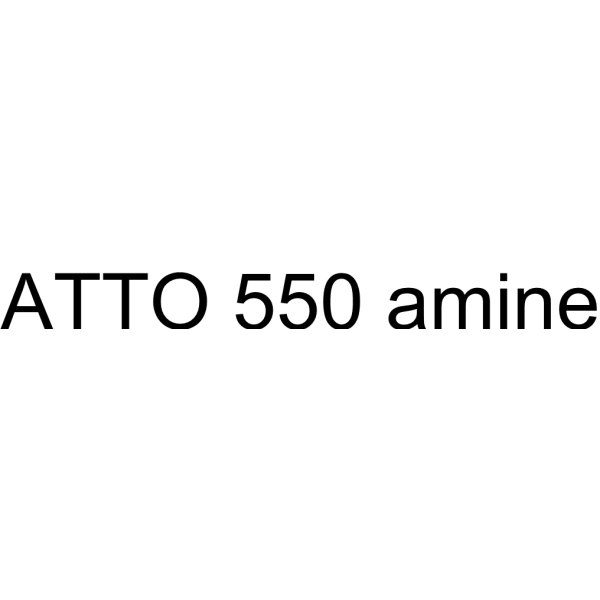
- HY-D2080
-
|
|
Fluorescent Dye
|
Others
|
|
ATTO 665 iodacetamid is an iodoacetamide derivative of ATTO 665 with maximum excitation/emission wavelengths: 663/680 nm.
|
-
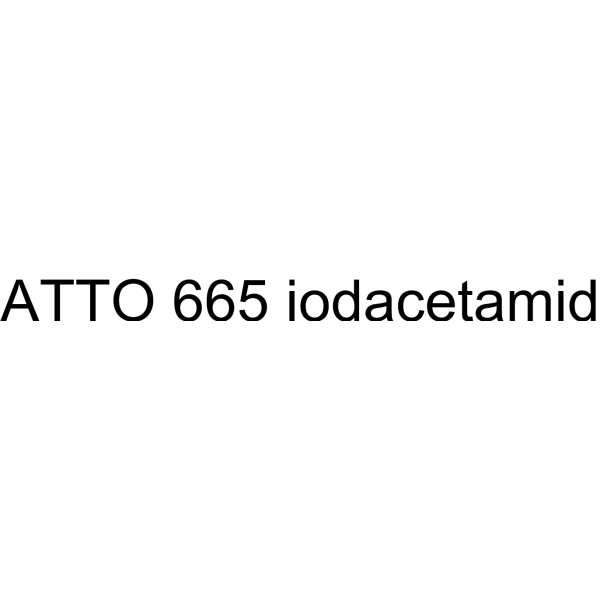
- HY-P5053
-
|
|
Integrin
|
Cancer
|
|
Galacto-RGD is an RGD analogue that can be coupled with the radioactive isotope 18F and used as an integrin α₅β₃ selective tracer .
|
-

- HY-D1044
-
|
Rhodamine 640 chloride
|
Fluorescent Dye
|
Others
|
|
Rhodamine 101 chloride (Rhodamine 640 chloride) is a bright fluorescent dye with excitation and emission maxima of 565 and 595 nm, respectively .
|
-

- HY-D0069
-
|
|
Fluorescent Dye
|
Others
|
|
CPM is a maleimide derivative, acting as a blue fluorescent thiol-reactive dye. The excitation/emission maxima is 384/470 nm .
|
-

- HY-D2022
-
|
|
Fluorescent Dye
|
Others
|
|
ATTO 514 is a new type of hydrophilic fluorescent probe with strong stability and maximum excitation/emission wavelength: 511/531 nm.
|
-
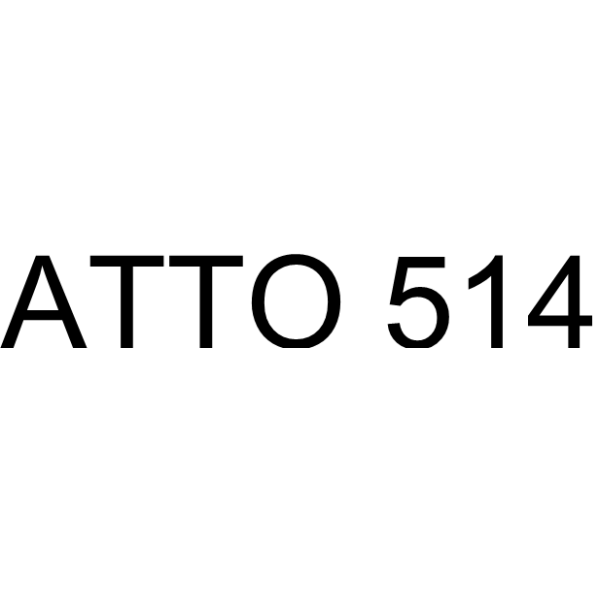
- HY-126821A
-
|
|
Fluorescent Dye
|
Others
|
|
Fluo-3 pentaammonium is a fluorescence indicator of intracellular calcium (Ca 2+). Excitation/Emission = 488/525 nm .
|
-
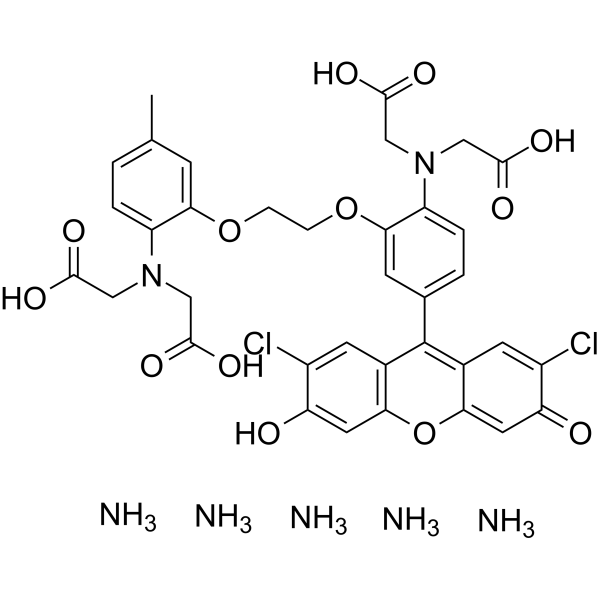
- HY-D1923
-
|
|
Fluorescent Dye
|
Others
|
|
ATTO 390 biotin is a biotin derivative of ATTO 390, used for streptavidin reaction, maximum excitation/emission wavelength: 390/476 nm.
|
-
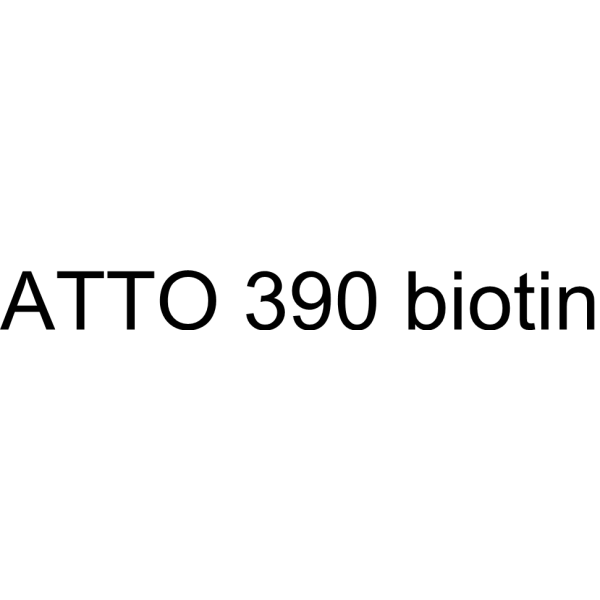
- HY-D1927
-
|
|
Fluorescent Dye
|
Others
|
|
ATTO 425 Biotin is a biotin derivative of ATTO 425, used for streptavidin reaction, the maximum excitation emission wavelength: 439/489 nm.
|
-
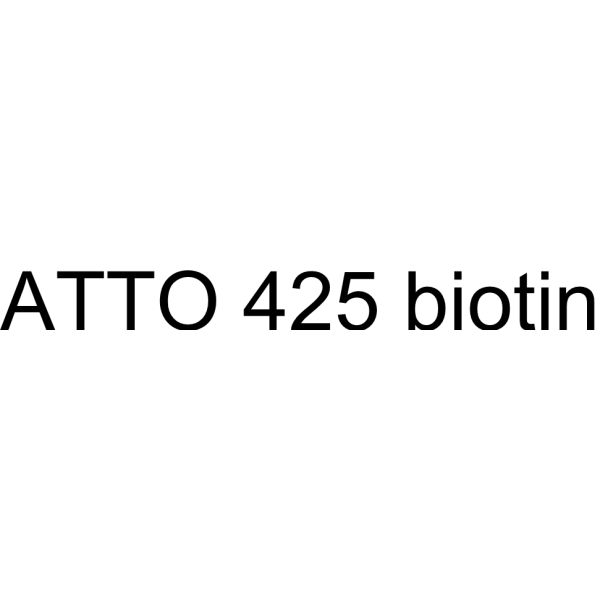
- HY-D2268
-
|
|
Fluorescent Dye
Amyloid-β
|
Neurological Disease
|
|
QM-FN-SO3 is a BBB-penetrable near-infrared (NIR) aggregation-induced emission (AIE)-active probe for Aβ plaques. QM-FN-SO3 can be used for in vivo detection of Aβ plaques. QM-FN-SO3 has ultra-high S/N ratio, binding affinity, and high-performance NIR emission .
|
-
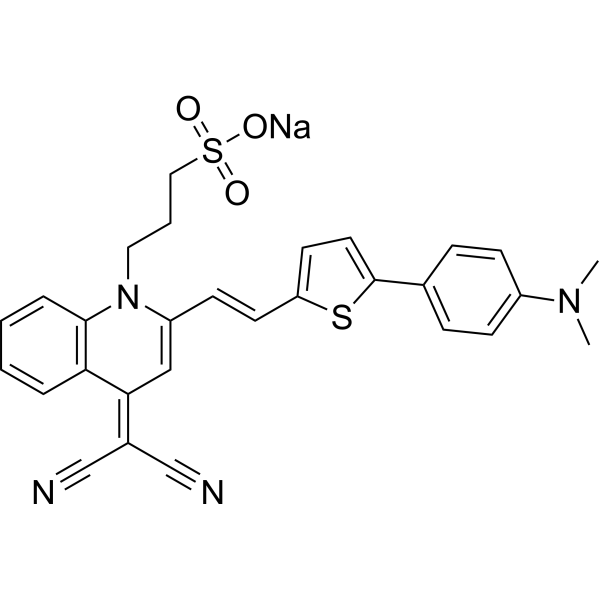
- HY-D0098
-
|
N-(5-Fluoresceinyl)maleimide
|
Fluorescent Dye
|
Others
|
|
Fluorescein-5-maleimide is a fluorescent thiol-reactive dye used to conjugate fluorescein to proteins (excitation: 494 nm, emission: 519 nm).
|
-
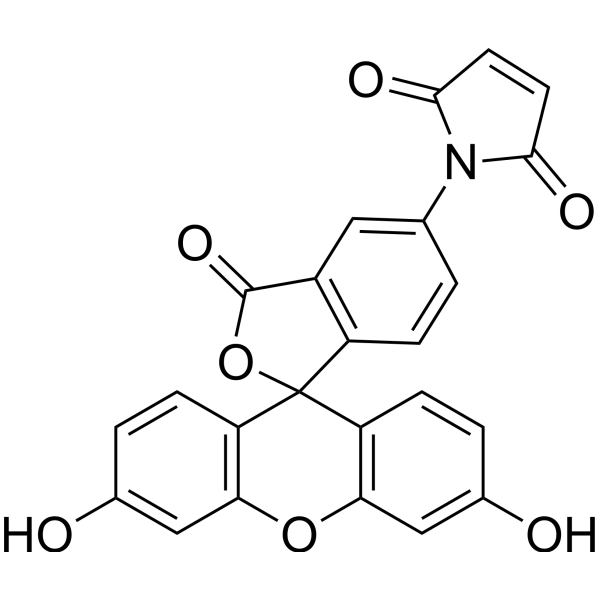
- HY-136873
-
|
|
Others
|
Others
|
|
UCB-J is a positron emission tomography (PET) radioligand for the synaptic vesicle protein 2A (SV2A) .
|
-

- HY-P2377
-
|
|
Fluorescent Dye
|
Others
|
|
Ac-YVAD-AFC is the the fluorometric peptide substrate of caspase-1, with λ excitation of 400 nm and λ emission of 505 nm .
|
-

- HY-D1941
-
|
|
Fluorescent Dye
|
Others
|
|
ATTO 590 Streptavidin is a streptavidin derivative of ATTO 590, it can label protein or antibody, the maximum excitation/emission wavelength: 594/622 nm.
|
-
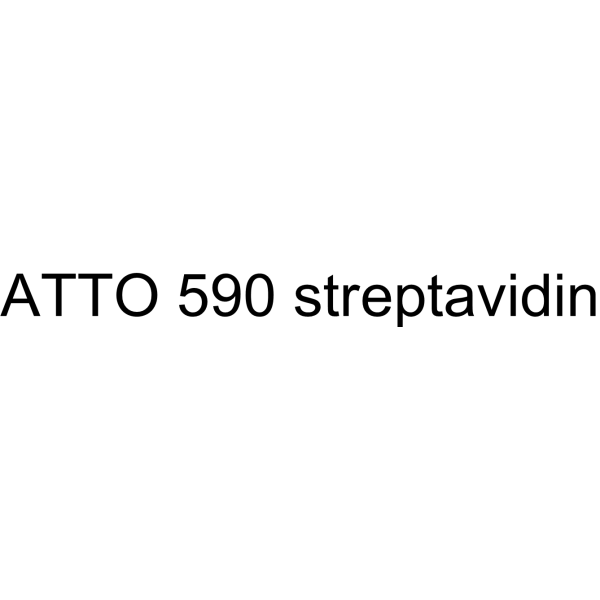
- HY-D1947
-
|
|
Fluorescent Dye
|
Others
|
|
ATTO 700 Streptavidin is a streptavidin derivative of ATTO 700, it can label protein or antibody, the maximum excitation/emission wavelength: 700/716 nm.
|
-
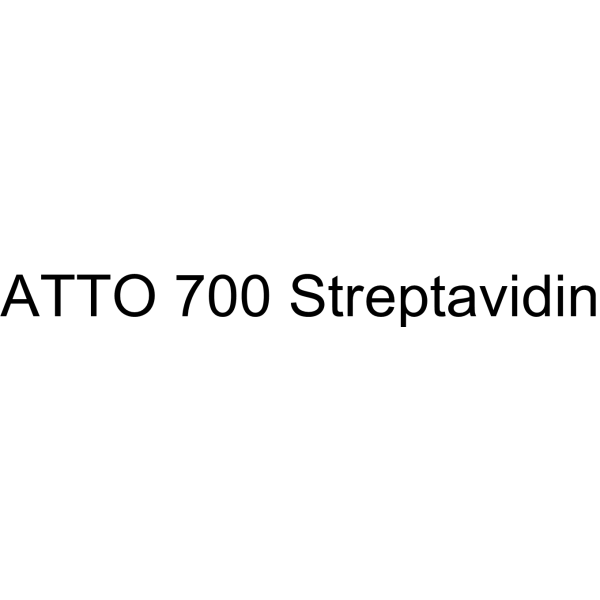
- HY-D1949
-
|
|
Fluorescent Dye
|
Others
|
|
ATTO 594 Streptavidin is a streptavidin derivative of ATTO 594, it can label protein or antibody, the maximum excitation/emission wavelength: 603/626 nm.
|
-
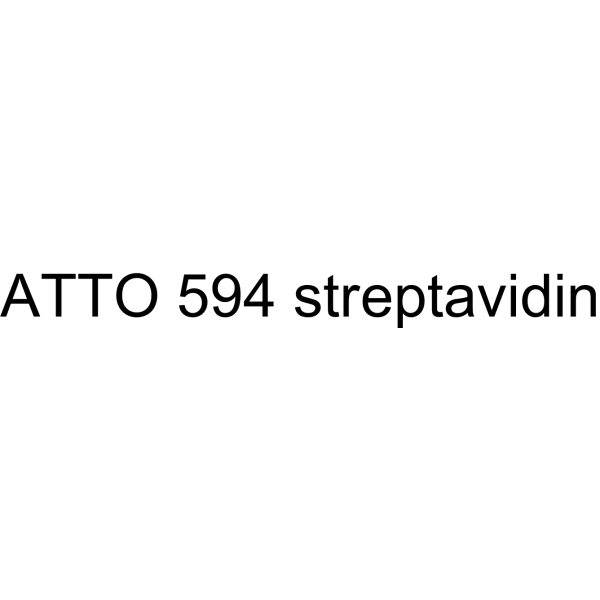
- HY-D1962
-
|
|
Fluorescent Dye
|
Others
|
|
ATTO 633 Streptavidin is a streptavidin derivative of ATTO 633, it can label protein or antibody, the maximum excitation/emission wavelength: 630/651 nm.
|
-
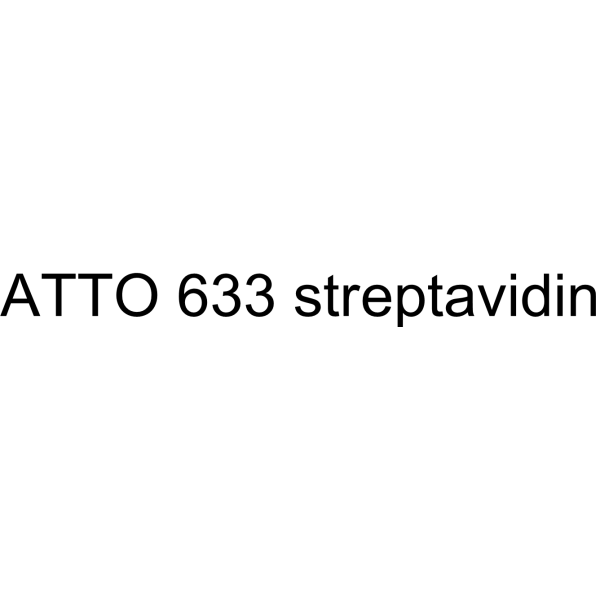
- HY-D1963
-
|
|
Fluorescent Dye
|
Others
|
|
ATTO 565 Streptavidin is a streptavidin derivative of ATTO 565, it can label protein or antibody, the maximum excitation/emission wavelength: 564/590 nm.
|
-
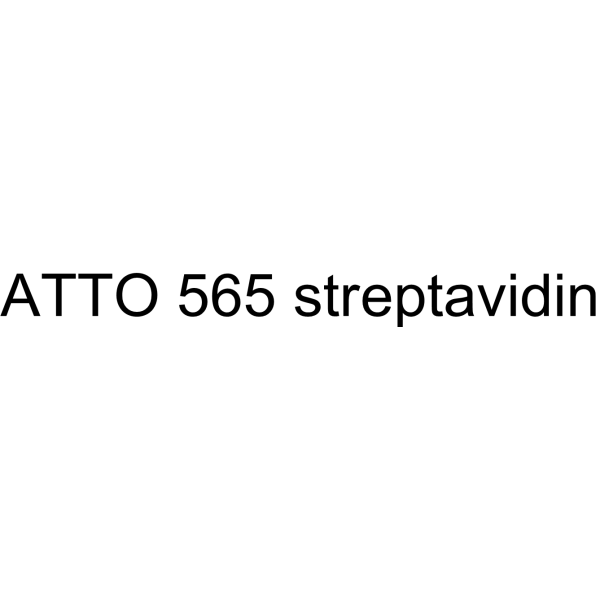
- HY-D1977
-
|
|
Fluorescent Dye
|
Others
|
|
ATTO 610 Streptavidin is a streptavidin derivative of ATTO 610, it can label protein or antibody, the maximum excitation/emission wavelength: 616/633 nm.
|
-
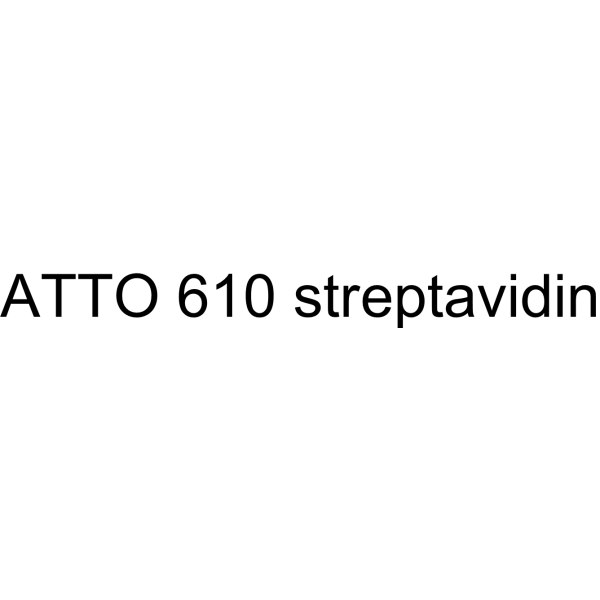
- HY-D1985
-
|
|
Fluorescent Dye
|
Others
|
|
ATTO 725 Streptavidin is a streptavidin derivative of ATTO 725, it can label protein or antibody, the maximum excitation/emission wavelength: 728/751 nm.
|
-
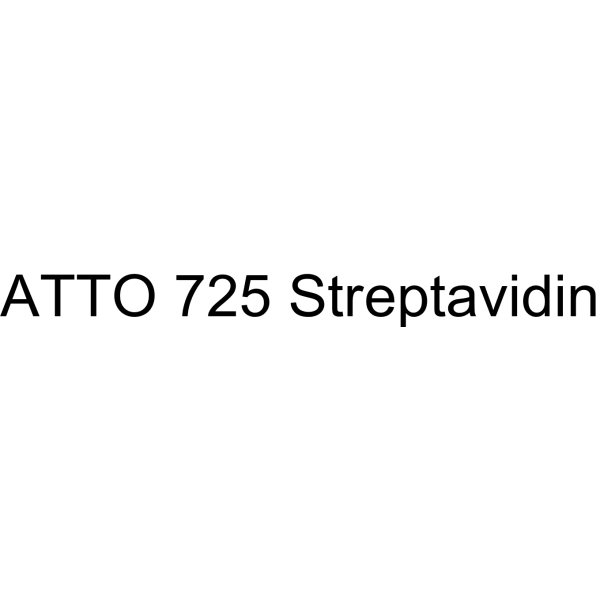
- HY-D1987
-
|
|
Fluorescent Dye
|
Others
|
|
ATTO 620 Streptavidin is a streptavidin derivative of ATTO 620, it can label protein or antibody, the maximum excitation/emission wavelength: 620/642 nm.
|
-
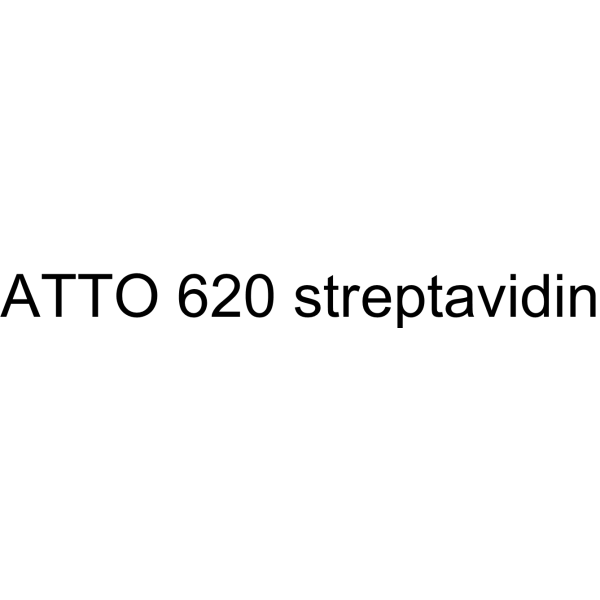
- HY-D1995
-
|
|
Fluorescent Dye
|
Others
|
|
ATTO 647 Streptavidin is a streptavidin derivative of ATTO 647, it can label protein or antibody, the maximum excitation/emission wavelength: 630/651 nm.
|
-
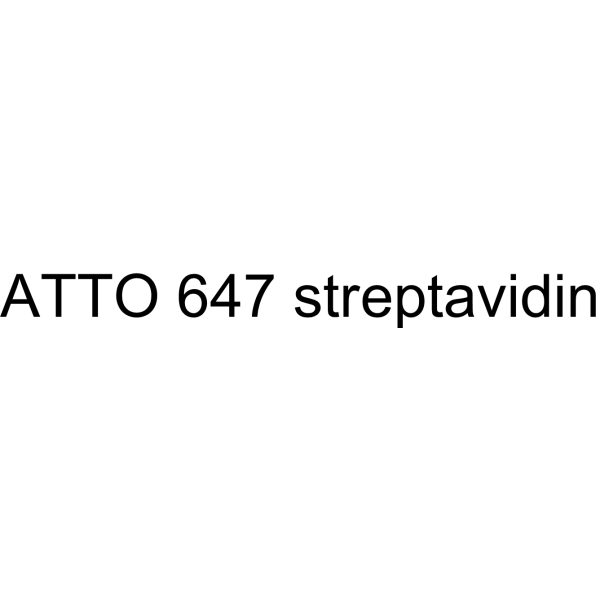
- HY-D2075
-
|
|
Fluorescent Dye
|
Others
|
|
ATTO 740 streptavidin is a streptavidin derivative of ATTO 740, it can label protein or antibody, the maximum excitation/emission wavelength: 743/763 nm.
|
-
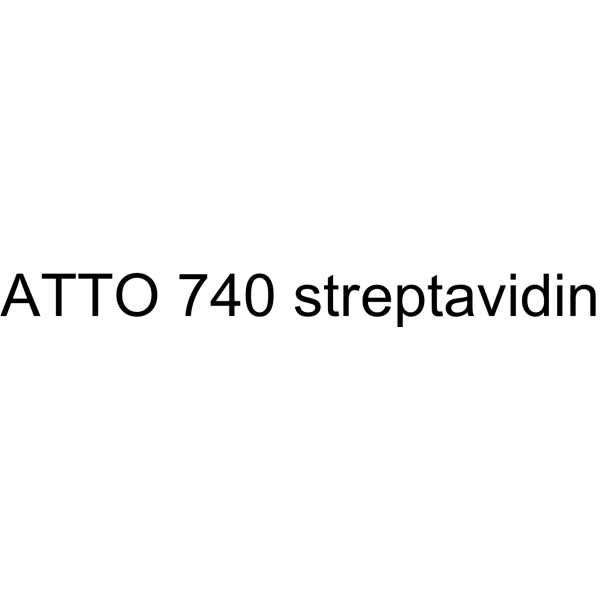
- HY-D2004
-
|
|
Fluorescent Dye
|
Others
|
|
ATTO 488 streptavidin is a streptavidin derivative of ATTO 488, it can label protein or antibody, the maximum excitation/emission wavelength: 500/520 nm.
|
-
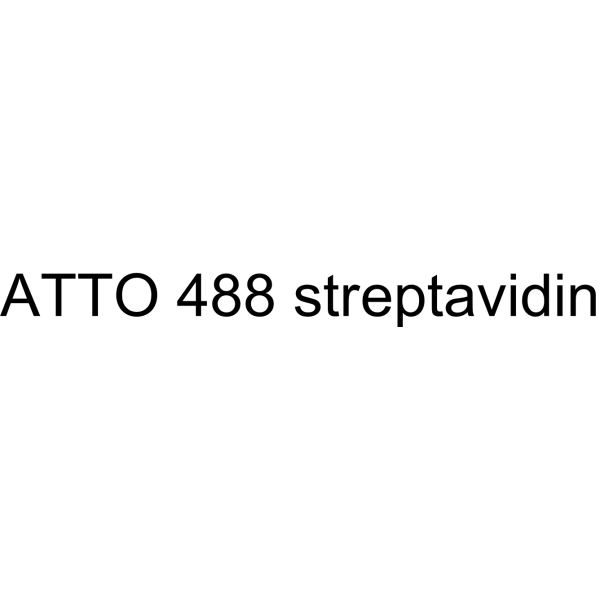
- HY-D2048
-
|
|
Fluorescent Dye
|
Others
|
|
ATTO 532 streptavidin is a streptavidin derivative of ATTO 532, it can label protein or antibody, the maximum excitation/emission wavelength: 532/552 nm.
|
-

- HY-D2024
-
|
|
Fluorescent Dye
|
Others
|
|
ATTO 550 streptavidin is a streptavidin derivative of ATTO 550, it can label protein or antibody, the maximum excitation/emission wavelength: 554/576 nm.
|
-
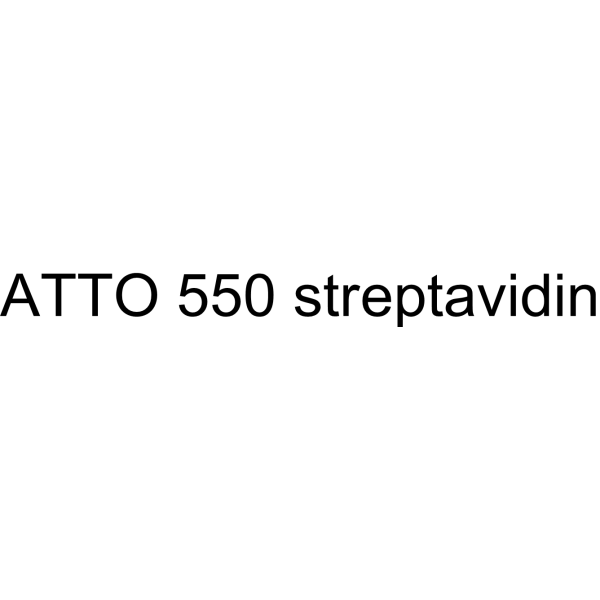
- HY-D2030
-
|
|
Fluorescent Dye
|
Others
|
|
ATTO 514 streptavidin is a streptavidin derivative of ATTO 514, it can label protein or antibody, the maximum excitation/emission wavelength: 511/531 nm.
|
-
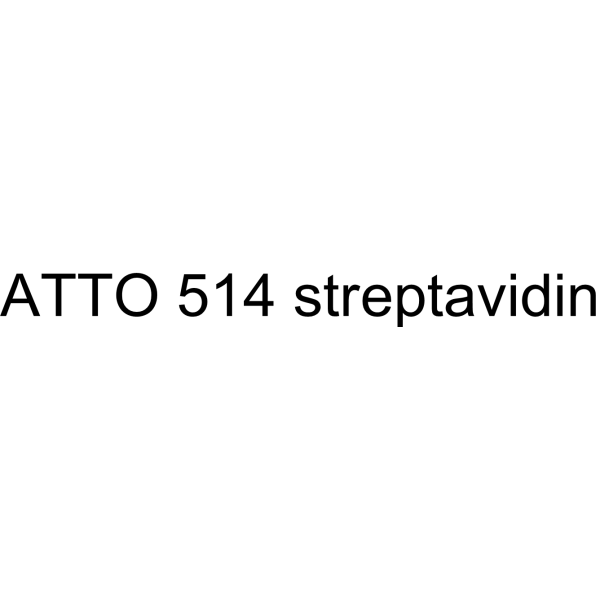
- HY-D2023
-
|
|
Fluorescent Dye
|
Others
|
|
ATTO 665 streptavidin is a streptavidin derivative of ATTO 665, it can label protein or antibody, the maximum excitation/emission wavelength: 663/680 nm.
|
-

- HY-D2064
-
|
|
Fluorescent Dye
|
Others
|
|
ATTO 680 streptavidin is a streptavidin derivative of ATTO 680, it can label protein or antibody, the maximum excitation/emission wavelength: 681/698 nm.
|
-

- HY-D0817
-
|
Rhodamine 110 chloride; RH110
|
Fluorescent Dye
|
Others
|
|
Rhodamine 110 is a sensitive and selective substrate for assaying proteinases in solution or inside living cells. The excitation wavelength is 498 nm and the emission wavelength is 521 nm .
|
-
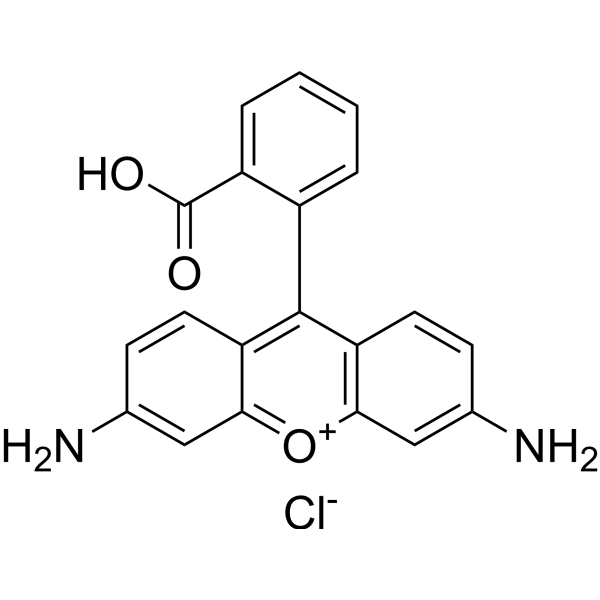
- HY-101891
-
|
|
Fluorescent Dye
|
Others
|
|
Di-8-ANEPPS is a naphthylstyryl voltage-sensitive dye, shifting both their fluorescence excitation and emission spectra upon changes in Vm .
|
-

- HY-D1970
-
|
|
Fluorescent Dye
|
Others
|
|
ATTO 700 Cadaverin is a cadaverine derivative of ATTO 700 for reactions of carboxylic acids, aldehydes and ketones with maximum excitation/emission wavelengths: 700/716 nm.
|
-

- HY-D2055
-
|
|
Fluorescent Dye
|
Others
|
|
ATTO 532 cadaverin is a cadaverine derivative of ATTO 532, used for carboxylic acid, aldehyde and ketone reactions, maximum excitation/emission wavelength: 532/552 nm.
|
-
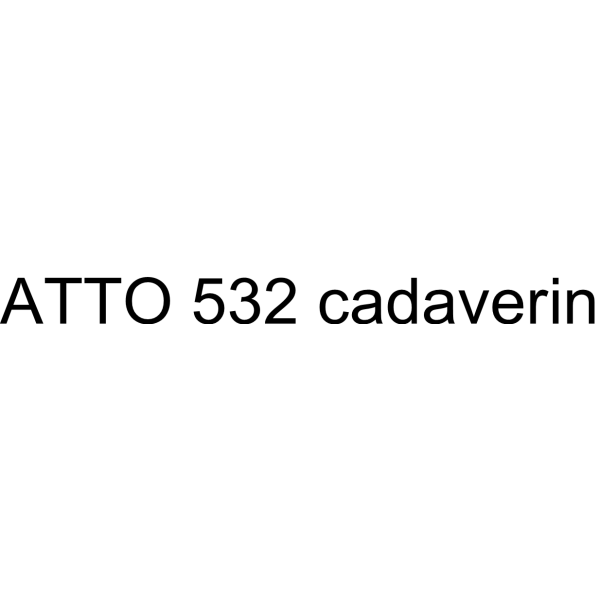
- HY-D2070
-
|
|
Fluorescent Dye
|
Others
|
|
ATTO 680 cadaverin is a cadaverine derivative of ATTO 680, used for carboxylic acid, aldehyde and ketone reactions, maximum excitation/emission wavelength: 681/698 nm.
|
-
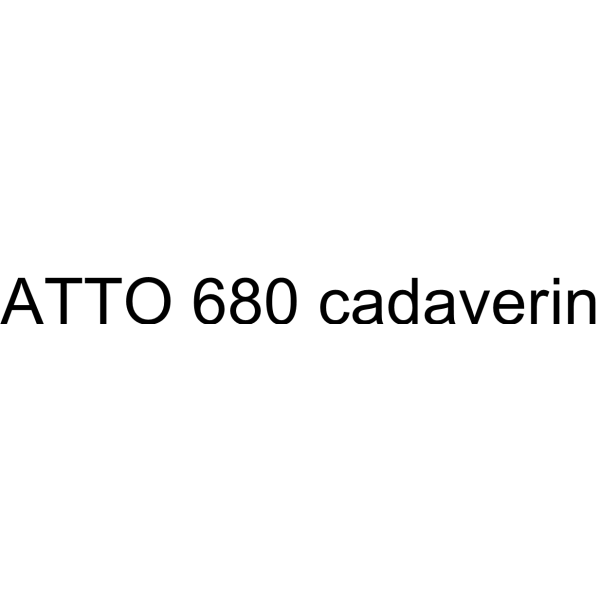
- HY-D2039
-
|
|
Fluorescent Dye
|
Others
|
|
ATTO 550 cadaverin is a cadaverine derivative of ATTO 550, used for carboxylic acid, aldehyde and ketone reactions, maximum excitation/emission wavelength: 554/576 nm.
|
-
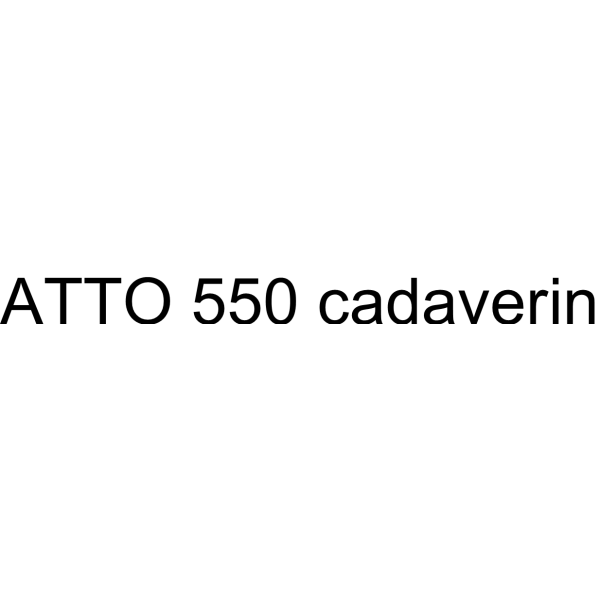
- HY-W588220
-
|
|
Others
|
Others
|
|
rel-cis-Pinic acid is one of the most important oxidation products of α-pinene - a key monoterpene compound in biogenic emission processes .
|
-
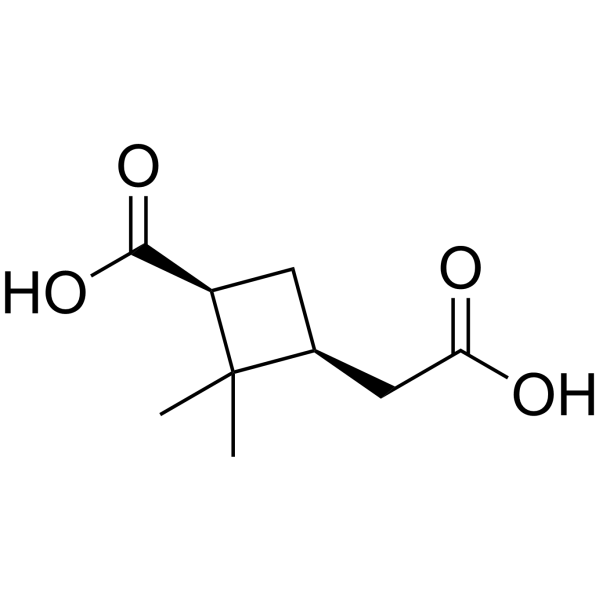
- HY-135172
-
|
|
Fluorescent Dye
|
Others
|
|
Suc-Leu-Tyr-AMC is a fluorometric peptide substrate for µ-calpain and m-calpain. The excitation wavelength is 360 nm and the emission wavelength is 460 nm .
|
-
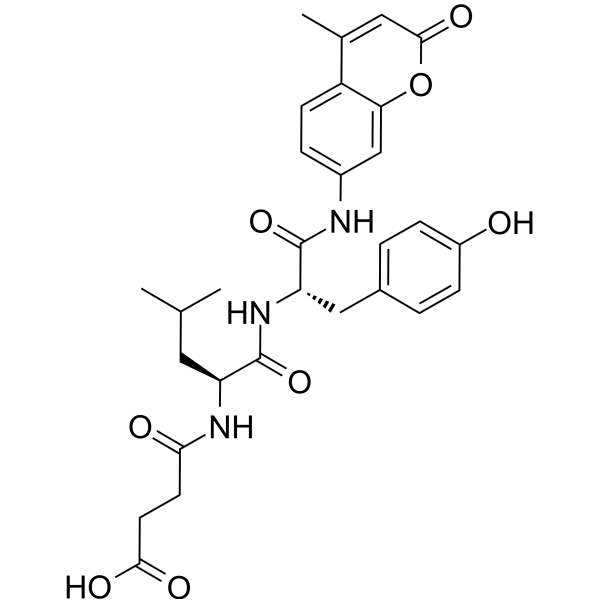
- HY-D2268A
-
|
|
Amyloid-β
Fluorescent Dye
|
Neurological Disease
|
|
QM-FN-SO3 ammonium is a BBB-penetrable near-infrared (NIR) aggregation-induced emission (AIE)-active probe for Aβ plaques. QM-FN-SO3 ammonium can be used for in vivo detection of Aβ plaques. QM-FN-SO3 ammonium has ultra-high S/N ratio, binding affinity, and high-performance NIR emission .
|
-
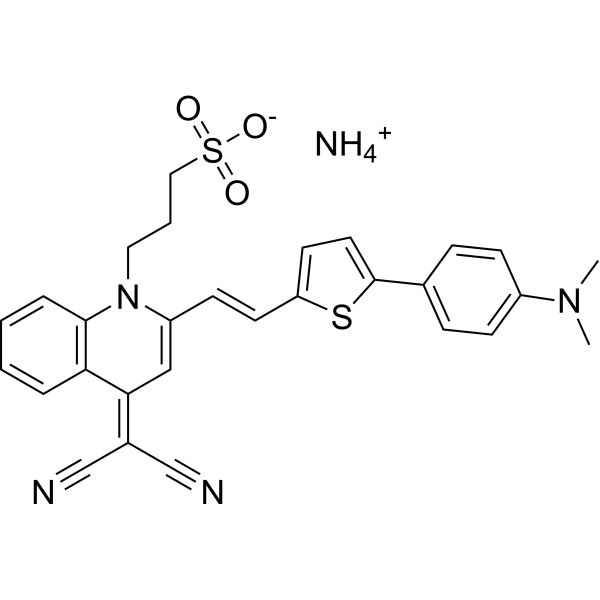
- HY-D1090
-
|
|
DNA Stain
|
Others
|
|
JOE is a fluorescent dye and can be used as a fluorescent label in DNA sequencing, PCR, and LCR amplifications. JOE possesses an absorbance of 525 nm and an emission of 550 nm .
|
-
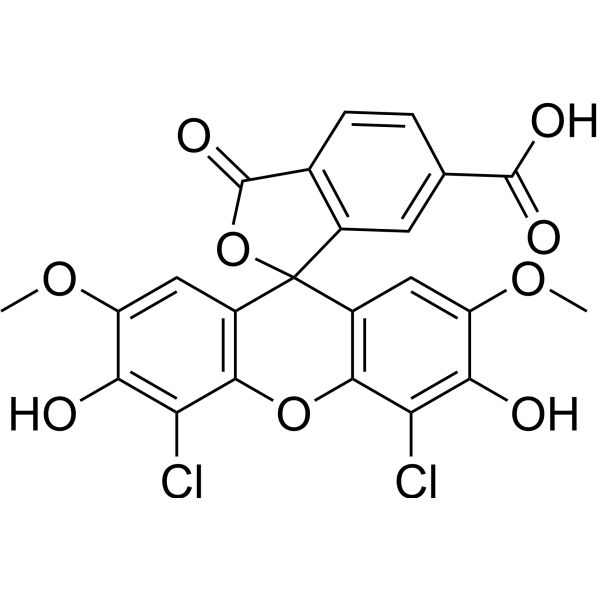
- HY-153549
-
|
|
CXCR
|
Others
|
|
Pentixafor is a peptide that targets CXCR4. Pentixafor is capable of being labelled with 68Gallium ( 68Ga) for positron emission tomography (PET) imaging .
|
-
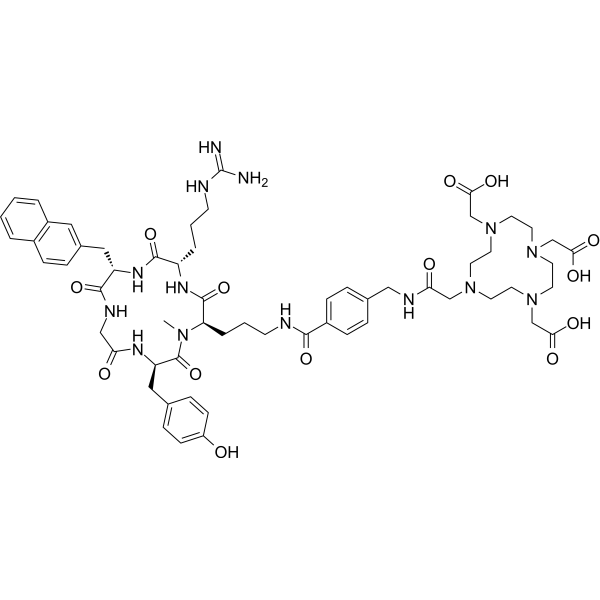
- HY-D1918
-
|
|
Fluorescent Dye
|
Others
|
|
ATTO 390 maleimide is a maleimide ester derivative of ATTO 390, which can be used to label proteins or antibodies. The maximum excitation/emission wavelength: 390/476 nm.
|
-
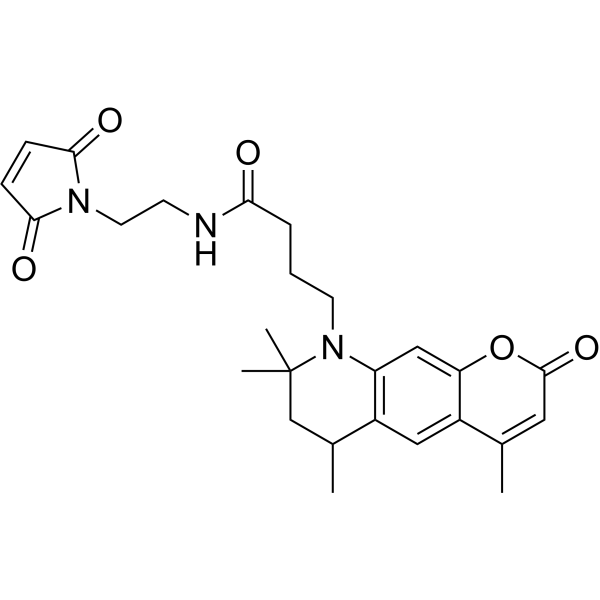
- HY-D1925
-
|
|
Fluorescent Dye
|
Others
|
|
ATTO 425 Maleimide is a maleimide ester derivative of ATTO 425, which can be used to label proteins or antibodies. The maximum excitation emission wavelength: 439/489 nm.
|
-
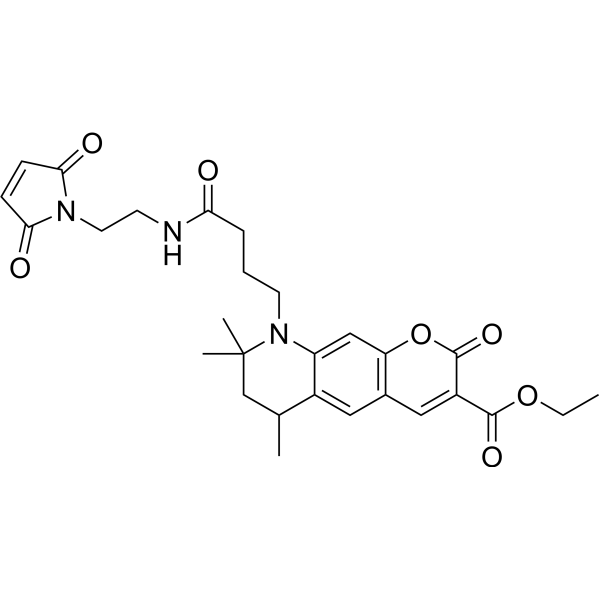
- HY-D1936
-
|
|
Fluorescent Dye
|
Others
|
|
ATTO 465 Maleimid is a maleimide ester derivative of ATTO 465, which can be used to label proteins or antibodies. The maximum excitation/emission wavelength: 453/506 nm.
|
-

- HY-D1948
-
|
|
Fluorescent Dye
|
Others
|
|
ATTO 594 Maleimid is a maleimide ester derivative of ATTO 594, which can be used to label proteins or antibodies, with maximum excitation/emission wavelengths: 603/626 nm.
|
-
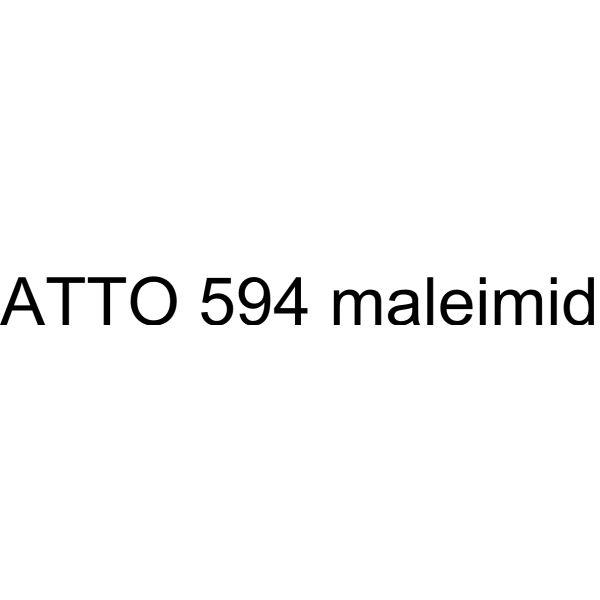
- HY-D1960
-
|
|
Fluorescent Dye
|
Others
|
|
ATTO 633 Maleimid is a maleimide ester derivative of ATTO 633, which can be used to label proteins or antibodies, with maximum excitation/emission wavelengths: 630/651 nm.
|
-
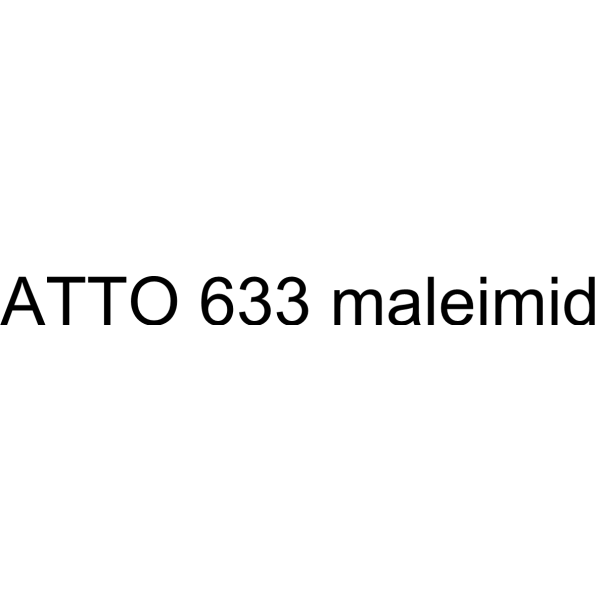
- HY-D1974
-
|
|
Fluorescent Dye
|
Others
|
|
ATTO 610 NHS-Ester is an activated ester derivative of ATTO 610, which can directly label proteins or antibodies. The maximum excitation/emission wavelength: 616/633 nm.
|
-
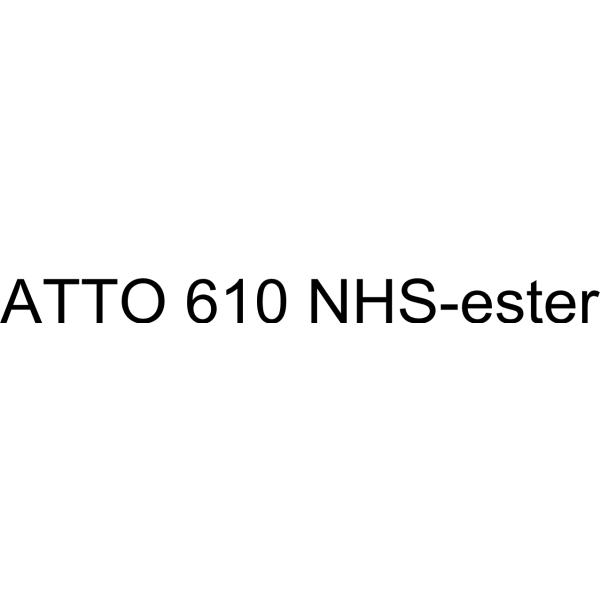
- HY-D1976
-
|
|
Fluorescent Dye
|
Others
|
|
ATTO 610 Maleimid is a maleimide ester derivative of ATTO 610, which can be used to label proteins or antibodies, with maximum excitation/emission wavelengths: 616/633 nm.
|
-
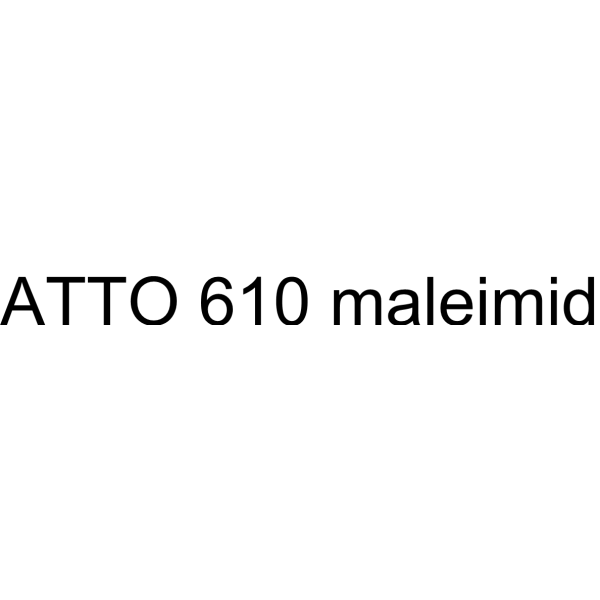
- HY-D1979
-
|
|
Fluorescent Dye
|
Others
|
|
ATTO 725 NHS-Ester is an activated ester derivative of ATTO 725, which can directly label proteins or antibodies. The maximum excitation/emission wavelength: 728/751 nm.
|
-
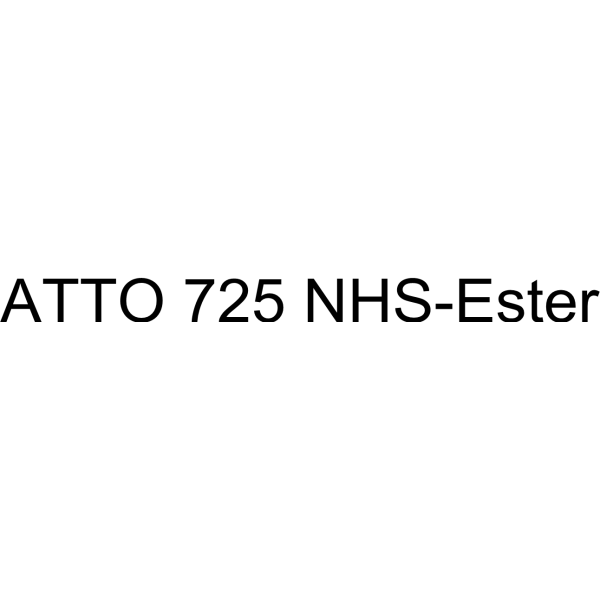
- HY-D1982
-
|
|
Fluorescent Dye
|
Others
|
|
ATTO 725 Maleimid is a maleimide ester derivative of ATTO 725, which can be used to label proteins or antibodies. The maximum excitation/emission wavelength: 728/751 nm.
|
-
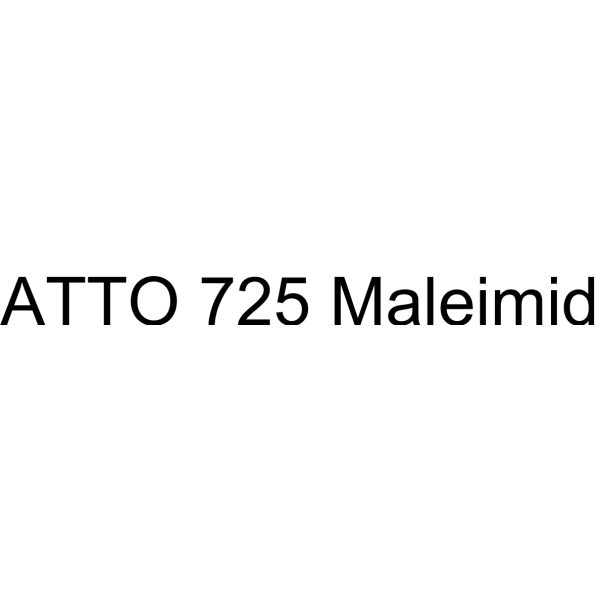
- HY-D1983
-
|
|
Fluorescent Dye
|
Others
|
|
ATTO 620 NHS-Ester is an activated ester derivative of ATTO 620, which can directly label proteins or antibodies. The maximum excitation/emission wavelength: 620/642 nm.
|
-
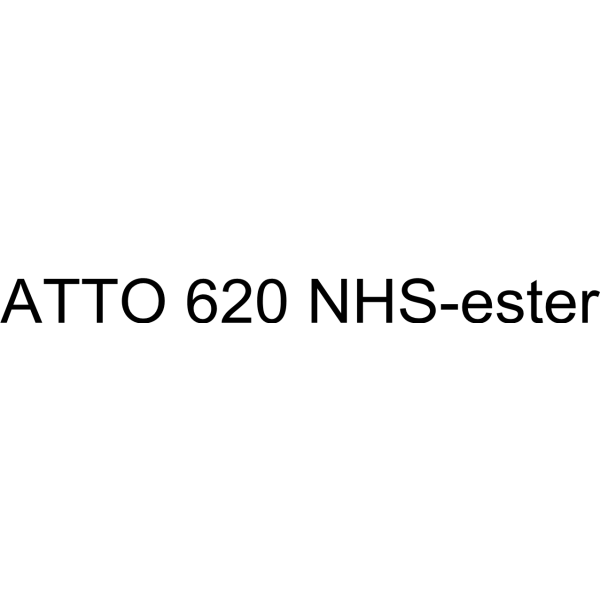
- HY-D1986
-
|
|
Fluorescent Dye
|
Others
|
|
ATTO 620 Maleimid is a maleimide ester derivative of ATTO 620, which can be used to label proteins or antibodies, with maximum excitation/emission wavelengths: 620/642 nm.
|
-

- HY-D1994
-
|
|
Fluorescent Dye
|
Others
|
|
ATTO 647 Maleimid is a maleimide ester derivative of ATTO 647, which can be used to label proteins or antibodies, with maximum excitation/emission wavelengths: 630/651 nm.
|
-

- HY-D2020
-
|
|
Fluorescent Dye
|
Others
|
|
ATTO 665 maleimid is a maleimide ester derivative of ATTO 665, which can be used to label proteins or antibodies. The maximum excitation/emission wavelength: 663/680 nm.
|
-

- HY-D2028
-
|
|
Fluorescent Dye
|
Others
|
|
ATTO 514 maleimid is a maleimide ester derivative of ATTO 514, which can be used to label proteins or antibodies. The maximum excitation/emission wavelength: 511/531 nm.
|
-
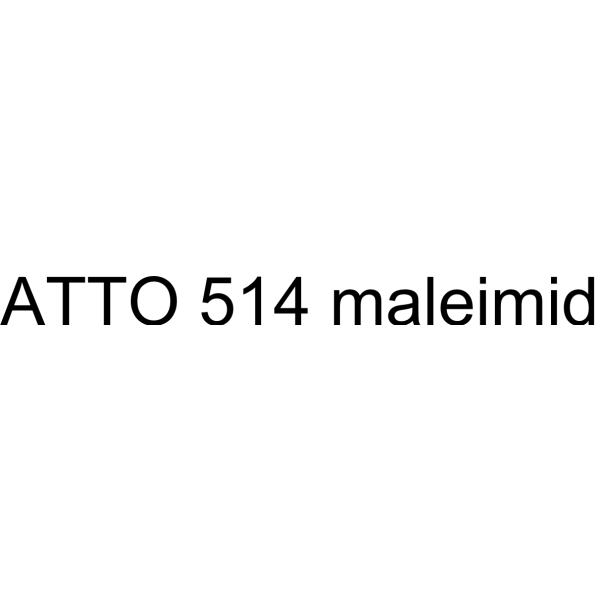
- HY-101186
-
MK-6240
1 Publications Verification
|
Others
|
Neurological Disease
|
|
MK-6240 is a tau positron emission tomography (PET) tracer for neurofibrillary tangles (NFTs), exhibiting high specificity and selectivity for binding to NFTs .
|
-
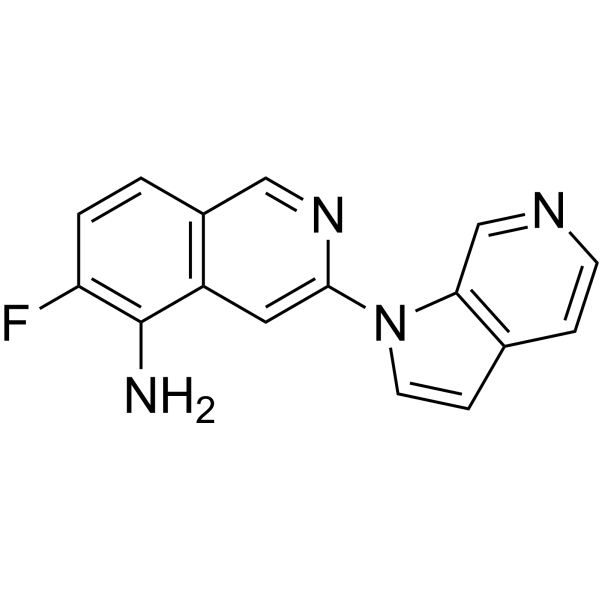
- HY-D0022
-
|
5-AF
|
Fluorescent Dye
|
Others
|
|
5-Aminofluorescein (5-AF) is a fluorescence marker, covalently bound to human serum albumin. The excitation wavelength is 495 nm and the emission wavelength is 535 nm .
|
-
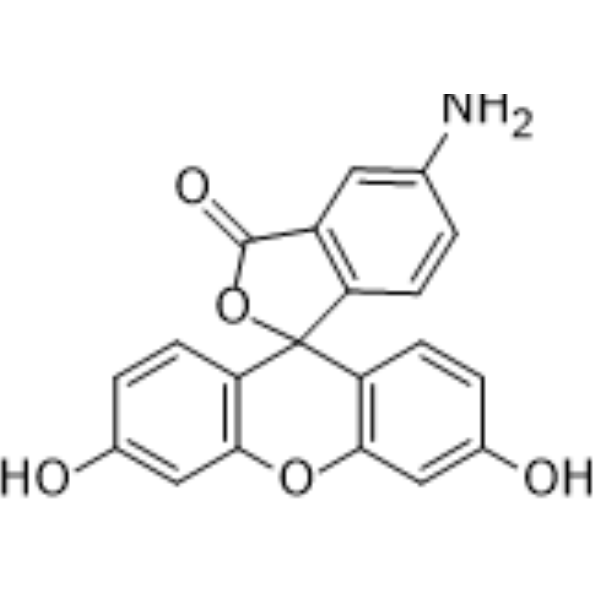
- HY-D1442
-
|
|
Fluorescent Dye
|
Others
|
|
SBFI (tetraammonium), the tetraammonium salt of SBFI, is a sodium fluorescence indicator. SBFI (tetraammonium) is sodium-sensitive dye. The excitation wavelength is set 333 nm, and the emission wavelength is 539 nm for SBFI .
|
-
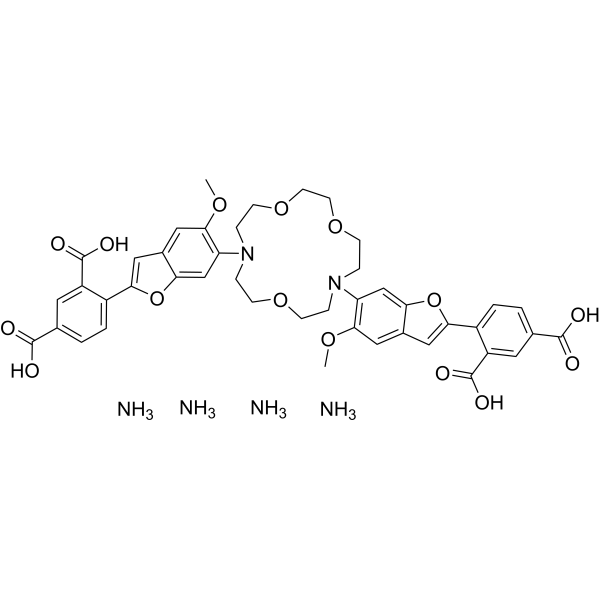
- HY-D0053
-
|
6-Carboxy-X-rhodamine
|
Fluorescent Dye
|
Others
|
|
6-ROX, a fluorescent marker of oligonucleotides, acts as a receptor coupled to 5-FAM and as a donor in FRET imaging. Excitation wavelength: 568nm. Emission wavelength: 568nm.
|
-
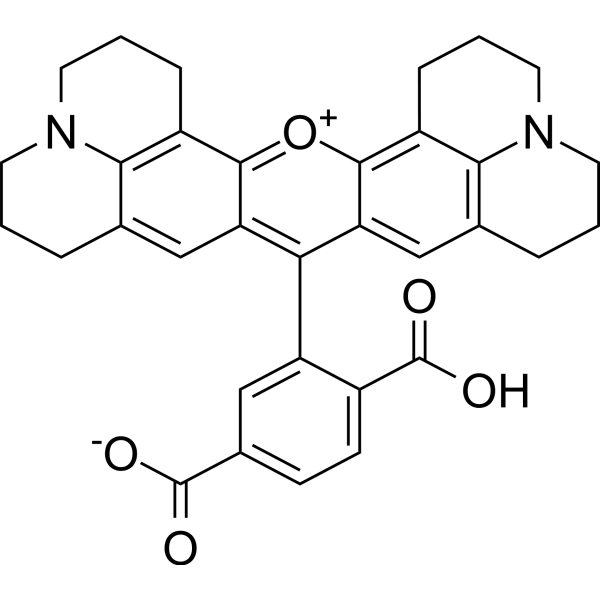
- HY-D0981
-
|
Coumarin 151; AFC
|
Fluorescent Dye
|
Others
|
|
7-Amino-4-(trifluoromethyl)coumarin (Coumarin 151) is a fluorescent marker for the sensitive detection of proteinases. The excitation and emission wavelengths are 400 and 490 nm, respectively.
|
-

- HY-D1494
-
|
|
Amyloid-β
|
Neurological Disease
|
|
FSB is a fluorescent dye that can be used to detect filamentous tau and to label human amyloid lesions with high sensitivity and specificity (excitation: 390 nm, emission: 520 nm) .
|
-

- HY-D1916
-
|
|
Fluorescent Dye
|
Others
|
|
ATTO 594 is a new type of fluorescent dye with high fluorescence yield, which can be used for most labeling applications, maximum excitation/emission wavelength: 603/626 nm.
|
-
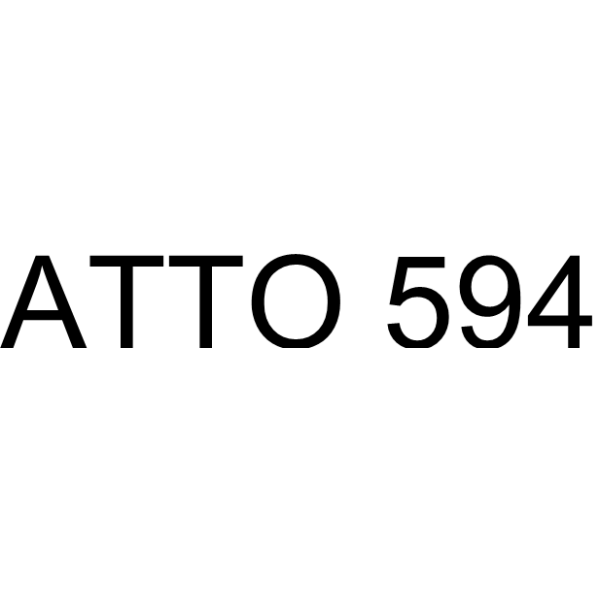
- HY-D1931
-
|
|
Fluorescent Dye
|
Others
|
|
ATTO 590 is a new type of fluorescent dye with high fluorescence yield, which can be used for most labeling applications, maximum excitation/emission wavelength: 594/622 nm.
|
-
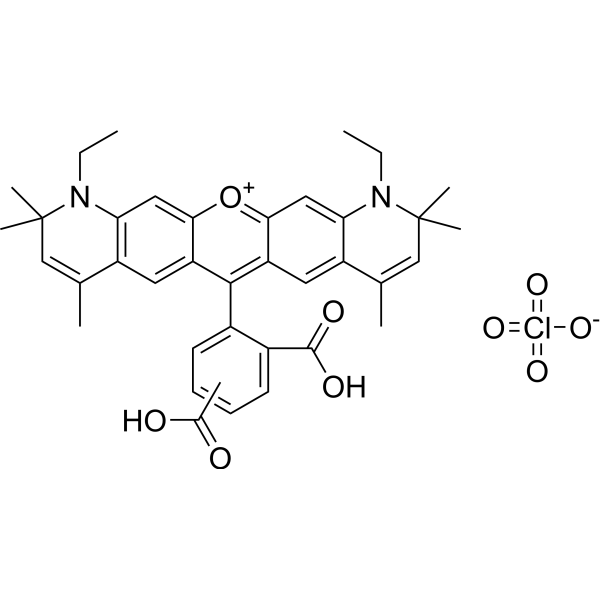
- HY-D1950
-
|
|
Fluorescent Dye
|
Others
|
|
ATTO 633 is a new type of fluorescent dye with high fluorescence yield, which can be used for most labeling applications, maximum excitation/emission wavelength: 630/651 nm.
|
-
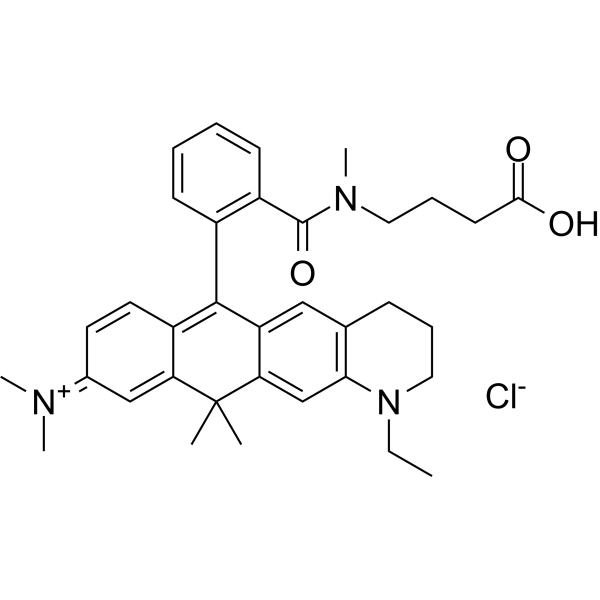
- HY-D1958
-
|
|
Fluorescent Dye
|
Others
|
|
ATTO 565 is a new type of fluorescent dye with high fluorescence yield, which can be used for most labeling applications, maximum excitation/emission wavelength: 564/590 nm.
|
-
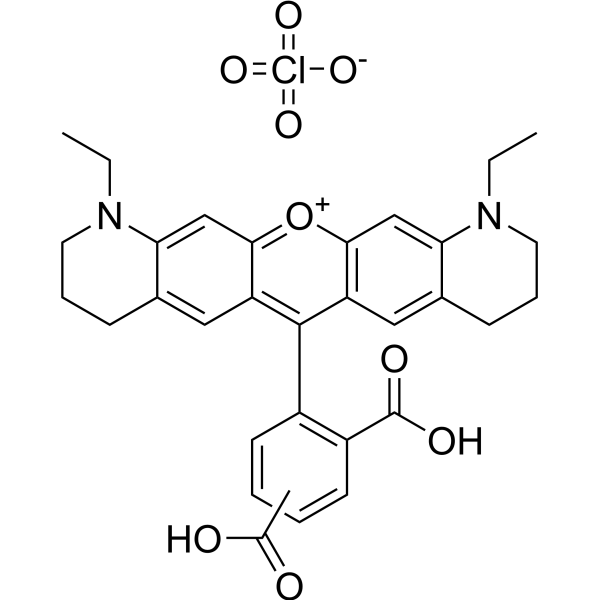
- HY-D1971
-
|
|
Fluorescent Dye
|
Others
|
|
ATTO 725 is a new type of fluorescent dye with high fluorescence yield, which can be used for most labeling applications, maximum excitation/emission wavelength: 728/751 nm.
|
-

- HY-D1991
-
|
|
Fluorescent Dye
|
Others
|
|
ATTO 647 is a new type of fluorescent dye with high fluorescence yield, which can be used for most labeling applications, maximum excitation/emission wavelength: 647/667 nm.
|
-
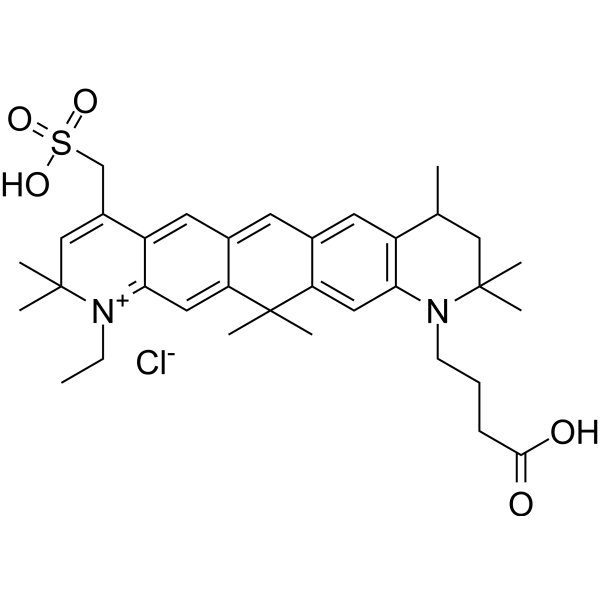
- HY-D1997
-
|
|
Fluorescent Dye
|
Others
|
|
ATTO 665 is a new type of fluorescent dye with high fluorescence yield, which can be used for most labeling applications, maximum excitation/emission wavelength: 663/680 nm.
|
-

- HY-D2000
-
|
|
Fluorescent Dye
|
Others
|
|
ATTO 488 is a new type of fluorescent dye with high fluorescence yield, which can be used for most labeling applications, maximum excitation/emission wavelength: 500/520 nm.
|
-

- HY-D2043
-
|
|
Fluorescent Dye
|
Others
|
|
ATTO 620 is a new type of fluorescent dye with high fluorescence yield, which can be used for most labeling applications, maximum excitation/emission wavelength: 620/642 nm.
|
-
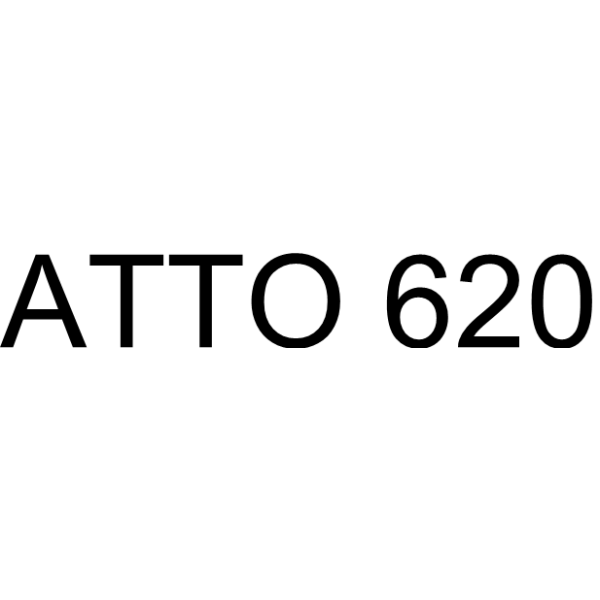
- HY-D2071
-
|
|
Fluorescent Dye
|
Others
|
|
ATTO 680 is a new type of fluorescent dye with high fluorescence yield, which can be used for most labeling applications, maximum excitation/emission wavelength: 681/698 nm.
|
-

- HY-D2056
-
|
|
Fluorescent Dye
|
Others
|
|
ATTO 700 is a new type of fluorescent dye with high fluorescence yield, which can be used for most labeling applications, maximum excitation/emission wavelength: 700/716 nm.
|
-
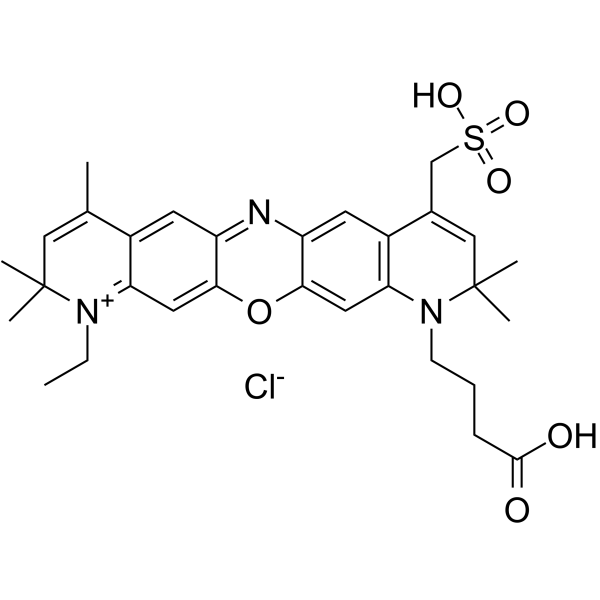
- HY-D2060
-
|
|
Fluorescent Dye
|
Others
|
|
ATTO 740 is a new type of fluorescent dye with high fluorescence yield, which can be used for most labeling applications, maximum excitation/emission wavelength: 743/763 nm.
|
-
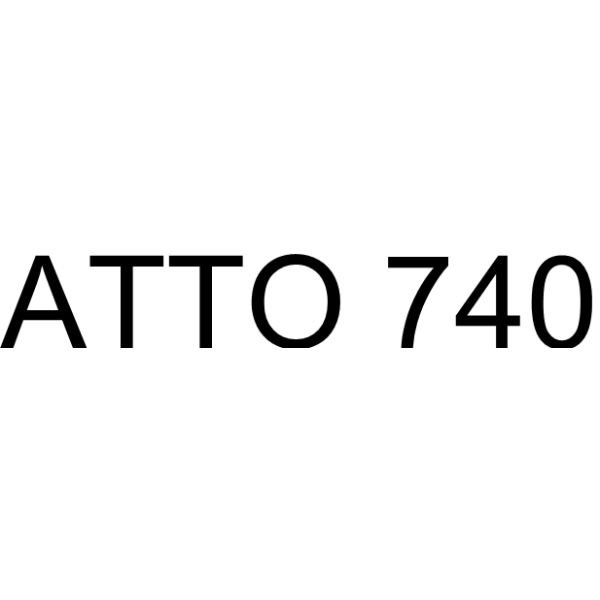
- HY-D2017
-
|
|
Fluorescent Dye
|
Others
|
|
ATTO 550 is a new type of fluorescent dye with high fluorescence yield, which can be used for most labeling applications, maximum excitation/emission wavelength: 554/576 nm.
|
-
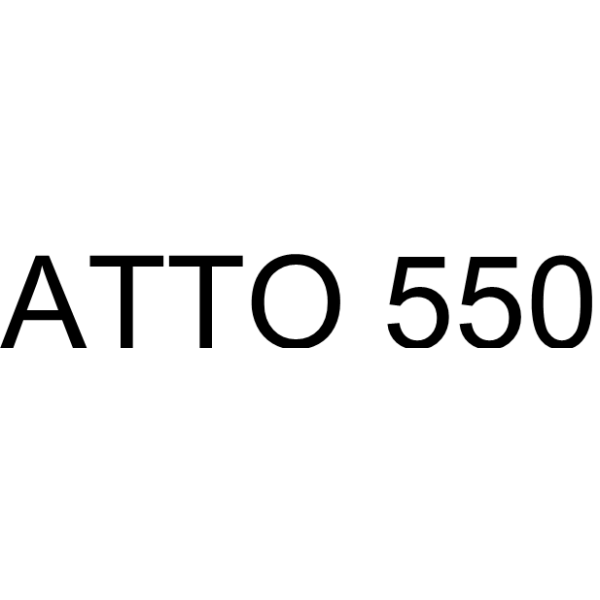
- HY-D2044
-
|
|
Fluorescent Dye
|
Others
|
|
ATTO 532 is a new type of fluorescent dye with high fluorescence yield, which can be used for most labeling applications, maximum excitation/emission wavelength: 532/552 nm.
|
-

- HY-D2042
-
|
|
Fluorescent Dye
|
Others
|
|
ATTO 610 is a new type of fluorescent dye with high fluorescence yield, which can be used for most labeling applications, maximum excitation/emission wavelength: 616/633 nm.
|
-

- HY-D1385
-
|
|
Fluorescent Dye
|
Others
|
|
JF526–Pepstatin A TFA is a fluorescent dye that can be used for lysosomal staining in live cells. The excitation maximum is 530 nm and the emission maximum is 549 nm .
|
-
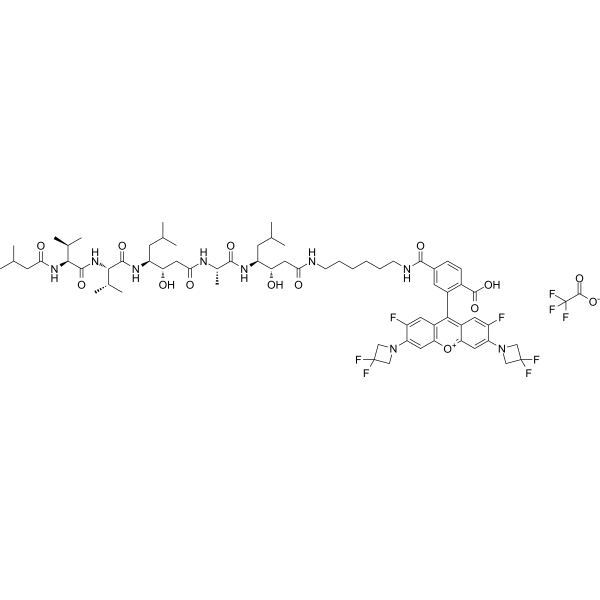
- HY-101882
-
BCECF
1 Publications Verification
2′,7′-Bis(2-carboxyethyl)-5(6)-carboxyfluorescein
|
Fluorescent Dye
|
Others
|
|
BCECF is a pH-sensitive fluorescent dye. BCECF allows measurements in the physiological pH range 6.0–8.0. Excitation ratio: 490/440 nm; Emission intensity: 535 nm.
|
-
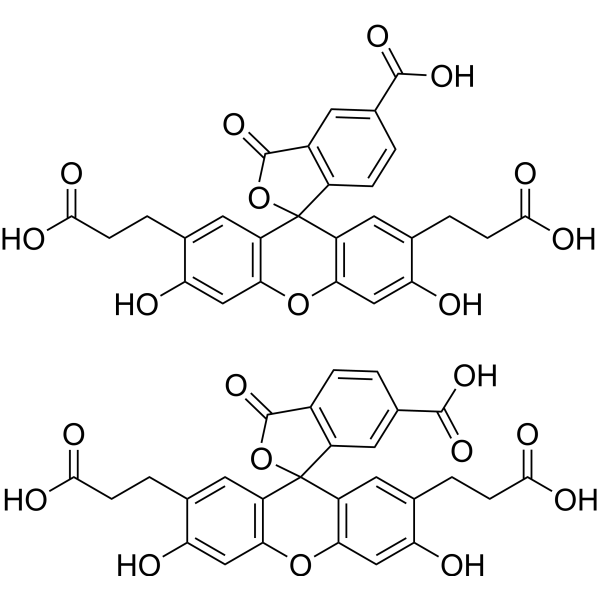
- HY-D1151
-
|
|
Reactive Oxygen Species
Fluorescent Dye
|
Others
|
|
HKOH-1 is a highly sensitive green fluorescent probe for the specific detection of ·OH in living cells with a maximum excitation wavelength and emission wavelength of 500 nm and 520 nm, respectively .
|
-
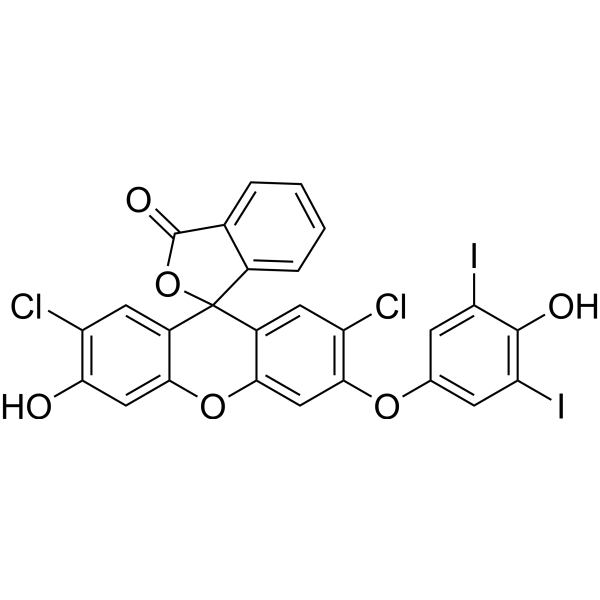
- HY-143702
-
|
NBD-DOTAP
|
Liposome
|
Inflammation/Immunology
Cancer
|
|
Fluorescent DOTAP, a cationic lipid, can be used for the research of nucleic acid and protein delivery . Fluorescent DOTAP is labeled with a fluorophore NBD (maximum excitation/emission wavelength ∼463/536 nm).
|
-
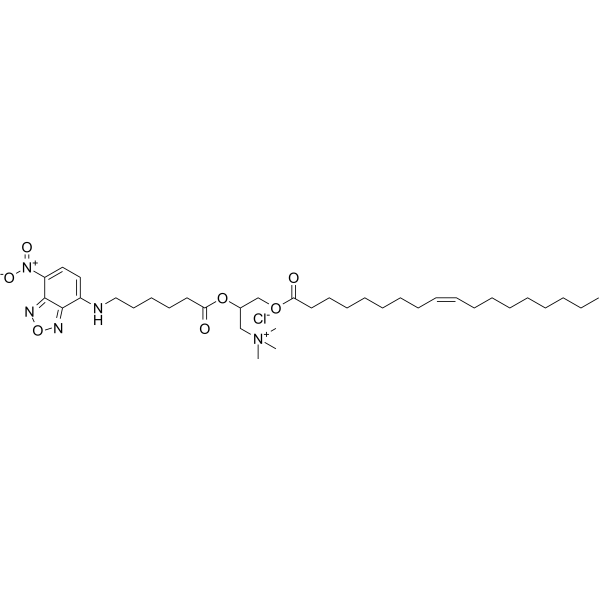
- HY-D1645
-
|
|
Fluorescent Dye
|
Others
|
|
DANSYL-X, SE is an environmentally sensitive hydrophobic dye (Excitation 333 nM; Emission 518 nM). DANSYL-X, SE can increase fluorescence intensity in hydrophobic environment .
|
-
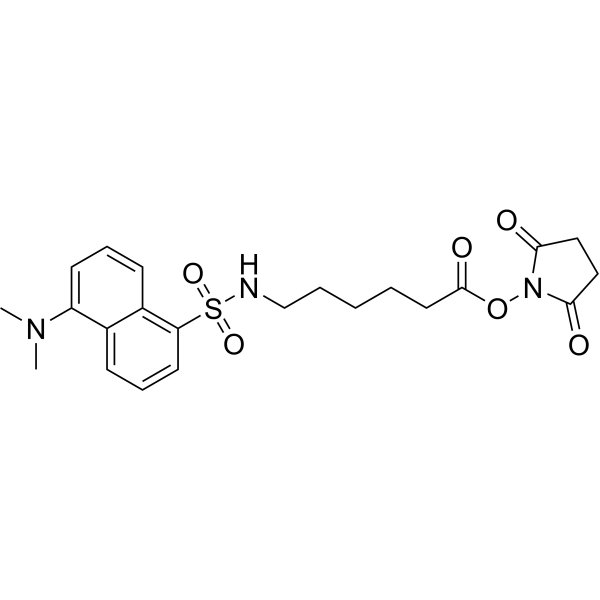
- HY-D2195
-
|
|
Fluorescent Dye
|
Others
|
|
AgAuSe-PEG-NH2 (1000 nm) is a fluorescent quantum dot that emits fluorescence in the near-infrared II region, with an emission peak reaching 1000 nm that can be used in bioimaging.
|
-
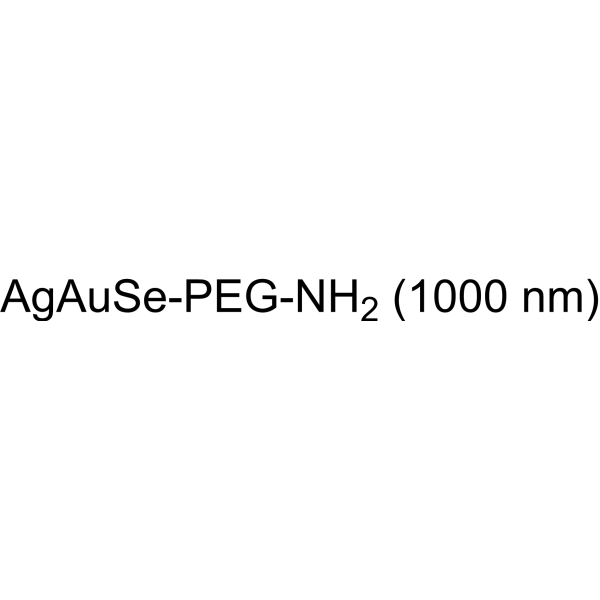
- HY-161164
-
|
|
DNA Stain
|
Others
|
|
Tricyclic cytosine tC is a fluorescent base analogue that can be used as a fluorescent probe in nucleic acid-containing systems. The excitation wavelength is 385 nm and the emission wavelength is 505 nm .
|
-
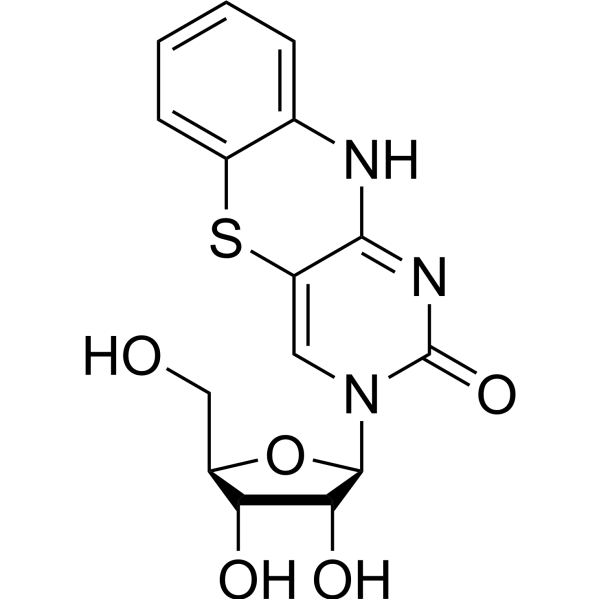
- HY-D0941
-
|
|
Fluorescent Dye
|
Others
|
|
5-Carboxytetramethylrhodamine can be used as a fluorescent probe of nucleic acids and proteins. 5-Carboxytetramethylrhodamine displays excitation maxima of 558 nm and an emission maximum of 586 nm .
|
-

- HY-D0121
-
|
|
Fluorescent Dye
|
Others
|
|
INDO 1 is a fluorescent Ca 2+ indicator, binds specifically to Ca 2+ while emitting fluorescence, the maximum emission wavelength shifts from 485 nm before binding to 410 nm .
|
-
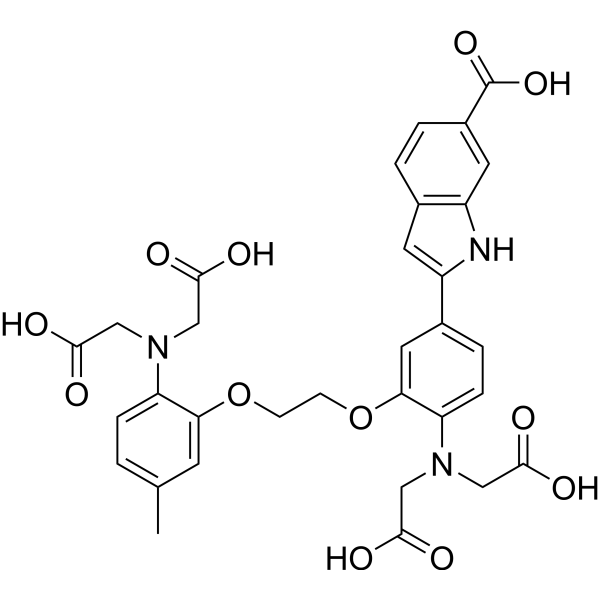
- HY-147173
-
|
|
FAP
|
Cancer
|
|
FAPI-74 is a PET (positron emission tomography) tracer targeting the fibroblast activation protein (FAP). FAPI-74 can be used for FAP-positive tumor research .
|
-
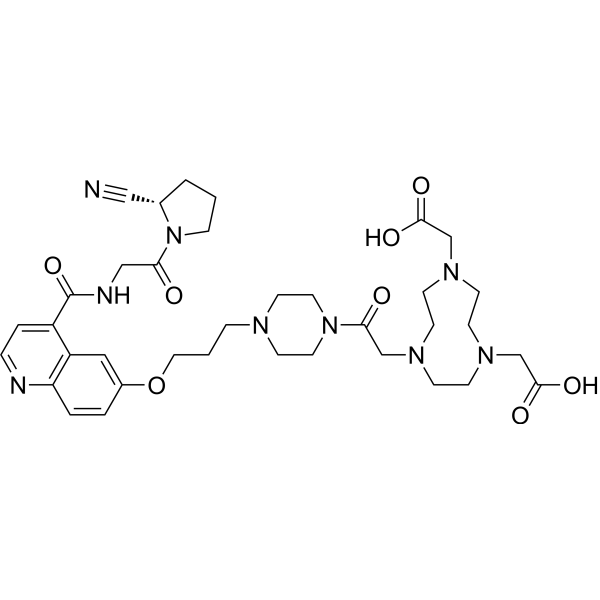
- HY-D2198
-
|
|
Fluorescent Dye
|
Others
|
|
AgAuSe-PEG-NH2 (1120 nm) is a fluorescent quantum dot that emits fluorescence in the near-infrared II region, with an emission peak reaching 1120 nm that can be used in bioimaging .
|
-

- HY-P9902A
-
|
|
PD-1/PD-L1
|
Cancer
|
|
Pembrolizumab (anti-PD-1) is a humanized IgG4 antibody and PD-1 inhibitor. Pembrolizumab produces PD-1 blockade, preventing PD-L1 and PD-L2 from connecting to PD-1. This avoids the uncontrolled regulation of T cells on cells that normally express PD-1 .
|
-
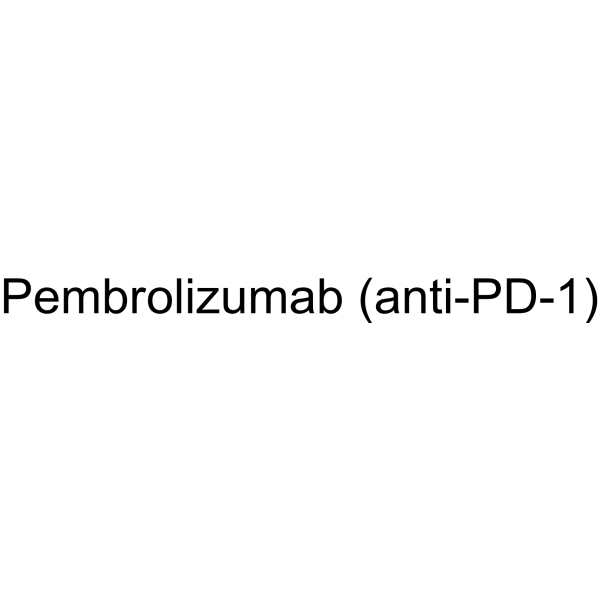
- HY-15942
-
|
|
Fluorescent Dye
|
Others
|
|
5-TAMRA (5-Carboxytetramethylrhodamine), SE and its conjugates yield bright, pH-insensitive orange-red fluorescence (approximate excitation/emission maxima ~546/579) with good photostability.
|
-
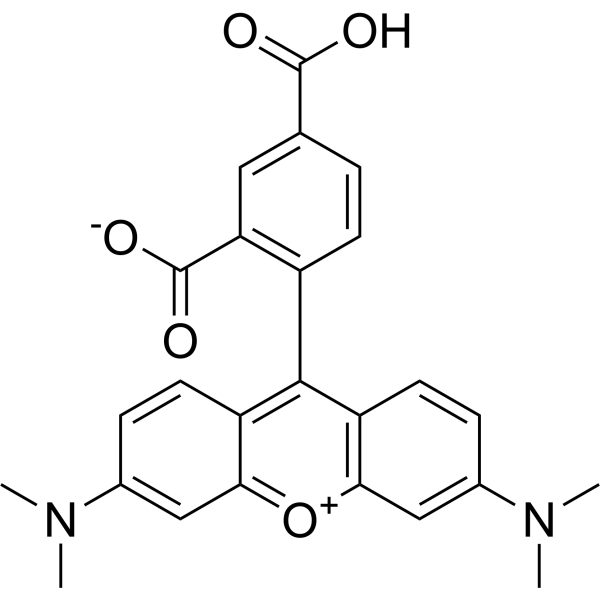
- HY-129059
-
|
NNC 756
|
Dopamine Receptor
|
Neurological Disease
|
|
Odapipam (NNC 756) is a selective, high affinity and benzazepine dopamine D1 receptor antagonist with a Kd of 0.18 nM. Odapipam is also a superior positron emission tomography (PET) radiotracer .
|
-
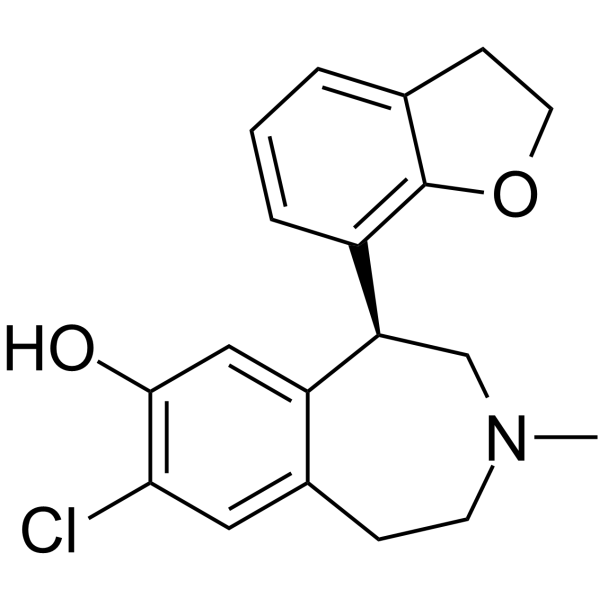
- HY-D1148
-
|
|
Fluorescent Dye
|
Others
|
|
HKGreen-4I is a highly sensitive green fluorescent probe for the specific detection of ONOO - in living cells with a maximum excitation wavelength and emission wavelength of 520 nm and 543 nm, respectively .
|
-
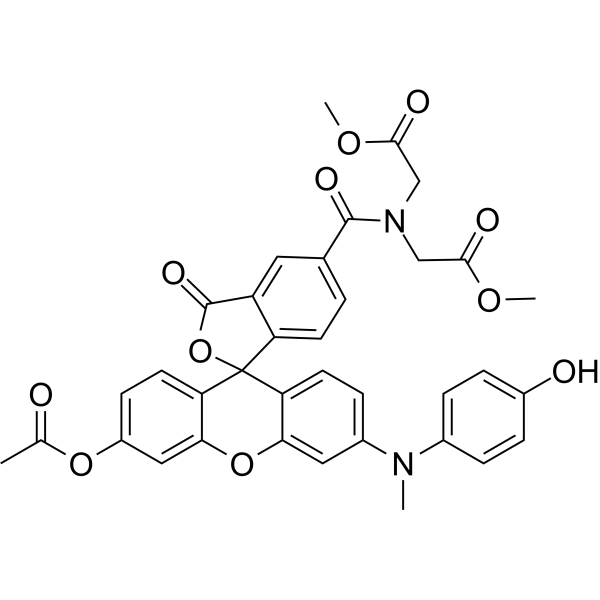
- HY-D1159
-
HKOH-1r
1 Publications Verification
|
Reactive Oxygen Species
Fluorescent Dye
|
Others
|
|
HKOH-1r is a highly sensitive green fluorescent probe for the specific detection of ·OH in living cells with a maximum excitation wavelength and emission wavelength of 500 nm and 520 nm, respectively .
|
-
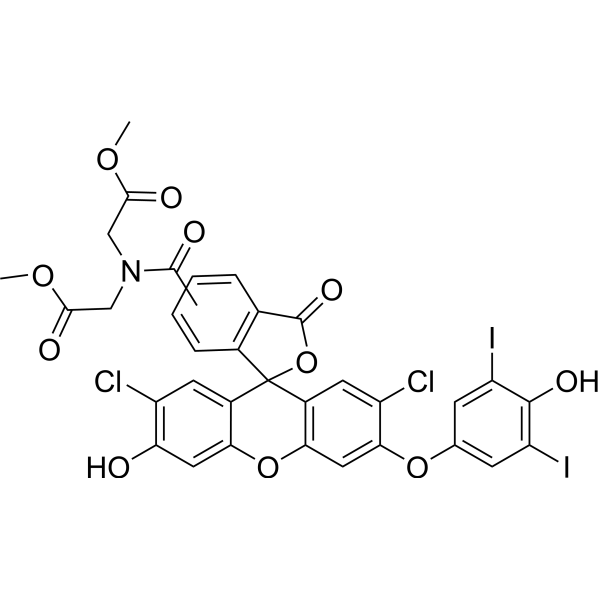
- HY-133852
-
|
|
Fluorescent Dye
|
Others
|
|
FD-1080 is a fluorophore with both excitation and emission in the NIR-II region (Ex=1064 nm, Em=1080 nm). FD-1080 can be used for in vivo imaging .
|
-
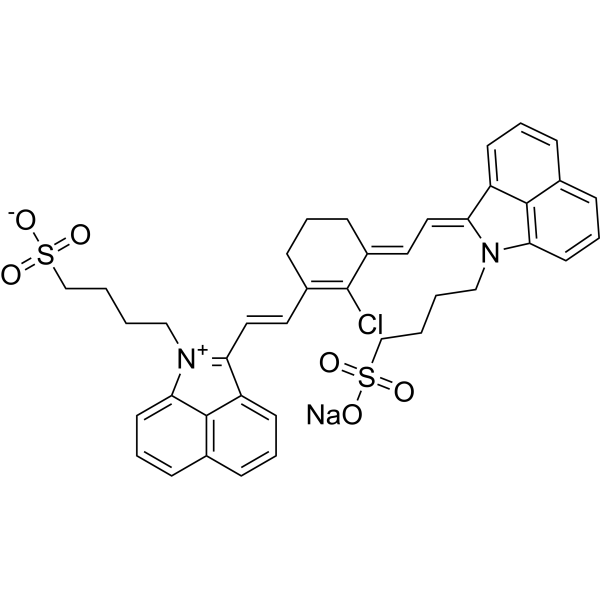
- HY-D1497
-
|
|
Fluorescent Dye
|
Others
|
|
Fluorescent Red Mega 480 is a dye that is specifically designed for multicolor techniques. Fluorescent Red Mega 480 is characterized by an extremely large stoke′s shift between excitation and emission maxima .
|
-
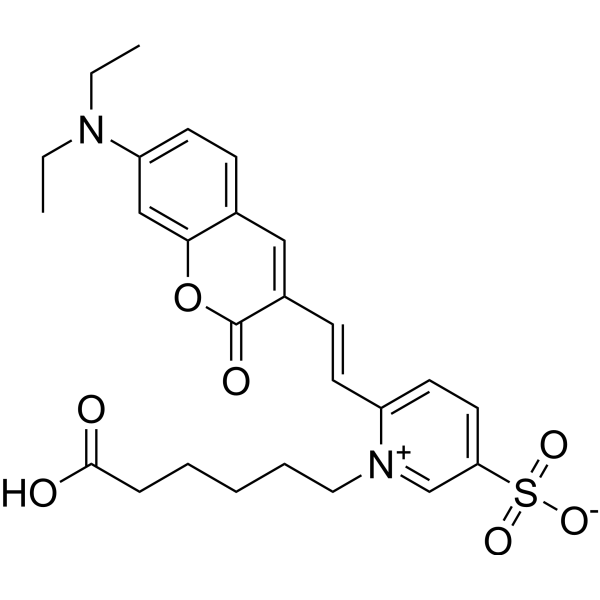
- HY-D0121A
-
|
|
Fluorescent Dye
|
|
|
INDO 1 pentapotassium is a fluorescent Ca 2+ indicator, binds specifically to Ca 2+ while emitting fluorescence, the maximum emission wavelength shifts from 485 nm before binding to 410 nm .
|
-

- HY-D1176
-
|
|
Fluorescent Dye
|
Others
|
|
Calcium Green 1AM is a cell-permeant fluorescent calcium indicator (Excitation 506 nm; Emission 531 nm). Calcium Green 1AM is converted to the fluorescent calcium indicator by intracellular esterases .
|
-
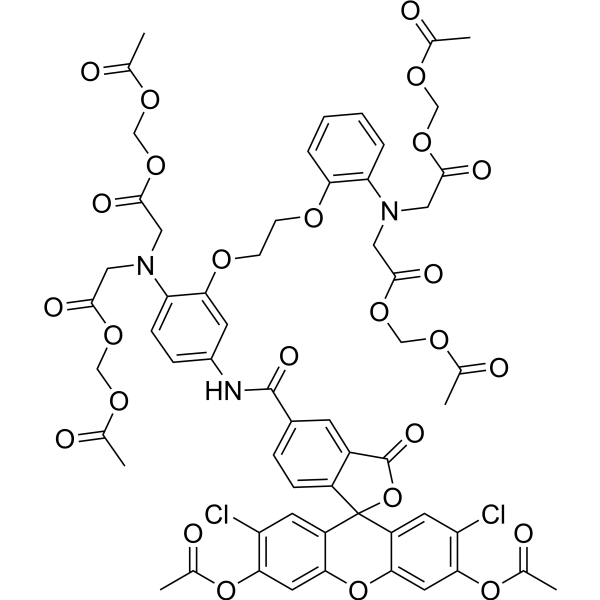
- HY-D1683
-
|
|
Fluorescent Dye
|
Others
|
|
NBD-PE is an effective lipid fluorescent probe (Excitation/Emission: 465/535 nm; Color: Green). NBD-PE offers a wide array of applications in membrane and cell biology .
|
-

- HY-121930
-
-
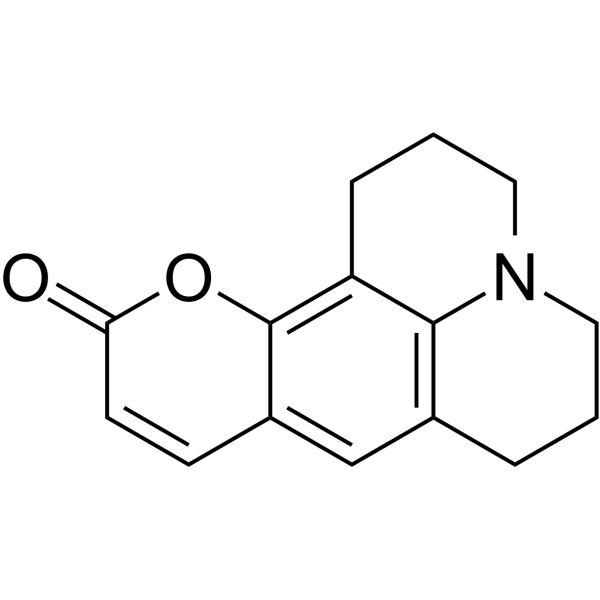
- HY-D0048
-
|
5-TAMRA-NHS ester; 5-Carboxytetramethylrhodamine succinimidyl ester
|
Fluorescent Dye
|
Others
|
|
5-TAMRA-SE is an amine-reactive fluorescent agent, its conjugates yield bright, pH-insensitive orange-red fluorescence (approximate excitation/emission maxima ~546/579) with good photostability.
|
-
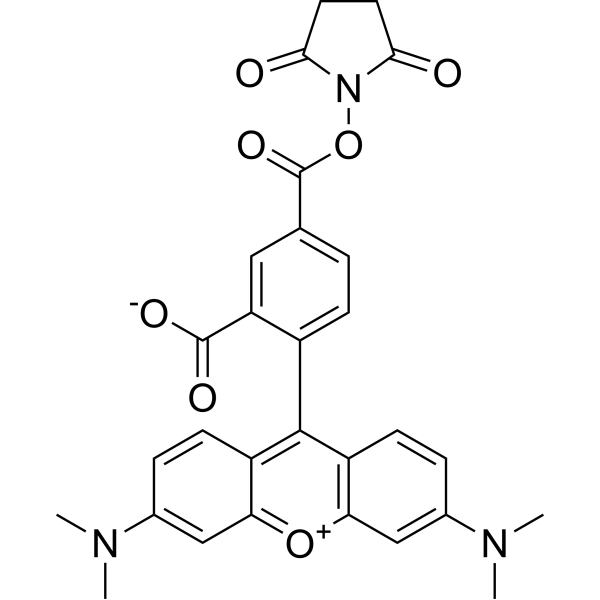
- HY-111514
-
-

- HY-D1116
-
|
|
Fluorescent Dye
|
Others
|
|
MitoMark Red I is a fluorescent mitochondrial marker. MitoMark Red I is a red fluorescent dye which accumulates in mitochondria in viable cells and has an excitation wavelength of 578 nm and emission of 599 nm .
|
-
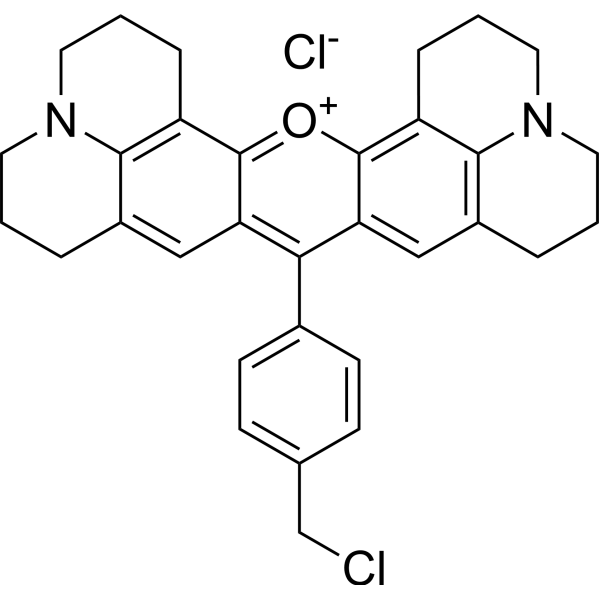
- HY-130022
-
|
|
Fluorescent Dye
|
Others
|
|
HKPerox-1 is a highly sensitive green fluorescent probe for the specific detection of H2O2 in living cells with a maximum excitation wavelength and emission wavelength of 520 nm and 543 nm, respectively .
|
-

- HY-D1157
-
|
|
Fluorescent Dye
Reactive Oxygen Species
|
Others
|
|
HKPerox-2 is a highly sensitive green fluorescent probe for the specific detection of H2O2 in living cells with a maximum excitation wavelength and emission wavelength of 520 nm and 543 nm, respectively .
|
-
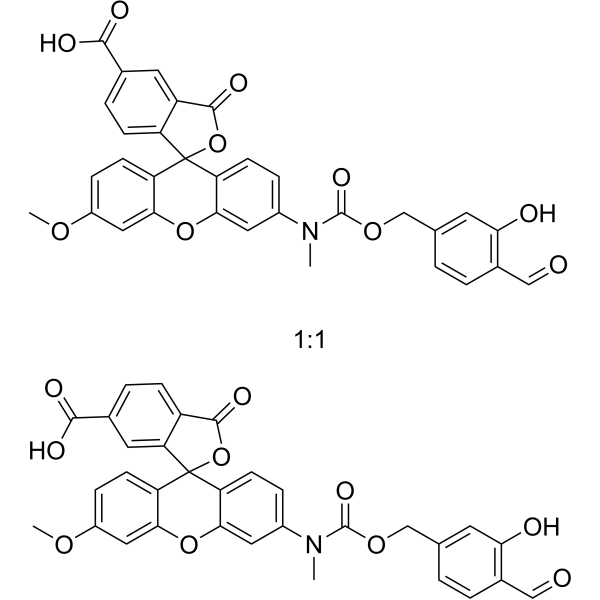
- HY-D1394
-
|
AgAuSe
|
Fluorescent Dye
|
Others
|
|
AgAuSe QDs (AgAuSe) is a near infrared (NIR) fluorescent quantum dots (QDs), with a bright emission from 820 to 1170 nm. AgAuSe QDs can be used for the research in biomedical imaging and NIR devices .
|
-

- HY-125399
-
|
HBED-CC-PSMA
|
PSMA
|
Cancer
|
|
PSMA-11 is a positron emission tomography (PET) tracer. PSMA-11 detects prostate cancer relapses and metastases by binding to the extracellular domain of prostate-specific membrane antigen (PSMA) .
|
-

- HY-137296
-
|
|
Fluorescent Dye
|
Others
|
|
Lumogallion is a highly sensitive fluorescent reagent for the detection of aluminum, gallium and other metals. Lumogallion has an excitation wavelength of 490 nm and an emission spectrum in the range of 520 nm to 650 nm, with a peak near 580 nm .
|
-

- HY-D1240
-
|
|
Biochemical Assay Reagents
|
Others
|
|
Rhodamine 101 inner salt is a bright fluorescent dye with excitation and emission maxima at 565 and 595 nm, respectively. It can be used in various biological applications such as fluorescence microscopy, flow cytometry, fluorescence correlation spectroscopy, and ELISA.
|
-
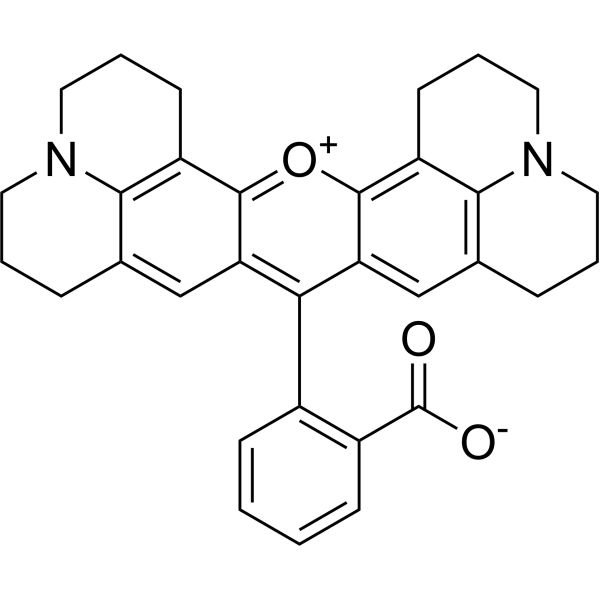
- HY-135497
-
|
|
Dopamine Receptor
|
Neurological Disease
|
|
Fallypride is a potent antagonist of dopamine D2/D3 receptor. Fallypride, in the form of fallypride ( 18F), can be used as a positron emission tomography (PET) radiotracer .
|
-
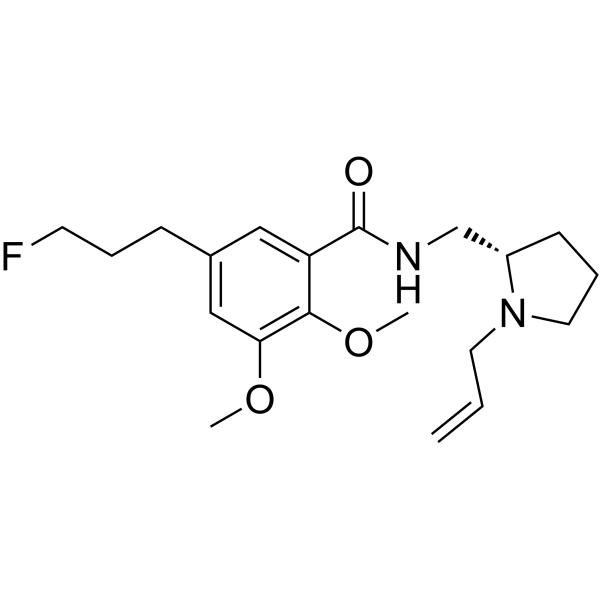
- HY-13615A
-
|
|
Fluorescent Dye
|
Cancer
|
|
EC-17 (disodium salt) is a folate receptor alpha (FRα) targeting contrast agent with fluorescent properties in the visible light spectrum. The peak excitation and emission wavelengths of EC-17 are 470/520 nm.
|
-
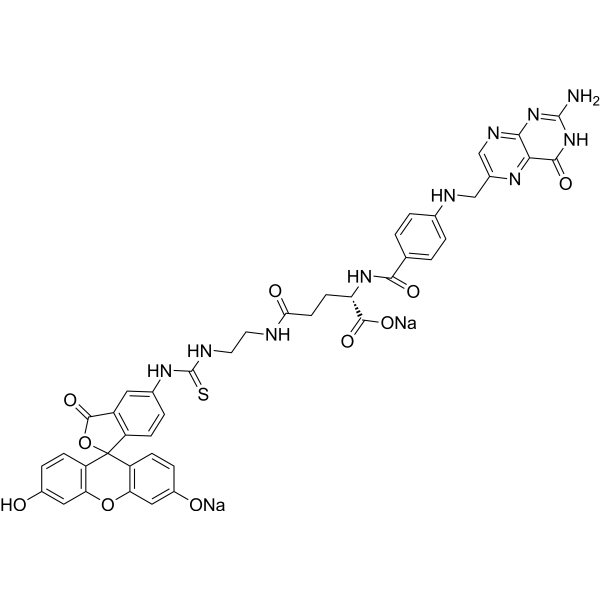
- HY-111653
-
CycLuc1
1 Publications Verification
|
Reactive Oxygen Species
|
Others
|
|
CycLuc1 is a blood-brain barrier permeable luciferase substrate that displays near-infrared (NIR) emission with a peak luminescence wavelength of 599 nm. CycLuc1 can be used for in vivo bioluminescence imaging .
|
-
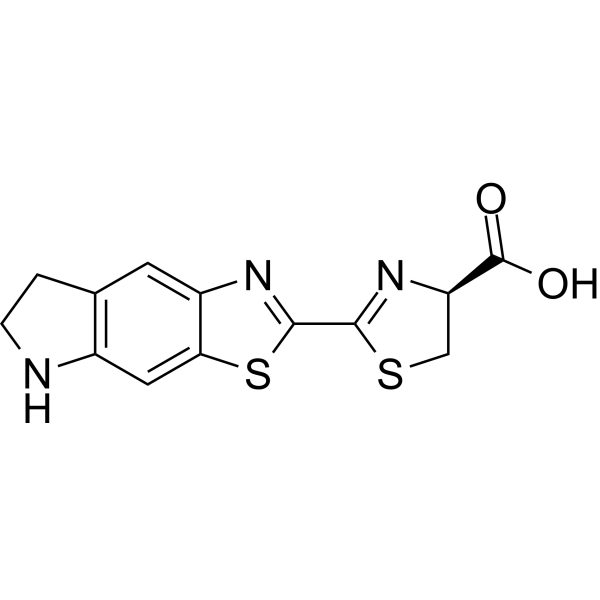
- HY-110210
-
|
BODIPY FL,SE
|
Fluorescent Dye
|
Others
|
|
BODIPY-FL NHS ester (BODIPY FL, SE) is an amine-reactive fluorescent probe. The maximum excitation/emission values are 502/511 nm. BODIPY-FL NHS ester can be used to synthesize protease substrates .
|
-
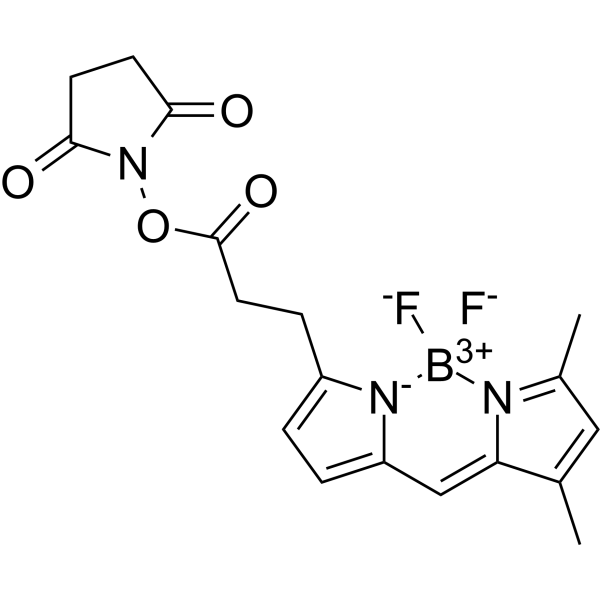
- HY-133852A
-
|
|
Fluorescent Dye
|
Others
|
|
FD-1080 free acid is a fluorophore with both excitation and emission in the NIR-II region (Ex=1064 nm, Em=1080 nm). FD-1080 free acid can be used for in vivo imaging .
|
-
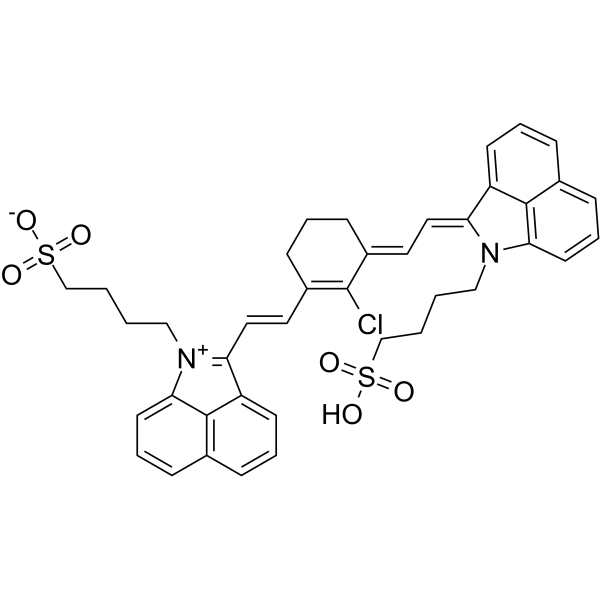
- HY-D0053A
-
|
6-Carboxy-X-rhodamine hydrochloride
|
Fluorescent Dye
|
Others
|
|
6-ROX (6-Carboxy-X-rhodamine) hydrochloride, a fluorescent marker of oligonucleotides, acts as a receptor coupled to 5-FAM and as a donor in FRET imaging. Excitation wavelength: 568 nm. Emission wavelength: 568 nm.
|
-
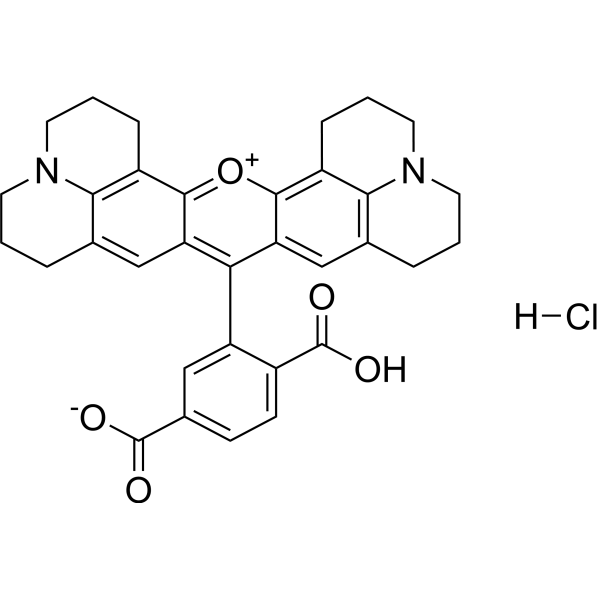
- HY-D1760
-
|
Sodium-binding benzofuran isophthalate
|
Fluorescent Dye
|
Others
|
|
SBFI is a membrane-permeant, fluorescent Na + indicator dye. SBFI is excited at 340 nm and the fluorophore emission is collected at 450 nm . SBFI selective for Na + over K + with Kd values of 20 and 120 mM for these ions, respectively. .
|
-
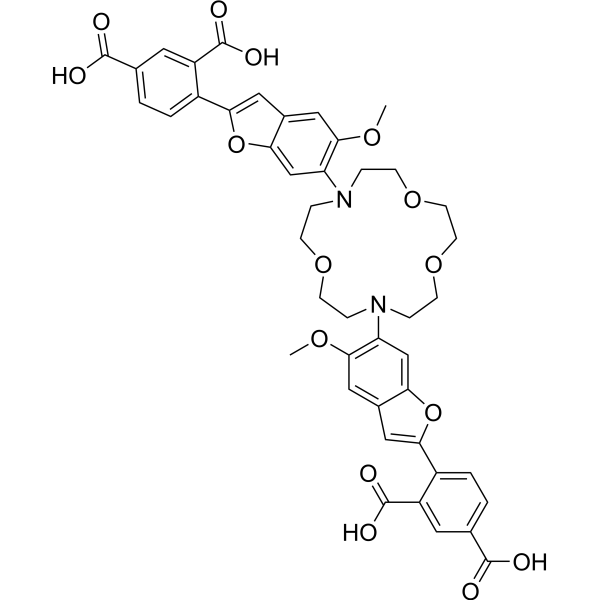
- HY-D1913
-
|
|
Fluorescent Dye
|
Others
|
|
FerroOrange is a fluorescent probe for the detection of unstable divalent iron ions, localized in the endoplasmic reticulum, which emits irreversible orange fluorescence upon encountering divalent iron ions. Excitation/emission wavelength: 542/572 nm.
|
-

- HY-160272
-
|
|
Fluorescent Dye
|
Others
|
|
DOPE-PEG-Fluor 488, MW 2000 is a PEG lipid, composed of a DOPE phospholipid and a Fluor 488 fluorophore. DOPE is an unsaturated phospholipid. Fluor 488 has excitation and emission maxima at 499 nm and 520 nm .
|
-
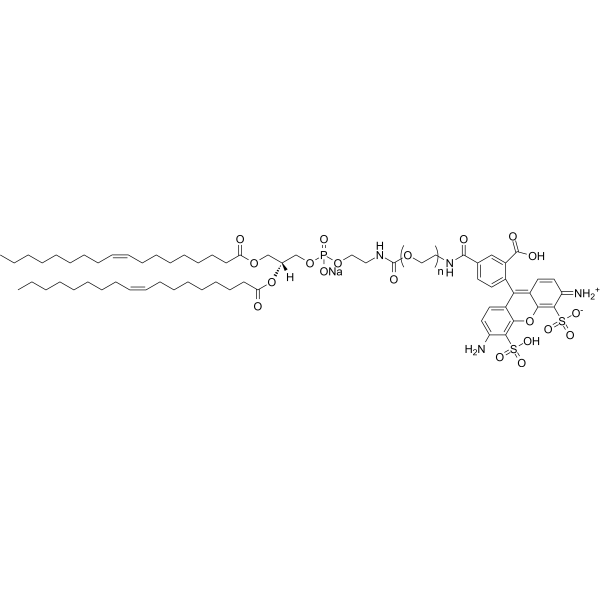
- HY-131006
-
|
|
Monoamine Transporter
|
Neurological Disease
|
|
FFN200 dihydrochloride, a fluorescent substrate of VMAT2, selectively trace monoamine exocytosis in both neuronal cell culture and brain tissue. The fluorescence excitation and emission maxima of FFN200 are determined to be 352 and 451 nm, respectively .
|
-
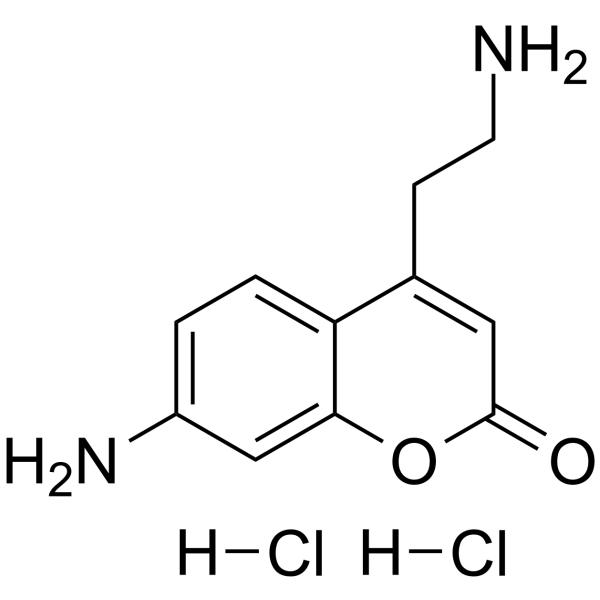
- HY-103326
-
|
|
Cannabinoid Receptor
|
Neurological Disease
|
|
NIDA-41020 is a potent and selective cannabinoid receptor 1(CB1) antagonist with a Ki of 4.1 nM. NIDA-41020 was designed as a potential radioligand for use in positron emission tomography (PET) .
|
-
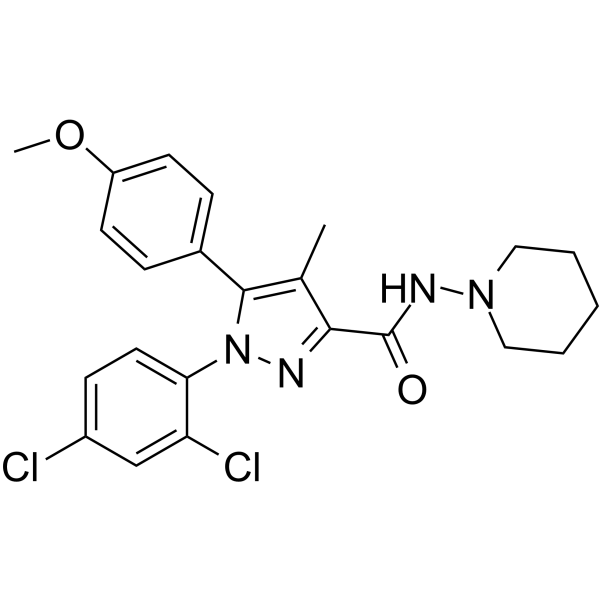
- HY-110213
-
|
|
Fluorescent Dye
|
Others
|
|
BODIPY 630/650X is a fluorescent conjugate of the adenosine receptor ligand N-ethylcarboxamido-adenosine (NECA). BODIPY 630/650X displays excitation/emission maxima of 630/650 nm, respectively .
|
-
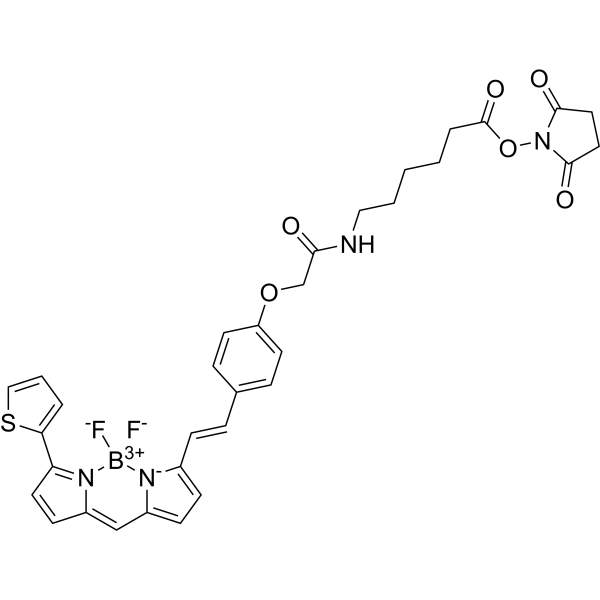
- HY-D1082
-
|
|
Fluorescent Dye
|
Others
|
|
5-DTAF is a isomeric fluorescein derivative that directly react with polysaccharides and other alcohols in aqueous solution at pH > 9. The maximum of the 5-DTAF emission profile is at a wavelength of 518 nm after excitation at 488 nm .
|
-
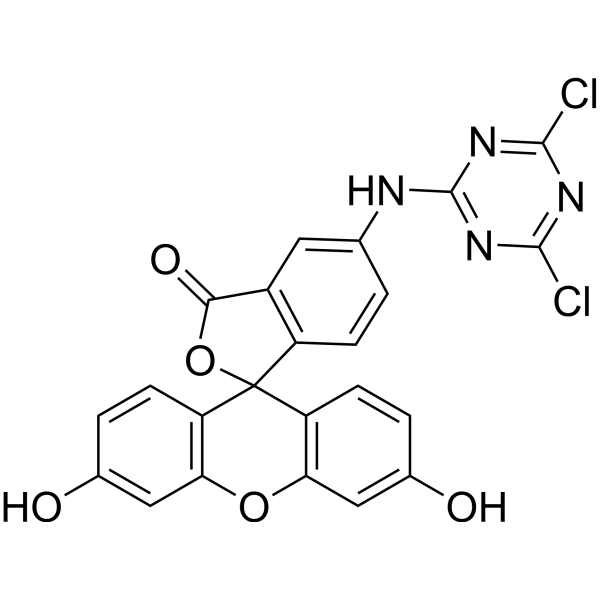
- HY-47176
-
|
|
Fluorescent Dye
|
Others
|
|
QTZ is a bioluminescence agent for in vivo imaging. QTZ has red-shifted emission and yields very little background. QTZ is a coelenterazine analog with the 4-quinolinyl substitution at the C8 position of the imidazopyrazinone core .
|
-
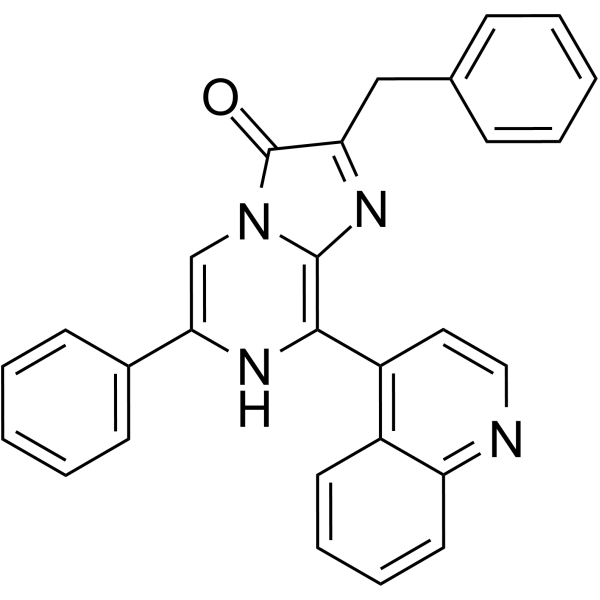
- HY-W039519
-
|
|
Fluorescent Dye
|
Cancer
|
|
7-Methoxycoumarin-3-carboxylic acid is a fluorescent dye with an excitation peak at 355 nm and an emission peak at 405 nm. 7-Methoxycoumarin-3-carboxylic acid can be used to label peptide .
|
-

- HY-D1627
-
|
CM-DiI
|
Fluorescent Dye
|
Others
|
|
CellTracker CM-DiI (CM-DiI) is a lipophilic fluorochrome that can be used for tracking the migration of lymphocytes. CellTracker CM-DiI is feasible to detect labeled cells in histological sections (excitation 553 nm; emission 570 nm) .
|
-

- HY-D0934
-
|
|
|
|
|
(5)6-Carboxytetramethylrhodamine contains a carboxylic acid that can be used to react with primary amines via carbodiimide activation of the carboxylic acid; bright, orange-fluorescent dye produces conjugates with absorption/emission maxima of ~555/580 nm .
|
-

- HY-129547
-
|
|
Fluorescent Dye
|
Others
|
|
Fluo-3 pentapotassium is a fluorescent indicator for intracellular Ca 2+ that is used in flow cytometry and cell-based experiments. Fluo-3 pentapotassium produces fluorescence with an emission maximum at 525 nm upon binding to calcium.
|
-
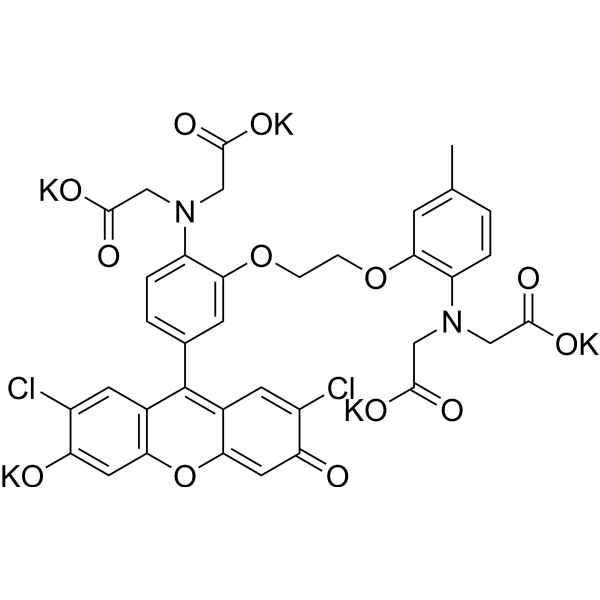
- HY-D0079
-
|
Hydroethidine; PD-MY 003
|
Fluorescent Dye
|
Others
|
|
Dihydroethidium, also known as DHE, is a peroxide indicator. Dihydroethidium penetrates cell membranes to form a fluorescent protein complex with blue fluoresces. After entering the cells, Dihydroethidium is mainly localized in the cell membrane, cytoplasm and nucleus, and the staining effect is the strongest in the nucleus. Dihydroethidium produces inherent blue fluorescence with a maximum excitation wavelength of 370 nm and a maximum emission wavelength of 420 nm; after dehydrogenation, Dihydroethidium combines with RNA or DNA to produce red fluorescence with a maximum excitation wavelength of 300 nm and a maximum emission wavelength of 610 nm. 535 nm can also be used as the excitation wavelength for actual observation .
|
-

- HY-123645
-
|
|
Fluorescent Dye
|
Others
|
|
Rhodamine B hydrazide is a good probe for sulfite, with colorless and non-fluorescent properties. While the emission is related to the concentration of sulfite (5-800 ng/mL; detection limit=1.4 ng/mL (3σ)). Sulfite reduces dissolved oxygen to yield superoxide radicals, which binds to Rhodamine B hydrazide to form Rhodamine B. Rhodamine B hydrazide gives Rhodamine B-like fluorescence in the presence of sulfite, which is enhanced by Tween 80 surfactant micelles. Rhodamine B hydrazide has an absorption maximum at 554 nm and a fluorescence emission maximum at 574 nm .
|
-
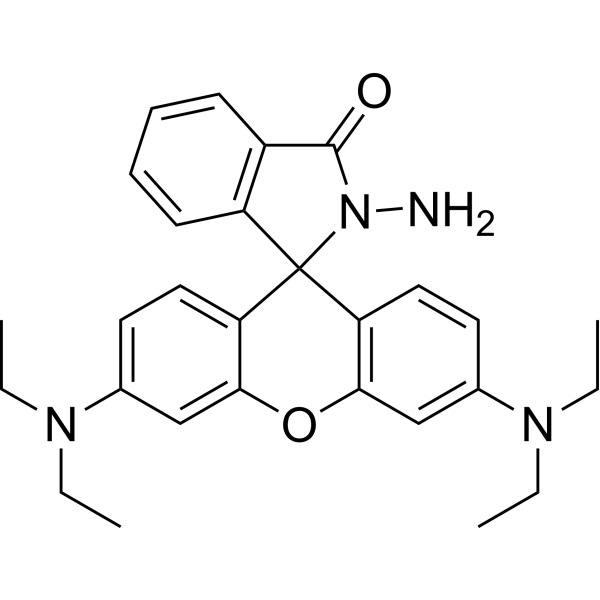
- HY-125746
-
|
|
Fluorescent Dye
|
Others
|
|
BODIPY-cholesterol is an intrinsically lipophilic, and cell-permeable analog of cholesterol with a fluorescent BODIPY group. BODIPY-cholesterol can be used to monitor sterol uptake and inter-organelle sterol flux in cells. (Excitation/Emission: 480/508 nm) .
|
-
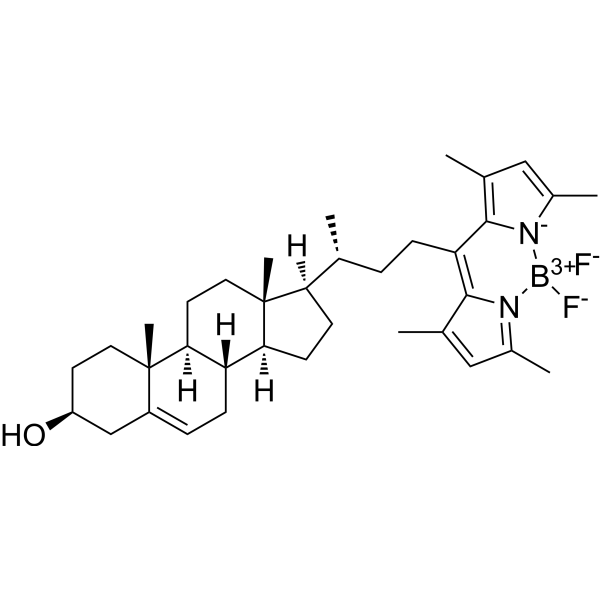
- HY-D1665
-
|
|
Fluorescent Dye
|
Others
|
|
BDP 558/568 amine is an amine derivative of BDP 558/568. BDP 558/568 is a borondipyrromethene dye with yellow/orange emission. BDP 558/568 amine can be conjugated by means of reactions with various electrophiles .
|
-

- HY-153079
-
|
|
Fluorescent Dye
|
Others
|
|
The eGFP mRNA will express green fluorescent protein, originally isolated from the jellyfish, Aequorea victoria. The eGFP is a commonly used direct detection reporter in mammalian cell culture, yielding bright green fluorescence with an emission peak at 509 nm.
|
-
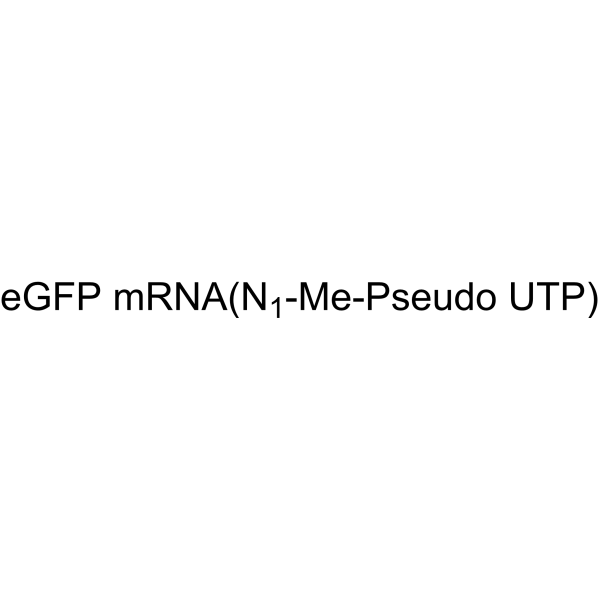
- HY-D1079
-
|
|
DNA Stain
|
Others
|
|
EDANS sodium is a potent fluorogenic substrates. EDANS sodium is a donor for FRET-based nucleic acid probes and protease substrates. EDANS sodium is often paired with DABCYL or DABSYL. The optimal absorbance and emission wavelengths of EDANS sodium are λabs = 336 nm and λem = 490 nm respectively .
|
-
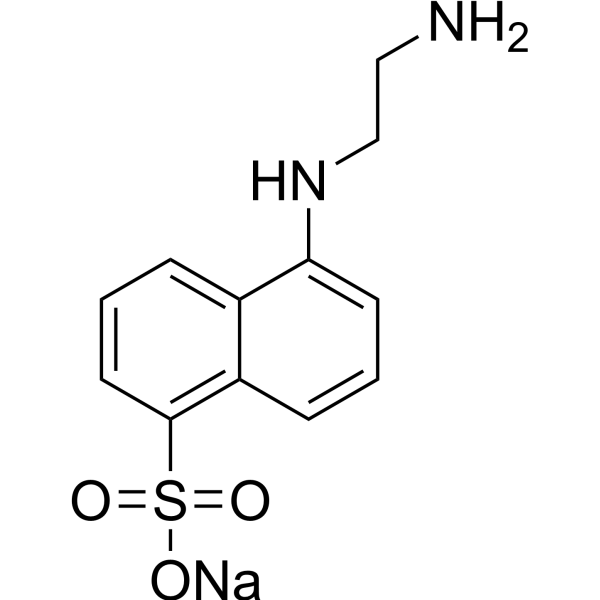
- HY-D1563
-
|
|
Fluorescent Dye
|
Others
|
|
CypHer 5 is a pH-sensitive cyanine derivative and a environmental sensitive fluorophore. CypHer 5 has a pH-sensitive maximal absorption at 644 nm and emission at 664 nm. CypHer 5 has been used as a pH sensor of lysosomal compartments .
|
-
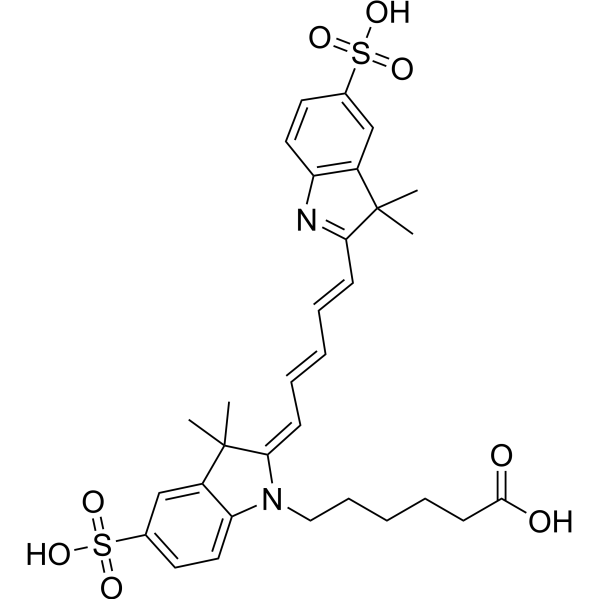
- HY-D1691
-
|
|
Fluorescent Dye
|
Others
|
|
BODIPY-581/591 NHS ester is a bright, red fluorescent dye (excitation: 581 nm; emission: 591 nm). BODIPY-581/591 NHS ester shows unique hydrophobic properties for staining lipids, membranes, and other lipophilic compounds .
|
-
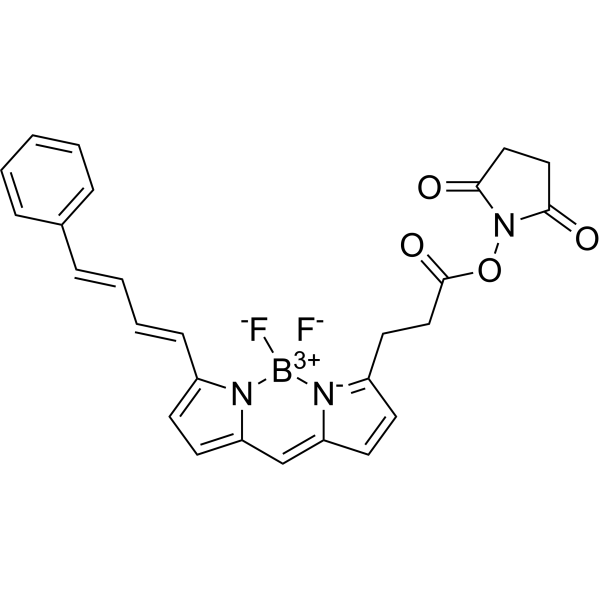
- HY-151680
-
|
|
DNA Stain
|
Others
|
|
TAMRA alkyne, 6-isomer is a linker of TAMRA which is a xanthene dye with orange emission that is commonly used for oligonucleotide labeling and amino acid sequencing. The addition of the alkyne groups allows for it to be reacted with an azide for copper-catalyzed Click Chemistry .
|
-
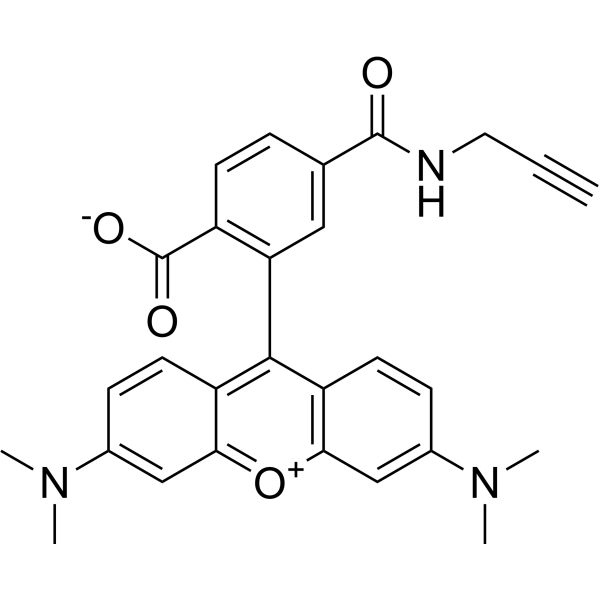
- HY-D2178
-
|
|
Fluorescent Dye
|
Others
|
|
AF 568 NHS ester is a derivative of the orange fluorescent dye AF 568. AF 568 has a maximum emission wavelength of ~568 nm. AF 568 NHS ester is widely used in cell dyes, biological dyes, biomolecules and particle fluorescent labeling.
|
-
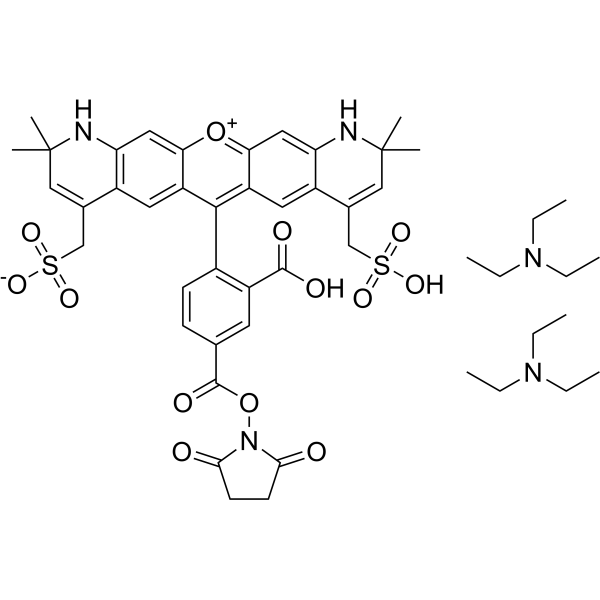
- HY-D2176
-
|
|
Fluorescent Dye
|
Others
|
|
AF 555 carboxylic acid is a derivative of the orange fluorescent dye AF 555. AF 555 has a maximum emission wavelength of ~555 nm. AF 555 carboxylic acid is widely used in cell dyes, biological dyes, biomolecules and particle fluorescent labeling.
|
-
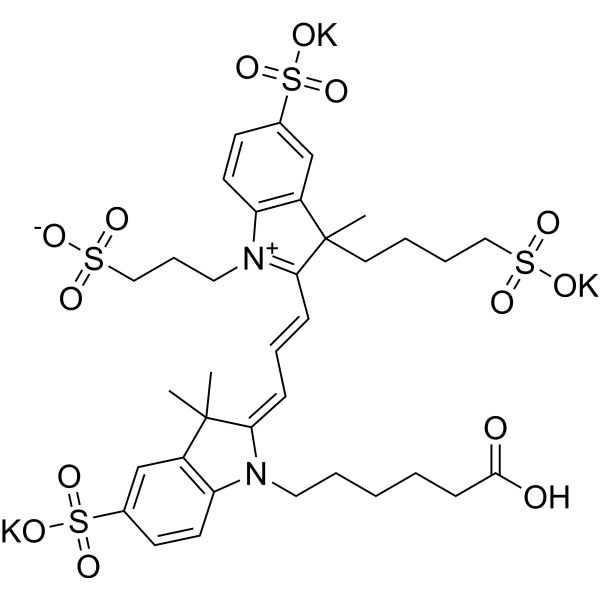
- HY-D1630
-
|
|
Fluorescent Dye
|
Others
|
|
4-Di-10-ASP is a fluorescent lipophilic tracer (Excitation 485 nm; Emission 620 nm). 4-Di-10-ASP can be used to stain phospholipid membranes in a specific manner .
|
-
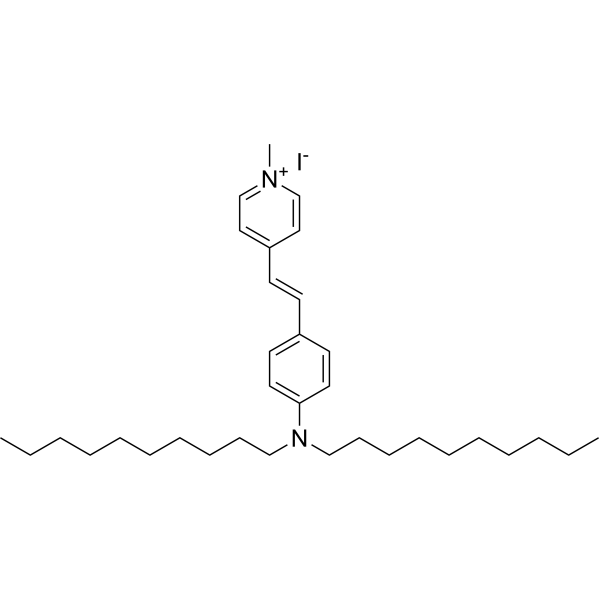
- HY-W440934
-
|
|
Liposome
|
|
|
Stearic acid-PEG-Rhodamine, MW 2000 is an amphiphilic PEG polymer which can form micelles in water. The rhodamine can be used for staining sample and easily traced by fluorescence microscopy. Rhodamine has maximum absorption at 570 nm and emission around 595 nm.
|
-

- HY-D2255
-
|
|
Fluorescent Dye
|
Others
|
|
BDP FL ceramide, a highly fluorescent lipid, is a conjugate of green-emitting BDP FL fluorophore with sphingosine. BDP FL ceramide can be used for the visualization of the Golgi apparatus via fluorescence microscopy.The excitation wavelength is 503 nm and the emission wavelength is 509 nm .
|
-
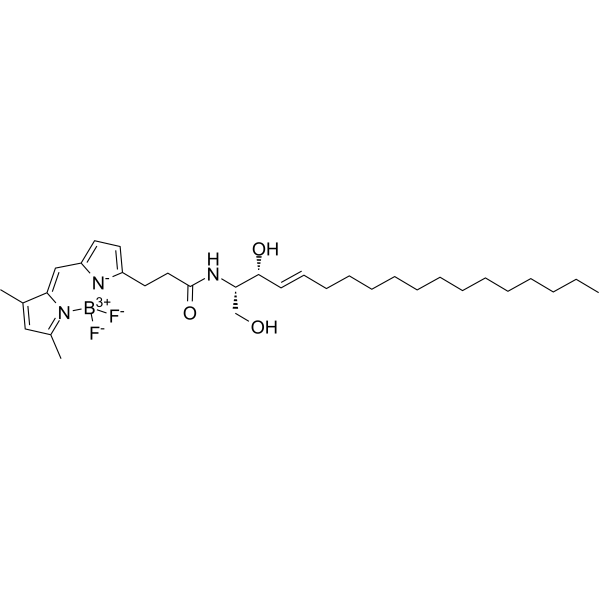
- HY-163286
-
|
|
Fluorescent Dye
Ferroptosis
|
Others
|
|
BODIQPy-TPA is a lipophilic probes, which induces ferroptosis in B16 and HepG2 cells upon light irradiation through lipid peroxidation. BODIQPy-TPA reveals a maximum absorption wavelength of 488 nm and a maximum emission wavelength above 640 nm .
|
-
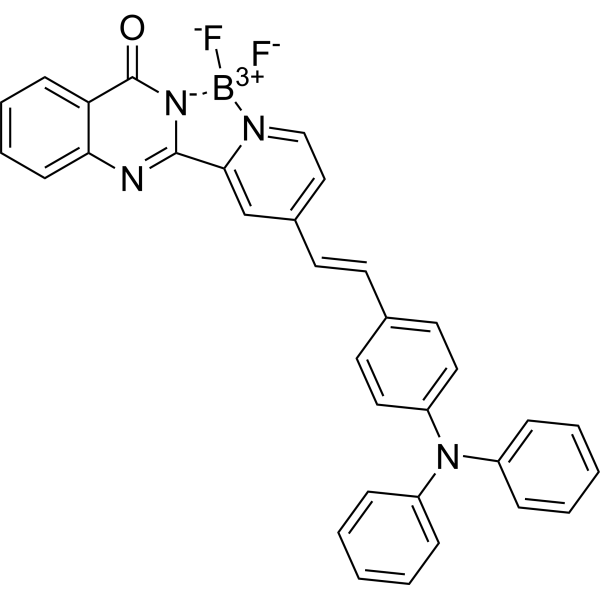
- HY-163386
-
|
|
Biochemical Assay Reagents
|
Others
|
|
HFTC-HClO 1 is a stable and sensitive ratiometric probe, which images the endogenous HClO. HFTC-HClO 1 exhibits a main emission peak at 579 nm. HFTC-HClO-1 visualizes HClO generated in the rheumatoid arthritis mouse model .
|
-
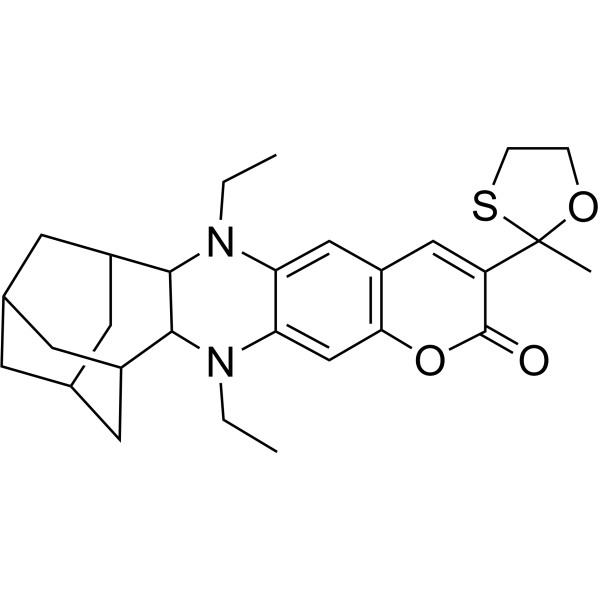
- HY-101878
-
|
Sulforhodamine 101; SR101
|
Fluorescent Dye
|
Neurological Disease
|
|
Texas Red (Sulforhodamine 101) is an amphoteric rhodamine red fluorescent dye (excitation/emission: 586/605 nm). Texas Red is used extensively for investigating neuronal morphology and acts as acell type-selective fluorescent marker of astrocytes bothin vivoand in slice preparations .
|
-
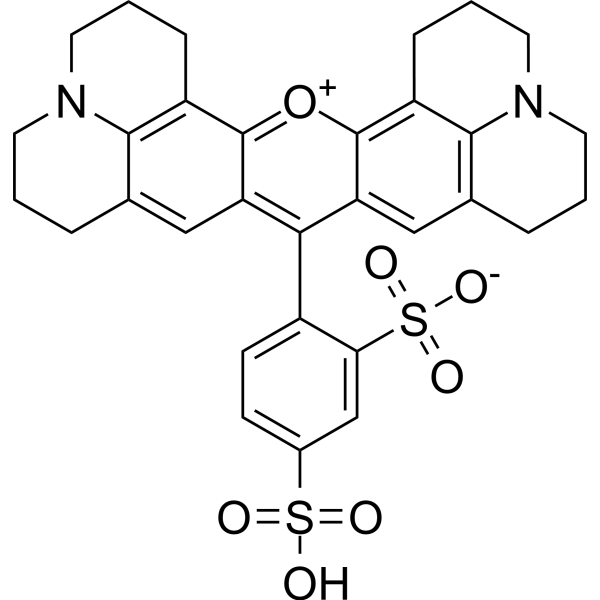
- HY-D1264
-
|
Zn-green
|
Fluorescent Dye
|
Others
|
|
PMQA (Zn-green), an 8-aminoquinoline-based ratiometric fluorescent sensor, demonstrates the Zn 2+-induced redshift of emission (85 nm). PMQA (Zn-green) is a cell membrane-permeable probe and suitable for imaging Zn 2+ in living cells .
|
-

- HY-114227
-
|
|
DNA Stain
|
Inflammation/Immunology
|
|
Hexidium iodide, a fluorescent nucleic binding acid stain (excitation/emission ~ 518/600 nm), permeants to mammalian cells and selectively stains almost all gram-positive bacteria. Hexidium iodide can bind to the DNA of all bacteria after permeabilization by EDTA .
|
-
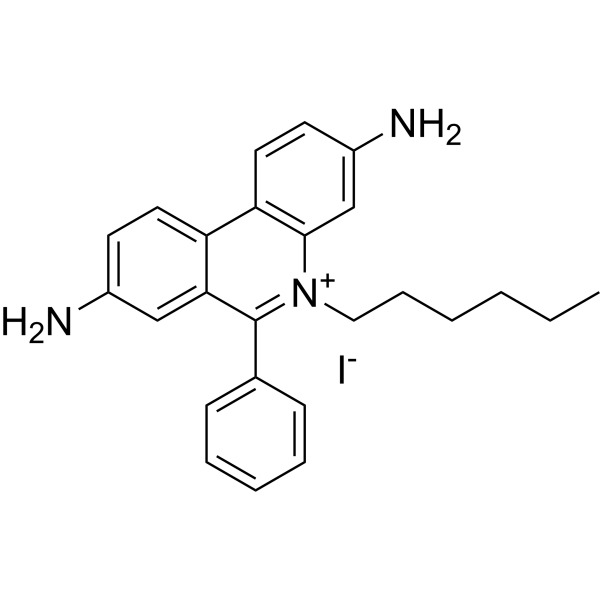
- HY-D1504
-
|
|
Fluorescent Dye
|
Others
|
|
IR-797 chloride is a near-infrared (NIR) dye. IR 797 has absorption maxima near 700 nm. IR-797 shows some aggregation-induced-emission (AIE) properties. IR-797 shows shows cytotoxic .
|
-
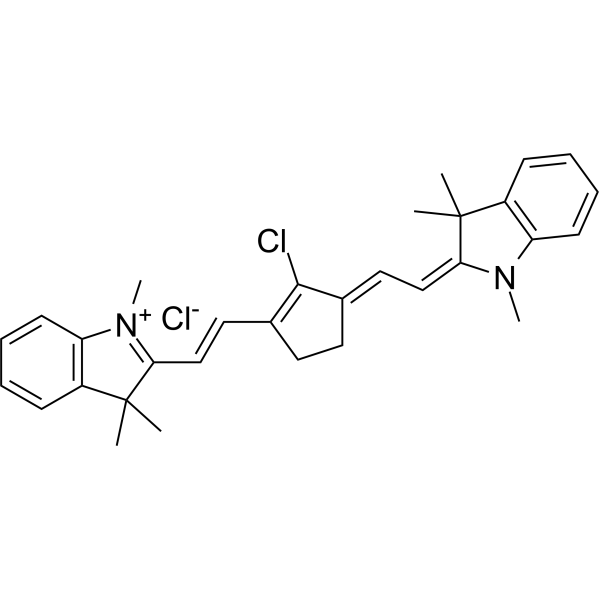
- HY-W278706
-
|
|
Fluorescent Dye
|
Others
|
|
N-[4-(2-Benzimidazolyl)phenyl]maleimide is a potent fluorescent probe with excitation maximum of 315 nm and emission maximum of 360 nm. N-[4-(2-Benzimidazolyl)phenyl]maleimide can be used for fluorometry of thiol compounds .
|
-
![N-[4-(2-Benzimidazolyl)phenyl]maleimide](//file.medchemexpress.com/product_pic/hy-w278706.gif)
- HY-D1877
-
|
|
Pyruvate Kinase
|
Others
|
|
ZY-1 is a control molecule of ZY-2 (HY-D1876, a PKM2 fluorescent probe). ZY-1 shows a low fluorescence emission in HeLa, a cervical cancer cell abundant in PKM2 expression .
|
-
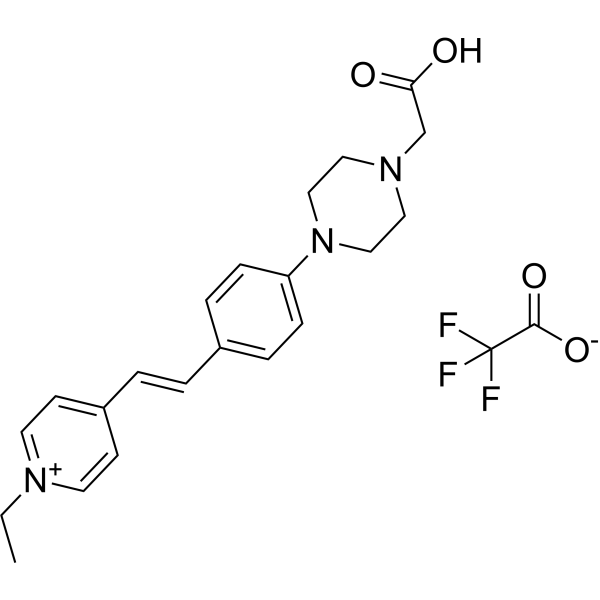
- HY-150743B
-
|
|
Toll-like Receptor (TLR)
|
Inflammation/Immunology
|
|
FITC-labeled ODN 2395 (sodium), a C class oligodeoxynucleotide, is a TLR9 agonist. FITC-labeled ODN 2395 (sodium) can be used to evaluate CpG ODN cellular uptake and localization by confocal laser-scanning microscopy (excitation 495 nm, emission 520 nm) or flow cytometry.
|
-

- HY-150725B
-
|
|
Toll-like Receptor (TLR)
|
Inflammation/Immunology
|
|
FITC-labeled ODN 1585 (sodium) is a potent inducer of IFN and TNFα production. FITC-labeled ODN 1585 (sodium) can be used to evaluate CpG ODN cellular uptake and localization by confocal laser-scanning microscopy (excitation 495 nm, emission 520 nm) or flow cytometry.
|
-

- HY-150724B
-
|
|
Toll-like Receptor (TLR)
|
Inflammation/Immunology
|
|
FITC-labeled ODN 1018 (sodium),an oligodeoxynucleotide, is a TLR-9 agonist. FITC-labeled ODN 1018 (sodium) can be used to evaluate CpG ODN cellular uptake and localization by confocal laser-scanning microscopy (excitation 495 nm, emission 520 nm) or flow cytometry.
|
-
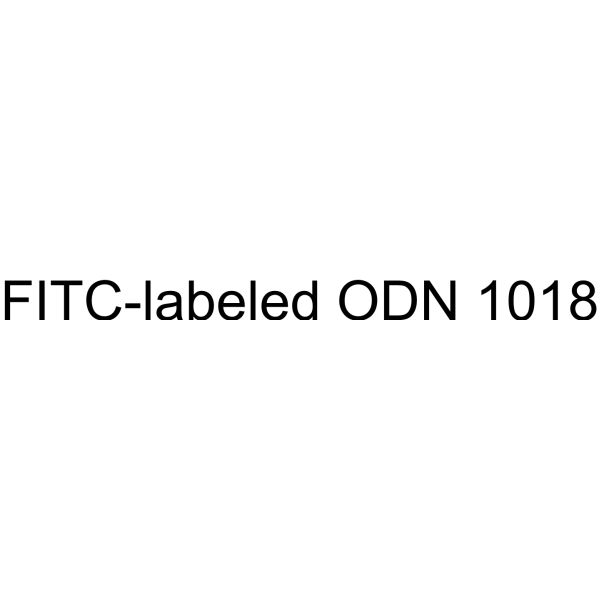
- HY-146244B
-
|
|
Toll-like Receptor (TLR)
|
Inflammation/Immunology
|
|
FITC-labeled Agatolimod (sodium), a class B CpG ODN (oligodeoxynucleotide), is a TLR9 agonist. FITC-labeled Agatolimod (sodium) can be used to evaluate CpG ODN cellular uptake and localization by confocal laser-scanning microscopy (excitation 495 nm, emission 520 nm) or flow cytometry.
|
-
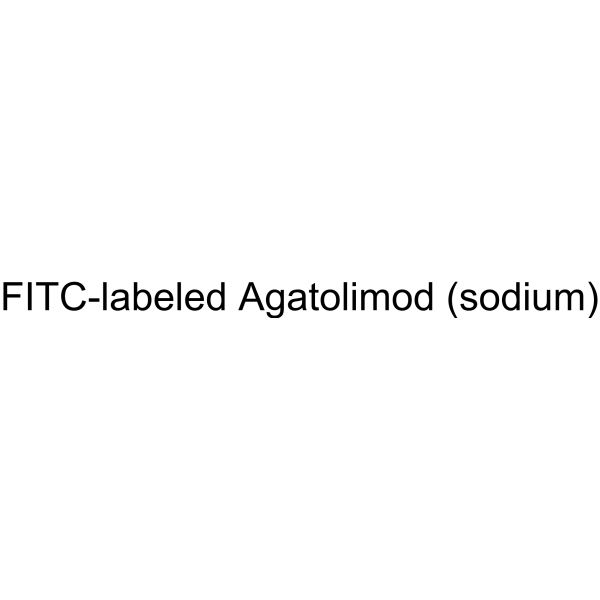
- HY-D1063
-
|
|
Fluorescent Dye
|
Cancer
|
|
IR780 is a prototypic NIR heptamethine cyanine agent, with a high molar extinction coefficient. The maximum excitation wavelength of IR780 was 777-780 nm, and the maximum emission wavelength was 798-823 nm. IR780 can be used in cancer PTT/PDT and imaging .
|
-

- HY-D2267
-
|
|
Fluorescent Dye
|
Others
|
|
JF646-Hoechst is a fluorescent red DNA probe that is an ideal substitute for large oligonucleotide-coupled antibodies used in PAINT experiments, especially for bacterial studies. JF646-Hoechst excitation/emission maximum =655/670 nm .
|
-
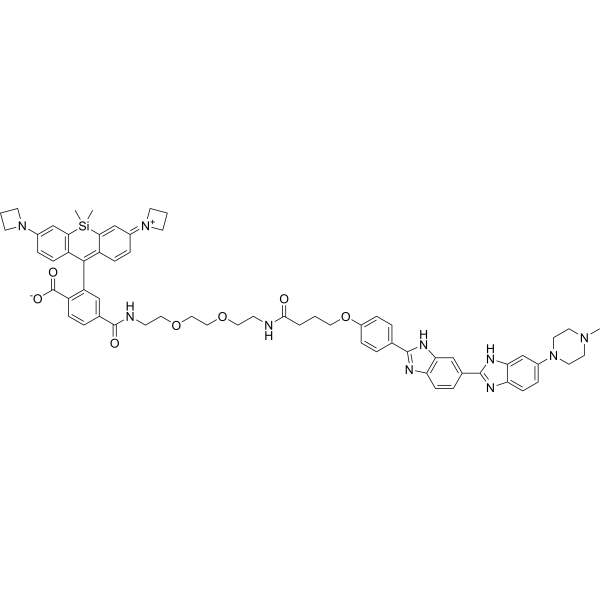
- HY-119674
-
|
|
DNA/RNA Synthesis
|
Infection
|
|
Xanthopterin, an unconjugated pteridine compound, is the main component of the yellow granule in the Oriental hornet bear wings, produces a characteristic excitation/emission maximum at 386/456 nm . Xanthopterin (XPT) causes renal growth and hypertrophy in rat .
Xanthopterin inhibits RNA synthesis .
|
-

- HY-117502
-
|
|
Monoamine Oxidase
|
Others
|
|
SL-25.1188 is a potent monoamine oxidase B (MAO-B) inhibitor with Ki values of 2.9 and 8.5 nM for human MAO-B and rat MAO-B, respectively. SL-25.1188 can be used for positron emission tomography .
|
-
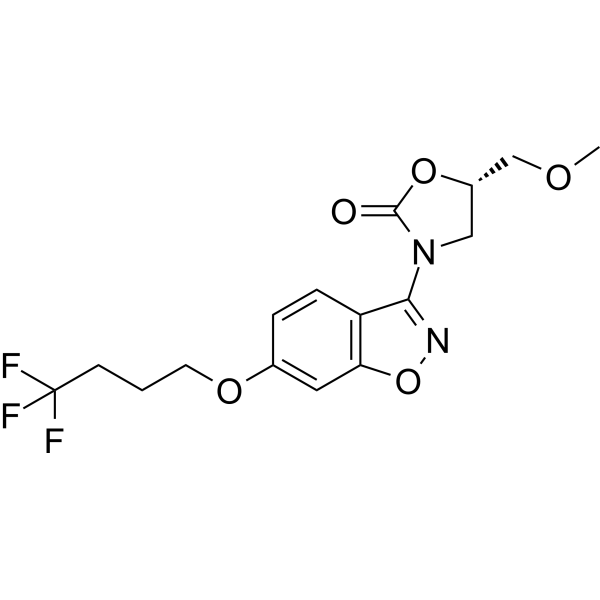
- HY-D2166
-
|
|
Fluorescent Dye
|
Others
|
|
AF 594 NHS ester is a derivative of the red fluorescent dye AF 594 with high fluorescence quantum yield and high photostability (maximum absorption wavelength of 586 nm, maximum emission wavelength of 613 nm). AF 594 NHS ester can form an ester bond by reacting the NHS group with ammonia.
|
-
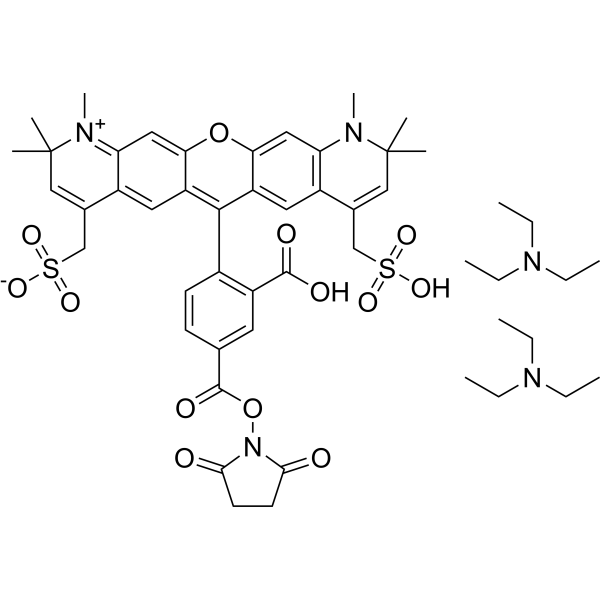
- HY-163287
-
|
|
Fluorescent Dye
|
Others
|
|
QPy-TPA is a lipopjilc probes, which induces non-ferroptotic cell death and lipid dynamic regularion in B16 and HepG2 cells upon light irradiation. QPy-TPA reveals a maximum absorption wavelength of 400 nm and a maximum emission wavelength of 590 nm .
|
-
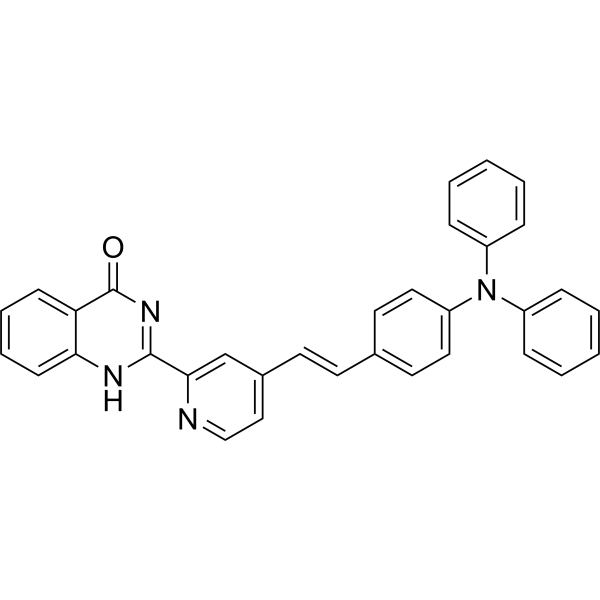
- HY-119674A
-
|
|
DNA/RNA Synthesis
|
Inflammation/Immunology
Cancer
|
|
Xanthopterin hydrate, an unconjugated pteridine compound, is the main component of the yellow granule in the Oriental hornet bear wings, produces a characteristic excitation/emission maximum at 386/456 nm . Xanthopterin hydrate(XPT) causes renal growth and hypertrophy in rat .
Xanthopterin hydrate inhibits RNA synthesis .
|
-
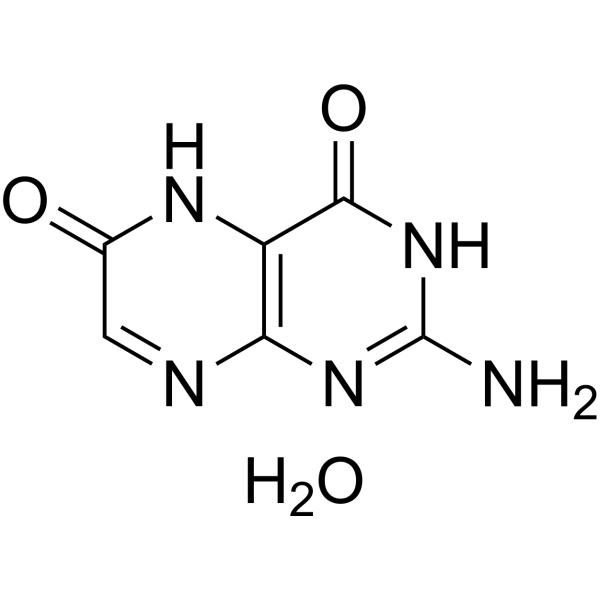
- HY-135368
-
8pyDTZ
3 Publications Verification
|
Fluorescent Dye
|
Others
|
|
8pyDTZ is a pyridyl diphenylterazine (DTZ) analog and an ATP-independent pyridyl substrate of LumiLuc luciferase. 8pyDTZ exhibits spectrally shifted emission. 8pyDTZ has excellent biocompatibility and superior in vivo sensitivity. 8pyDTZ can be used for in vivo luminescence imaging .
|
-
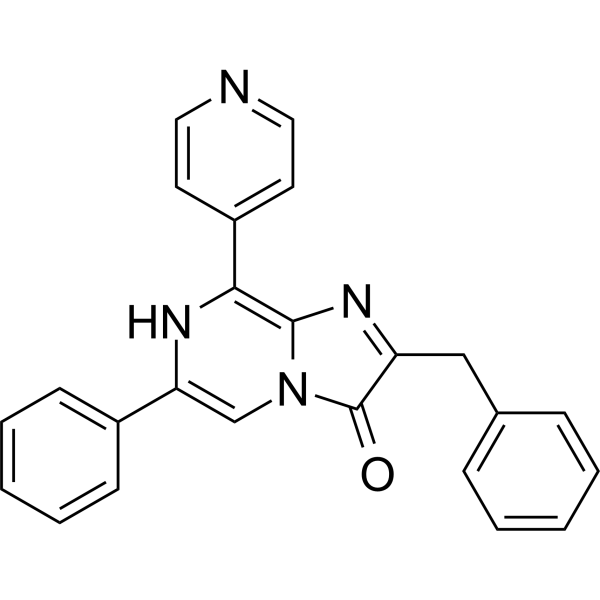
- HY-D1085
-
|
|
Fluorescent Dye
|
Others
|
|
AMCA-X-SE is a coumarin derivative that generates fixed blue fluorescence and an NHS-activated ester that forms stable amide bonds with primary amine groups. It is used as a reactive dye for labeling amino groups of peptides, proteins, and oligonucleotides. Maximum excitation/emission wavelength: 354/442 nm .
|
-
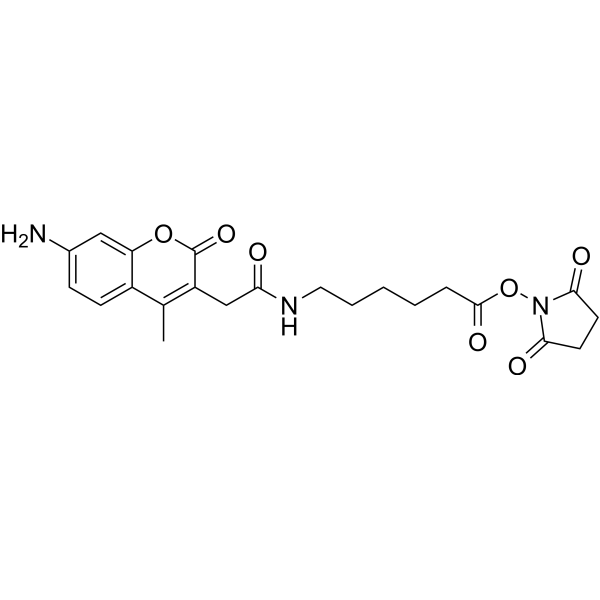
- HY-150738B
-
|
|
Toll-like Receptor (TLR)
|
Inflammation/Immunology
|
|
FITC-labeled ODN 2088 (sodium) is a potent TLR3, TLR7 and TLR9 inhibitor. FITC-labeled ODN 2088 (sodium) can be used to evaluate CpG ODN cellular uptake and localization by confocal laser-scanning microscopy (excitation 495 nm, emission 520 nm) or flow cytometry.
|
-
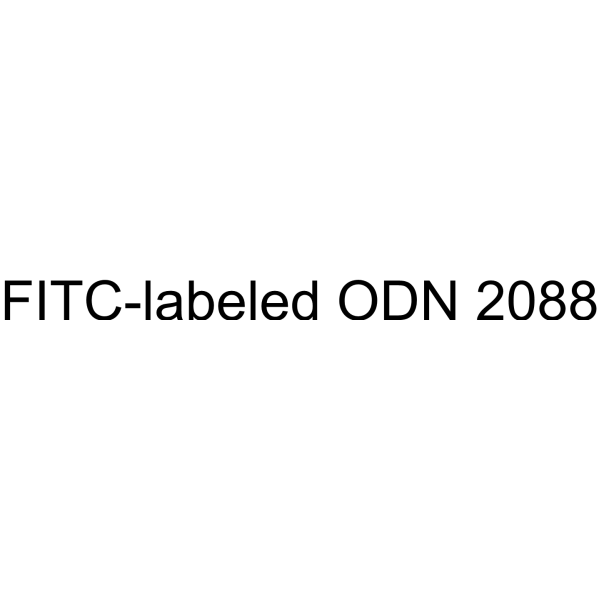
- HY-150726B
-
|
|
Toll-like Receptor (TLR)
|
Inflammation/Immunology
|
|
FITC-labeled ODN 1668 (sodium), a class B CpG ODN (oligodeoxynucleotide), is a TLR9 agonist. FITC-labeled ODN 1668 (sodium) can be used to evaluate CpG ODN cellular uptake and localization by confocal laser-scanning microscopy (excitation 495 nm, emission 520 nm) or flow cytometry.
|
-

- HY-146245B
-
|
|
Toll-like Receptor (TLR)
|
Inflammation/Immunology
|
|
FITC-labeled ODN 1826 (sodium), a class B CpG ODN (oligodeoxynucleotide), is a TLR9 agonist. FITC-labeled ODN 1826 (sodium) can be used to evaluate CpG ODN cellular uptake and localization by confocal laser-scanning microscopy (excitation 495 nm, emission 520 nm) or flow cytometry.
|
-

- HY-D1924
-
|
|
Fluorescent Dye
|
Others
|
|
ATTO 390 alkyne is an alkyne derivative of ATTO 390 with maximum excitation/emission wavelengths: 390/476 nm. ATTO 390 alkyne is a click chemistry reagent, it contains an Alkyne group and can undergo copper-catalyzed azide-alkyne cycloaddition (CuAAc) with molecules containing Azide groups.
|
-
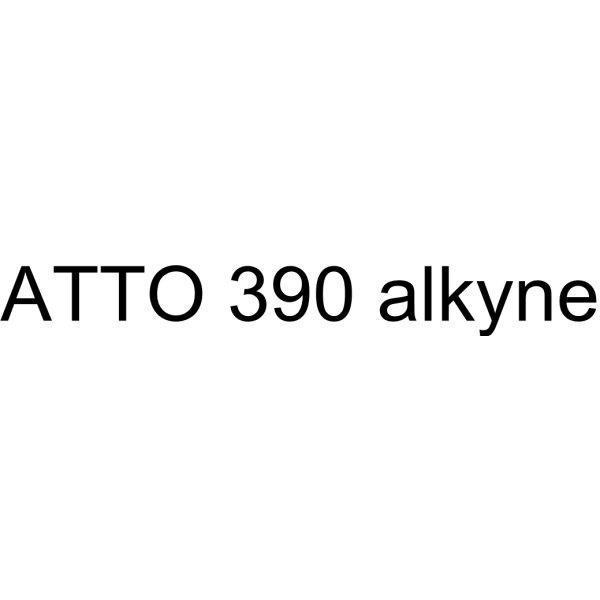
- HY-D1969
-
|
|
Fluorescent Dye
|
Others
|
|
ATTO 700 Alkin is an alkyne derivative of ATTO 700 with maximum excitation/emission wavelengths: 700/716 nm. ATTO 700 Alkin is a click chemistry reagent, it contains an Alkyne group and can undergo copper-catalyzed azide-alkyne cycloaddition (CuAAc) with molecules containing Azide groups.
|
-
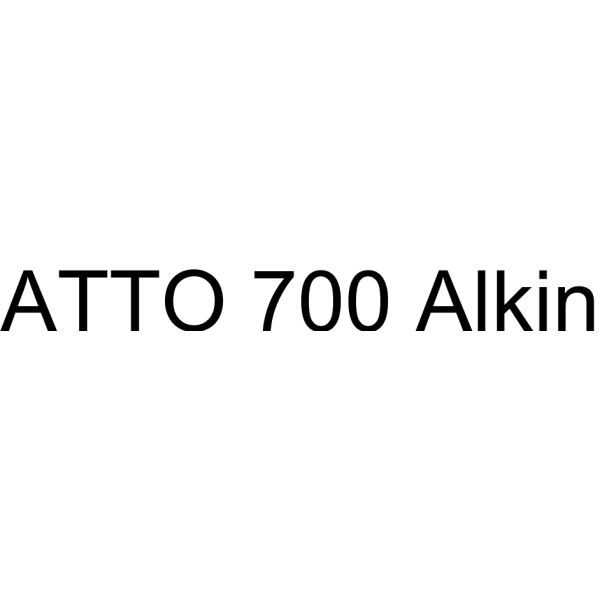
- HY-D2054
-
|
|
Fluorescent Dye
|
Others
|
|
ATTO 532 alkin is an alkyne derivative of ATTO 532 with maximum excitation/emission wavelengths: 532/552 nm. ATTO 532 alkin is a click chemistry reagent, it contains an Alkyne group and can undergo copper-catalyzed azide-alkyne cycloaddition (CuAAc) with molecules containing Azide groups.
|
-
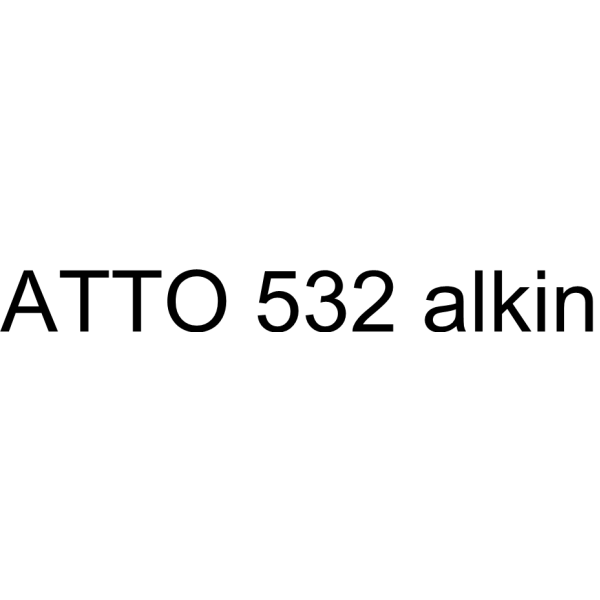
- HY-160257
-
|
|
Biochemical Assay Reagents
Liposome
Fluorescent Dye
|
Others
|
|
DOPE-PEG-BDP FL,MW 5000 is a PEG-lipid-dye conjugate consists of a DOPE phospholipid which is an unsaturated phospholipid, a BDP FL fluorophore with featuring excitation and emission maxima at 504 and 514 nm respectively and a large PEG spacer which links the former substance together.
|
-
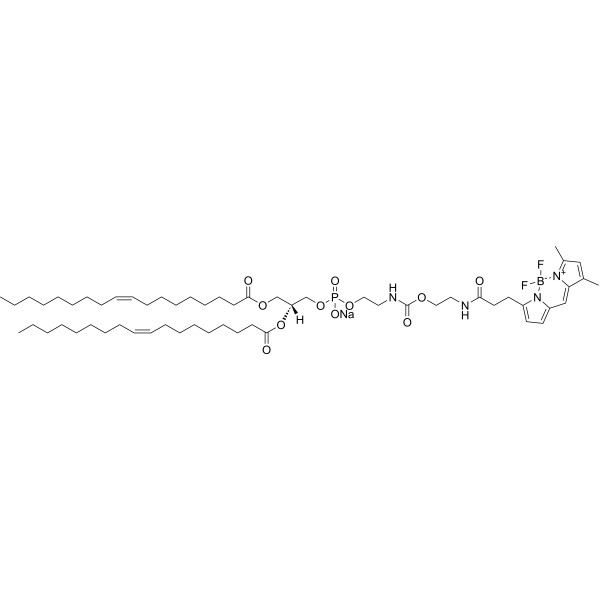
- HY-D1066
-
|
|
Fluorescent Dye
|
Others
|
|
NIR-Thiol dinitrobenzenesulfonate has both absorption and emission in the NIR region. NIR-Thiol dinitrobenzenesulfonate responds to thiol with a large turn-on NIR fluorescence signal upon excitation in the NIR region. NIR-Thiol dinitrobenzenesulfonate is capable of imaging endogenously produced thiol in living cells and mice .
|
-
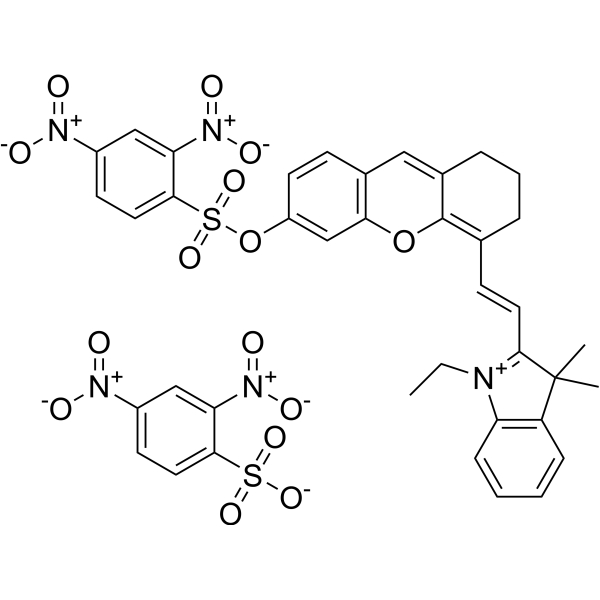
- HY-135056
-
|
|
Fluorescent Dye
|
Others
|
|
Mito-Tracker Green is a green fluorescent dye that selectively accumulates in the mitochondrial matrix. MitoTracker Green FM covalently binds mitochondrial proteins by reacting with free mercaptan of cysteine residues, allowing staining of mitochondrial membrane potential independent of membrane potential. Excitation/emission wavelength 490/523 nm.
|
-
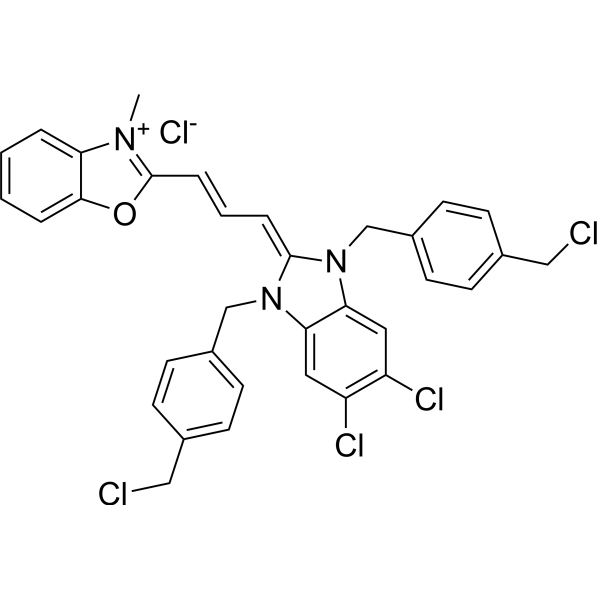
- HY-118159
-
|
DPPP
|
Reactive Oxygen Species
|
Others
|
|
Diphenyl-1-pyrenylphosphine (DPPP) is a fluoregenic peroxide reactive probe. Diphenyl-1-pyrenylphosphine exhibits a unique phototriggered aggregation-induced emission (AIE)/aggregation-induced quenching (ACQ) transition with a remarkable third-order nonlinear optical signal change .
|
-
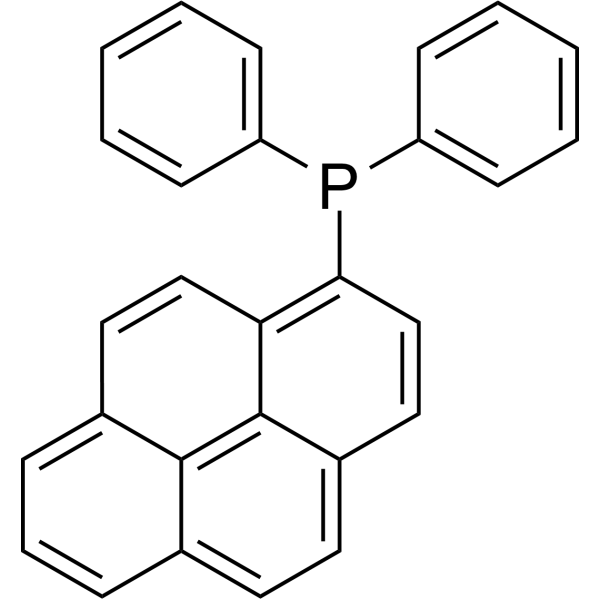
- HY-D1652
-
|
|
Caspase
|
Others
|
|
Ac-LEHD-AMC is a fluorogenic substrate for caspase-9 (Excitation: 341 nm; Emission: 441 nm). Caspase-9 can induce hydrolysis of Ac-LEHD-AMC, resulting in the release of AMC fluorophore and its fluorescence can be used to quantify caspase-9 activity .
|
-
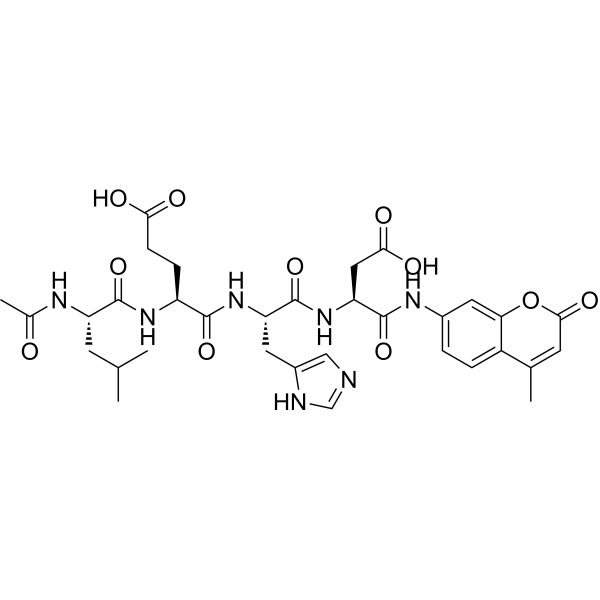
- HY-101185
-
|
|
|
|
|
T808 is a tau-selective Alzheimer’s PET ligand. T808 is a type of imaging agent used in positron emission tomography (PET) scans. It is a radiotracer that is used to help visualize certain areas of the body, such as the brain, in order to diagnose and monitor various medical conditions .
|
-
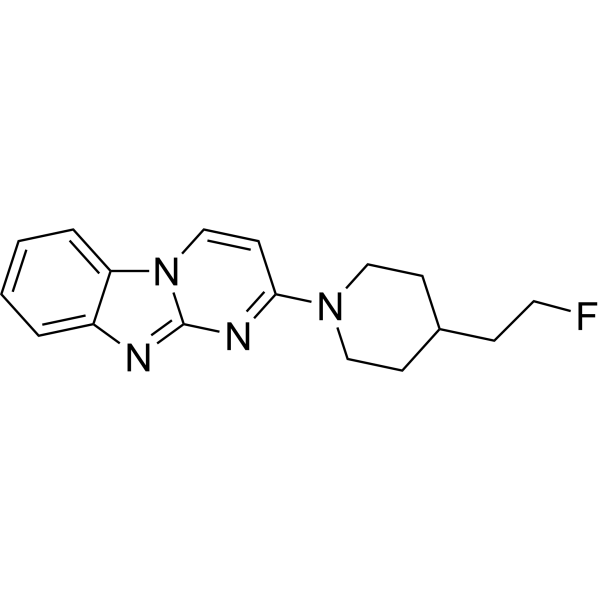
- HY-150751B
-
|
|
Toll-like Receptor (TLR)
|
Inflammation/Immunology
|
|
FITC-labeled ODN TTAGGG (sodium), a inhibitory oligonucleotide (ODN), is a TLR9, AIM2 and cGAS antagonist. FITC-labeled ODN TTAGGG (sodium) can be used to evaluate CpG ODN cellular uptake and localization by confocal laser-scanning microscopy (excitation 495 nm, emission 520 nm) or flow cytometry.
|
-

- HY-149170
-
|
|
5-HT Receptor
Monoamine Transporter
|
Neurological Disease
|
|
FFN246 is a fluorescent, dual substrate of serotonin transporter (SERT) probe and vesicular monoamine transporter 2 (VMAT2) with excitation and emission spectra 392/427 nm. FFN246 can be used for labeling serotonergic neurons in mouse brain tissue through SERT-dependent accumulation .
|
-
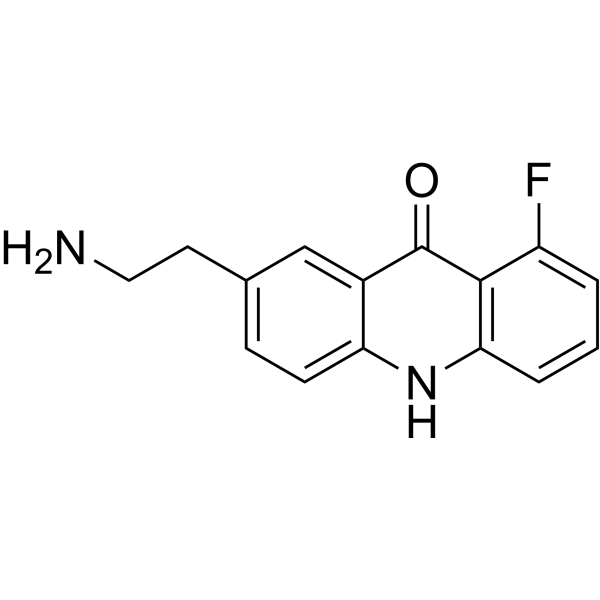
- HY-135036
-
|
|
Others
|
Others
|
|
4-Methylumbelliferyl butyrate (4-MUB) is a coumarin-based fluorogenic substrate used for the identification of M. catarrhalis C4- esterase. 4-Methylumbelliferyl butyrate can converse to the blue-emissive 4-methylumbelliferone (4-MU; HY-N0187) .
|
-

- HY-W440921
-
|
|
Liposome
|
|
|
DSPE-PEG-Rhodamine, MW 5000 is a phospholipid polyPEG with red fluorescent. The polymer can form lipid bilayer and be used to prepare nanoparticles or liposomes for targeted drug delivery. Rhodamine has maximum absorption at 570 nm and emission around 595 nm and can be easily traced using an imaging technique.
|
-
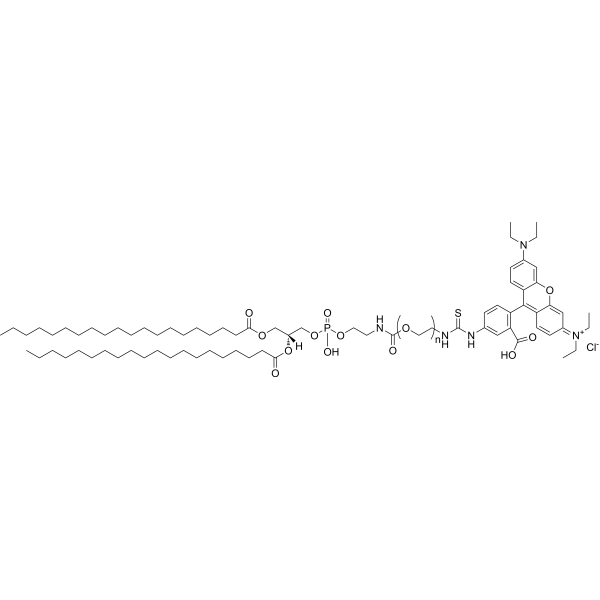
- HY-W440920
-
|
|
Liposome
|
|
|
DSPE-PEG-Rhodamine, MW 3400 is a phospholipid polyPEG with red fluorescent. The polymer can form lipid bilayer and be used to prepare nanoparticles or liposomes for targeted drug delivery. Rhodamine has maximum absorption at 570 nm and emission around 595 nm and can be easily traced using an imaging technique.
|
-

- HY-W440911
-
|
|
Liposome
|
|
|
DSPE-PEG-Cy5, MW 2000 a red fluorophore polyPEG with lipid hydrophobic tails. The Cy5 fluorophore is commonly used in applications such as protein and nucleic acid labeling for imaging, flow cytometry, and genomic applications. The dye has an excitation peak at 651 nm and an emission peak at 670 nm.
|
-
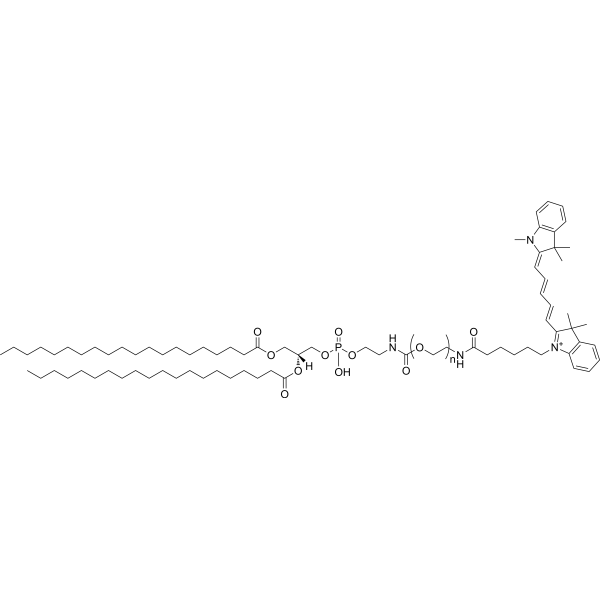
- HY-D1169
-
|
|
Fluorescent Dye
|
Others
|
|
BDP R6G carboxylic acid is a borondipyrromethene dye (Excitation: 530 nM; Emission: 548 nM). BDP R6G carboxylic acid terminal carboxylic acid can react with primary amine groups in the presence of activators to form a stable amide bond, for subsequent labeling reactions like Steglich esterification .
|
-
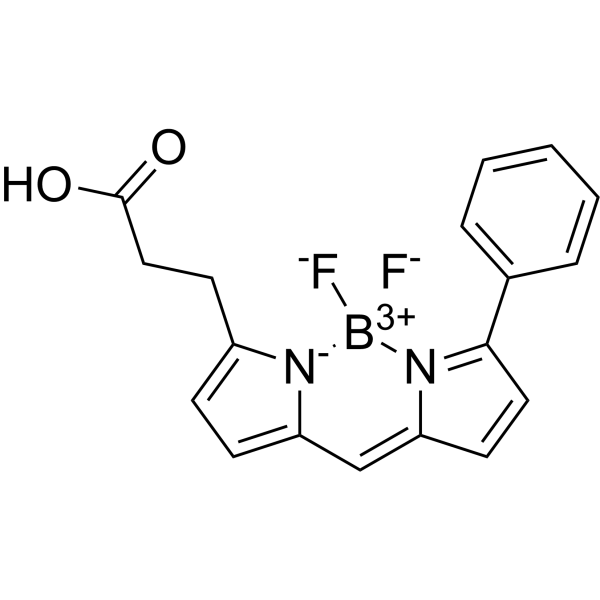
- HY-D1716
-
|
|
Fluorescent Dye
|
Cancer
|
|
S0456 is a near-infrared (NIR) fluorescent dye that can be used for synthesize Pafolacianine (HY-139579). S0456 binds to the folate receptor (FR). S0456 can be used as a tumor-specific optical imaging agent. The excitation wavelength is 788 nM and emission wavelength is 800 nM .
|
-

- HY-150741B
-
|
|
Toll-like Receptor (TLR)
Interleukin Related
|
Inflammation/Immunology
|
|
FITC-labeled ODN 2216 (sodium) is a human-specific TLR9 (toll-like receptor 9) ligand or agonist. FITC-labeled ODN 2216 (sodium) can be used to evaluate CpG ODN cellular uptake and localization by confocal laser-scanning microscopy (excitation 495 nm, emission 520 nm) or flow cytometry.
|
-

- HY-D2150
-
|
|
Fluorescent Dye
|
Others
|
|
AF 430 maleimide is a derivative of the yellow fluorescent dye AF 430. AF430 has an excitation wavelength of 430 nm and an emission wavelength of 542 nm. AF 430 maleimide contains maleimide groups that react with thiol groups to form covalent bonds. To achieve specific coupling of dye labels and biomolecules.
|
-

- HY-126226
-
|
|
Others
|
Cancer
|
|
MK-6240 Precursor (6e) is the synthetic precursor of (18)F]-MK-6240. (18)F]-MK-6240 is a tau positron emission tomography (PET) tracer for neurofibrillary tangles (NFTs), exhibiting high specificity and selectivity for binding to NFTs .
|
-
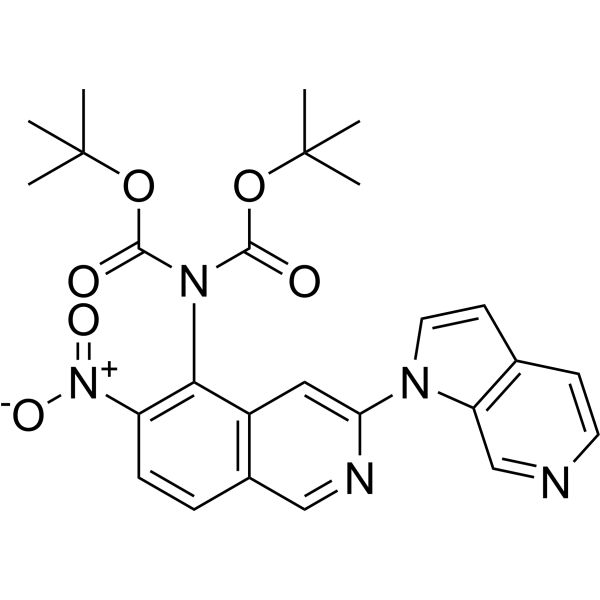
- HY-D1300
-
|
LysoTracker Red DND-99
|
Biochemical Assay Reagents
Fluorescent Dye
|
Others
|
|
LysoTracker Red is a Red fluorescently labeled lysosomal probe with a maximum excitation/emission wavelength of 577/590 nm. The structure is composed of a fluorescein group and linked weak bases, which can freely cross the cell membrane and gather on spherical organelles. It is suitable for observing the internal biosynthesis and related pathogenesis of lysosomes .
|
-
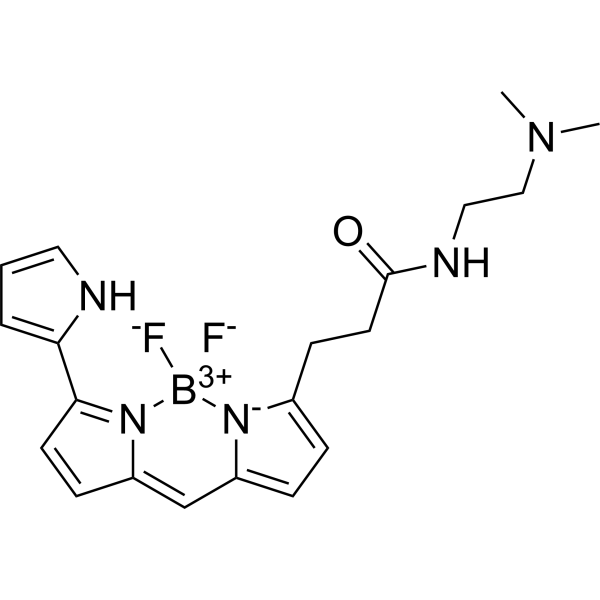
- HY-126823
-
|
PGSK diacetate (5/6-mixture)
|
Fluorescent Dye
|
Others
|
|
Phen green SK (PGSK) diacetate is a fluorescent heavy metal indicator that reacts with a variety of metal ions, including Fe2+, Cd2+, Co2+, Ni2+, Zn2+. PGSK diacetate displays excitation/emission maxima of 507/532 nm, respectively, and fluorescence is quenched upon interaction with metal ions
|
-
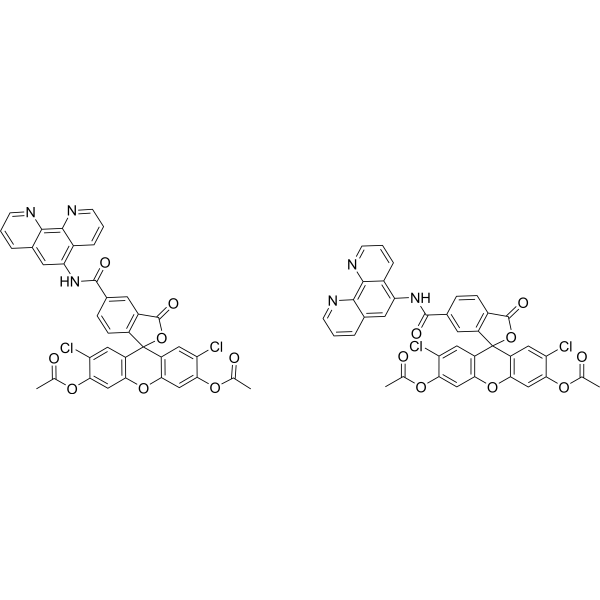
- HY-D0159
-
|
|
Fluorescent Dye
|
Others
|
|
ZnAF-1F is a potent fluorophore for with an Kd value of 2.2 nM. ZnAF-1F can be used as fluorescent probes for Zn 2+ in cells. ZnAF-1F shows λ excitation of 489 nm and λ emission of 514 nm .
|
-
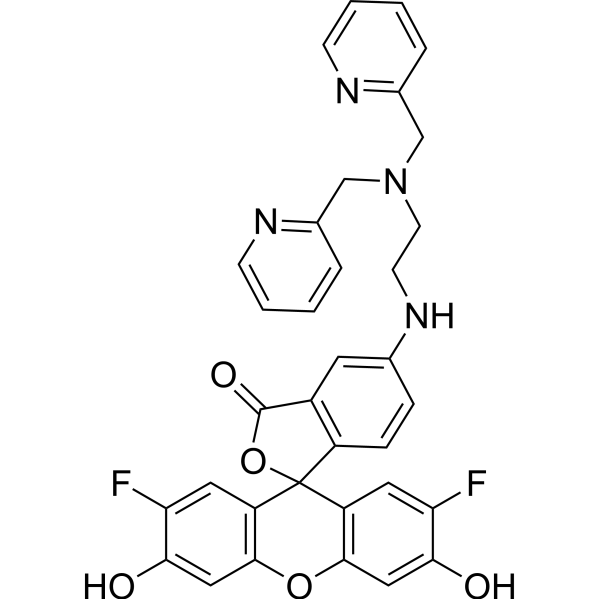
- HY-151756
-
|
|
Fluorescent Dye
|
Others
|
|
diSulfo-Cy3 alkyne is a water-soluble dye and a Click Chemistry reagent containing an alkyne group. Absorbance and emission of the dye are identical to Cy3 fluorophore. diSulfo-Cy3 alkyne can be used for the labeling of proteins, and even intact biological objects in water phase .
|
-

- HY-153248
-
|
|
Others
|
Others
|
|
PBR28 is an TSPO modulator, which can be used for prevention research of Pulmonary Arterial Hypertension (PAH). PBR28 can be used to trace 18 KDa transporter (TSPO) by adding radioactive labeling, which plays an important role in brain positron emission tomography (PET) imaging studies .
|
-

- HY-149596
-
|
|
Fluorescent Dye
|
Metabolic Disease
|
|
PTZ-LD is a phenothiazine (HY-Y0055)-based fluorescent probe for lipid droplets (LDs) detection. PTZ-LD is apparently emissive in LDs with high specificity. (Ex/Em=488/570-620 nm). PTZ-LD can be used for diabetic cataract (DC) research .
|
-
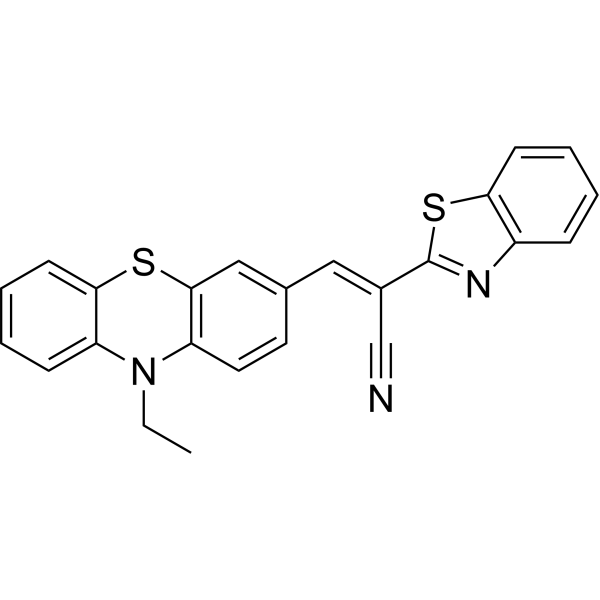
- HY-W440908
-
|
|
Liposome
|
|
|
DSPE-PEG-Cy3, MW 2000 is a fluorophore attached PEG lipid. The Cy3 fluorophore is commonly used in applications such as immunolabeling, nucleic acid labeling, fluorescence microscopy, and flow cytometry. The dye has an absorption wavelength that peaks around 548-552 nm, and an emission maximum around 562-570 nm.
|
-

- HY-141899
-
|
|
mAChR
|
Neurological Disease
|
|
MK-6884 is a M4 muscarinic receptor positive allosteric modulator (PAM) with a Ki value of 0.19 nM. MK-6884 can be used for the research of the neurodegenerative diseases. MK-6884 can be conveniently radiolabeled with carbon-11 and as a positron emission tomography (PET) imaging agent .
|
-
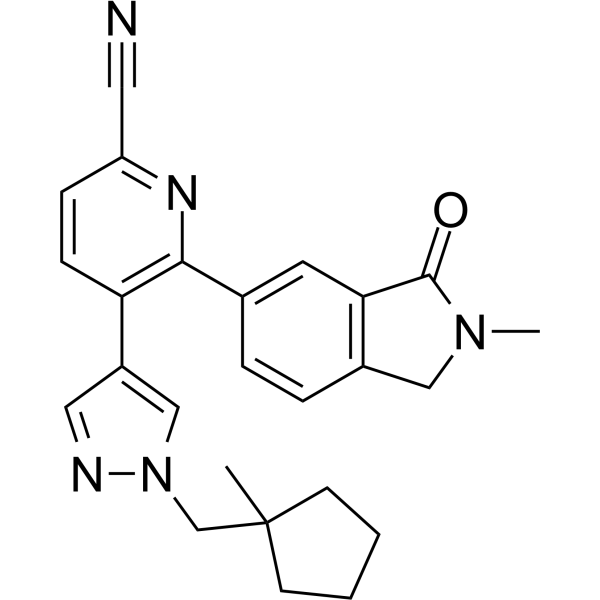
- HY-D0110A
-
|
|
Fluorescent Dye
|
Others
|
|
Fura-2 pentapotassium is a scaled fluorescent dye that can be used for intracellular calcium imaging with the Kd value of 140 nM. Fura-2 pentapotassium has an emission wavelength of 510 nm and excitation wavelengths of 340 nm or 380 nm and the ratio of 340/380 fluorescence intensity is proportional to the intracellular Ca 2+ level .
|
-
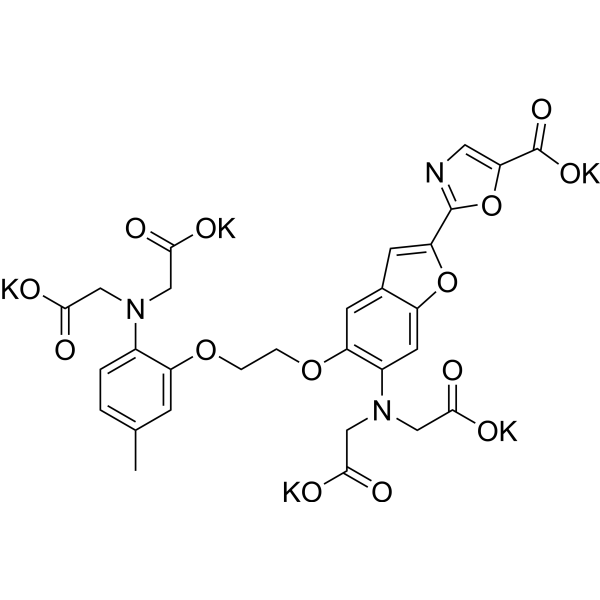
- HY-150145
-
|
|
Biochemical Assay Reagents
|
Others
|
|
Cy5-UTP is a substrate for terminal deoxynucleotidyl transferase (TdT). Cy5-UTP can be used to lable RNA probes through in vitro transcription (Excitation/Emission: 650/665 nm). Cy5-labeled mRNA emits orange fluorescence .
|
-
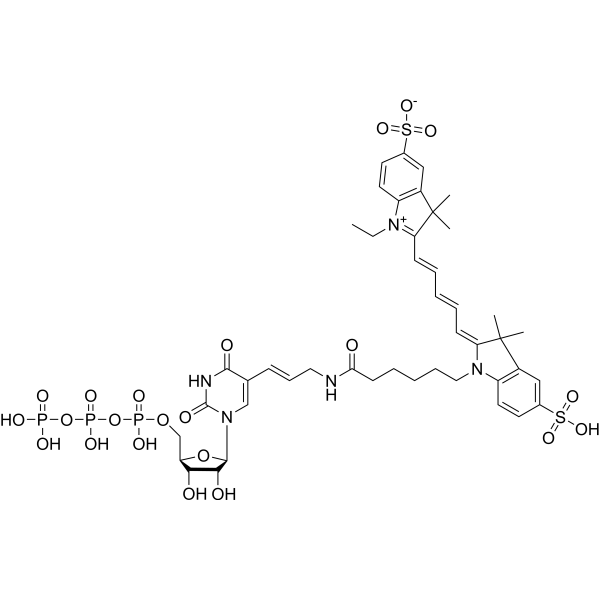
- HY-149117
-
|
|
Fluorescent Dye
|
Others
|
|
AF430 NHS ester is an AF 430 maleimide is a derivative of the yellow fluorescent dye AF 430. AF430 has an excitation wavelength of 430 nm and an emission wavelength of 542 nm. AF430 NHS ester can be uesd for the labeling of amino-groups in peptides, proteins, and oligonucleotides. To achieve specific coupling of dye labels and biomolecules.
|
-
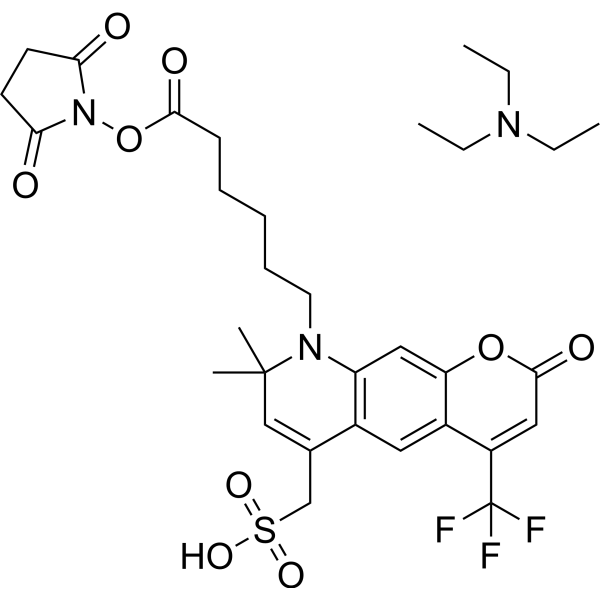
- HY-W440919
-
|
|
Liposome
|
|
|
DSPE-PEG-Rhodamine, MW 2000 is a dye functionalized phospholipid. The amphiphilic polymer can form lipid bilayer in water and be used to encapsulate therapeutic agents, such as liposomal anticancer drug or mRNA vaccine. Rhodamine has maximum absorption at 570 nm and emission around 595 nm and can be easily traced using an imaging technique.
|
-
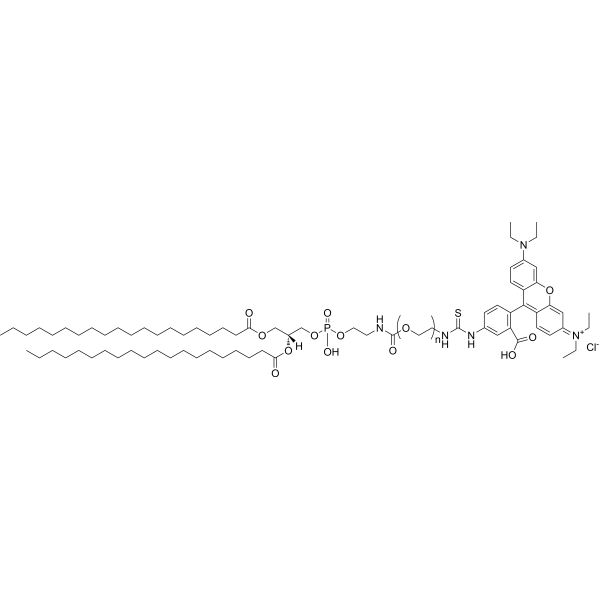
- HY-D1299
-
|
CF3-substituted Tetramethyl BODIPY
|
Fluorescent Dye
|
Cancer
|
|
meso-CF3-BODIPY 2 (CF3-substituted Tetramethyl BODIPY) is a fluorescent dye with the absorption wavelength (λabs) of 553 nm and emission wavelength (λem) of 622 nm. meso-CF3-BODIPY 2 can be used in labeling reagents and photodynamic therapy .
|
-

- HY-120959
-
|
|
Fluorescent Dye
Parasite
|
Others
|
|
DAUDA (11-(dansylamino) undecanoic acid) is an environment-sensitive fluorescent fatty acid analogue. DAUDA alters its intensities and fluorescent emission spectra on entry into binding proteins. DAUDA is used to determine the relative affinity of natural fatty acids for polymorphs of the Schistosoma mansoni Sm14 fatty acid-binding protein[1].
|
-
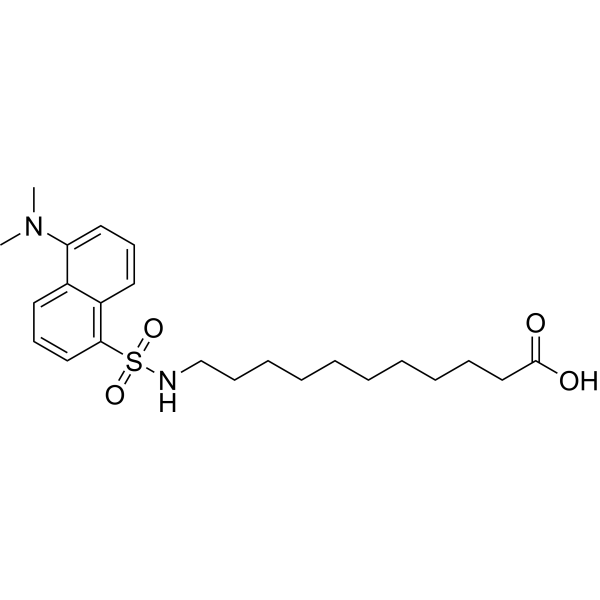
- HY-D1600
-
|
|
Fluorescent Dye
|
Others
|
|
Sulfo-Cyanine5.5 maleimide potassium is a fluorescent dye. Sulfo-Cyanine5.5 is a nearinfrared (NIR) fluorophore with excitation maximum 675 nm and emission maximum 694 nm. Sulfo-Cyanine5.5 maleimide potassium can be used for the labeling of sensitive proteins, nanoparticles, and highly hydrophylic biopolymers .
|
-
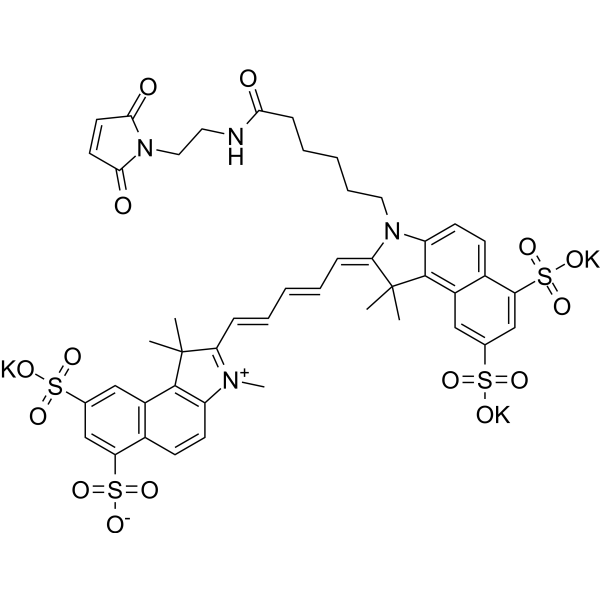
- HY-D2160
-
|
|
Fluorescent Dye
|
Others
|
|
AF 647 carboxylic acid is a derivative of the far-infrared dye AF 647. AF 647 is often used as a replacement for Cy5 dye. The maximum excitation wavelength is 648 nm and the maximum emission wavelength is 671 nm. AF 647 carboxylic acid has a carboxylic acid group and can be coupled to biomolecules with amino groups to achieve dye labeling.
|
-
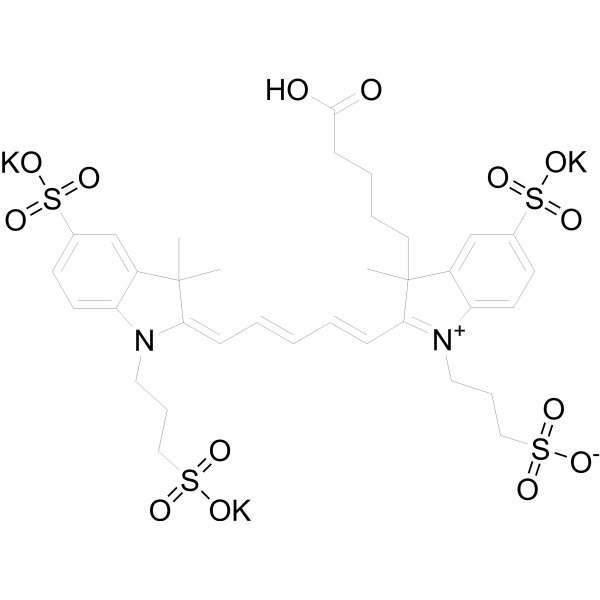
- HY-D2279
-
|
|
Fluorescent Dye
|
Inflammation/Immunology
|
|
NFL-NH2 is a mitochondrial-targeted near-infrared ratiometric fluorescent probe. NFL-NH2 can rapidly detect NO levels associated with the inflammatory damage degree in rheumatoid arthritis (RA) mice models by ratiometric fluorescence imaging. The excitation wavelength and emission wavelength are 650 nm and 780 nm, respectively .
|
-

- HY-P1003
-
|
|
Fluorescent Dye
|
Others
|
|
Ac-DEVD-AMC is a fluorescent substrate of caspase-3/caspase-7. When treating Ac-DEVD-AMC with cell lysate, Ac-DEVD-AMC releases amino-4-methylcoumarin (AMC) for fluorescence detection, with an excitation wavelength of 380 nm and an emission wavelength of 460 nm .
|
-

- HY-120947
-
|
|
Others
|
Neurological Disease
|
|
AV-105 is a Florbetapir ( 18F)-radiolabeled slyrylpyridine tosylate precursor extracted from patent WO2010078370A1, example 1.5. AV-105 can synthesize 18F-radiolabeled compounds, which are used for positron emission tomography (PET) imaging of neurodegenerative diseases of the brain .
|
-
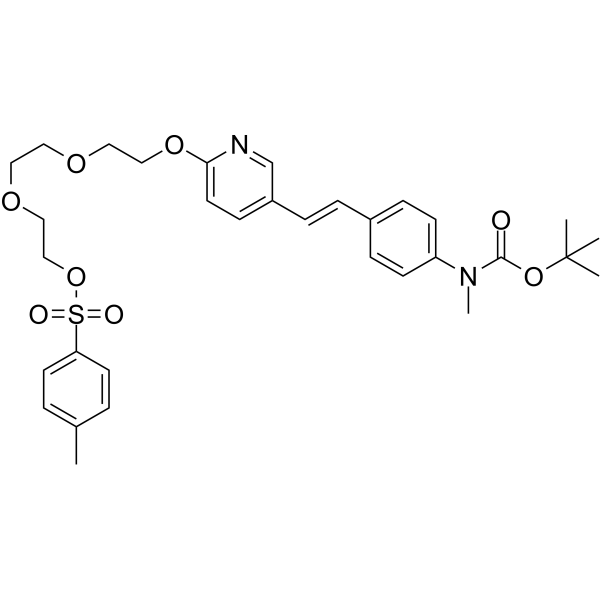
- HY-133876
-
|
DiA
|
Fluorescent Dye
|
Others
|
|
4-Di-16-ASP is a green fluorescent membrane dye. 4-Di-16-ASP is a lipophilic aminostyryl probe with a broad emission spectrum (can be detected with green, orange or even red filters). It is commonly used for neuronal membrane tracing (it diffuses faster than DiO) .
|
-
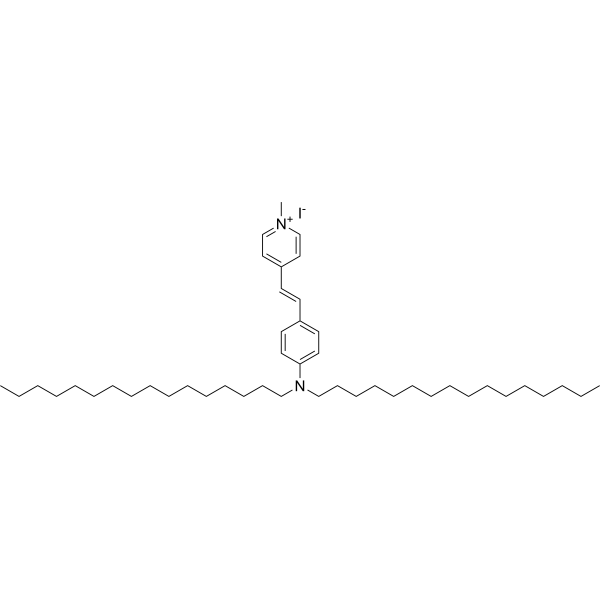
- HY-P2628
-
|
|
Fluorescent Dye
|
Others
|
|
Dabcyl-YVADAPV-EDANS is a fluorogenic interleukin-1β converting enzyme (ICE) substrate for measuring ICE-like protease activity. Dabcyl-YVADAPV-EDANS detects fluorescence at 360 nm excitation and 480 nm emission wavelengths. ICE-like protease is a critical mediator of K + deprivation-induced apoptosis of cerebellar granule neurons .
|
-
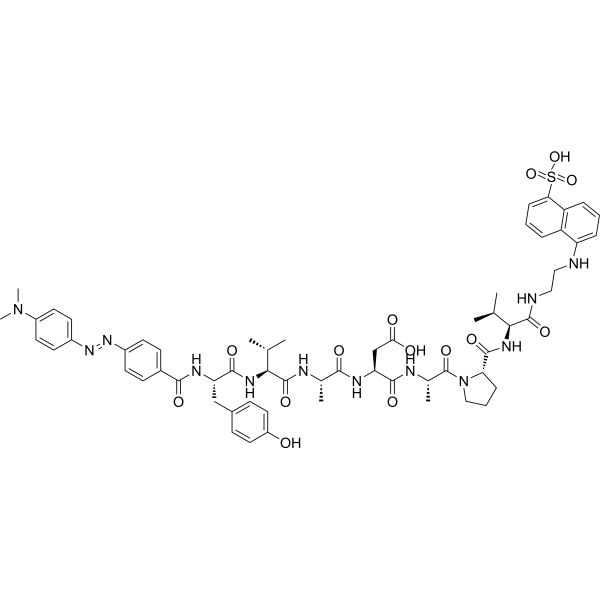
- HY-D1739
-
|
|
Fluorescent Dye
|
Others
|
|
DDAO phosphate diammonium is a fluorescent phosphatase substrate. DDAO phosphate diammonium has tunable excitation wavelength (600-650nm) and long emission wavelength (λem=656nm). DDAO phosphate diammonium can be used to detect the activity of different enzymes such as β-galactosidase, sulfatase, protein phosphatase 2A, carboxylesterase 2, human albumin and esterase.
|
-
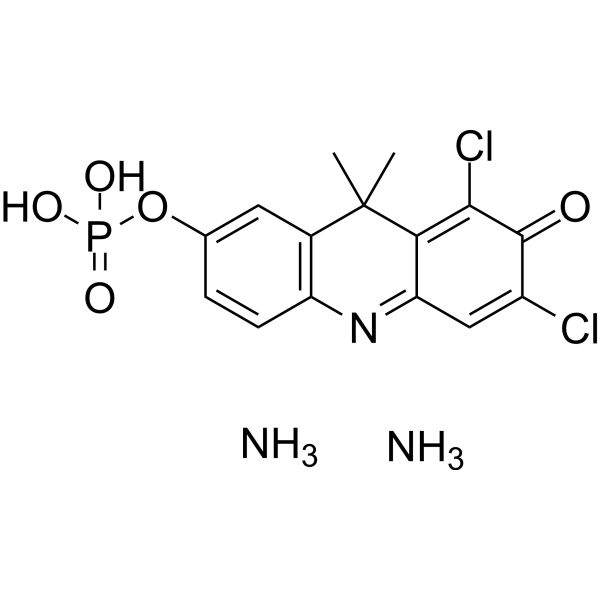
- HY-D2163
-
|
|
Fluorescent Dye
|
Others
|
|
AF 430 amine is a derivative of the yellow fluorescent dye AF 430. AF430 has an excitation wavelength of 430 nm and an emission wavelength of 542 nm. AF 430 amine can form covalent bonds through a condensation reaction between amino groups and molecules containing carboxyl groups. To achieve specific coupling of dye labels and biomolecules.
|
-
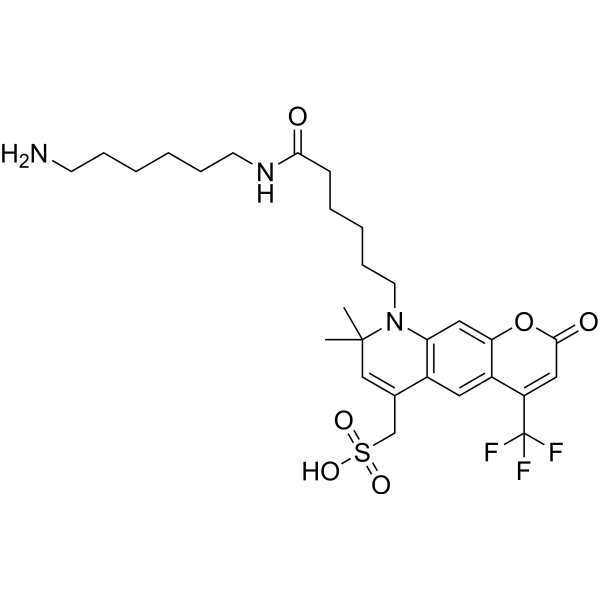
- HY-D2154
-
|
|
Fluorescent Dye
|
Others
|
|
AF 430 carboxylic acid is a derivative of the yellow fluorescent dye AF 430. AF430 has an excitation wavelength of 430 nm and an emission wavelength of 542 nm. AF 430 carboxylic acid can form covalent bonds through a condensation reaction between carboxylic acid groups and molecules containing amino groups. To achieve specific coupling of dye labels and biomolecules.
|
-
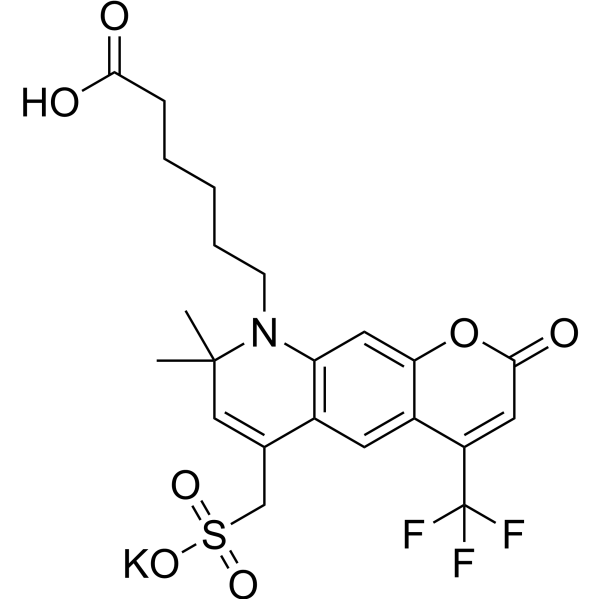
- HY-D2167
-
|
|
Fluorescent Dye
|
Others
|
|
AF 568 alkyne is a derivative of the orange fluorescent dye AF 568. AF 568 has a maximum emission wavelength of ~568 nm. AF 568 alkyne can undergo copper-catalyzed azide-alkyne cycloaddition (CuAAc) via the Alkyne group and molecules containing Azide groups. To achieve specific coupling of dye labels and biomolecules.
|
-
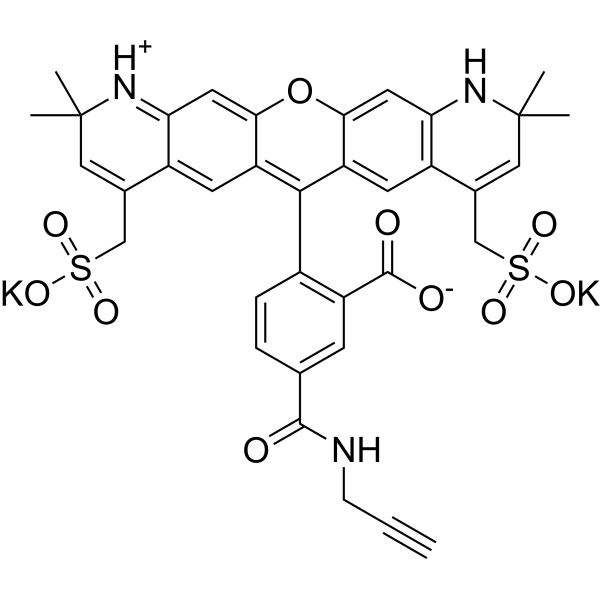
- HY-D2161
-
|
|
Fluorescent Dye
|
Others
|
|
AF 594 azide is an azide derivative of the red fluorescent dye AF 594, which has high fluorescence quantum yield and high photostability (maximum absorption wavelength of 586 nm, maximum emission wavelength of 613 nm). AF 594 azide forms stable adducts by reaction of the azide group with alkynyl derivatives (terminal alkynes and cyclooctyne).
|
-
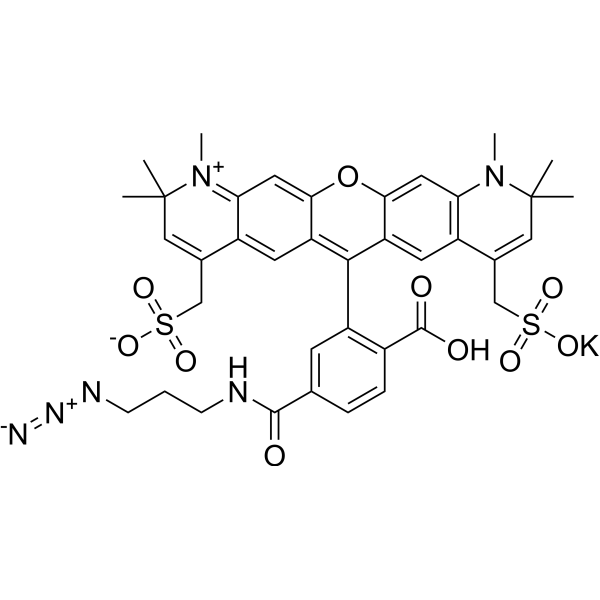
- HY-D2162
-
|
|
Fluorescent Dye
|
Others
|
|
AF 594 carboxylic acid is a carboxyl derivative of the red fluorescent dye AF 594, which has high fluorescence quantum yield and high photostability (maximum absorption wavelength of 586 nm, maximum emission wavelength of 613 nm). AF 594 carboxylic acid can form stable covalent bonds through the reaction of carboxylic acid groups with molecules with amino groups.
|
-
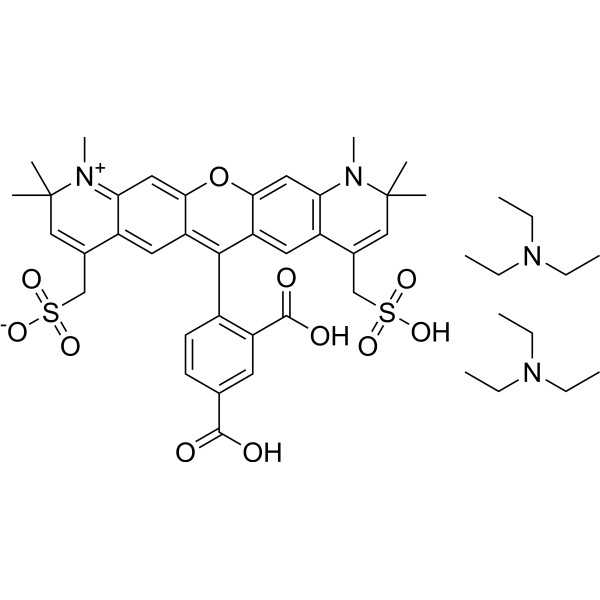
- HY-W440936
-
|
|
Liposome
|
|
|
Stearic acid-PEG-Rhodamine, MW 5000 is a fatty acid containing PEG polymer which can self assemble in an aqueous solution to form micelles. The polymer can be used to prepare nanoparticles for drug encapsulation. The red dye rhodamine can be easily traced by fluorescence microscopy. Rhodamine has maximum absorption at 570 nm and emission around 595 nm.
|
-

- HY-W440935
-
|
|
Liposome
|
|
|
Stearic acid-PEG-Rhodamine, MW 3400 is a fatty acid containing PEG polymer which can self assemble in an aqueous solution to form micelles. The polymer can be used to prepare nanoparticles for drug encapsulation. The red dye rhodamine can be easily traced by fluorescence microscopy. Rhodamine has maximum absorption at 570 nm and emission around 595 nm.
|
-
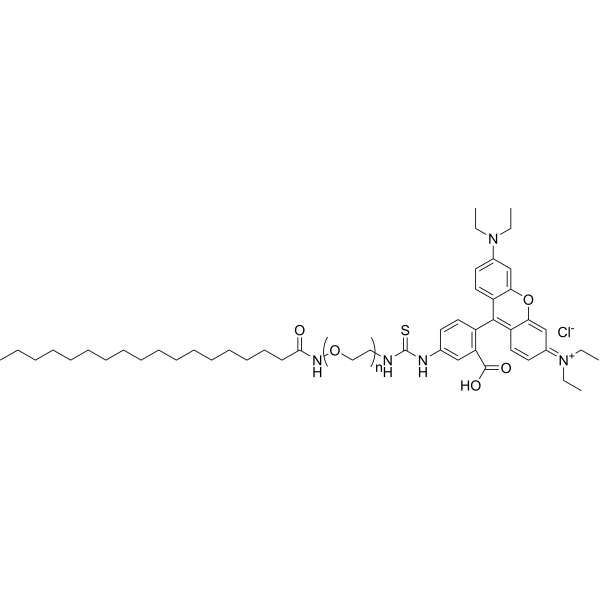
- HY-160270
-
|
|
Biochemical Assay Reagents
Fluorescent Dye
Liposome
|
Others
|
|
DSPE-PEG-Fluor 488,MW 5000 is a PEG-dye-lipid conjugate consists of a DSPE phospholipid which is an unsaturated phospholipid, a Fluor 488 dye which is a cyanine dye that is prominently used in fluorescence microscopy with excitation and emission maxima at 499 nm and 520 nm and a large PEG spacer which links the former substance together.
|
-
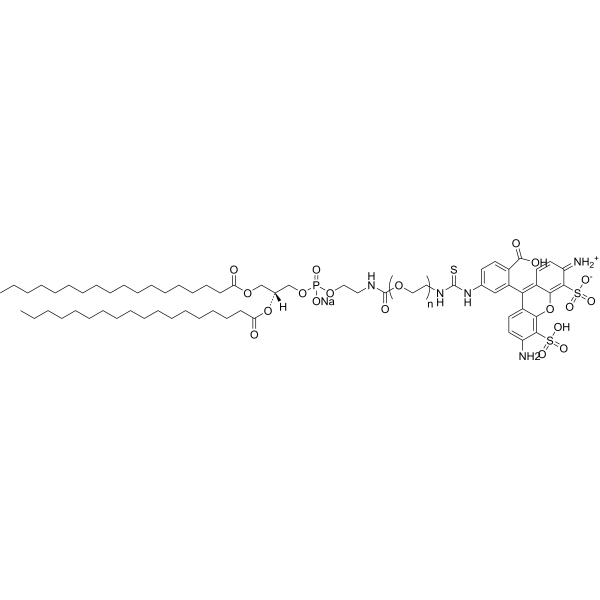
- HY-131010
-
|
|
Fluorescent Dye
Microtubule/Tubulin
|
Cancer
|
|
Flutax-2 (5/6-mixture) is an active fluorescent derivative of paclitaxel. Flutax-2 (5/6-mixture) binds to a polymerized α,β tubulin dimer. Excitation/emission wavelength: 496/524 nm. Paclitaxel, a diterpenoid secondary metabolite produced by Taxus species, can be used for the research of a variety of cancers .
|
-
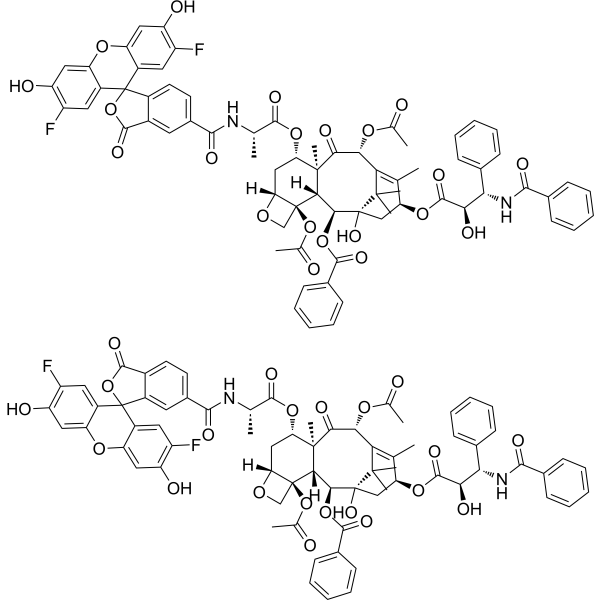
- HY-W247131
-
|
|
Fluorescent Dye
|
Neurological Disease
|
|
DASPEI is a cationic styrenyl mitochondrial dye with large Stokes shift. DASPEI has excitation and emission wavelength at 550/573 nm, which has good light chromogenic property. DASPEI can stain mitochondria in living cells with good labeling property. And DASPEI can also be used to stain presynaptic nerve endings independently of neuronal activity .
|
-
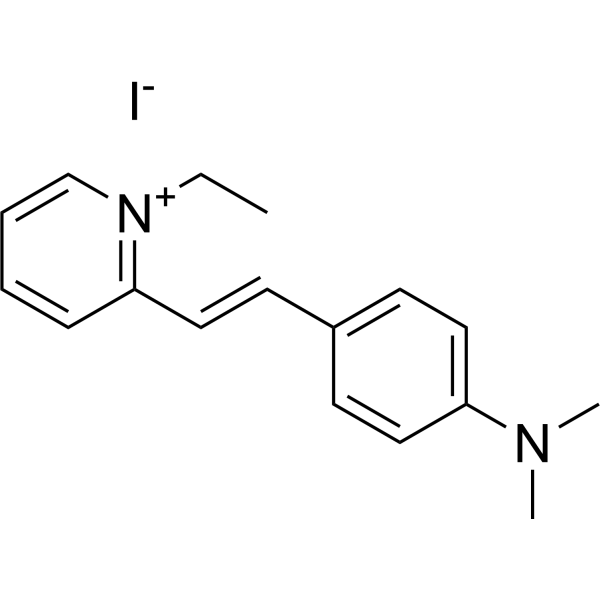
- HY-W176465
-
|
|
Amyloid-β
|
Others
|
|
BTA-2, a benzothiazole dye, is structurally similar to thioflavin T (ThT), which exhibits an enhanced fluorescence signal when bound to amyloid fibrils. BTA-2 has distinct absorption and emission characteristics in solution and when bound to amyloid fibrils, which makes it can used for identifying amyloid fibrils using spectroscopy .
|
-

- HY-D1783
-
|
|
Fluorescent Dye
|
Others
|
|
MitoTracker Deep Red FM fluorescent dye that selectively accumulates in the mitochondrial matrix. MitoTracker Deep Red FM covalently binds mitochondrial proteins by reacting with free mercaptan of cysteine residues, allowing staining of mitochondrial membrane potential independent of membrane potential. Excitation/emission wavelength 644/665 nm . Storage: Keep away from light.
|
-
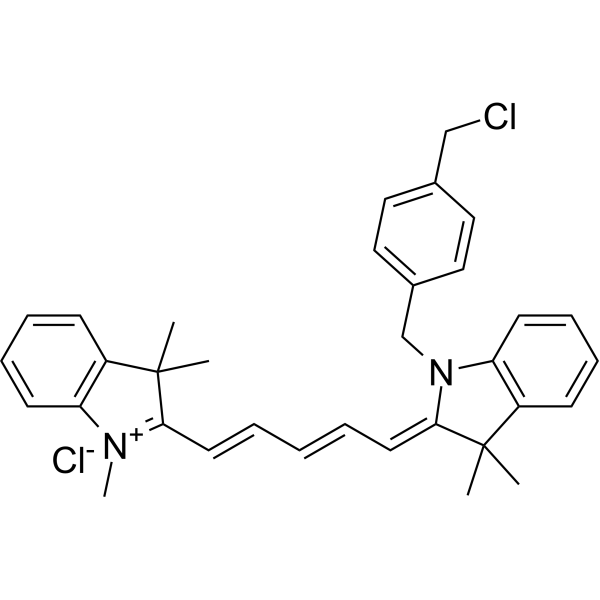
- HY-153081
-
|
|
Fluorescent Dye
|
Others
|
|
The eGFP circRNA will express green fluorescent protein, originally isolated from the jellyfish, Aequorea victoria. The eGFP is a commonly used direct detection reporter in mammalian cell culture, yielding bright green fluorescence with an emission peak at 509 nm. The eGFP circRNA is therefore ideal for monitoring and optimizing transfection efficiency and is recommended as a positive control for circular RNA transfections.
|
-
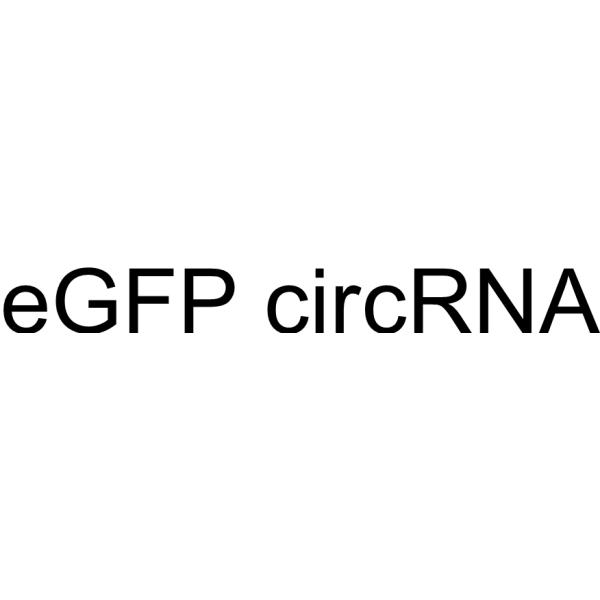
- HY-D2164
-
|
|
Fluorescent Dye
|
Others
|
|
AF 430 alkyne is a derivative of the yellow fluorescent dye AF 430. AF430 has an excitation wavelength of 430 nm and an emission wavelength of 542 nm. AF 430 alkyne can undergo copper-catalyzed azide-alkyne cycloaddition (CuAAc) via Alkyne groups and molecules containing Azide groups. To achieve specific coupling of dye labels and biomolecules.
|
-
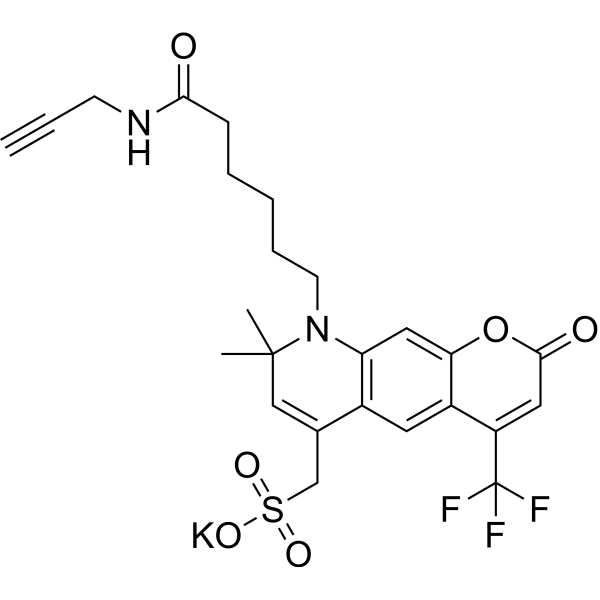
- HY-D2148
-
|
|
Fluorescent Dye
|
Others
|
|
AF 430 tetrazine is a derivative of the yellow fluorescent dye AF 430. AF430 has an excitation wavelength of 430 nm and an emission wavelength of 542 nm. AF 430 tetrazine contains a Tetrazine group that can undergo an inverse electron demand Diels-Alder reaction (iEDDA) with molecules containing TCO groups. To achieve specific coupling of dye labels and biomolecules.
|
-

- HY-W440938
-
|
|
Liposome
|
|
|
Stearic acid-PEG-FITC, MW 2000 is an amphiphatic polyPEG which can self assemble to form micelles in water. The polymer can be used to encapsulate therapeutic agent. FITC is a green dye with peak absorption at 494 nm and maximum emission at 520 nm and can be used for staining biological samples or nanoparticles. FITC can be easily traced by fluorescence microscopy.
|
-

- HY-D2161A
-
|
|
Fluorescent Dye
|
Others
|
|
AF 594 azide (triethylamine) is an azide derivative of the red fluorescent dye AF 594, which has high fluorescence quantum yield and high photostability (maximum absorption wavelength of 586 nm, maximum emission wavelength of 613 nm). AF 594 azide (triethylamine) forms stable adducts by reaction of the azide group with alkynyl derivatives (terminal alkynes and cyclooctyne).
|
-
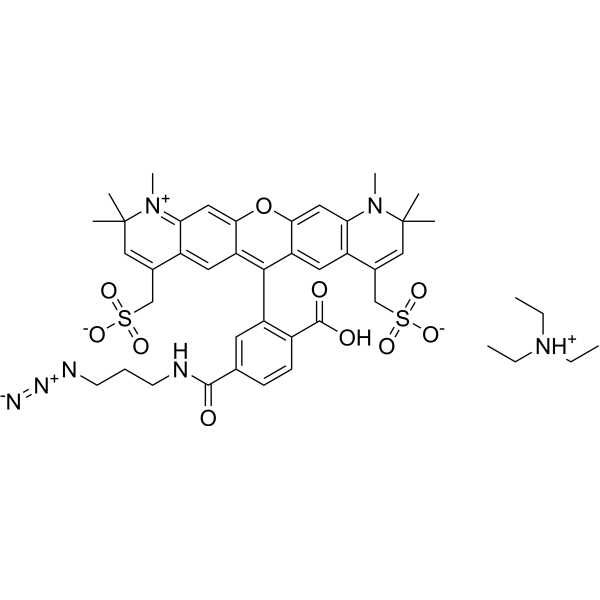
- HY-130736
-
|
JF549, SE; JF549, NHS
|
Fluorescent Dye
|
Others
|
|
Janelia Fluor® 549, SE (JF549, SE) is a fluorescent dye with the absorption maximum (λab (max)) of 549 nm and emission maximum (λem (max)) of 571 nm . Janelia Fluor® products are licensed under U.S. Pat. Nos. 9,933,417, 10,018,624 and 10,161,932 and other patents from Howard Hughes Medical Institute.
|
-
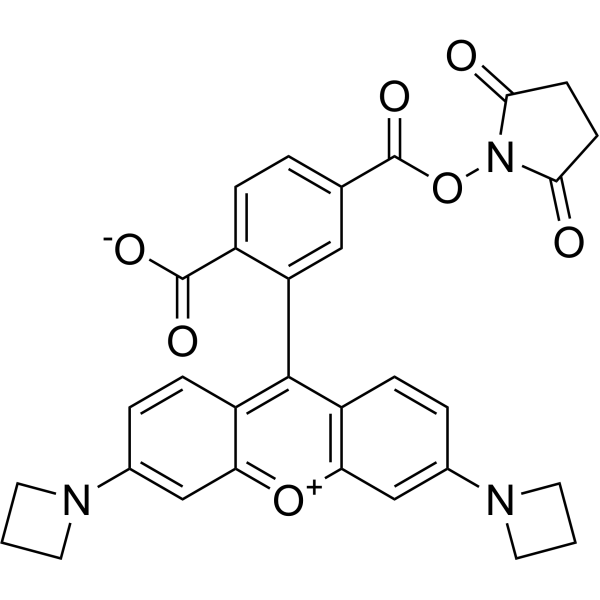
- HY-131021
-
|
JF549, Azide
|
Fluorescent Dye
|
Others
|
|
Janelia Fluor® 549, Azide (JF549, Azide) is a fluorescent dye with the absorption maximum (λab (max)) of 549 nm and emission maximum (λem (max)) of 571 nm . Janelia Fluor® products are licensed under U.S. Pat. Nos. 9,933,417, 10,018,624 and 10,161,932 and other patents from Howard Hughes Medical Institute.
|
-
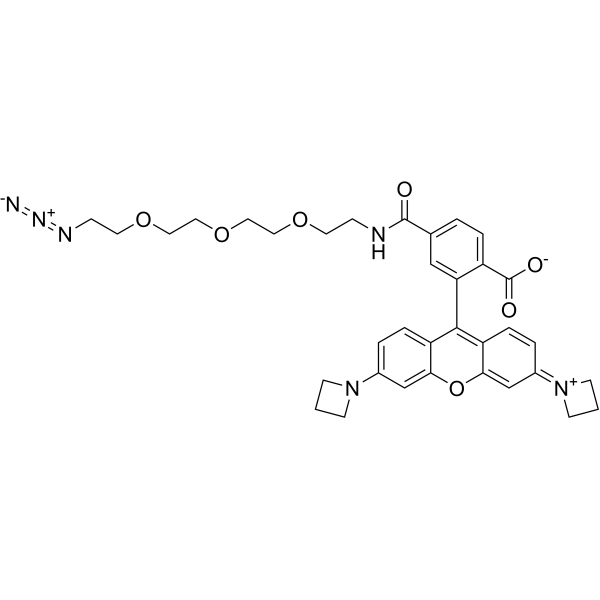
- HY-131022
-
|
JF549 TFA
|
Fluorescent Dye
|
Others
|
|
Janelia Fluor® 549 TFA (JF549 TFA) is a fluorescent dye with the absorption maximum (λab (max)) of 549 nm and emission maximum (λem (max)) of 571 nm . Janelia Fluor® products are licensed under U.S. Pat. Nos. 9,933,417, 10,018,624 and 10,161,932 and other patents from Howard Hughes Medical Institute.
|
-
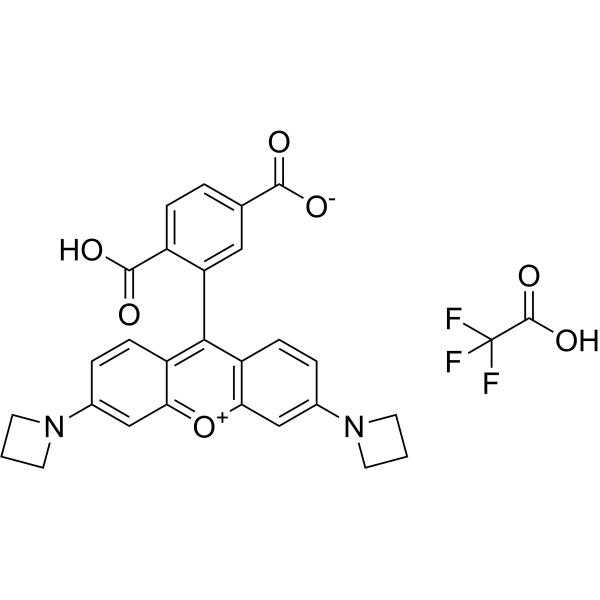
- HY-131024
-
|
JF549, Tetrazine
|
Fluorescent Dye
|
Others
|
|
Janelia Fluor® 549, Tetrazine (JF549, Tetrazine) is a fluorescent dye with the absorption maximum (λab (max)) of 549 nm and emission maximum (λem (max)) of 571 nm . Janelia Fluor® products are licensed under U.S. Pat. Nos. 9,933,417, 10,018,624 and 10,161,932 and other patents from Howard Hughes Medical Institute.
|
-
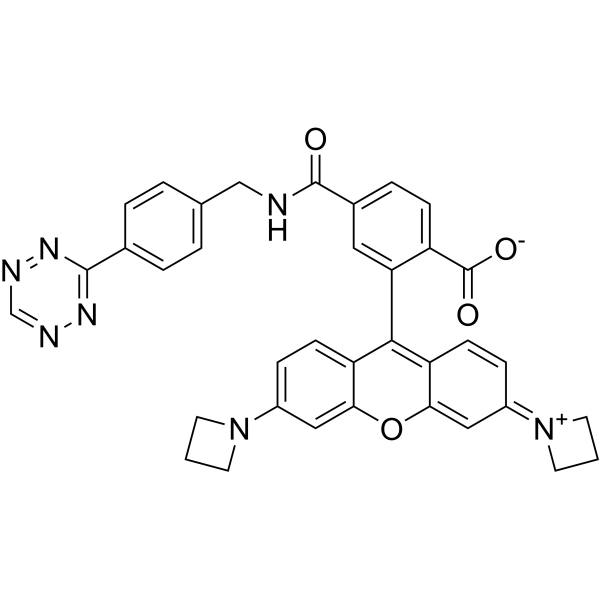
- HY-141464
-
|
Fmoc-Asn(Ac3AcNH-beta-Glc)-OH
|
Amino Acid Derivatives
|
Cancer
|
|
Fmoc-L-Asn(beta-D-GlcNAc(Ac)3)-OH (Fmoc-Asn(Ac3AcNH-beta-Glc)-OH) can be used in the synthesis of silicon-fluoride acceptor (SiFA) derivatized octreotate derivatives. SiFA-octreotate analogues, as tumor imaging agents, are useful tool for the research of positron emission tomography (PET) .
|
-
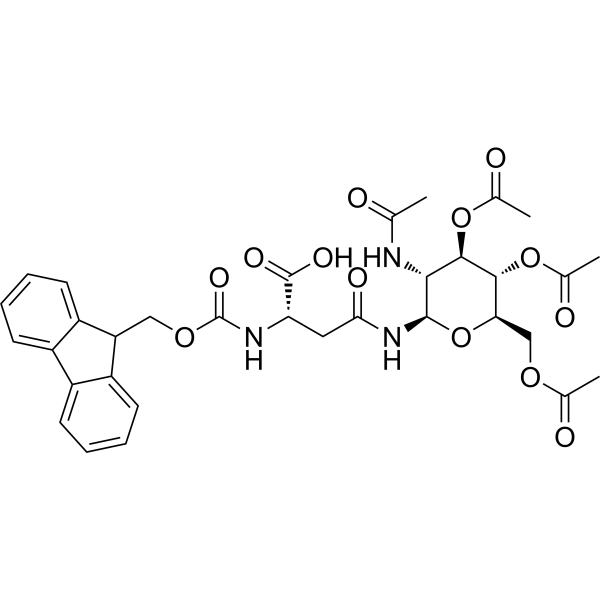
- HY-D1296
-
|
|
Fluorescent Dye
|
Others
|
|
Green DND-26 is a green fluorescently labeled lysosomal probe with a maximum excitation/emission wavelength of 504/511 nm. The structure is composed of a fluorescein group and linked weak bases, which can freely cross the cell membrane and generally gather on spherical organelles. Green DND-26 is suitable for observing the internal biosynthesis and related pathogenesis of lysosomes .
|
-
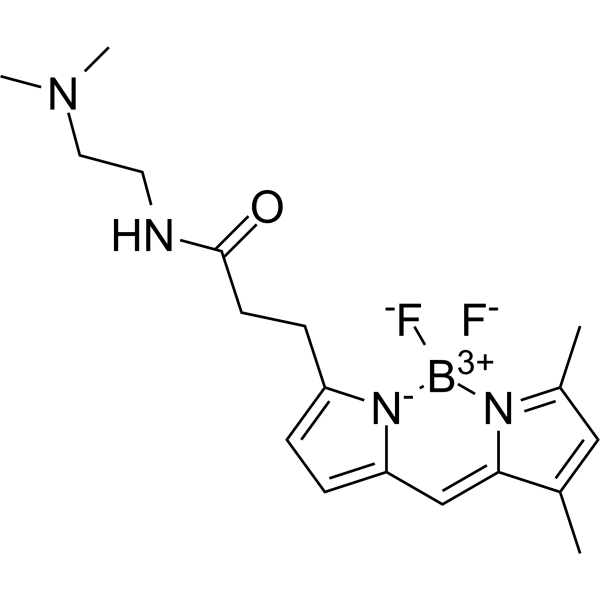
- HY-147114
-
|
|
Fluorescent Dye
|
Others
|
|
3-Methyl-8-(2'-deoxy-β-D-ribofuranosyl)isoxanthopterin is a DNA uptake tracer, a pteridine-based fluorescent guanosine analogue. 3-Methyl-8-(2'-deoxy-β-D-ribofuranosyl)isoxanthopterin is widely used in studies of DNA binding and dynamics, with an absorbance maximum at 350 nm and an emission maximum at 430 nm .
|
-
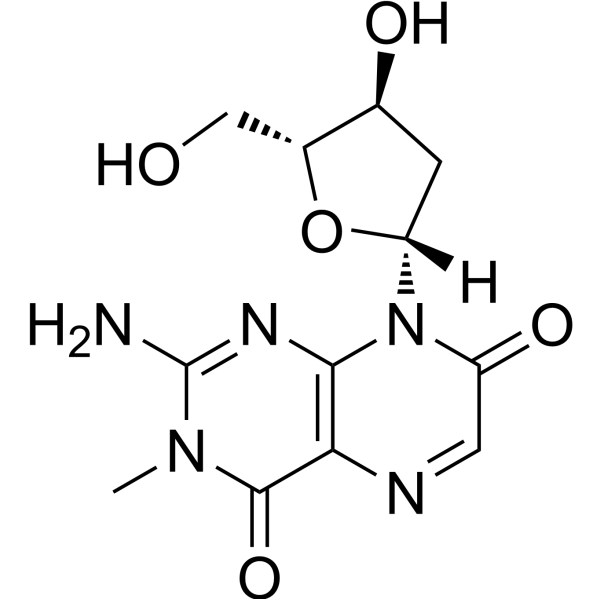
- HY-D1330
-
|
|
Fluorescent Dye
|
Others
|
|
BDP R6G azide is an anlong of BDP dye. BDP R6G azide is available that are tuned to match excitation and emission channels of classical xanthene and cyanine dyes. BDP R6G azide can be used in copper-catalyzed Click chemistry reactions with alkynes, DBCO and BCN. (λex=530 nm, λem=548 nm) .
|
-

- HY-D2194
-
|
|
Fluorescent Dye
|
Others
|
|
AgAuSe-COOH (1000 nm) is a fluorescent quantum dot that emits fluorescence in the near-infrared II region, with an emission peak reaching 1000 nm. AgAuSe-COOH (1000 nm) has the advantages of narrow band gap, large Stokes shift, and good photostability. AgAuSe-COOH (1000 nm) can bind proteins, antibodies, peptides, PEG, etc., and can be widely used in the field of biological imaging.
|
-
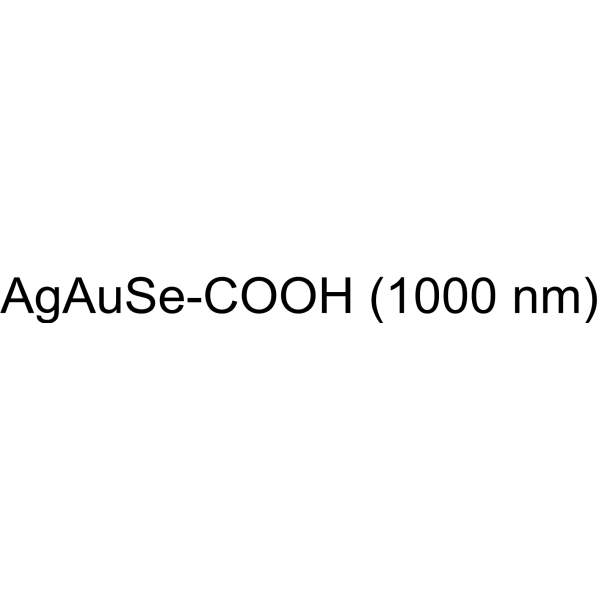
- HY-W440940
-
|
|
Liposome
|
|
|
Stearic acid-PEG-FITC, MW 5000 is a PEG lipid which forms micelles in water and can be used for drug delivery applications. The FITC fluorescent can be easily traced by miscroscopy. FITC is a green dye with peak absorption at 494 nm and maximum emission at 520 nm and can be used for staining biological samples or nanoparticles. FITC can be easily traced by fluorescence microscopy.
|
-

- HY-W440939
-
|
|
Liposome
|
|
|
Stearic acid-PEG-FITC, MW 3400 is a PEG lipid which forms micelles in water and can be used for drug delivery applications. The FITC fluorescent can be easily traced by miscroscopy. FITC is a green dye with peak absorption at 494 nm and maximum emission at 520 nm and can be used for staining biological samples or nanoparticles. FITC can be easily traced by fluorescence microscopy.
|
-
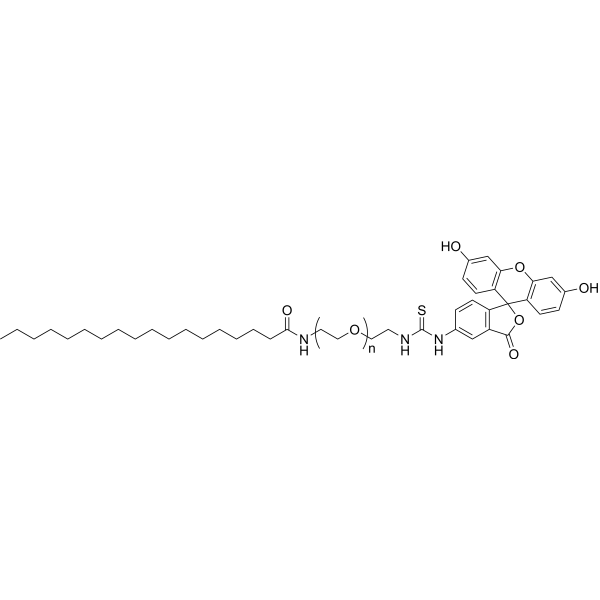
- HY-112526
-
|
|
Fluorescent Dye
|
Others
|
|
Thiofluor 623 (Compound 3) is a fluorescent turn-on probe that can be used for the selective sensing and bioimaging of thiols. Thiofluor 623 displays excellent immunity to interference from nitrogen and oxygen nucleophiles. Thiofluor 623 is essentially nonfluorescent in the absence of thiols, which cleave the probe and release the red-emissive donor-acceptor fluorophore (Ex=563 nm, Em=623 nm) .
|
-
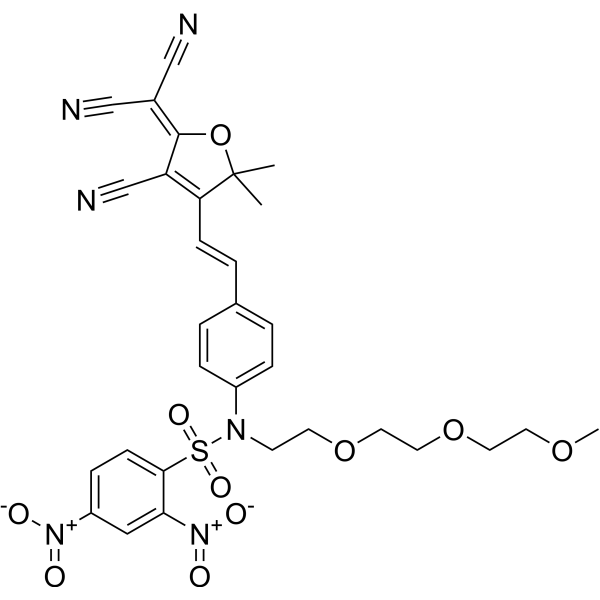
- HY-122607
-
|
|
Others
|
Inflammation/Immunology
Cancer
|
|
DPA-714 is a high affinity translocator protein (TSPO) ligand (Ki=7 nM), which is designed with a fluorine atom in its structure, allowing labelling with fluorine -18 and in vivo imaging using positron emission tomography. 18FDPA-714 successfully evaluates for the specific imaging of inflammation in various models of neuroinflammation and in a brain tumor model .
|
-
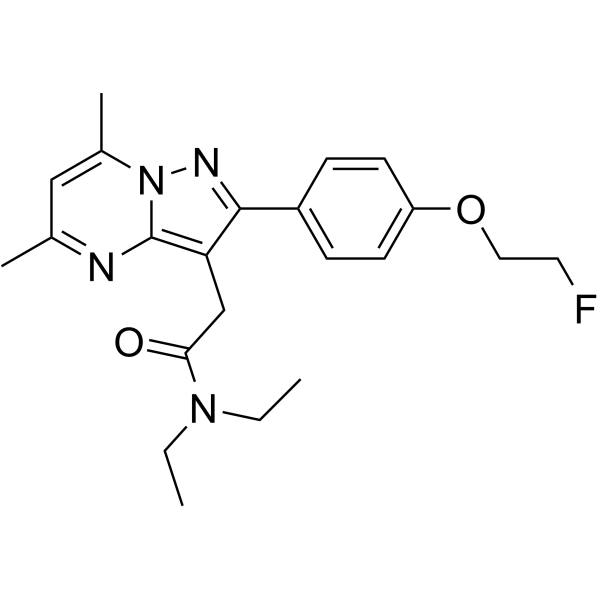
- HY-131023
-
|
JF549, Maleimide TFA
|
Fluorescent Dye
|
Others
|
|
Janelia Fluor® 549, Maleimide TFA (JF549, Maleimide TFA) is a fluorescent dye with the absorption maximum (λab (max)) of 549 nm and emission maximum (λem (max)) of 571 nm . Janelia Fluor® products are licensed under U.S. Pat. Nos. 9,933,417, 10,018,624 and 10,161,932 and other patents from Howard Hughes Medical Institute.
|
-

- HY-B1529A
-
|
Triammonium citrate
|
|
|
|
Citric acid triammonium (Triammonium citrate) is formed by Citric acid (HY-N1428) reacting with ammonia in a molar ratio of 1:3. Citric acid triammonium can be used as the carbon source to prepare carbon quantum dots (CDs). Citric acid triammonium with higher nitrogen components might promote the nitrogen-based functional groups in CDs, leading to a more efficient emission-color tunability .
|
-
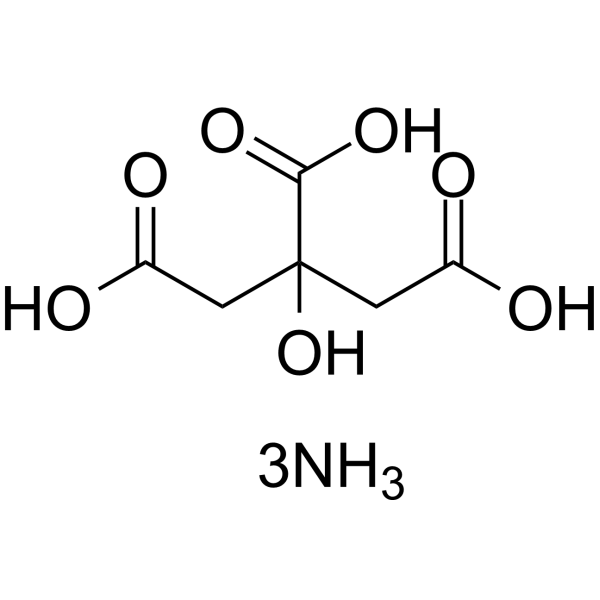
- HY-152073
-
|
|
Fluorescent Dye
|
Others
|
|
BETA-1 is the first twisted intramolecular charge transfer (TICT)-aggregation-induced emission (AIE) integration molecule. BETA-1 emits cyan fluorescence in lipid droplets (LDs) and red fluorescence in mitochondria. BETA-1 can be used for the simultaneous and dual-color imaging of LDs and mitochondria in vivo and in vitro .
|
-
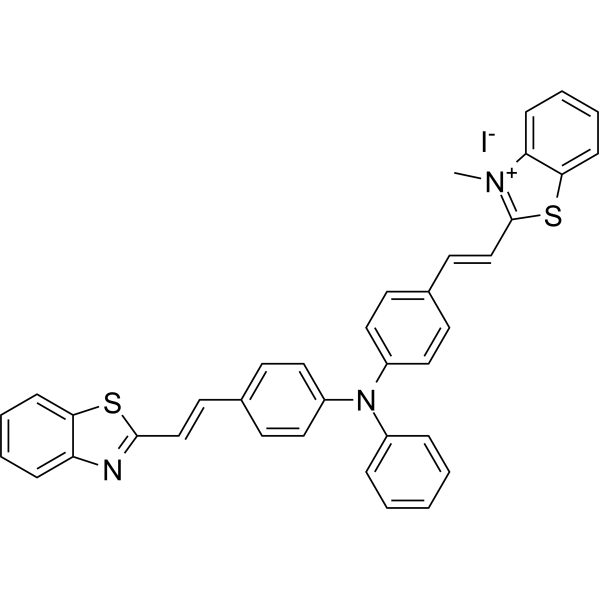
- HY-D1445
-
|
|
Fluorescent Dye
|
Metabolic Disease
|
|
PDMPO, a lysosome pH indicator, is an excellent fluorescent acidotropic reagent for fluorescence imaging. PDMPO is a potent tool with which to study acidic organelles of live cells. PDMPO exhibits pH-dependent dual-excitation and dual-emission spectral peaks. PDMPO produces a blue fluorescence in weakly acidic organelles and shifts to yellow in more acidic lysosomes (Abs=329 nm; Em=440 nm) .
|
-
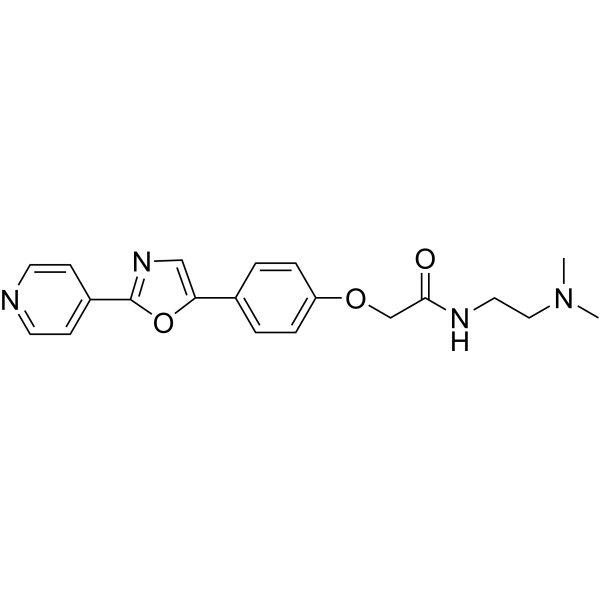
- HY-D0016
-
|
CTC
|
Fluorescent Dye
|
Others
|
|
5-Cyano-2,3-di-(p-tolyl)tetrazolium chloride (CTC) is a redox-sensitive red fluorescent dye. 5-Cyano-2,3-di-(p-tolyl)tetrazolium chloride can be used for detecting metabolic activity in microorganisms. The emission maximum of 5-Cyano-2,3-di-(p-tolyl)tetrazolium chloride is 602 nm .
|
-
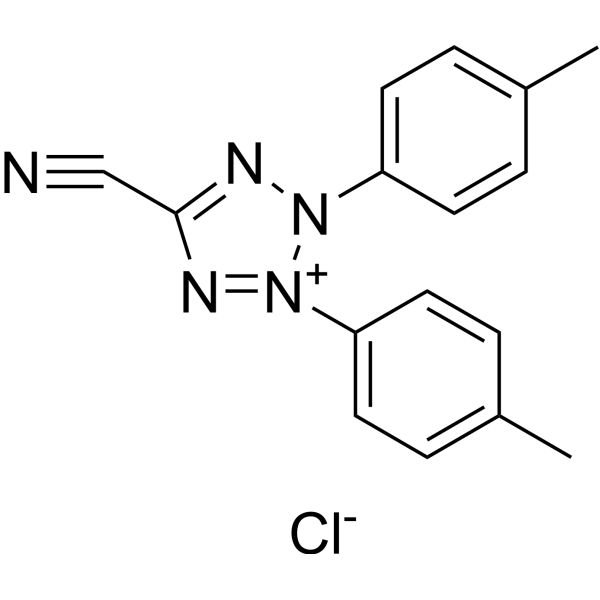
- HY-D1363
-
|
|
Fluorescent Dye
|
Others
|
|
BDP R6G maleimide is a borodipyrromethane fluorophore with absorption and emission wavelengths similar to those of R6G rhodamine. Sulfhydryl labelling is a common protein modification where the cysteine residues in the protein allow more site-specific labelling than the NHS ester of the amine group. BDP R6G maleimide is a thiol reactive dye that reacts with thiol groups to form thioester bonds .
|
-

- HY-D1920
-
|
|
Fluorescent Dye
|
Others
|
|
ATTO 390 azide is an azide derivative of ATTO 390 with excitation/emission maxima at 390/476 nm. ATTO 390 azide is a click chemistry reagent, it contains an Azide group and can undergo copper-catalyzed azide-alkyne cycloaddition reaction (CuAAc) with molecules containing Alkyne groups. Strain-promoted alkyne-azide cycloaddition (SPAAC) can also occur with molecules containing DBCO or BCN groups.
|
-

- HY-D1930
-
|
|
Fluorescent Dye
|
Others
|
|
ATTO 425 Azide is an azide derivative of ATTO 425, the maximum excitation and emission wavelength: 439/489 nm. ATTO 425 azide is a click chemistry reagent, it contains an Azide group and can undergo copper-catalyzed azide-alkyne cycloaddition reaction (CuAAc) with molecules containing Alkyne groups. Strain-promoted alkyne-azide cycloaddition (SPAAC) can also occur with molecules containing DBCO or BCN groups.
|
-
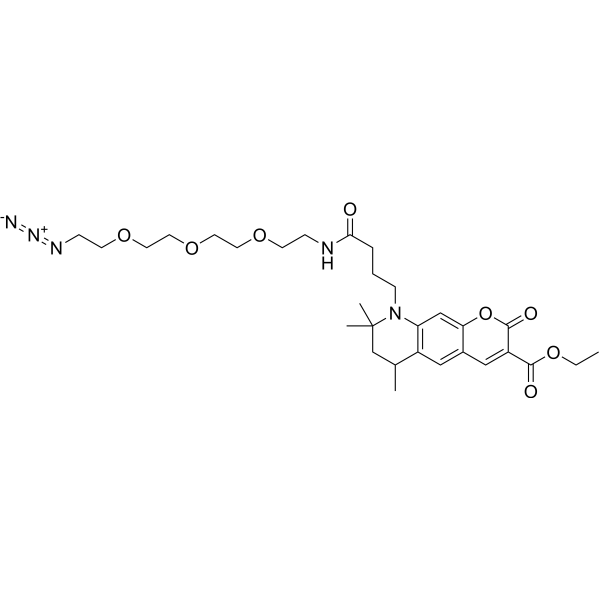
- HY-D1940
-
|
|
Fluorescent Dye
|
Others
|
|
ATTO 465 Azide is an azide derivative of ATTO 465, the maximum excitation/emission wavelength: 453/506 nm. ATTO 465 azide is a click chemistry reagent, it contains an Azide group and can undergo copper-catalyzed azide-alkyne cycloaddition reaction (CuAAc) with molecules containing Alkyne groups. Strain-promoted alkyne-azide cycloaddition (SPAAC) can also occur with molecules containing DBCO or BCN groups.
|
-

- HY-D1944
-
|
|
Fluorescent Dye
|
Others
|
|
ATTO 590 Azide is an azide derivative of ATTO 590 with excitation/emission maxima at 594/622 nm. ATTO 590 azide is a click chemistry reagent, it contains an Azide group and can undergo copper-catalyzed azide-alkyne cycloaddition reaction (CuAAc) with molecules containing Alkyne groups. Strain-promoted alkyne-azide cycloaddition (SPAAC) can also occur with molecules containing DBCO or BCN groups.
|
-
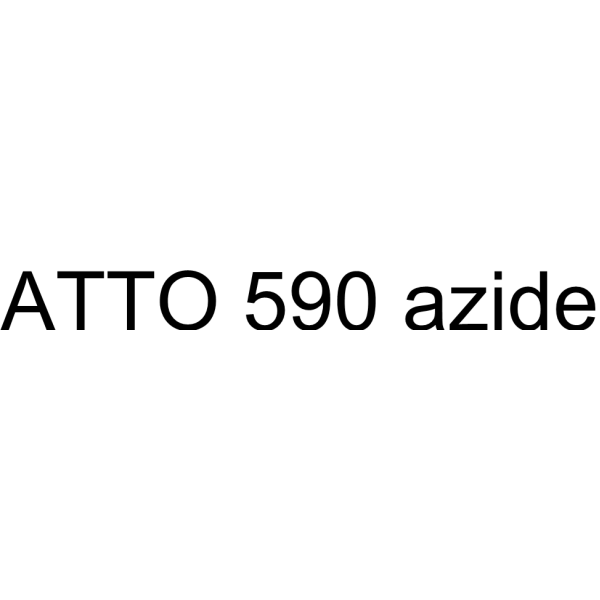
- HY-D1968
-
|
|
Fluorescent Dye
|
Others
|
|
ATTO 700 Azide is an azide derivative of ATTO 700 with excitation/emission maxima at 700/716 nm. ATTO 700 Azide is a click chemistry reagent, it contains an Azide group and can undergo copper-catalyzed azide-alkyne cycloaddition reaction (CuAAc) with molecules containing Alkyne groups. Strain-promoted alkyne-azide cycloaddition (SPAAC) can also occur with molecules containing DBCO or BCN groups.
|
-

- HY-D2010
-
|
|
Fluorescent Dye
|
Others
|
|
ATTO 488 azide is an azide derivative of ATTO 488 with excitation/emission maxima at 500/520 nm. ATTO 488 azide is a click chemistry reagent, it contains an Azide group and can undergo copper-catalyzed azide-alkyne cycloaddition reaction (CuAAc) with molecules containing Alkyne groups. Strain-promoted alkyne-azide cycloaddition (SPAAC) can also occur with molecules containing DBCO or BCN groups.
|
-
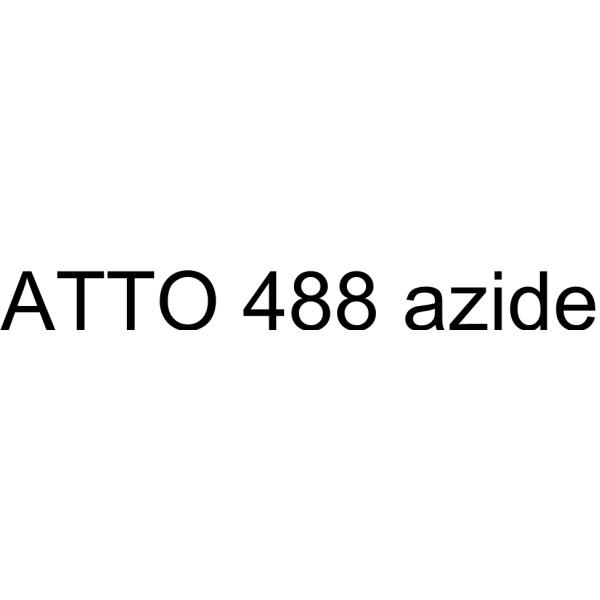
- HY-D2051
-
|
|
Fluorescent Dye
|
Others
|
|
ATTO 532 azide is an azide derivative of ATTO 532 with excitation/emission maxima at 532/552 nm. ATTO 532 azide is a click chemistry reagent, it contains an Azide group and can undergo copper-catalyzed azide-alkyne cycloaddition reaction (CuAAc) with molecules containing Alkyne groups. Strain-promoted alkyne-azide cycloaddition (SPAAC) can also occur with molecules containing DBCO or BCN groups.
|
-
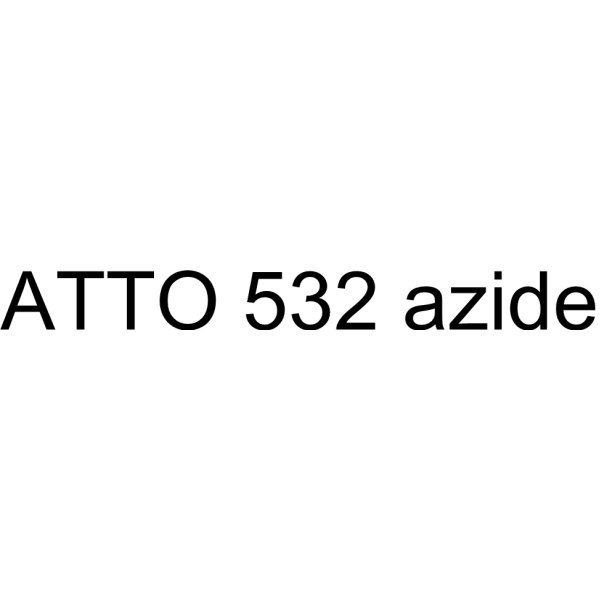
- HY-D2029
-
|
|
Fluorescent Dye
|
Others
|
|
ATTO 550 azide is an azide derivative of ATTO 550 with excitation/emission maxima at 554/576 nm. ATTO 550 azide is a click chemistry reagent, it contains an Azide group and can undergo copper-catalyzed azide-alkyne cycloaddition reaction (CuAAc) with molecules containing Alkyne groups. Strain-promoted alkyne-azide cycloaddition (SPAAC) can also occur with molecules containing DBCO or BCN groups.
|
-
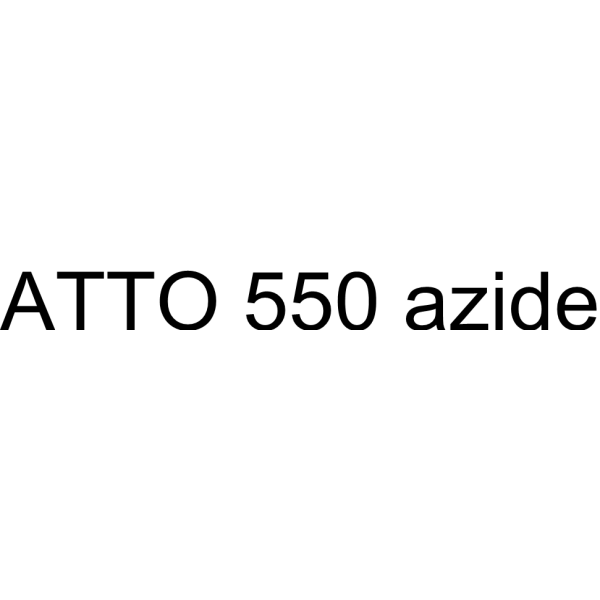
- HY-D2033
-
|
|
Fluorescent Dye
|
Others
|
|
ATTO 514 azide is an azide derivative of ATTO 514 with excitation/emission maxima at 511/531 nm. ATTO 514 azide is a click chemistry reagent, it contains an Azide group and can undergo copper-catalyzed azide-alkyne cycloaddition reaction (CuAAc) with molecules containing Alkyne groups. Strain-promoted alkyne-azide cycloaddition (SPAAC) can also occur with molecules containing DBCO or BCN groups.
|
-
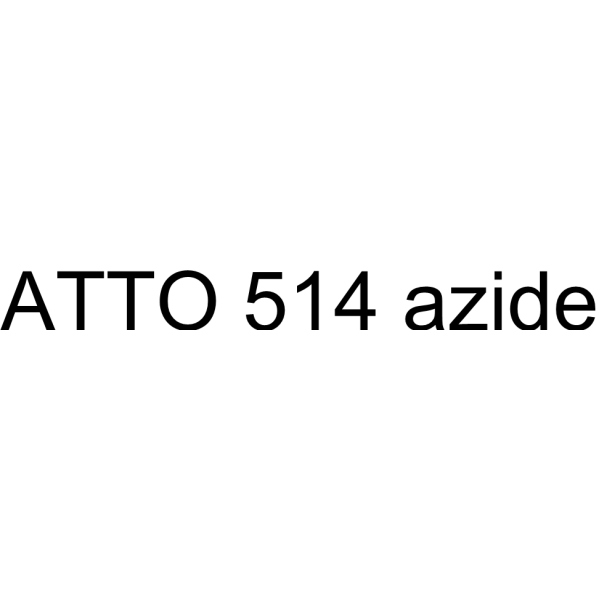
- HY-D2077
-
|
|
Fluorescent Dye
|
Others
|
|
ATTO 725 azide is an azide derivative of ATTO 725 with excitation/emission maxima at 728/751 nm. ATTO 725 azide is a click chemistry reagent, it contains an Azide group and can undergo copper-catalyzed azide-alkyne cycloaddition reaction (CuAAc) with molecules containing Alkyne groups. Strain-promoted alkyne-azide cycloaddition (SPAAC) can also occur with molecules containing DBCO or BCN groups.
|
-
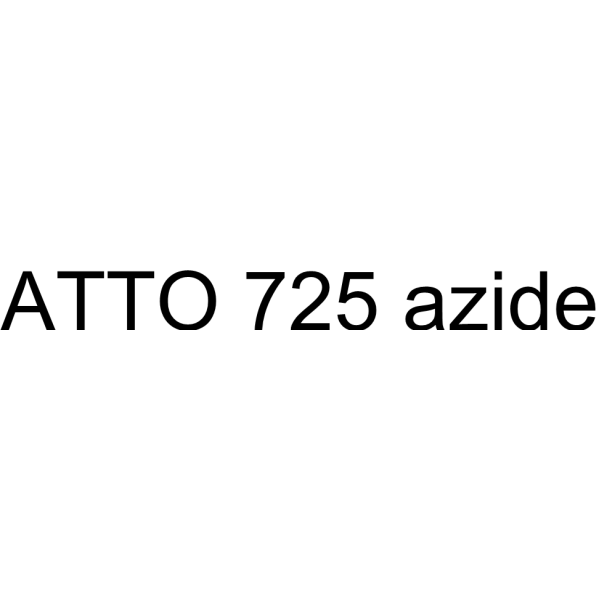
- HY-D2067
-
|
|
Fluorescent Dye
|
Others
|
|
ATTO 680 azide is an azide derivative of ATTO 680 with excitation/emission maxima at 681/698 nm. ATTO 680 azide is a click chemistry reagent, it contains an Azide group and can undergo copper-catalyzed azide-alkyne cycloaddition reaction (CuAAc) with molecules containing Alkyne groups. Strain-promoted alkyne-azide cycloaddition (SPAAC) can also occur with molecules containing DBCO or BCN groups.
|
-
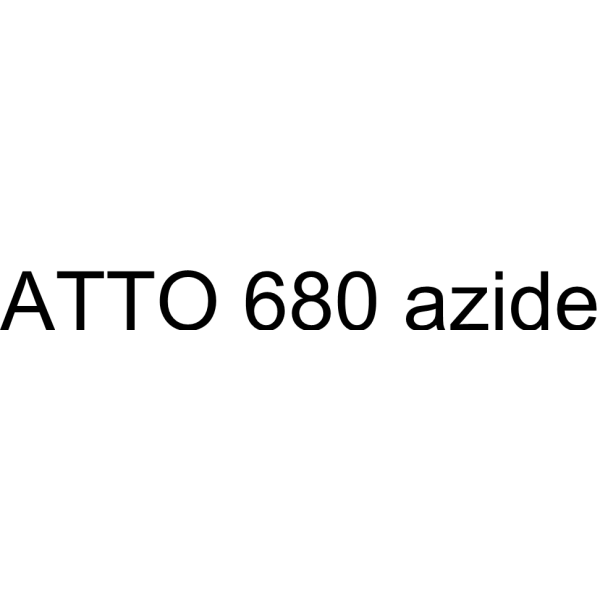
- HY-D2089
-
|
|
Fluorescent Dye
|
Others
|
|
PE-VF594 Maleimide is a double-dye dye that can undergo thiol reaction. It contains maleimide groups that can react with thiol groups to form covalent bonds. PE-VF594 Maleimide contains two dyes, PE and VF, with excitation wavelengths (Ex) of 495 nm and 566 nm, respectively. PE-VF594 Maleimide has an emission wavelength (Em) of 617 nm.
|
-
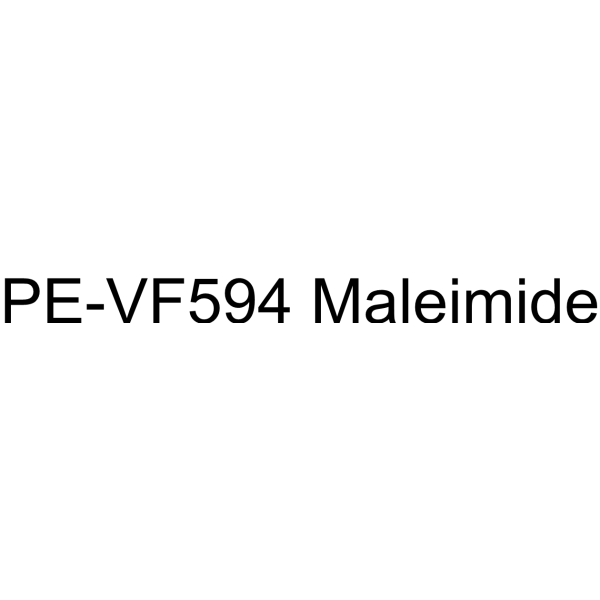
- HY-D2091
-
|
|
Fluorescent Dye
|
Others
|
|
PE-VF647 Maleimide is a double-dye dye that can undergo thiol reaction. It contains maleimide groups that can react with thiol groups to form covalent bonds. PE-VF647 Maleimide contains two dyes, PE and VF, with excitation wavelengths (Ex) of 495 nm and 566 nm, respectively. PE-VF594 Maleimide has an emission wavelength (Em) of 665 nm.
|
-
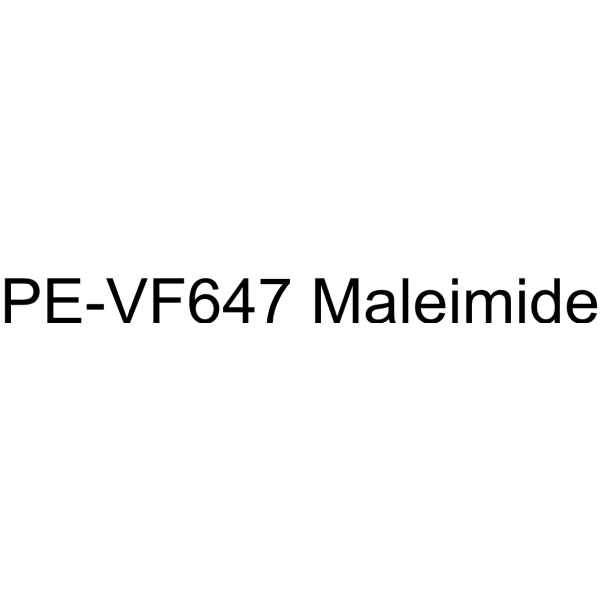
- HY-160269
-
|
|
Fluorescent Dye
|
Others
|
|
DSPE-PEG-Fluor 488,MW 2000 is a PEG-dye-lipid conjugate consisting of a DSPE phospholipid and a Fluor 488 dye. DSPE is a phospholipid that spontaneously forms micelles in a water medium, and Fluor 488 is a cyanine dye that is widely used in fluorescence microscopy. Fluor 488 has excitation and emission maxima at 499 nm and 520 nm. Polyethylene glycol lipids are commonly used for the stabilization of lipid nanoparticles .
|
-
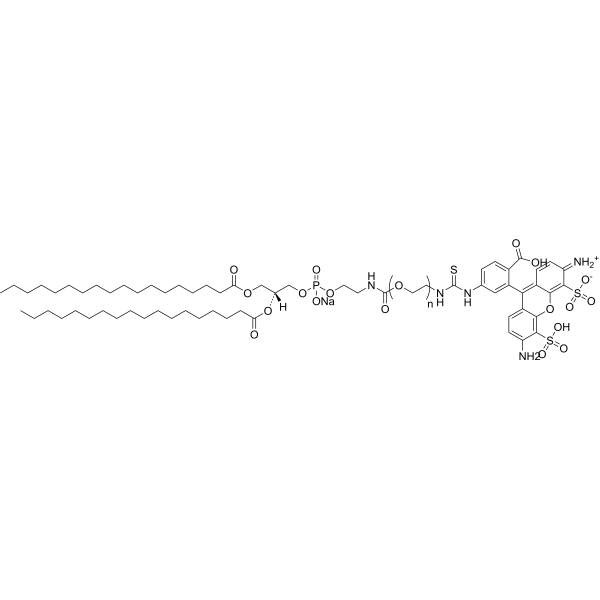
- HY-D2264
-
|
|
Fluorescent Dye
|
Others
|
|
Caffeine orange (Compound 1) is an aqueous-phase fluorescence turn-on sensor for caffeine that is highly selective to caffeine. Caffeine orange makes caffeinated coffee appear orange when exposed to 532 nM of green excitation light. Caffeine orange has excellent photophysical properties such as high extinction coefficient, high light stability and narrow emission bandwidth, which can be used in the research of caffeine detection devices 。
|
-
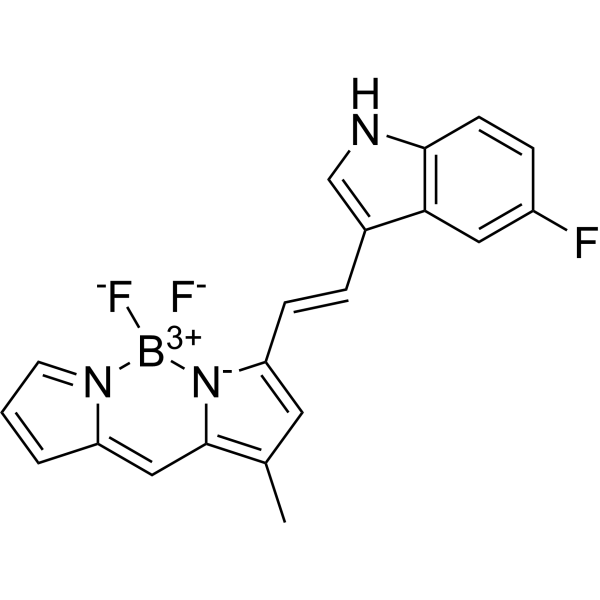
- HY-128890
-
|
|
ADC Linker
|
Cancer
|
|
DOTA-NHS-ester is a linker for affibody molecules and is applied in small animals PET, SPECT, and CT. DOTA-NHS-ester can be used to label radiotherapeutic agents or imaging probes for the detection of tumors .
|
-
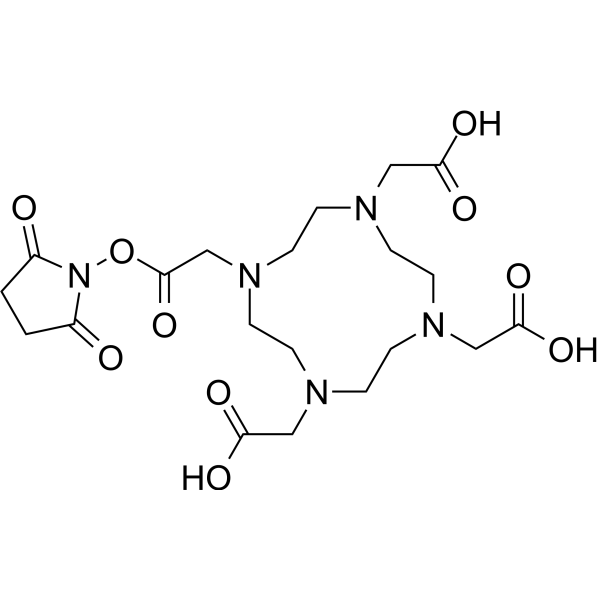
- HY-D1346
-
|
|
Fluorescent Dye
|
Others
|
|
610CP is a new type of actin labeling dye. It dissolves in organic solvents. In DMSO the 610CP excitation/emission wavelength is between 609 and 634 nm. 610CP is a fluorescent dye that penetrates living cells. Upon cell entry, 610CP binds to Bromo-des-methyl-Jasplakinolide Therefore, 610CP dye can be used to stain actin fluorescence images with low background and high resolution.
|
-
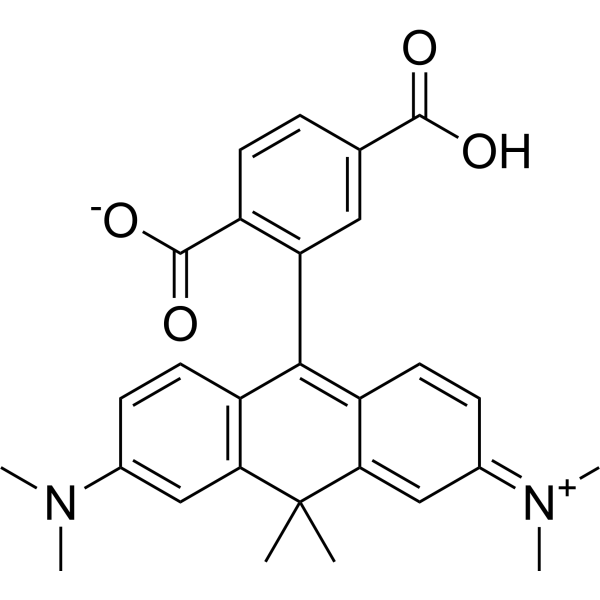
- HY-D0856
-
|
|
|
|
|
Bis-Tris is an amine buffer suitable for protein and nucleic acid systems with a pH buffer range of 5.8-7.2. Bis-Tris can also be mixed with HEPES and cacodylic acid buffer to create a pH 8 environment and monitor fluorescence emission intensity at 305 nm. Gels formulated with Bis-Tris also avoid protein degradation in samples prepared at higher pH (pH 8.5) .
|
-
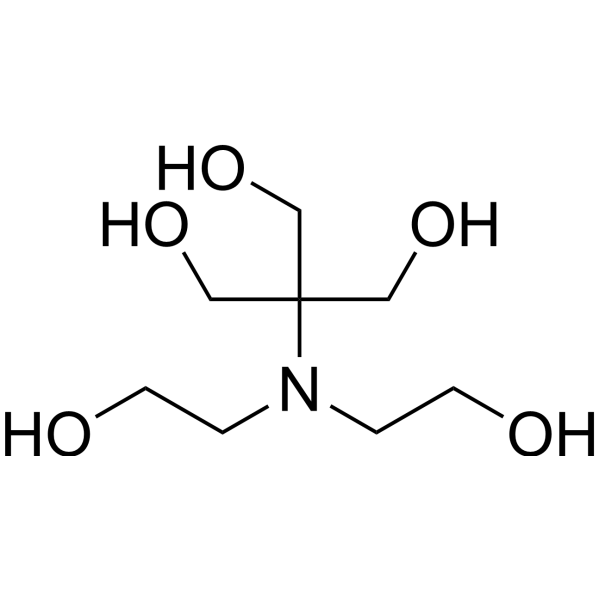
- HY-D2165
-
|
|
Fluorescent Dye
|
Others
|
|
AF 594 streptavidin is a bioconjugating agent. It consists of AF 594 and streptomycin, a streptomycin derivative of the red fluorescent dye AF 594. AF 594 has high fluorescence quantum yield and high photostability (maximum absorption wavelength 586 nm, maximum emission wavelength 613 nm). AF 594 streptavidin can be selectively conjugated to streptavidin-modified molecules via a streptomycin-modifying group for fluorescent labeling and spectroscopic analysis.
|
-
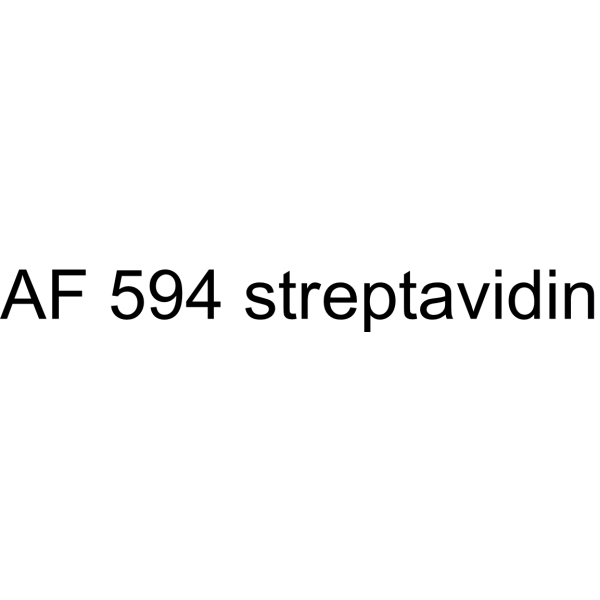
- HY-D0041
-
|
Calcein acetoxymethyl ester
|
Fluorescent Dye
|
Cancer
|
|
Calcein AM, has cell membrane permeability and can easily enter the cell. Calcein AM has no fluorescence and is hydrolyzed by endogenous esterase in the cell to produce polar molecule Calcein (Calcein), which has strong negative charge and cannot permeate the cell membrane. Calcein can emit strong green fluorescence, so it is often used with Propidium Iodide for cell viability/virulence detection, excitation/emission wavelength: 494/515 nm .
|
-
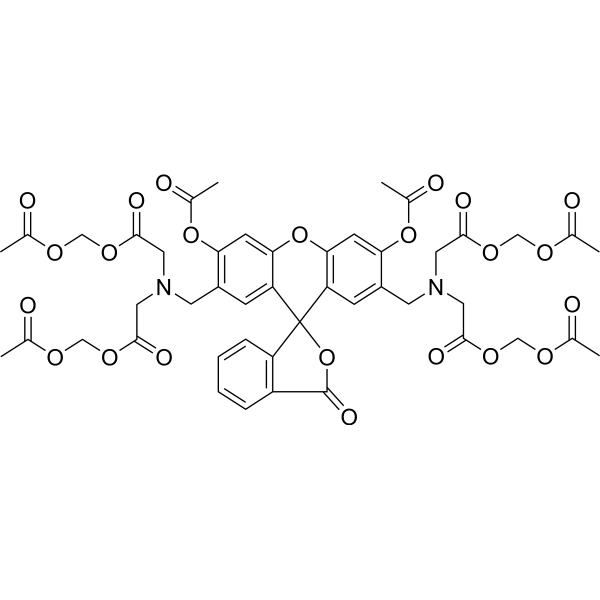
- HY-D2093
-
|
|
Fluorescent Dye
|
Others
|
|
PE-VF750 Maleimide is a thiol-reactive double-dye dye that contains maleimide groups that can react with thiol groups to form covalent bonds. Ex/Em=495-566/777 nm. PE-VF750 Maleimide contains two dyes, PE and VF, with excitation wavelengths (Ex) of 495 nm and 566 nm, respectively. PE-VF594 Maleimide has an emission wavelength (Em) of 777 nm.
|
-
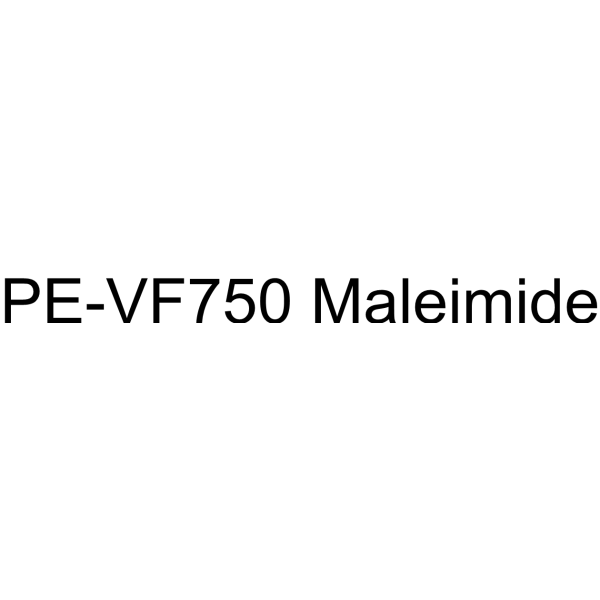
- HY-128692
-
|
|
Fluorescent Dye
|
Neurological Disease
|
|
Lucifer Yellow CH dilithium salt is a high-intensity fluorescent probe containing free hydrazyl groups. Lucifer Yellow CH can react with fatty aldehydes at room temperature. Lucifer Yellow CH serves as a biological tracer to monitor neuronal branching, regeneration, gap junction detection and characterization, and selective ablation of cells after aldehyde fixation. Lucifer yellow CH displays the maximum excitation/emission of 430 nm/540 nm, respectively .
|
-

- HY-W127715
-
|
|
Fluorescent Dye
|
Others
|
|
Lucifer Yellow CH dipotassium is a high-intensity fluorescent probe containing free hydrazyl groups. Lucifer Yellow CH can react with fatty aldehydes at room temperature. Lucifer Yellow CH serves as a biological tracer to monitor neuronal branching, regeneration, gap junction detection and characterization, and selective ablation of cells after aldehyde fixation. Lucifer yellow CH displays the maximum excitation/emission of 430 nm/540 nm, respectively .
|
-

- HY-D2168
-
|
|
Fluorescent Dye
|
Others
|
|
AF 568 azide is an azide derivative of the orange fluorescent dye AF 568. AF 568 has a maximum emission wavelength of ~568 nm. AF 568 alkyne can undergo copper-catalyzed azide-alkyne cycloaddition (CuAAc) via the Azide group and molecules containing Alkyne groups. Strain-promoted alkyne-azide cycloaddition (SPAAC) can also occur with molecules containing DBCO or BCN groups. To achieve specific coupling of dye labels and biomolecules.
|
-

- HY-D2092
-
|
|
Fluorescent Dye
|
Others
|
|
PE-VF680 Maleimide is a double-dye dye that can undergo thiol reaction. It contains maleimide groups that can react with thiol groups to form covalent bonds. Ex/Em=495-566/701 nm. PE-VF680 Maleimide contains two dyes, PE and VF, with excitation wavelengths (Ex) of 495 nm and 566 nm, respectively. PE-VF594 Maleimide has an emission wavelength (Em) of 701 nm.
|
-
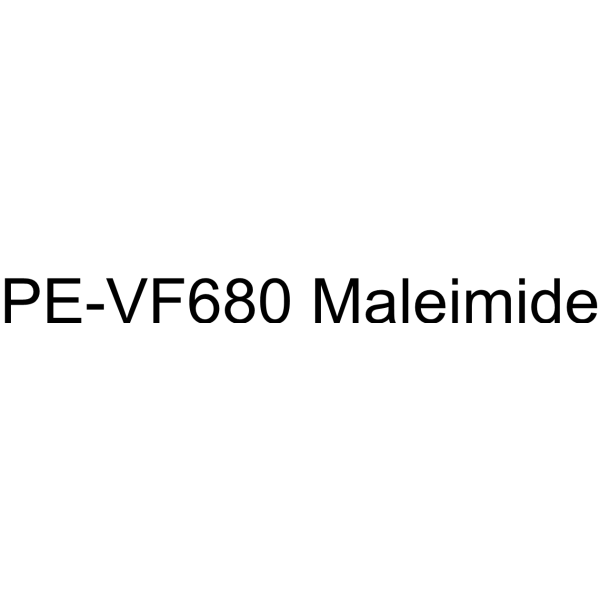
- HY-162084
-
|
|
Autophagy
Apoptosis
|
Cancer
|
|
BKN-1 is a bifunctional ligand that can not only track the formation of mtG4s (G-quadruplexes, four-stranded DNA structures containing Hoogsteen bonds) through far-red emission, but can also induce mitochondrial dysfunction. BKN-1 has anti-tumor activity and may cause mtDNA loss, damage mitochondrial integrity, reduce ATP levels, and trigger ROS imbalance, leading to apoptosis and autophagy .
|
-

- HY-D0827
-
|
Cyanine2
|
Fluorescent Dye
|
Others
|
|
Cyanines are formally compounds with two nitrogen atoms linked by an odd number of methene units. 26 28 The nitrogen atoms are parts of the heterocyclic units (such as indole, benzoxazol, or benzothiazol) . The structures and optical properties of representative cyanine dyes used for in vivo imaging are presented . Cyanines are characterized by long wavelength, tunable absorption and emission, very high extinction coefficient (up to 300,000 M 1 cm 1), good water solubility, and relatively straightforward synthesis .
|
-
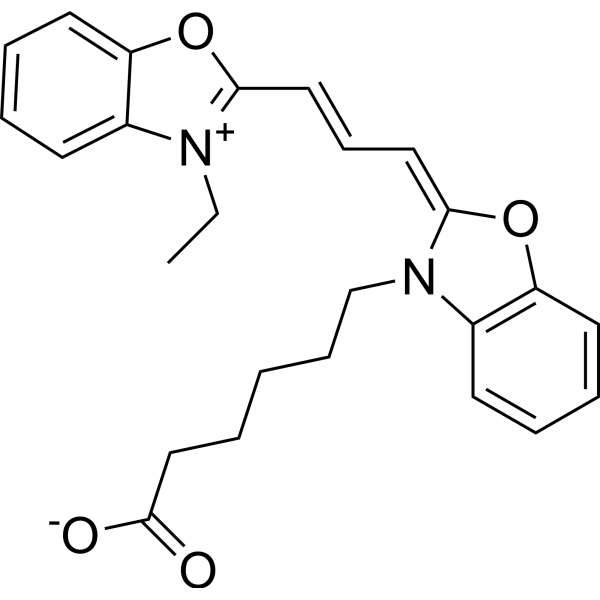
- HY-D0819
-
|
Cy5 NHS Ester; Sulfo-Cyanine5 Succinimidyl Ester
|
|
|
|
Cy5-SE (Cy5 NHS Ester) is a reactive dye for the labeling of amino-groups in peptides, proteins, and oligonucleotides. This dye requires small amount of organic co-solvent (such as DMF or DMSO) to be used in labeling reaction. This reagent is ideal for very cost-efficient labeling of soluble proteins, as well as all kinds of peptides and oligonucleotides. This reagent also works well in organic solvents for small molecule labeling.
Excitation (nm):649, Emission (nm): 670.
|
-
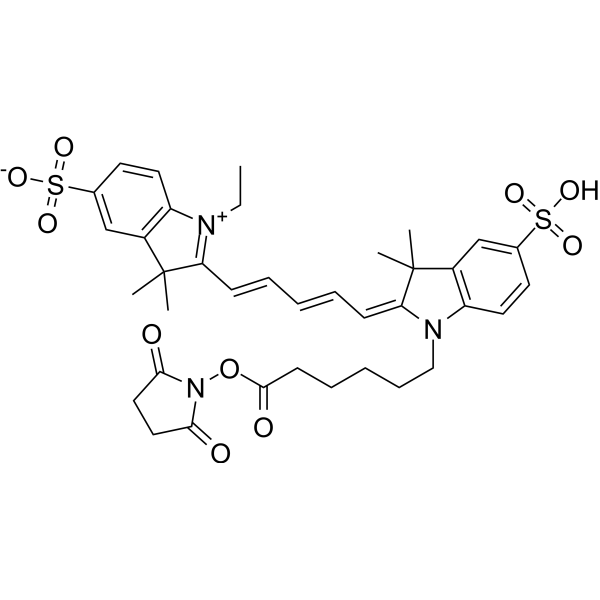
- HY-D1055
-
|
|
Fluorescent Dye
Reactive Oxygen Species
Mitochondrial Metabolism
|
Cancer
|
MitoSOX Red is a live cell fluorescent probe that specifically targets mitochondria and is cell membrane permeable. MitoSOX Red enters mitochondria and is oxidized by superoxide but not by other ROS or RNS generating systems. The oxidized MitoSOX Red then binds to nucleic acids in mitochondria/nucleus, producing strong red fluorescence. MitoSOX Red can be used as a fluorescent indicator to specifically detect superoxide. In addition, superoxide dismutase (SOD) can prevent the oxidation of MitoSOX Red.
Excitation/emission wavelength: 510/580 nm.
|
-
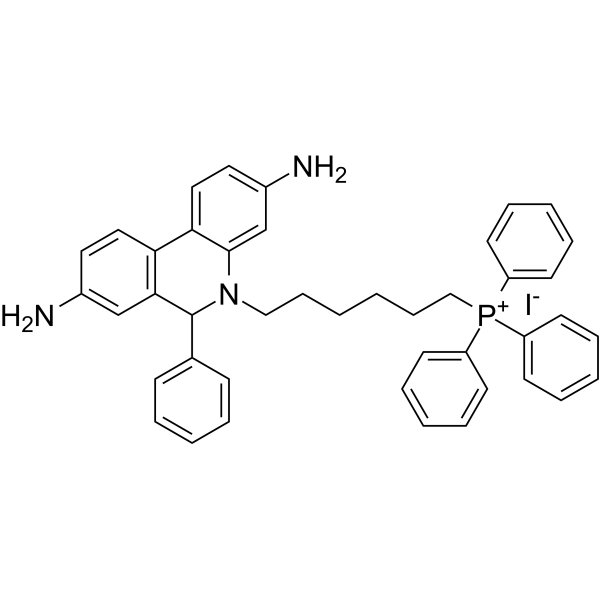
- HY-D2156
-
|
|
Fluorescent Dye
|
Others
|
|
AF 430 azide is a derivative of the yellow fluorescent dye AF 430. AF430 has an excitation wavelength of 430 nm and an emission wavelength of 542 nm. AF 430 azide can undergo copper-catalyzed azide-alkyne cycloaddition (CuAAc) via the azide group and molecules containing Alkyne groups. Strain-promoted alkyne-azide cycloaddition (SPAAC) can also occur with molecules containing DBCO or BCN groups. To achieve specific coupling of dye labels and biomolecules.
|
-

- HY-D2151
-
|
|
Fluorescent Dye
|
Others
|
|
AF 430 hydrazide is a derivative of the yellow fluorescent dye AF 430. AF430 has an excitation wavelength of 430 nm and an emission wavelength of 542 nm. AF 430 hydrazide can undergo copper-catalyzed azide-alkyne cycloaddition (CuAAc) via the Azide group and molecules containing Alkyne groups. Strain-promoted alkyne-azide cycloaddition (SPAAC) can also occur with molecules containing DBCO or BCN groups. To achieve specific coupling of dye labels and biomolecules.
|
-
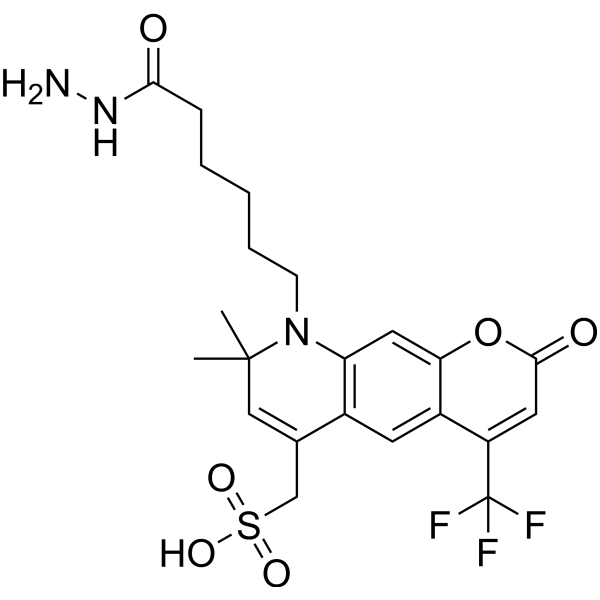
- HY-D2169
-
|
|
Fluorescent Dye
|
Others
|
|
AF 568 carboxylic acid is the non-reactive form of the orange fluorescent dye AF 568. AF 568 has a maximum emission wavelength of ~568 nm. AF 568 alkyne forms stable covalent bonds by reacting carboxylic acid groups with molecules bearing amino groups. Copper-catalyzed azide-alkyne cycloaddition (CuAAc) can occur with molecules containing Alkyne groups. Strain-promoted alkyne-azide cycloaddition (SPAAC) can also occur with molecules containing DBCO or BCN groups.
|
-
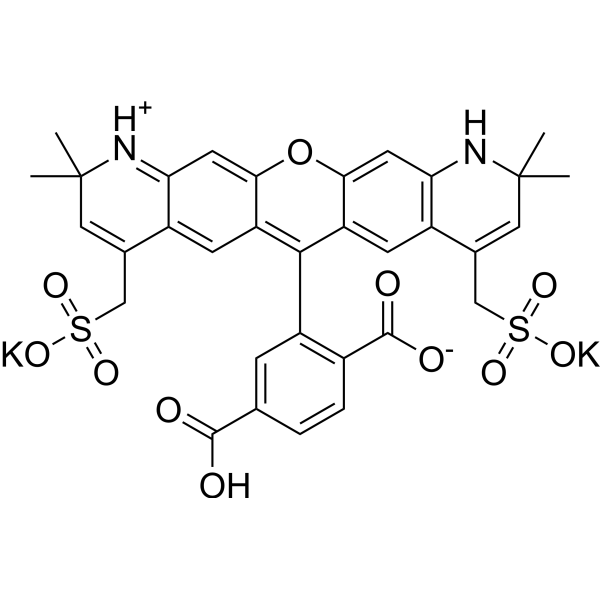
- HY-157317
-
|
|
Apoptosis
|
Cancer
|
|
Antitumor agent-126 (Compound II4) is a photoactive (IC50= 0.149) anticancer agent with significant near-infrared fluorescence emission at 650-760 nm. Antitumor agent-126 has antiproliferative activity and can induce apoptosis after laser irradiation. Antitumor agent-126 effectively inhibits tumor growth in mouse xenograft models exposed to 650 nm laser irradiation. Antitumor agent-126 can be used in cancer research .
|
-
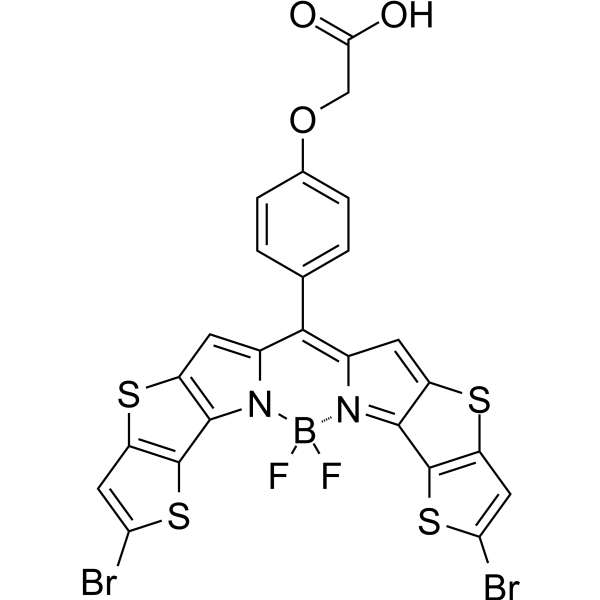
- HY-D0989
-
|
|
Fluorescent Dye
|
Others
|
|
Rhod-2 is a high-affinity visible light excitation wavelength Ca 2+ fluorescent probe, Rhod-2, AM is an acetyl methyl ester derivative of Rhod-2, which has cell membrane permeability and can easily enter cells with simple culture. Once it enters the cell, it is sheared by its lactesterase to produce Rhod-2 without membrane permeability, which remains in the cell to perform the corresponding physiological functions. Maximum excitation/emission wavelength: 549/578 nm .
|
-
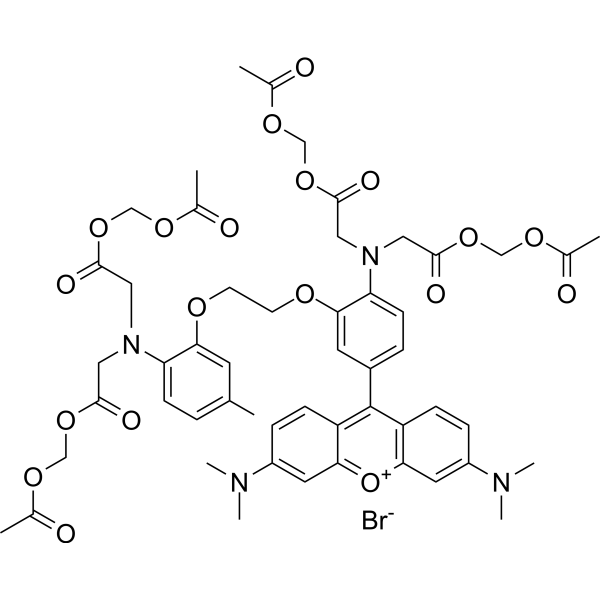
- HY-D0027
-
|
Coumarin 120; AMC
|
Fluorescent Dye
Antibiotic
Fungal
|
Infection
|
|
7-Amino-4-methylcoumarin belongs to a group of coumarins. 7-Amino-4-methylcoumarin can be isolated from an endophytic fungus Xylaria sp., has broad antimicrobial activity. 7-Amino-4-methylcoumarin is additionally commonly used as an important laser dye emitting in the blue region, as well as a fluorescent probe enabling analyses of glycoproteins’ monosaccharides and N-linked oligosaccharides. The excitation wavelength and emission wavelength are 351 nm and 430 nm, respectively .
|
-
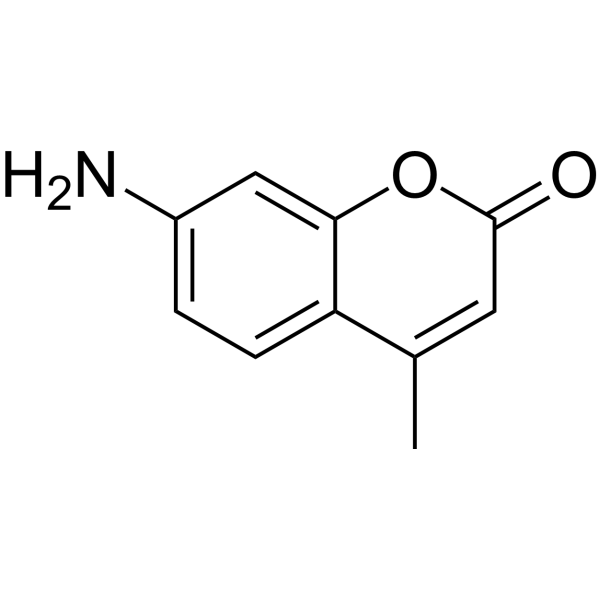
- HY-D0085
-
|
|
Fluorescent Dye
|
Others
|
|
DiSC3(5) is a fluorescent probe commonly used as a tracer dye to evaluate mitochondrial membrane potential. The excitation/emission wavelength of DiSC3(5) is up to 622/670 nm. DiSC3(5) can inhibit the respiratory system associated with mitochondrial NAD, and the IC50 value is 8 μM. DiSC3(5) in the presence of Na +/K +-ATPase inhibitor ouabain 2 can induce membrane hyperpolarization of Ehrlich ascites tumor cells .
|
-

- HY-156102
-
|
|
Bcr-Abl
|
Neurological Disease
|
|
c-ABL-IN-5 is a selective c-Abl inhibitor with neuroprotective effects. c-ABL-IN-5 has blood-brain barrier penetrability, metabolic stability and good pharmacokinetic properties. When c-ABL-IN-5 is labeled with [18F] (compound [18F]3), it can be used as a tracer to evaluate disease-modifying efficacy by complementary positron emission tomography (PET). c-ABL-IN-5 can be used in the study of neurodegenerative diseases such as Parkinson's disease (PD) .
|
-
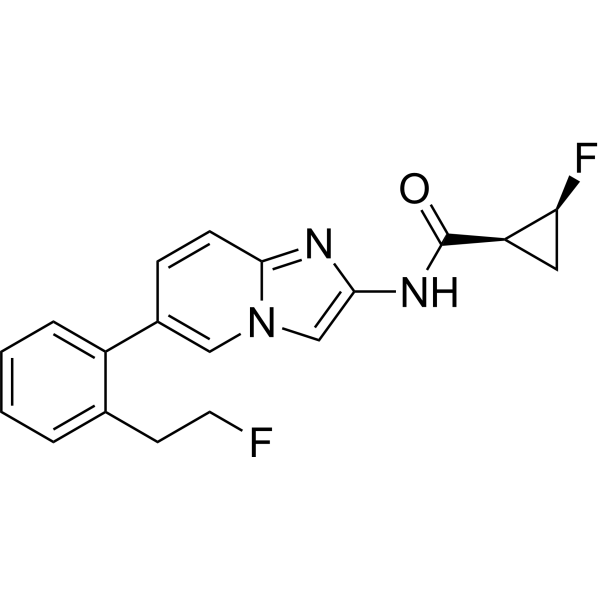
- HY-D1189
-
|
Lucifer Yellow 3-amino-D-alanine
|
Fluorescent Dye
|
Others
|
|
YADA (Lucifer Yellow 3-amino-D-alanine) is a conjugate of the fluorescent dyes Lucifer yellow and D-alanine, which is a green-yellow fluorescent dye. YADA is suitable for labeling peptidoglycans in living bacteria that can be incorporated into the cell wall where they are being synthesized. YADA has a large Stokes shift and a wide emission spectrum, allowing excitation through a purple light source and detection using a green filter. YADA showed good water solubility, light stability and thermal stability.
|
-
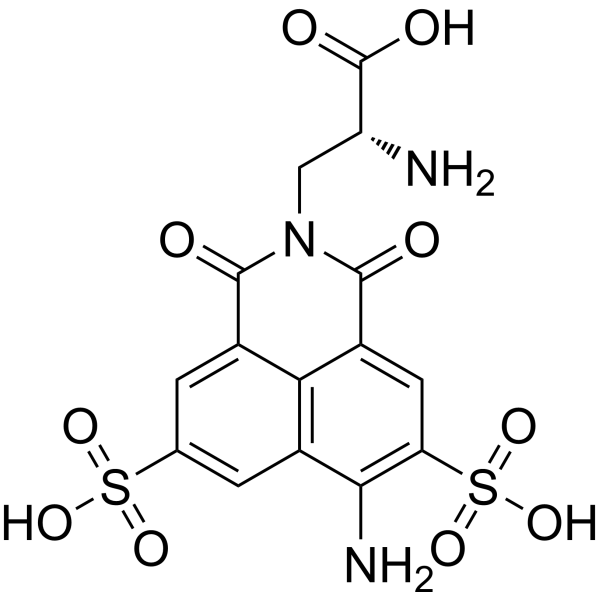
- HY-D1069
-
|
DBCO-Sulfo-Cy3
|
Fluorescent Dye
|
Others
|
|
DBCO-Cy3 (DBCO-Sulfo-Cy3) is the derivative of Cyanine3 fluorophore, a pH insensitive from pH (4-10) orange fluorescent dyewith excitation maximum 555 nm and emission maximum of 580nm. DBCO-Cy3 has fast reaction kinetics and good stability, and is productive to use in many standard fluorescent instrumentations. DBCO-Cy3 is a click chemistry reagent, it contains a DBCO group that can undergo strain-promoted alkyne-azide cycloaddition (SPAAC) with molecules containing Azide groups.
|
-

- HY-123633
-
|
|
Glucosidase
|
Others
|
|
4-Methylumbelliferyl β-D-Glucopyranoside, a β-D-glucoside, is a fluorogenic substrate for β-glucosidase, utilizes to assay β-glucosidase activity . 4-Methylumbelliferyl β-D-Glucopyranoside releases the highly fluorescent 4-methylumbelliferyl (4-MU), which has an emission maximum at 445-454 nm. The excitation maximum for 4-MU is pH-dependent: 330, 370, and 385 nm at pH 4.6, 7.4, and 10.4, respectively .
|
-
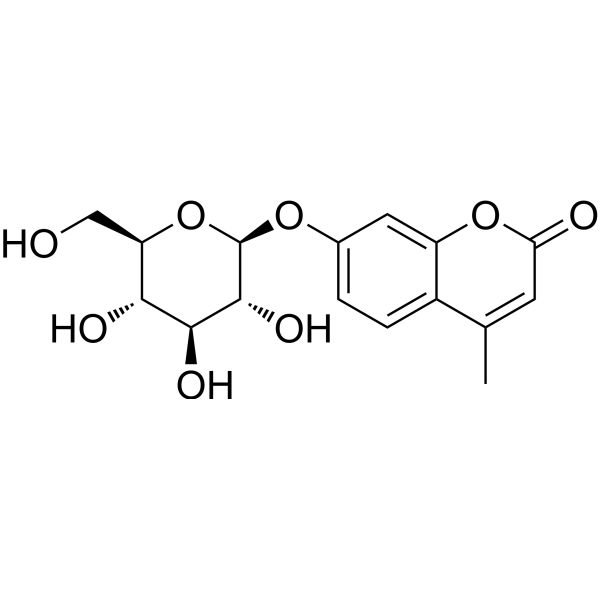
- HY-D1506
-
|
|
Fluorescent Dye
|
Others
|
|
Fl-DIBO (fluorogenic dibenzocyclooctyne) is a selective and high sensitivity fluorescent probe to azide compounds. Fl-DIBO can react rapidly with azide compounds to form new highly fluorescent products with a maximum emission wavelength of 469 nm and excitation wavelength of 363 nm. Fl-DIBO can be used to label diazo-tagged proteins without detectable background signal interference . Fl-DIBO is a click chemistry reagent, it contains an Alkyne group and can undergo copper-catalyzed azide-alkyne cycloaddition (CuAAc) with molecules containing Azide groups.
|
-

- HY-D1606
-
|
|
Adrenergic Receptor
|
Metabolic Disease
|
|
BODIPY FL prazosin is a fluorescent α1-adrenergic antagonist with Ki values of 14.5, 43.3 nM for α1a-AR and α1b-AR, respectively. BODIPY FL prazosin also is a fluorescent ligand with the excitation and emission wavelengths are 485 and 535 nm, respectively. BODIPY FL prazosin can be used for study the differences in the subcellular localization of α1-adrenoceptor subtypes .
|
-
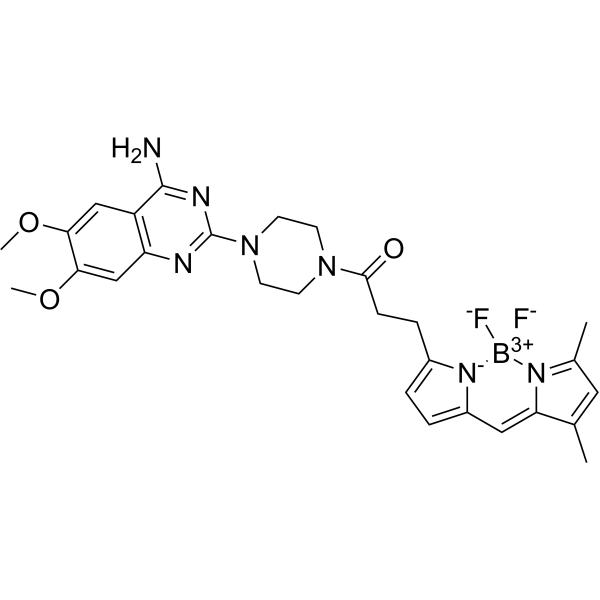
- HY-D1632
-
|
|
Fluorescent Dye
|
Others
|
|
4-MU-α-GlcNS sodium is a fluorogenic substrate of heparin sulphamidase, is desulfurized into 4-MU-α-GlcNH2. 4-MU-α-GlcNH2 can liberate 4-methylumbelliferone (4-MU, fluorescent product) via α-glucosaminidase catalysis, with the emission wavelength maxima of 445-454 nm. 4-MU-α-GlcNS sodium can be used to heparin sulphamidase deficiencies associated with Mucopolisaccaridosis IIIA and other lysosomal disorders researches .
|
-

- HY-139337
-
|
|
Fluorescent Dye
|
Metabolic Disease
|
|
SMCy5.5 is an SMCy dye used for lipid droplet labeling with a very high two-photon absorption cross-section. SMCy, unlike the well-known lipid droplet marker Nile Red, has narrow absorption and emission bands in visible light, allowing for multicolor imaging. SMCy is shown to be compatible with fixation, producing high-quality 3D images of lipid droplets in cells and tissues. The high brightness of SMCy5.5 enables efficient tracking and imaging of lipid droplet exchange between adipocytes .
|
-
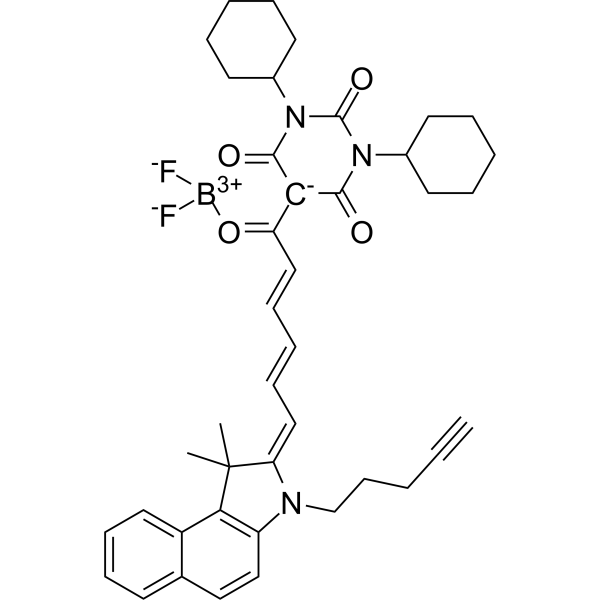
- HY-D0821
-
|
Sulfo-Cyanine5
|
Fluorescent Dye
|
Others
|
|
CY5 is a CY dye. CY, short for Cyanine, is a compound consisting of two nitrogen atoms connected by an odd number of methyl units. Cyanine compounds have the characteristics of long wavelength, adjustable absorption and emission, high extinction coefficient, good water solubility and relatively simple synthesis . CY dyes are of en used for the labeling of proteins, antibodies and small molecular compounds. For the labeling of protein antibodies, the combination can be completed through a simple mixing reaction. Below, we introduce the labeling method of protein antibody labeling, which has certain reference significance .
|
-

- HY-D1054
-
|
Cyanine2 (iodine)
|
Fluorescent Dye
|
Others
|
|
Cy2 iodine is a CY dye. CY, short for Cyanine, is a compound consisting of two nitrogen atoms connected by an odd number of methyl units. Cyanine compounds have the characteristics of long wavelength, adjustable absorption and emission, high extinction coefficient, good water solubility and relatively simple synthesis . CY dyes are of en used for the labeling of proteins, antibodies and small molecular compounds. For the labeling of protein antibodies, the combination can be completed through a simple mixing reaction. Below, we introduce the labeling method of protein antibody labeling, which has certain reference significance .
|
-

- HY-112498
-
|
Cyanine3 NHS ester
|
Fluorescent Dye
|
Others
|
|
Cy3 NHS ester is a CY dye. CY, short for Cyanine, is a compound consisting of two nitrogen atoms connected by an odd number of methyl units. Cyanine compounds have the characteristics of long wavelength, adjustable absorption and emission, high extinction coefficient, good water solubility and relatively simple synthesis . CY dyes are of en used for the labeling of proteins, antibodies and small molecular compounds. For the labeling of protein antibodies, the combination can be completed through a simple mixing reaction. Below, we introduce the labeling method of protein antibody labeling, which has certain reference significance .
|
-
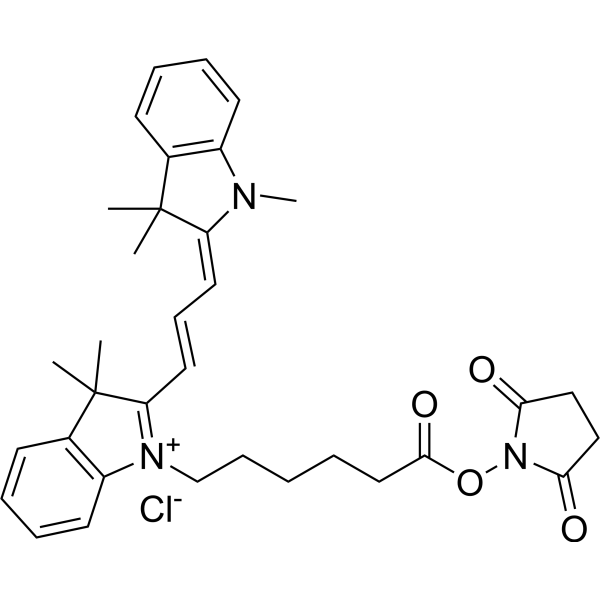
- HY-131025
-
|
JF585, SE; JF585, NHS
|
Fluorescent Dye
|
Others
|
|
Janelia Fluor 585, SE (JF585, SE) is an orange fluorescent dye containing an NHS ester that can be conjugated with primary amine groups. Janelia Fluor 585, SE can be used immediately for structured illumination (SIM) and stimulated emission depletion (STED) imaging and could be converted to photoactivatable derivative for single-molecule localization microscopy (SMLM) experiments . Janelia Fluor products are licensed under U.S. Pat. Nos. 9,933,417, 10,018,624 and 10,161,932 and other patents from Howard Hughes Medical Institute.
|
-
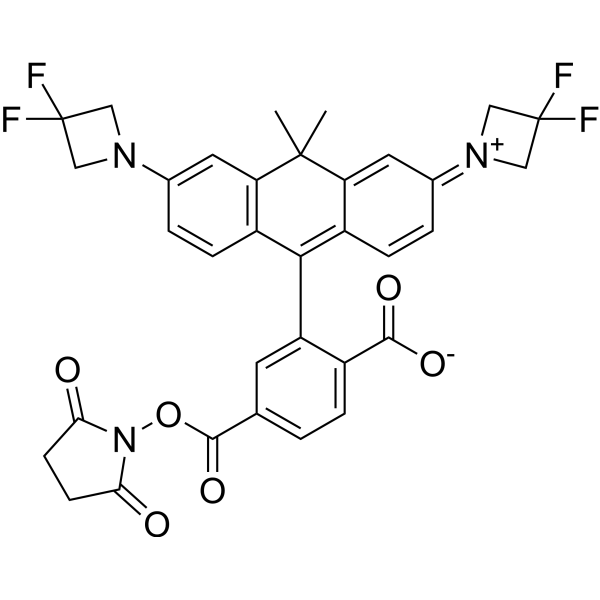
- HY-D0825
-
|
Sulfo-Cyanine7
|
|
|
|
CY7 is a CY dye. CY, short for Cyanine, is a compound consisting of two nitrogen atoms connected by an odd number of methyl units. Cyanine compounds have the characteristics of long wavelength, adjustable absorption and emission, high extinction coefficient, good water solubility and relatively simple synthesis . CY dyes are of en used for the labeling of proteins, antibodies and small molecular compounds. For the labeling of protein antibodies, the combination can be completed through a simple mixing reaction. Below, we introduce the labeling method of protein antibody labeling, which has certain reference significance .
|
-

- HY-138200
-
|
Cyanine5 maleimide
|
DNA Stain
Fluorescent Dye
|
Others
|
|
Cy5 maleimide is a CY dye. CY, short for Cyanine, is a compound consisting of two nitrogen atoms connected by an odd number of methyl units. Cyanine compounds have the characteristics of long wavelength, adjustable absorption and emission, high extinction coefficient, good water solubility and relatively simple synthesis . CY dyes are of en used for the labeling of proteins, antibodies and small molecular compounds. For the labeling of protein antibodies, the combination can be completed through a simple mixing reaction. Below, we introduce the labeling method of protein antibody labeling, which has certain reference significance .
|
-
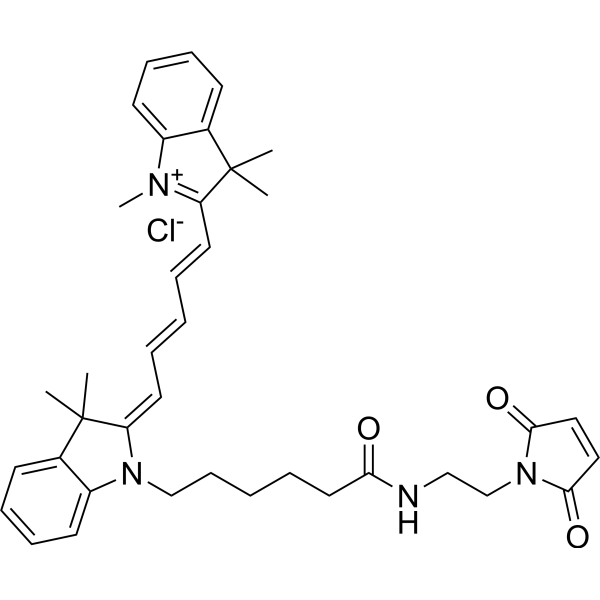
- HY-D1482
-
|
|
Fluorescent Dye
|
Others
|
|
Cy5 Tetrazine is a water-soluble, pH-insensitive from pH 4 to pH 10, far-red-fluorescent probe with excitation ideally suited for the 633 nm or 647 nm laser lines. Its absorption and emission spactra are almost identical to those of Alexa Fluor 647, CF 647 Dye, or any other Cyanine5 based fluorescent dyes. Sulfo-Cy5-tetrazine is a click chemistry reagent, it contains a Tetrazine group that can undergo an inverse electron demand Diels-Alder reaction (iEDDA) with molecules containing TCO groups.
|
-

- HY-D1388
-
|
|
Fluorescent Dye
|
Others
|
|
Cy3 NHS ester is a CY dye. CY, short for Cyanine, is a compound consisting of two nitrogen atoms connected by an odd number of methyl units. Cyanine compounds have the characteristics of long wavelength, adjustable absorption and emission, high extinction coefficient, good water solubility and relatively simple synthesis . CY dyes are of en used for the labeling of proteins, antibodies and small molecular compounds. For the labeling of protein antibodies, the combination can be completed through a simple mixing reaction. Below, we introduce the labeling method of protein antibody labeling, which has certain reference significance .
|
-
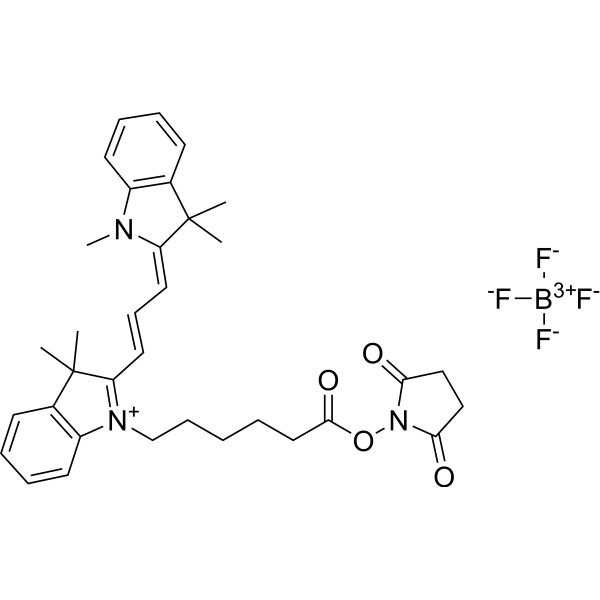
- HY-D0824
-
|
Sulfo-Cyanine7 Succinimidyl Ester
|
Fluorescent Dye
|
Others
|
|
CY7-SE is a CY dye. CY, short for Cyanine, is a compound consisting of two nitrogen atoms connected by an odd number of methyl units. Cyanine compounds have the characteristics of long wavelength, adjustable absorption and emission, high extinction coefficient, good water solubility and relatively simple synthesis . CY dyes are of en used for the labeling of proteins, antibodies and small molecular compounds. For the labeling of protein antibodies, the combination can be completed through a simple mixing reaction. Below, we introduce the labeling method of protein antibody labeling, which has certain reference significance .
|
-
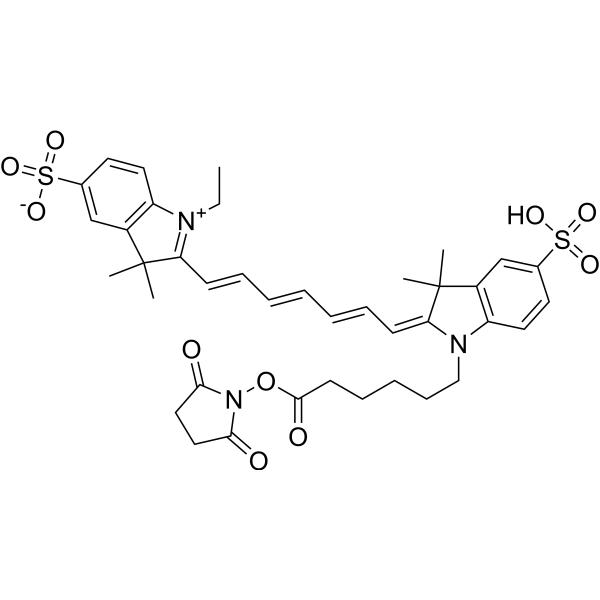
- HY-D0826
-
|
Cyanine2 Succinimidyl Ester (iodine)
|
Fluorescent Dye
|
Others
|
|
Cy2-SE iodine is a CY dye. CY, short for Cyanine, is a compound consisting of two nitrogen atoms connected by an odd number of methyl units. Cyanine compounds have the characteristics of long wavelength, adjustable absorption and emission, high extinction coefficient, good water solubility and relatively simple synthesis . CY dyes are of en used for the labeling of proteins, antibodies and small molecular compounds. For the labeling of protein antibodies, the combination can be completed through a simple mixing reaction. Below, we introduce the labeling method of protein antibody labeling, which has certain reference significance .
|
-
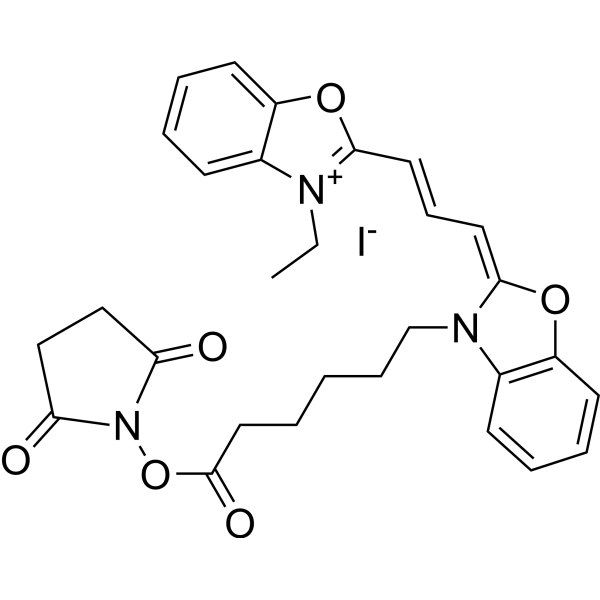
- HY-D0824A
-
|
Sulfo-Cyanine7 Succinimidyl Ester triethylamine
|
Fluorescent Dye
|
Others
|
|
CY7-SE triethylamine is a CY dye. CY, short for Cyanine, is a compound consisting of two nitrogen atoms connected by an odd number of methyl units. Cyanine compounds have the characteristics of long wavelength, adjustable absorption and emission, high extinction coefficient, good water solubility and relatively simple synthesis . CY dyes are of en used for the labeling of proteins, antibodies and small molecular compounds. For the labeling of protein antibodies, the combination can be completed through a simple mixing reaction. Below, we introduce the labeling method of protein antibody labeling, which has certain reference significance .
|
-
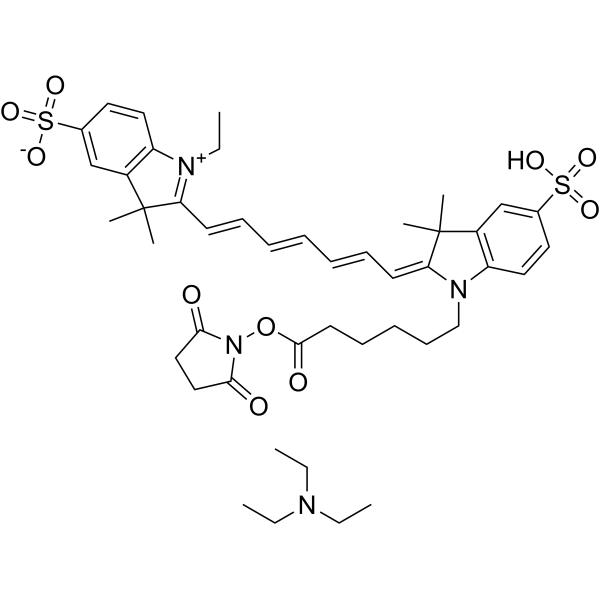
- HY-D0924
-
|
Sulfo-Cyanine5.5
|
|
|
|
Cy5.5 is a CY dye. CY, short for Cyanine, is a compound consisting of two nitrogen atoms connected by an odd number of methyl units. Cyanine compounds have the characteristics of long wavelength, adjustable absorption and emission, high extinction coefficient, good water solubility and relatively simple synthesis . CY dyes are of en used for the labeling of proteins, antibodies and small molecular compounds. For the labeling of protein antibodies, the combination can be completed through a simple mixing reaction. Below, we introduce the labeling method of protein antibody labeling, which has certain reference significance .
|
-
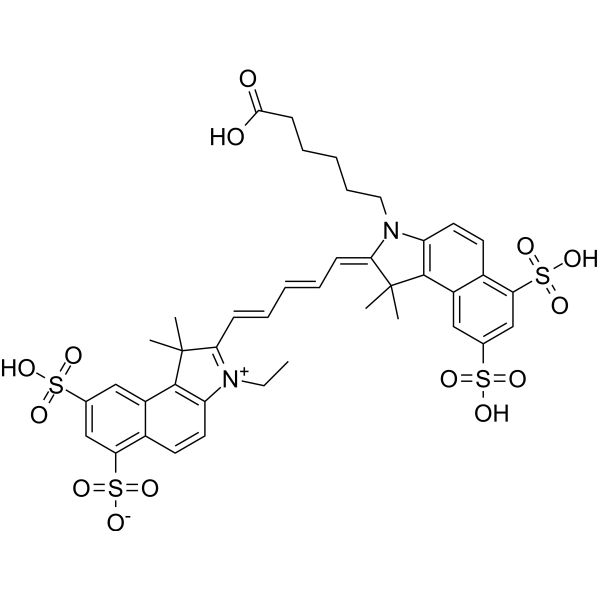
- HY-D1065
-
|
|
Fluorescent Dye
|
Inflammation/Immunology
|
|
NIR-H2O2 is a cell-permeable near-infrared (NIR) fluorescent turn-on sensor. NIR-H2O2 has both absorption and emission in the NIR region. NIR-H2O2 responds to H2O2 with a large turn-on NIR fluorescence signal upon excitation in the NIR region. NIR-H2O2 is capable of imaging endogenously produced H2O2 in living cells and mice .
|
-
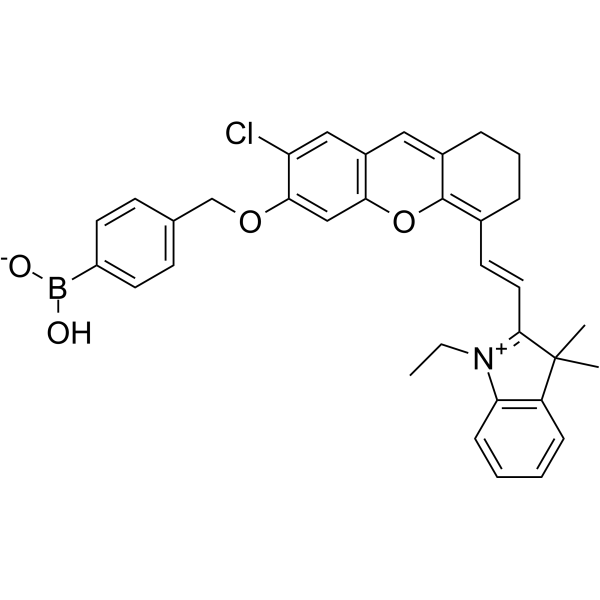
- HY-133536
-
|
PA-JF549-NHS
|
Fluorescent Dye
|
Others
|
|
PA Janelia Fluor 549, SE (PA-JF549-NHS) is a bright photoactivatable fluorophore of JF549,SE (JF549,NHS). JF549,SE (JF549,NHS) is a fluorescent dye with the absorption maximum (λab (max)) of 549 nm and emission maximum (λem (max)) of 571 nm . Janelia Fluor products are licensed under U.S. Pat. Nos. 9,933,417, 10,018,624 and 10,161,932 and other patents from Howard Hughes Medical Institute.
|
-
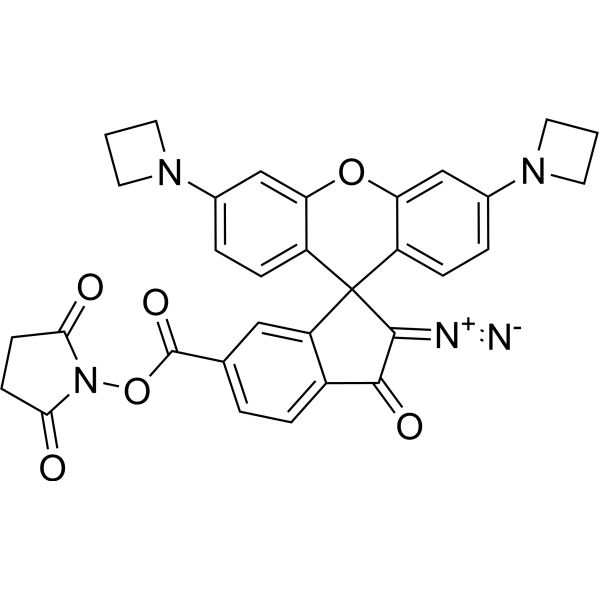
- HY-D0926
-
|
|
|
|
|
Cy7.5 is a CY dye. CY, short for Cyanine, is a compound consisting of two nitrogen atoms connected by an odd number of methyl units. Cyanine compounds have the characteristics of long wavelength, adjustable absorption and emission, high extinction coefficient, good water solubility and relatively simple synthesis . CY dyes are of en used for the labeling of proteins, antibodies and small molecular compounds. For the labeling of protein antibodies, the combination can be completed through a simple mixing reaction. Below, we introduce the labeling method of protein antibody labeling, which has certain reference significance .
|
-
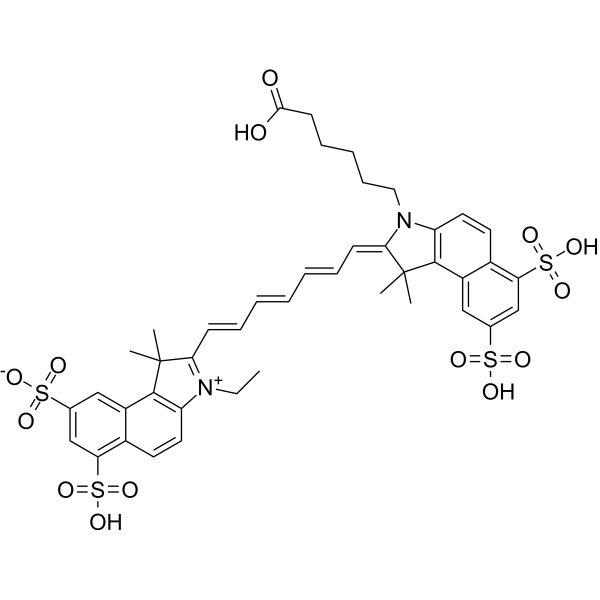
- HY-D1323
-
|
Cy5.5 maleimide chloride
|
Fluorescent Dye
|
Others
|
|
Cyanine5.5 maleimide chloride is a CY dye. CY, short for Cyanine, is a compound consisting of two nitrogen atoms connected by an odd number of methyl units. Cyanine compounds have the characteristics of long wavelength, adjustable absorption and emission, high extinction coefficient, good water solubility and relatively simple synthesis . CY dyes are of en used for the labeling of proteins, antibodies and small molecular compounds. For the labeling of protein antibodies, the combination can be completed through a simple mixing reaction. Below, we introduce the labeling method of protein antibody labeling, which has certain reference significance .
|
-

- HY-D1566
-
|
|
Fluorescent Dye
|
Others
|
|
Sulfo-Cy7.5 maleimide is a CY dye. CY, short for Cyanine, is a compound consisting of two nitrogen atoms connected by an odd number of methyl units. Cyanine compounds have the characteristics of long wavelength, adjustable absorption and emission, high extinction coefficient, good water solubility and relatively simple synthesis . CY dyes are of en used for the labeling of proteins, antibodies and small molecular compounds. For the labeling of protein antibodies, the combination can be completed through a simple mixing reaction. Below, we introduce the labeling method of protein antibody labeling, which has certain reference significance .
|
-
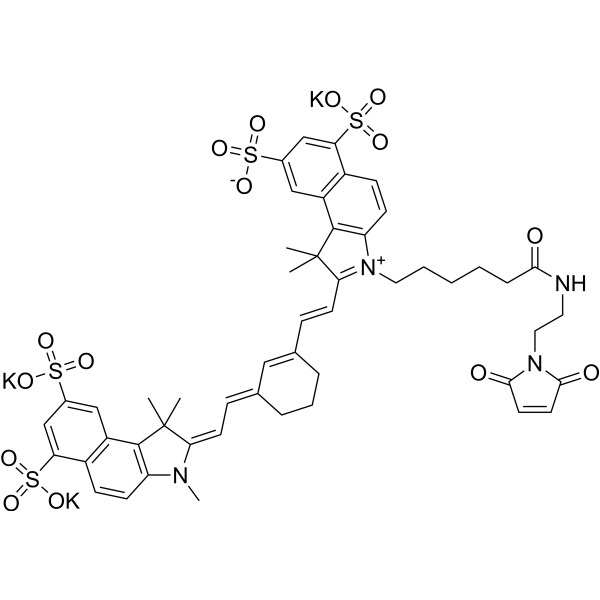
- HY-D1565
-
|
|
Fluorescent Dye
|
Others
|
|
Cy7.5 maleimide is a CY dye. CY, short for Cyanine, is a compound consisting of two nitrogen atoms connected by an odd number of methyl units. Cyanine compounds have the characteristics of long wavelength, adjustable absorption and emission, high extinction coefficient, good water solubility and relatively simple synthesis . CY dyes are of en used for the labeling of proteins, antibodies and small molecular compounds. For the labeling of protein antibodies, the combination can be completed through a simple mixing reaction. Below, we introduce the labeling method of protein antibody labeling, which has certain reference significance .
|
-
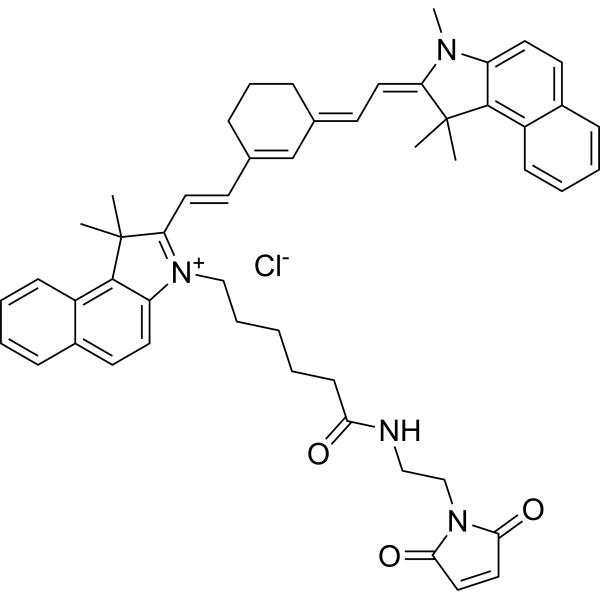
- HY-D0924B
-
|
Sulfo-Cyanine5.5 TEA
|
Fluorescent Dye
|
Cardiovascular Disease
Neurological Disease
Metabolic Disease
Inflammation/Immunology
Cancer
|
|
Cy5.5 TEA is a CY dye. CY, short for Cyanine, is a compound consisting of two nitrogen atoms connected by an odd number of methyl units. Cyanine compounds have the characteristics of long wavelength, adjustable absorption and emission, high extinction coefficient, good water solubility and relatively simple synthesis . CY dyes are of en used for the labeling of proteins, antibodies and small molecular compounds. For the labeling of protein antibodies, the combination can be completed through a simple mixing reaction. Below, we introduce the labeling method of protein antibody labeling, which has certain reference significance .
|
-

- HY-D0924A
-
|
Sulfo-Cyanine5.5 acetate
|
Fluorescent Dye
|
Cardiovascular Disease
Neurological Disease
Metabolic Disease
Inflammation/Immunology
Cancer
|
|
Cy5.5 acetate is a CY dye. CY, short for Cyanine, is a compound consisting of two nitrogen atoms connected by an odd number of methyl units. Cyanine compounds have the characteristics of long wavelength, adjustable absorption and emission, high extinction coefficient, good water solubility and relatively simple synthesis . CY dyes are of en used for the labeling of proteins, antibodies and small molecular compounds. For the labeling of protein antibodies, the combination can be completed through a simple mixing reaction. Below, we introduce the labeling method of protein antibody labeling, which has certain reference significance .
|
-

- HY-66019
-
|
Fluorescein 5-isothiocyanate
|
Fluorescent Dye
|
Others
|
|
FITC (Fluorescein Isothiocyanate), is one of the green fluorescein derivatives widely used in biology. FITC has the characteristics of high absorptivity, excellent fluorescence quantum yield and good water solubility. The isothiocyanate group of FITC can be combined with amino, sulfhydryl, imidazole, tyrosyl, carbonyl and other groups on the protein, so as to achieve protein labeling including antibodies and lectins. In addition to its use as a protein marker, FITC can also be used as a fluorescent protein tracer to rapidly identify pathogens by labeling antibodies, or for microsequencing of proteins and peptides (HPLC). The maximum excitation wavelength of FITC is 494 nm. Once excited, it fluoresces yellow-green at a maximum emission wavelength of 520 nm.
|
-
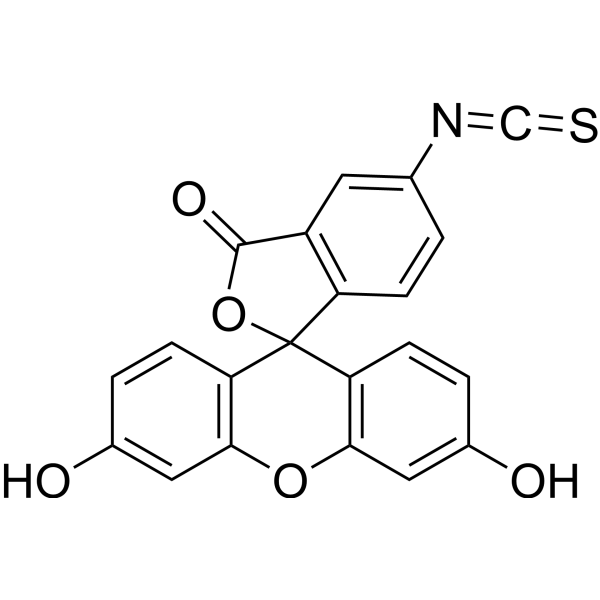
- HY-D1237
-
|
|
Fluorescent Dye
|
Metabolic Disease
|
|
BODIPY505/515 is a BODIPY dye. BODIPY dye is a small molecule dye with strong ultraviolet absorption ability, its fluorescence peak is relatively sharp, and the quantum yield is high. They are relatively insensitive to the polarity and pH of the environment and are relatively stable under different physiological conditions. Due to its structural asymmetry, BODIPY derives a variety of structural products. BODIPY lipid droplet dyes can well pass through the cell membrane into the cell, and localize the polar lipids in the cell to specifically stain the lipid droplets, which can be used for labeling of live cells and fixed cells . Maximum excitation/emission wavelength: 505/515 nm .
|
-
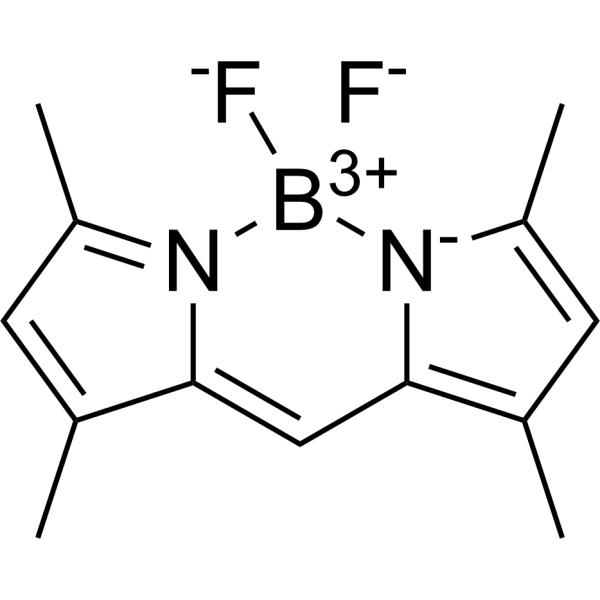
- HY-D1570
-
|
|
Fluorescent Dye
|
Others
|
|
BODIPYFL C12 is a BODIPY dye. BODIPY dye is a small molecule dye with strong ultraviolet absorption ability, its fluorescence peak is relatively sharp, and the quantum yield is high. They are relatively insensitive to the polarity and pH of the environment and are relatively stable under different physiological conditions. Due to its structural asymmetry, BODIPY derives a variety of structural products. BODIPY lipid droplet dyes can well pass through the cell membrane into the cell, and localize the polar lipids in the cell to specifically stain the lipid droplets, which can be used for labeling of live cells and fixed cells . Maximum excitation/emission wavelength: 480/508 nm .
|
-

- HY-W090090
-
|
Pyrromethene 546; BDP 493/503 lipid stain
|
Fluorescent Dye
|
Others
|
|
BODIPY493/503 is a BODIPY dye. BODIPY dye is a small molecule dye with strong ultraviolet absorption ability, its fluorescence peak is relatively sharp, and the quantum yield is high. They are relatively insensitive to the polarity and pH of the environment and are relatively stable under different physiological conditions. Due to its structural asymmetry, BODIPY derives a variety of structural products. BODIPY lipid droplet dyes can well pass through the cell membrane into the cell, and localize the polar lipids in the cell to specifically stain the lipid droplets, which can be used for labeling of live cells and fixed cells . Maximum excitation/emission wavelength: 493/503 nm .
|
-

- HY-138226
-
|
|
Fluorescent Dye
|
Others
|
|
BODIPY 558/568 C12 is a BODIPY dye. BODIPY dye is a small molecule dye with strong ultraviolet absorption ability, its fluorescence peak is relatively sharp, and the quantum yield is high. They are relatively insensitive to the polarity and pH of the environment and are relatively stable under different physiological conditions. Due to its structural asymmetry, BODIPY derives a variety of structural products. BODIPY lipid droplet dyes can well pass through the cell membrane into the cell, and localize the polar lipids in the cell to specifically stain the lipid droplets, which can be used for labeling of live cells and fixed cells . Maximum excitation/emission wavelength: 558/568 nm .
|
-

- HY-D1614
-
|
|
Fluorescent Dye
|
Others
|
|
BODIPY493/503 methyl bromide is a BODIPY dye. BODIPY dye is a small molecule dye with strong ultraviolet absorption ability, its fluorescence peak is relatively sharp, and the quantum yield is high. They are relatively insensitive to the polarity and pH of the environment and are relatively stable under different physiological conditions. Due to its structural asymmetry, BODIPY derives a variety of structural products. BODIPY lipid droplet dyes can well pass through the cell membrane into the cell, and localize the polar lipids in the cell to specifically stain the lipid droplets, which can be used for labeling of live cells and fixed cells . Maximum excitation/emission wavelength: 493/503 nm .
|
-

- HY-D0925
-
|
Cyanine5.5 NHS ester
|
|
|
|
Cy5.5-SE (Cyanine5.5 NHS ester) is a CY dye. CY, short for Cyanine, is a compound consisting of two nitrogen atoms connected by an odd number of methyl units. Cyanine compounds have the characteristics of long wavelength, adjustable absorption and emission, high extinction coefficient, good water solubility and relatively simple synthesis . CY dyes are of en used for the labeling of proteins, antibodies and small molecular compounds. For the labeling of protein antibodies, the combination can be completed through a simple mixing reaction. Below, we introduce the labeling method of protein antibody labeling, which has certain reference significance . Storage: protect from light.
|
-
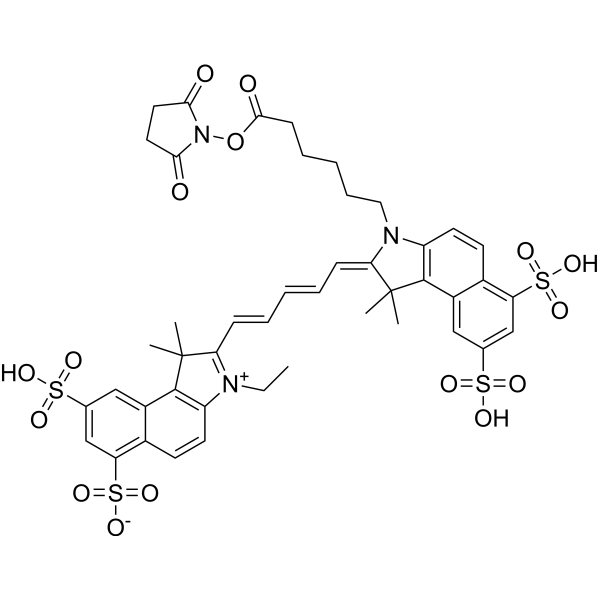
- HY-D0925A
-
|
Cyanine5.5 NHS ester (DIPEA)
|
DNA Stain
Fluorescent Dye
|
Others
|
|
Cy5.5-SE (Cyanine5.5 NHS ester) DIPEA is a CY dye. CY, short for Cyanine, is a compound consisting of two nitrogen atoms connected by an odd number of methyl units. Cyanine compounds have the characteristics of long wavelength, adjustable absorption and emission, high extinction coefficient, good water solubility and relatively simple synthesis . CY dyes are of en used for the labeling of proteins, antibodies and small molecular compounds. For the labeling of protein antibodies, the combination can be completed through a simple mixing reaction. Below, we introduce the labeling method of protein antibody labeling, which has certain reference significance . Storage: protect from light.
|
-
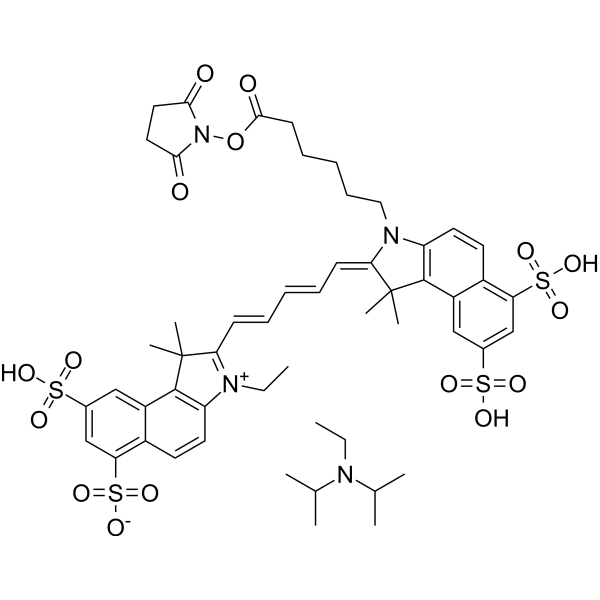
- HY-D1617
-
|
|
Fluorescent Dye
|
Others
|
|
BODIPY 500/510 C1, C12 is a BODIPY dye. BODIPY dye is a small molecule dye with strong ultraviolet absorption ability, its fluorescence peak is relatively sharp, and the quantum yield is high. They are relatively insensitive to the polarity and pH of the environment and are relatively stable under different physiological conditions. Due to its structural asymmetry, BODIPY derives a variety of structural products. BODIPY lipid droplet dyes can well pass through the cell membrane into the cell, and localize the polar lipids in the cell to specifically stain the lipid droplets, which can be used for labeling of live cells and fixed cells . Maximum excitation/emission wavelength: 500/510 nm . Protect from light, stored at -20℃.
|
-

- HY-W250148
-
|
Spirit nigrosine
|
Biochemical Assay Reagents
|
Others
|
|
Solvent black 5 (Spirit nigrosine) is a synthetic dye belonging to the family of azo dyes. Also known as oil black or naphthol black, it is dark blue-black and has excellent solubility in organic solvents. Solvent black 5 is commonly used as a colorant in various industrial applications such as printing inks, coatings and plastics. It can also be used as an indicator dye to detect the presence of metals in solution. Furthermore, due to its high absorption and emission properties in the near-infrared region, it has been used in scientific research as a fluorescent biomarker for tissues and cells. However, Solvent black 5 has been reported to have potentially toxic effects on human health and the environment and its use is therefore regulated in some countries.
|
-
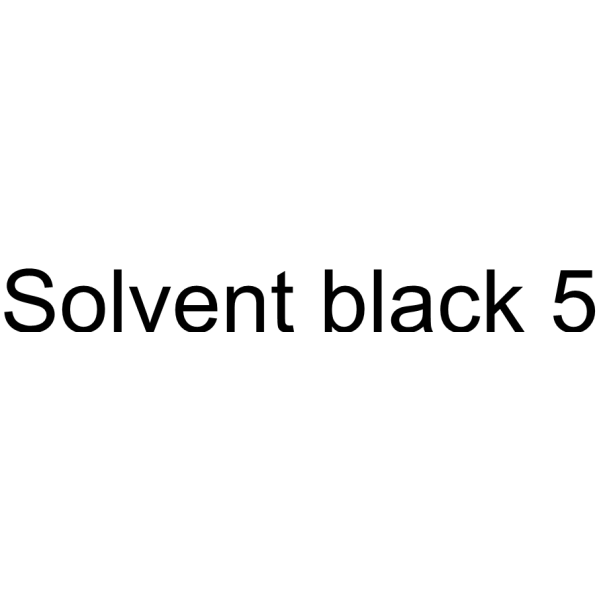
- HY-D0925B
-
|
Cyanine5.5 NHS ester TEA
|
Fluorescent Dye
|
Others
|
|
Cy5.5-SE TEA (Cyanine5.5 NHS ester TEA) is a CY dye. CY, short for Cyanine, is a compound consisting of two nitrogen atoms connected by an odd number of methyl units. Cyanine compounds have the characteristics of long wavelength, adjustable absorption and emission, high extinction coefficient, good water solubility and relatively simple synthesis . CY dyes are of en used for the labeling of proteins, antibodies and small molecular compounds. For the labeling of protein antibodies, the combination can be completed through a simple mixing reaction. Below, we introduce the labeling method of protein antibody labeling, which has certain reference significance . Storage: protect from light.
|
-

- HY-13488
-
|
|
LRRK2
MNK
|
Neurological Disease
|
|
HG-10-102-01 is a highly potent, selective, and brain-penetrable LRRK2 inhibitor, with IC50 values of 20.3 and 3.2 nM against wild-type LRRK2 and LRRK2[G2019S], respectively. HG-10-102-01 also inhibits MNK2 and MLK1, with IC50 values of 0.6 and 2.1 μM. HG-10-102-01 can be used for Parkinson's disease (PD) research .
|
-
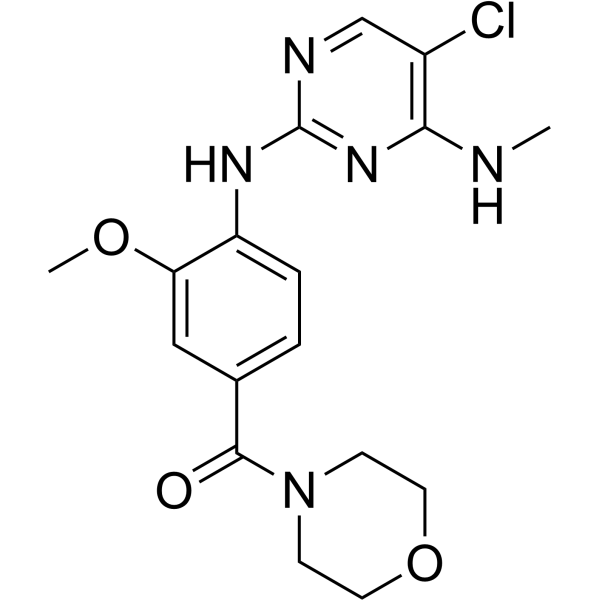
- HY-133535
-
|
PA-JF646-NHS
|
Fluorescent Dye
|
Others
|
|
PA Janelia Fluor® 646, SE (PA-JF646-NHS), a photoactivatable fluorescent dye, is an NHS ester for coupling to primary amine groups. PA-JF646-NHS is non-fluorescent until activated at 365 nm. NHS ester can be converted to relevant substrate for use in self-labeling tag systems, e.g.HaloTag ® and SNAP-tag ®. PA-JF646-NHS is used for single molecule tracking and super resolution microscopy in live cells, specifically live cell sptPALM and fixed cell PALM. (λExcitation/emission~650/664 nm). Janelia Fluor® products are licensed under U.S. Pat. Nos. 9,933,417, 10,018,624 and 10,161,932 and other patents from Howard Hughes Medical Institute.
|
-
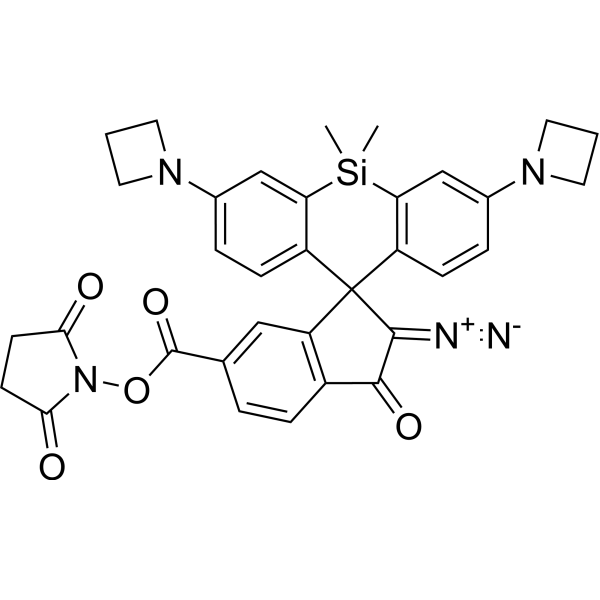
- HY-D0996
-
|
|
DNA Stain
|
Others
|
|
Lds-751 is a nucleic acid stain that mainly detects DNA. Lds-751 is a nucleic acid stain that mainly detects DNA. Lds-751 has a high affinity for DNA and fluorescence is enhanced after binding, but the maximum emission wavelength is 670nm. Lds-751 and Thiazole orange can be used for the differentiation of red blood cells, platelets, reticulocytes, and nucleated cells and can be stimulated at 488nm. Studies have shown that LDS-751 binds almost exclusively to mitochondria when incubated with nucleated living cells. After nucleated Acridine Orange (HY-101879) staining and LDS-751 treatment of cells, confocal microscopy revealed almost no co-location of the cells. Staining with Rhodamine 123 (HY-D0816), a dye known to bind polarized mitochondria, was almost identical to the pattern observed with LDS-751 .
|
-

- HY-131682
-
|
3-Hexanoyl-NBD-cholesterol
|
Others
Fluorescent Dye
|
Others
|
|
3-C6-NBD-cholesterol is a fluorescent analog of Chol that can be used to measure the kinetics of membrane and intracellular trafficking .
|
-
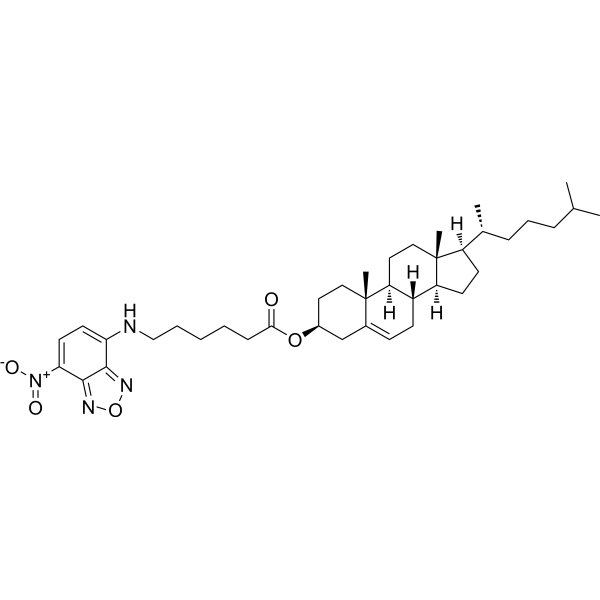
- HY-163034
-
|
|
Apoptosis
Reactive Oxygen Species
|
Cancer
|
|
Antitumor photosensitizer-5 (Ru2) is a photosensitizer which effectively target tumor mitochondria with an IC50 of 0.3 μM for phototoxicity to A549 cells. Under 460 nm light irradiation, antitumor photosensitizer-5 induces the generation of reactive oxygen species and NADH depletion, causes mitochondrial damage and activation of caspase-3, inducing apoptosis and suppressing cell migration. Antitumor photosensitizer-5 has the potential to prevent the growth of malignant tumors, therefore, shows the potential to be applied to photodynamic therapy .
|
-

| Cat. No. |
Product Name |
Type |
-
- HY-D1251
-
|
|
Fluorescent Dyes/Probes
|
|
TRFS-red, a red fluorescence emission off-on probe, is selective for thioredoxin reductase (TrxR). TRFS-red exhibits high response rate and sensitivity. TRFS-red can be used for imaging live cells .
|
-
- HY-D1456
-
|
|
Fluorescent Dyes/Probes
|
|
TEPC466 is a novel TEPP-46-based aggregation-induced emission (AIE) probe. TEPC466 shows a high degree of selectivity and sensitivity for the detection of PKM2 protein via the AIE effect. EPC466 can be used for the detection of PKM2. TEPC466 is successfully applied in imaging the PKM2 protein in colorectal cancer cells with low toxicity. TEPC466 is a useful tool for cancer diagnosis and research .
|
-
- HY-D1067
-
|
|
Fluorescent Dyes/Probes
|
|
NIR dye-1 (Compound 1h) is a near-infrared (NIR) fluorescent dye. NIR dye-1 has absorption and emission in the NIR region, while retaining an optically tunable hydroxyl group .
|
-
- HY-D1682
-
|
|
Fluorescent Dyes/Probes
|
|
NFQ1 is a non-fluorescent quencher (absorption wavelength: 474 nm), and is used for a new type of One Sample Fluorescence Resonance Energy Transfer (OS-FRET) method. OS-FRET enable measurement of unquenched donor emission in the same sample. NFQ1 shows broad absorption spectrum ensuring its utility as a dark acceptor for many donors .
|
-
- HY-120993
-
|
1,N6-Etheno-AMP sodium; 1,N6-ε-AMP sodium
|
Fluorescent Dyes/Probes
|
|
1,N6-Ethenoadenosine 5'-monophosphate (1,N6-Etheno-AMP) sodium is a highly fluorescent analog of adenosine 5'-monophosphate (AMP). 1,N6-Ethenoadenosine 5'-monophosphate sodium is a powerful probe for systems involving adenosine 5'-monophosphate and can be detected at low concentration. 1,N6-Ethenoadenosine 5'-monophosphate sodium has long wavelength of excitation (250-300 nm), and emission at 415 nm .
|
-
- HY-157036
-
|
|
Fluorescent Dyes/Probes
|
|
INSA is a a pH-sensitive fluorescent probe. INSA can simultaneously light up mitochondria (red emission) and lysosomes (green emission) for their internal pH differences .
|
-
- HY-133532
-
|
Ocean Blue, SE
|
Dyes
|
|
PB succiniMidyl ester (Ocean Blue, SE) is a fluorophore with the λexcitation/emission of ~405/455 nm .
|
-
- HY-D1662
-
|
BODIPY 558/568SE
|
Fluorescent Dyes/Probes
|
|
BDP 558/568 NHS ester is a borondipyrromethene fluorophore with emission in the yellow part of the spectrum. BDP 558/568 NHS ester is an amine reactive NHS ester, and the absorption and emission spectra of BDP 558/568 NHS ester are similar with TAMRA, BDP TMR, Cyanine3, and sulfo-Cyanine3 .
|
-
- HY-D1483
-
|
|
Fluorescent Dyes/Probes
|
|
3,3-Dibutylthiacarbocyanine iodide is a fluorescent dye with an excitation of 559 nm and an emission 604 nm .
|
-
- HY-D1922
-
|
|
Fluorescent Dyes/Probes
|
|
ATTO 390 streptavidin is a streptavidin derivative of ATTO 390 with excitation/emission maxima at 390/476 nm.
|
-
- HY-D1953
-
|
|
Fluorescent Dyes/Probes
|
|
ATTO 594 Azide is an azide derivative of ATTO 594 with excitation/emission maxima at 603/626 nm.
|
-
- HY-D1967
-
|
|
Fluorescent Dyes/Probes
|
|
ATTO 633 Azide is an azide derivative of ATTO 520 with excitation/emission maxima at 630/651 nm.
|
-
- HY-D1981
-
|
|
Fluorescent Dyes/Probes
|
|
ATTO 633 Iodacetamid is an iodoacetamide derivative of ATTO 594 with excitation/emission maxima at 630/651 nm.
|
-
- HY-D1984
-
|
|
Fluorescent Dyes/Probes
|
|
ATTO 633 Alkin is an alkyne derivative of ATTO 594 with excitation/emission maxima at 630/651 nm.
|
-
- HY-D1990
-
|
|
Fluorescent Dyes/Probes
|
|
ATTO 620 Azide is an azide derivative of ATTO 520 with excitation/emission maxima at 620/642 nm.
|
-
- HY-D2006
-
|
|
Fluorescent Dyes/Probes
|
|
ATTO 565 azide is an azide derivative of ATTO 565 with excitation/emission maxima at 564/590 nm.
|
-
- HY-D2013
-
|
|
Fluorescent Dyes/Probes
|
|
ATTO 488 hydrazid is a hydrazide derivative of ATTO 488 with excitation/emission maxima at 500/520 nm.
|
-
- HY-D2079
-
|
|
Fluorescent Dyes/Probes
|
|
ATTO 665 azide is an azide derivative of ATTO 665 with excitation/emission maxima at 663/680 nm.
|
-
- HY-D1919
-
|
|
Fluorescent Dyes/Probes
|
|
ATTO 390 amine is a biotin derivative of ATTO 390 with maximum excitation/emission wavelengths: 390/476 nm.
|
-
- HY-D1921
-
|
|
Fluorescent Dyes/Probes
|
|
ATTO 390 iodoacetamide is the iodoacetamide derivative of ATTO 390, the maximum excitation/emission wavelength: 390/476 nm.
|
-
- HY-D1926
-
|
|
Fluorescent Dyes/Probes
|
|
ATTO 425 Streptavidin is a streptavidin derivative of ATTO 425, the maximum excitation emission wavelength: 439/489 nm.
|
-
- HY-D1928
-
|
|
Fluorescent Dyes/Probes
|
|
ATTO 425 Amine is an amine derivative of ATTO 425, the maximum excitation emission wavelength: 439/489 nm.
|
-
- HY-D1934
-
|
|
Fluorescent Dyes/Probes
|
|
ATTO 465 is a new fluorescent dye with good photostability and maximum excitation/emission wavelength: 453/506 nm.
|
-
- HY-D1937
-
|
|
Fluorescent Dyes/Probes
|
|
ATTO 465 Streptavidin is a streptavidin derivative of ATTO 465, the maximum excitation/emission wavelength: 453/506 nm.
|
-
- HY-D1938
-
|
|
Fluorescent Dyes/Probes
|
|
ATTO 465 Biotin is a biotin derivative of ATTO 465 with maximum excitation/emission wavelengths: 453/506 nm.
|
-
- HY-D1942
-
|
|
Fluorescent Dyes/Probes
|
|
ATTO 590 Biotin is a biotin derivative of ATTO 590 with maximum excitation/emission wavelengths: 594/622 nm.
|
-
- HY-D1943
-
|
|
Fluorescent Dyes/Probes
|
|
ATTO 590 Amine is an amine derivative of ATTO 590, the maximum excitation/emission wavelength: 594/622 nm.
|
-
- HY-D1945
-
|
|
Fluorescent Dyes/Probes
|
|
ATTO 590 Iodacetamid is an iodoacetamide derivative of ATTO 590 with maximum excitation/emission wavelengths: 594/622 nm.
|
-
- HY-D1951
-
|
|
Fluorescent Dyes/Probes
|
|
ATTO 594 Biotin is a biotin derivative of ATTO 594 with maximum excitation/emission wavelengths: 603/626 nm.
|
-
- HY-D1952
-
|
|
Fluorescent Dyes/Probes
|
|
ATTO 594 Amine is an amine derivative of ATTO 594, the maximum excitation/emission wavelength: 603/626 nm.
|
-
- HY-D1956
-
|
|
Fluorescent Dyes/Probes
|
|
ATTO 594 Alkin is an alkyne derivative of ATTO 594 with maximum excitation/emission wavelengths: 603/626 nm.
|
-
- HY-D1964
-
|
|
Fluorescent Dyes/Probes
|
|
ATTO 633 Biotin is a biotin derivative of ATTO 633 with maximum excitation/emission wavelengths: 630/651 nm.
|
-
- HY-D1965
-
|
|
Fluorescent Dyes/Probes
|
|
ATTO 700 Biotin is a biotin derivative of ATTO 700 with maximum excitation/emission wavelengths: 700/716 nm.
|
-
- HY-D1972
-
|
|
Fluorescent Dyes/Probes
|
|
ATTO 610 Carboxy is a carboxyl derivative of ATTO 610 with maximum excitation/emission wavelengths: 616/633 nm.
|
-
- HY-D1975
-
|
|
Fluorescent Dyes/Probes
|
|
ATTO 725 Carboxy is a carboxyl derivative of ATTO 725, the maximum excitation/emission wavelength is: 728/751 nm.
|
-
- HY-D1978
-
|
|
Fluorescent Dyes/Probes
|
|
ATTO 610 Biotin is a biotin derivative of ATTO 610 with maximum excitation/emission wavelengths: 616/633 nm.
|
-
- HY-D1980
-
|
|
Fluorescent Dyes/Probes
|
|
ATTO 620 Carboxy is a carboxyl derivative of ATTO 620, the maximum excitation/emission wavelength is: 620/642 nm.
|
-
- HY-D1988
-
|
|
Fluorescent Dyes/Probes
|
|
ATTO 620 Biotin is a biotin derivative of ATTO 620 with maximum excitation/emission wavelengths: 620/642 nm.
|
-
- HY-D1989
-
|
|
Fluorescent Dyes/Probes
|
|
ATTO 725 Biotin is a biotin derivative of ATTO 725 with maximum excitation/emission wavelengths: 728/751 nm.
|
-
- HY-D1996
-
|
|
Fluorescent Dyes/Probes
|
|
ATTO 647 Biotin is a biotin derivative of ATTO 647 with maximum excitation/emission wavelengths: 630/651 nm.
|
-
- HY-D2003
-
|
|
Fluorescent Dyes/Probes
|
|
ATTO 565 biotin is a biotin derivative of ATTO 565 with maximum excitation/emission wavelengths: 564/590 nm.
|
-
- HY-D2007
-
|
|
Fluorescent Dyes/Probes
|
|
ATTO 488 biotin is a biotin derivative of ATTO 488 with maximum excitation/emission wavelengths: 500/520 nm.
|
-
- HY-D2005
-
|
|
Fluorescent Dyes/Probes
|
|
ATTO 565 amine is an amine derivative of ATTO 565, the maximum excitation/emission wavelength: 564/590 nm.
|
-
- HY-D2009
-
|
|
Fluorescent Dyes/Probes
|
|
ATTO 565 iodacetamid is an iodoacetamide derivative of ATTO 565 with maximum excitation/emission wavelengths: 564/590 nm.
|
-
- HY-D2045
-
|
|
Fluorescent Dyes/Probes
|
|
ATTO 532 carboxy is a carboxyl derivative of ATTO 532, the maximum excitation/emission wavelength is: 532/552 nm.
|
-
- HY-D2025
-
|
|
Fluorescent Dyes/Probes
|
|
ATTO 550 biotin is a biotin derivative of ATTO 550 with maximum excitation/emission wavelengths: 554/576 nm.
|
-
- HY-D2032
-
|
|
Fluorescent Dyes/Probes
|
|
ATTO 514 amine is an amine derivative of ATTO 514, the maximum excitation/emission wavelength: 511/531 nm.
|
-
- HY-D2053
-
|
|
Fluorescent Dyes/Probes
|
|
ATTO 532 hydrazid is a hydrazide derivative of ATTO 532 with maximum excitation/emission wavelengths: 532/552 nm.
|
-
- HY-D2011
-
|
|
Fluorescent Dyes/Probes
|
|
ATTO 565 hydrazid is a hydrazide derivative of ATTO 565 with maximum excitation/emission wavelengths: 564/590 nm.
|
-
- HY-D2057
-
|
|
Fluorescent Dyes/Probes
|
|
ATTO 700 carboxy is a carboxyl derivative of ATTO 700 with maximum excitation/emission wavelengths: 700/716 nm.
|
- HY-D2072
-
|
|
Fluorescent Dyes/Probes
|
|
ATTO 680 carboxy is a carboxyl derivative of ATTO 680, the maximum excitation/emission wavelength is: 681/698 nm.
|
- HY-D2076
-
|
|
Fluorescent Dyes/Probes
|
|
ATTO 740 biotin is a biotin derivative of ATTO 740 with maximum excitation/emission wavelengths: 743/763 nm.
|
- HY-D2078
-
|
|
Fluorescent Dyes/Probes
|
|
ATTO 665 amine is an amine derivative of ATTO 665, the maximum excitation/emission wavelength: 663/680 nm.
|
- HY-D2081
-
|
|
Fluorescent Dyes/Probes
|
|
ATTO 665 alkin is an alkyne derivative of ATTO 665 with maximum excitation/emission wavelengths: 663/680 nm.
|
- HY-D2008
-
|
|
Fluorescent Dyes/Probes
|
|
ATTO 488 amine is an amine derivative of ATTO 488, the maximum excitation/emission wavelength: 500/520 nm.
|
- HY-D2031
-
|
|
Fluorescent Dyes/Probes
|
|
ATTO 514 biotin is a biotin derivative of ATTO 514 with maximum excitation/emission wavelengths: 511/531 nm.
|
- HY-D2037
-
|
|
Fluorescent Dyes/Probes
|
|
ATTO 550 hydrazid is a hydrazide derivative of ATTO 550 with maximum excitation/emission wavelengths: 554/576 nm.
|
- HY-D2034
-
|
|
Fluorescent Dyes/Probes
|
|
ATTO 514 hydrazid is a hydrazide derivative of ATTO 514 with maximum excitation/emission wavelengths: 511/531 nm.
|
- HY-D2018
-
|
|
Fluorescent Dyes/Probes
|
|
ATTO 550 carboxy is a carboxyl derivative of ATTO 550 with maximum excitation/emission wavelengths: 554/576 nm.
|
- HY-D2069
-
|
|
Fluorescent Dyes/Probes
|
|
ATTO 680 alkin is an alkyne derivative of ATTO 680 with maximum excitation/emission wavelengths: 681/698 nm.
|
- HY-D2049
-
|
|
Fluorescent Dyes/Probes
|
|
ATTO 532 biotin is a biotin derivative of ATTO 532 with maximum excitation/emission wavelengths: 532/552 nm.
|
- HY-D2068
-
|
|
Fluorescent Dyes/Probes
|
|
ATTO 680 iodacetamid is an iodoacetamide derivative of ATTO 680 with maximum excitation/emission wavelengths: 681/698 nm.
|
- HY-D1911
-
|
|
Fluorescent Dyes/Probes
|
|
ATTO 665 Biotin is a biotin derivative of ATTO 665 with maximum excitation/emission wavelengths: 663/680 nm.
|
- HY-D2066
-
|
|
Fluorescent Dyes/Probes
|
|
ATTO 680 amine is an amine derivative of ATTO 680, the maximum excitation/emission wavelength: 681/698 nm.
|
- HY-D2036
-
|
|
Fluorescent Dyes/Probes
|
|
ATTO 550 iodacetamid is an iodoacetamide derivative of ATTO 550 with maximum excitation/emission wavelengths: 554/576 nm.
|
- HY-D2061
-
|
|
Fluorescent Dyes/Probes
|
|
ATTO 740 carboxy is a carboxyl derivative of ATTO 740, the maximum excitation/emission wavelength is: 743/763 nm.
|
- HY-D2050
-
|
|
Fluorescent Dyes/Probes
|
|
ATTO 532 amine is an amine derivative of ATTO 532, the maximum excitation/emission wavelength: 532/552 nm.
|
- HY-D2065
-
|
|
Fluorescent Dyes/Probes
|
|
ATTO 680 biotin is a biotin derivative of ATTO 680 with maximum excitation/emission wavelengths: 681/698 nm.
|
- HY-D2027
-
|
|
Fluorescent Dyes/Probes
|
|
ATTO 550 amine is an amine derivative of ATTO 550, the maximum excitation/emission wavelength: 554/576 nm.
|
- HY-D2080
-
|
|
Fluorescent Dyes/Probes
|
|
ATTO 665 iodacetamid is an iodoacetamide derivative of ATTO 665 with maximum excitation/emission wavelengths: 663/680 nm.
|
- HY-D1044
-
|
Rhodamine 640 chloride
|
Fluorescent Dyes/Probes
|
|
Rhodamine 101 chloride (Rhodamine 640 chloride) is a bright fluorescent dye with excitation and emission maxima of 565 and 595 nm, respectively .
|
- HY-D0069
-
|
|
Fluorescent Dyes/Probes
|
|
CPM is a maleimide derivative, acting as a blue fluorescent thiol-reactive dye. The excitation/emission maxima is 384/470 nm .
|
- HY-D2022
-
|
|
Fluorescent Dyes/Probes
|
|
ATTO 514 is a new type of hydrophilic fluorescent probe with strong stability and maximum excitation/emission wavelength: 511/531 nm.
|
- HY-126821A
-
|
|
Fluorescent Dyes/Probes
|
|
Fluo-3 pentaammonium is a fluorescence indicator of intracellular calcium (Ca 2+). Excitation/Emission = 488/525 nm .
|
- HY-D1923
-
|
|
Fluorescent Dyes/Probes
|
|
ATTO 390 biotin is a biotin derivative of ATTO 390, used for streptavidin reaction, maximum excitation/emission wavelength: 390/476 nm.
|
- HY-D1927
-
|
|
Fluorescent Dyes/Probes
|
|
ATTO 425 Biotin is a biotin derivative of ATTO 425, used for streptavidin reaction, the maximum excitation emission wavelength: 439/489 nm.
|
- HY-D2268
-
|
|
Fluorescent Dyes/Probes
|
|
QM-FN-SO3 is a BBB-penetrable near-infrared (NIR) aggregation-induced emission (AIE)-active probe for Aβ plaques. QM-FN-SO3 can be used for in vivo detection of Aβ plaques. QM-FN-SO3 has ultra-high S/N ratio, binding affinity, and high-performance NIR emission .
|
- HY-D0098
-
|
N-(5-Fluoresceinyl)maleimide
|
Fluorescent Dyes/Probes
|
|
Fluorescein-5-maleimide is a fluorescent thiol-reactive dye used to conjugate fluorescein to proteins (excitation: 494 nm, emission: 519 nm).
|
- HY-P2377
-
|
|
Dyes
|
|
Ac-YVAD-AFC is the the fluorometric peptide substrate of caspase-1, with λ excitation of 400 nm and λ emission of 505 nm .
|
- HY-D1941
-
|
|
Fluorescent Dyes/Probes
|
|
ATTO 590 Streptavidin is a streptavidin derivative of ATTO 590, it can label protein or antibody, the maximum excitation/emission wavelength: 594/622 nm.
|
- HY-D1947
-
|
|
Fluorescent Dyes/Probes
|
|
ATTO 700 Streptavidin is a streptavidin derivative of ATTO 700, it can label protein or antibody, the maximum excitation/emission wavelength: 700/716 nm.
|
- HY-D1949
-
|
|
Fluorescent Dyes/Probes
|
|
ATTO 594 Streptavidin is a streptavidin derivative of ATTO 594, it can label protein or antibody, the maximum excitation/emission wavelength: 603/626 nm.
|
- HY-D1962
-
|
|
Fluorescent Dyes/Probes
|
|
ATTO 633 Streptavidin is a streptavidin derivative of ATTO 633, it can label protein or antibody, the maximum excitation/emission wavelength: 630/651 nm.
|
- HY-D1963
-
|
|
Fluorescent Dyes/Probes
|
|
ATTO 565 Streptavidin is a streptavidin derivative of ATTO 565, it can label protein or antibody, the maximum excitation/emission wavelength: 564/590 nm.
|
- HY-D1977
-
|
|
Fluorescent Dyes/Probes
|
|
ATTO 610 Streptavidin is a streptavidin derivative of ATTO 610, it can label protein or antibody, the maximum excitation/emission wavelength: 616/633 nm.
|
- HY-D1985
-
|
|
Fluorescent Dyes/Probes
|
|
ATTO 725 Streptavidin is a streptavidin derivative of ATTO 725, it can label protein or antibody, the maximum excitation/emission wavelength: 728/751 nm.
|
- HY-D1987
-
|
|
Fluorescent Dyes/Probes
|
|
ATTO 620 Streptavidin is a streptavidin derivative of ATTO 620, it can label protein or antibody, the maximum excitation/emission wavelength: 620/642 nm.
|
- HY-D1995
-
|
|
Fluorescent Dyes/Probes
|
|
ATTO 647 Streptavidin is a streptavidin derivative of ATTO 647, it can label protein or antibody, the maximum excitation/emission wavelength: 630/651 nm.
|
- HY-D2075
-
|
|
Fluorescent Dyes/Probes
|
|
ATTO 740 streptavidin is a streptavidin derivative of ATTO 740, it can label protein or antibody, the maximum excitation/emission wavelength: 743/763 nm.
|
- HY-D2004
-
|
|
Fluorescent Dyes/Probes
|
|
ATTO 488 streptavidin is a streptavidin derivative of ATTO 488, it can label protein or antibody, the maximum excitation/emission wavelength: 500/520 nm.
|
- HY-D2048
-
|
|
Fluorescent Dyes/Probes
|
|
ATTO 532 streptavidin is a streptavidin derivative of ATTO 532, it can label protein or antibody, the maximum excitation/emission wavelength: 532/552 nm.
|
- HY-D2024
-
|
|
Fluorescent Dyes/Probes
|
|
ATTO 550 streptavidin is a streptavidin derivative of ATTO 550, it can label protein or antibody, the maximum excitation/emission wavelength: 554/576 nm.
|
- HY-D2030
-
|
|
Fluorescent Dyes/Probes
|
|
ATTO 514 streptavidin is a streptavidin derivative of ATTO 514, it can label protein or antibody, the maximum excitation/emission wavelength: 511/531 nm.
|
- HY-D2023
-
|
|
Fluorescent Dyes/Probes
|
|
ATTO 665 streptavidin is a streptavidin derivative of ATTO 665, it can label protein or antibody, the maximum excitation/emission wavelength: 663/680 nm.
|
- HY-D2064
-
|
|
Fluorescent Dyes/Probes
|
|
ATTO 680 streptavidin is a streptavidin derivative of ATTO 680, it can label protein or antibody, the maximum excitation/emission wavelength: 681/698 nm.
|
- HY-D0817
-
|
Rhodamine 110 chloride; RH110
|
Fluorescent Dyes/Probes
|
|
Rhodamine 110 is a sensitive and selective substrate for assaying proteinases in solution or inside living cells. The excitation wavelength is 498 nm and the emission wavelength is 521 nm .
|
- HY-101891
-
|
|
Fluorescent Dyes/Probes
|
|
Di-8-ANEPPS is a naphthylstyryl voltage-sensitive dye, shifting both their fluorescence excitation and emission spectra upon changes in Vm .
|
- HY-D1970
-
|
|
Fluorescent Dyes/Probes
|
|
ATTO 700 Cadaverin is a cadaverine derivative of ATTO 700 for reactions of carboxylic acids, aldehydes and ketones with maximum excitation/emission wavelengths: 700/716 nm.
|
- HY-D2055
-
|
|
Fluorescent Dyes/Probes
|
|
ATTO 532 cadaverin is a cadaverine derivative of ATTO 532, used for carboxylic acid, aldehyde and ketone reactions, maximum excitation/emission wavelength: 532/552 nm.
|
- HY-D2070
-
|
|
Fluorescent Dyes/Probes
|
|
ATTO 680 cadaverin is a cadaverine derivative of ATTO 680, used for carboxylic acid, aldehyde and ketone reactions, maximum excitation/emission wavelength: 681/698 nm.
|
- HY-D2039
-
|
|
Fluorescent Dyes/Probes
|
|
ATTO 550 cadaverin is a cadaverine derivative of ATTO 550, used for carboxylic acid, aldehyde and ketone reactions, maximum excitation/emission wavelength: 554/576 nm.
|
- HY-D2268A
-
|
|
Fluorescent Dyes/Probes
|
|
QM-FN-SO3 ammonium is a BBB-penetrable near-infrared (NIR) aggregation-induced emission (AIE)-active probe for Aβ plaques. QM-FN-SO3 ammonium can be used for in vivo detection of Aβ plaques. QM-FN-SO3 ammonium has ultra-high S/N ratio, binding affinity, and high-performance NIR emission .
|
- HY-D1918
-
|
|
Fluorescent Dyes/Probes
|
|
ATTO 390 maleimide is a maleimide ester derivative of ATTO 390, which can be used to label proteins or antibodies. The maximum excitation/emission wavelength: 390/476 nm.
|
- HY-D1925
-
|
|
Fluorescent Dyes/Probes
|
|
ATTO 425 Maleimide is a maleimide ester derivative of ATTO 425, which can be used to label proteins or antibodies. The maximum excitation emission wavelength: 439/489 nm.
|
- HY-D1936
-
|
|
Fluorescent Dyes/Probes
|
|
ATTO 465 Maleimid is a maleimide ester derivative of ATTO 465, which can be used to label proteins or antibodies. The maximum excitation/emission wavelength: 453/506 nm.
|
- HY-D1948
-
|
|
Fluorescent Dyes/Probes
|
|
ATTO 594 Maleimid is a maleimide ester derivative of ATTO 594, which can be used to label proteins or antibodies, with maximum excitation/emission wavelengths: 603/626 nm.
|
- HY-D1960
-
|
|
Fluorescent Dyes/Probes
|
|
ATTO 633 Maleimid is a maleimide ester derivative of ATTO 633, which can be used to label proteins or antibodies, with maximum excitation/emission wavelengths: 630/651 nm.
|
- HY-D1974
-
|
|
Fluorescent Dyes/Probes
|
|
ATTO 610 NHS-Ester is an activated ester derivative of ATTO 610, which can directly label proteins or antibodies. The maximum excitation/emission wavelength: 616/633 nm.
|
- HY-D1976
-
|
|
Fluorescent Dyes/Probes
|
|
ATTO 610 Maleimid is a maleimide ester derivative of ATTO 610, which can be used to label proteins or antibodies, with maximum excitation/emission wavelengths: 616/633 nm.
|
- HY-D1979
-
|
|
Fluorescent Dyes/Probes
|
|
ATTO 725 NHS-Ester is an activated ester derivative of ATTO 725, which can directly label proteins or antibodies. The maximum excitation/emission wavelength: 728/751 nm.
|
- HY-D1982
-
|
|
Fluorescent Dyes/Probes
|
|
ATTO 725 Maleimid is a maleimide ester derivative of ATTO 725, which can be used to label proteins or antibodies. The maximum excitation/emission wavelength: 728/751 nm.
|
- HY-D1983
-
|
|
Fluorescent Dyes/Probes
|
|
ATTO 620 NHS-Ester is an activated ester derivative of ATTO 620, which can directly label proteins or antibodies. The maximum excitation/emission wavelength: 620/642 nm.
|
- HY-D1986
-
|
|
Fluorescent Dyes/Probes
|
|
ATTO 620 Maleimid is a maleimide ester derivative of ATTO 620, which can be used to label proteins or antibodies, with maximum excitation/emission wavelengths: 620/642 nm.
|
- HY-D1994
-
|
|
Fluorescent Dyes/Probes
|
|
ATTO 647 Maleimid is a maleimide ester derivative of ATTO 647, which can be used to label proteins or antibodies, with maximum excitation/emission wavelengths: 630/651 nm.
|
- HY-D2020
-
|
|
Fluorescent Dyes/Probes
|
|
ATTO 665 maleimid is a maleimide ester derivative of ATTO 665, which can be used to label proteins or antibodies. The maximum excitation/emission wavelength: 663/680 nm.
|
- HY-D2028
-
|
|
Fluorescent Dyes/Probes
|
|
ATTO 514 maleimid is a maleimide ester derivative of ATTO 514, which can be used to label proteins or antibodies. The maximum excitation/emission wavelength: 511/531 nm.
|
- HY-D0022
-
|
5-AF
|
Fluorescent Dyes/Probes
|
|
5-Aminofluorescein (5-AF) is a fluorescence marker, covalently bound to human serum albumin. The excitation wavelength is 495 nm and the emission wavelength is 535 nm .
|
- HY-D1442
-
|
|
Fluorescent Dyes/Probes
|
|
SBFI (tetraammonium), the tetraammonium salt of SBFI, is a sodium fluorescence indicator. SBFI (tetraammonium) is sodium-sensitive dye. The excitation wavelength is set 333 nm, and the emission wavelength is 539 nm for SBFI .
|
- HY-D0053
-
|
6-Carboxy-X-rhodamine
|
Oligonucleotide Labeling
|
|
6-ROX, a fluorescent marker of oligonucleotides, acts as a receptor coupled to 5-FAM and as a donor in FRET imaging. Excitation wavelength: 568nm. Emission wavelength: 568nm.
|
- HY-D0981
-
|
Coumarin 151; AFC
|
Fluorescent Dyes/Probes
|
|
7-Amino-4-(trifluoromethyl)coumarin (Coumarin 151) is a fluorescent marker for the sensitive detection of proteinases. The excitation and emission wavelengths are 400 and 490 nm, respectively.
|
- HY-D1494
-
|
|
Fluorescent Dyes/Probes
|
|
FSB is a fluorescent dye that can be used to detect filamentous tau and to label human amyloid lesions with high sensitivity and specificity (excitation: 390 nm, emission: 520 nm) .
|
- HY-D1916
-
|
|
Fluorescent Dyes/Probes
|
|
ATTO 594 is a new type of fluorescent dye with high fluorescence yield, which can be used for most labeling applications, maximum excitation/emission wavelength: 603/626 nm.
|
- HY-D1931
-
|
|
Fluorescent Dyes/Probes
|
|
ATTO 590 is a new type of fluorescent dye with high fluorescence yield, which can be used for most labeling applications, maximum excitation/emission wavelength: 594/622 nm.
|
- HY-D1950
-
|
|
Fluorescent Dyes/Probes
|
|
ATTO 633 is a new type of fluorescent dye with high fluorescence yield, which can be used for most labeling applications, maximum excitation/emission wavelength: 630/651 nm.
|
- HY-D1958
-
|
|
Fluorescent Dyes/Probes
|
|
ATTO 565 is a new type of fluorescent dye with high fluorescence yield, which can be used for most labeling applications, maximum excitation/emission wavelength: 564/590 nm.
|
- HY-D1971
-
|
|
Fluorescent Dyes/Probes
|
|
ATTO 725 is a new type of fluorescent dye with high fluorescence yield, which can be used for most labeling applications, maximum excitation/emission wavelength: 728/751 nm.
|
- HY-D1991
-
|
|
Fluorescent Dyes/Probes
|
|
ATTO 647 is a new type of fluorescent dye with high fluorescence yield, which can be used for most labeling applications, maximum excitation/emission wavelength: 647/667 nm.
|
- HY-D1997
-
|
|
Fluorescent Dyes/Probes
|
|
ATTO 665 is a new type of fluorescent dye with high fluorescence yield, which can be used for most labeling applications, maximum excitation/emission wavelength: 663/680 nm.
|
- HY-D2000
-
|
|
Fluorescent Dyes/Probes
|
|
ATTO 488 is a new type of fluorescent dye with high fluorescence yield, which can be used for most labeling applications, maximum excitation/emission wavelength: 500/520 nm.
|
- HY-D2043
-
|
|
Fluorescent Dyes/Probes
|
|
ATTO 620 is a new type of fluorescent dye with high fluorescence yield, which can be used for most labeling applications, maximum excitation/emission wavelength: 620/642 nm.
|
- HY-D2071
-
|
|
Fluorescent Dyes/Probes
|
|
ATTO 680 is a new type of fluorescent dye with high fluorescence yield, which can be used for most labeling applications, maximum excitation/emission wavelength: 681/698 nm.
|
- HY-D2056
-
|
|
Fluorescent Dyes/Probes
|
|
ATTO 700 is a new type of fluorescent dye with high fluorescence yield, which can be used for most labeling applications, maximum excitation/emission wavelength: 700/716 nm.
|
- HY-D2060
-
|
|
Fluorescent Dyes/Probes
|
|
ATTO 740 is a new type of fluorescent dye with high fluorescence yield, which can be used for most labeling applications, maximum excitation/emission wavelength: 743/763 nm.
|
- HY-D2017
-
|
|
Fluorescent Dyes/Probes
|
|
ATTO 550 is a new type of fluorescent dye with high fluorescence yield, which can be used for most labeling applications, maximum excitation/emission wavelength: 554/576 nm.
|
- HY-D2044
-
|
|
Fluorescent Dyes/Probes
|
|
ATTO 532 is a new type of fluorescent dye with high fluorescence yield, which can be used for most labeling applications, maximum excitation/emission wavelength: 532/552 nm.
|
- HY-D2042
-
|
|
Fluorescent Dyes/Probes
|
|
ATTO 610 is a new type of fluorescent dye with high fluorescence yield, which can be used for most labeling applications, maximum excitation/emission wavelength: 616/633 nm.
|
- HY-D1385
-
|
|
Fluorescent Dyes/Probes
|
|
JF526–Pepstatin A TFA is a fluorescent dye that can be used for lysosomal staining in live cells. The excitation maximum is 530 nm and the emission maximum is 549 nm .
|
- HY-101882
-
BCECF
1 Publications Verification
2′,7′-Bis(2-carboxyethyl)-5(6)-carboxyfluorescein
|
Fluorescent Dyes/Probes
|
|
BCECF is a pH-sensitive fluorescent dye. BCECF allows measurements in the physiological pH range 6.0–8.0. Excitation ratio: 490/440 nm; Emission intensity: 535 nm.
|
- HY-D1151
-
|
|
Fluorescent Dyes/Probes
|
|
HKOH-1 is a highly sensitive green fluorescent probe for the specific detection of ·OH in living cells with a maximum excitation wavelength and emission wavelength of 500 nm and 520 nm, respectively .
|
- HY-D2195
-
|
|
Fluorescent Dyes/Probes
|
|
AgAuSe-PEG-NH2 (1000 nm) is a fluorescent quantum dot that emits fluorescence in the near-infrared II region, with an emission peak reaching 1000 nm that can be used in bioimaging.
|
- HY-D0941
-
|
|
Fluorescent Dyes/Probes
|
|
5-Carboxytetramethylrhodamine can be used as a fluorescent probe of nucleic acids and proteins. 5-Carboxytetramethylrhodamine displays excitation maxima of 558 nm and an emission maximum of 586 nm .
|
- HY-D0121
-
|
|
Fluorescent Dyes/Probes
|
|
INDO 1 is a fluorescent Ca 2+ indicator, binds specifically to Ca 2+ while emitting fluorescence, the maximum emission wavelength shifts from 485 nm before binding to 410 nm .
|
- HY-D2198
-
|
|
Fluorescent Dyes/Probes
|
|
AgAuSe-PEG-NH2 (1120 nm) is a fluorescent quantum dot that emits fluorescence in the near-infrared II region, with an emission peak reaching 1120 nm that can be used in bioimaging .
|
- HY-15942
-
|
|
Fluorescent Dyes/Probes
|
|
5-TAMRA (5-Carboxytetramethylrhodamine), SE and its conjugates yield bright, pH-insensitive orange-red fluorescence (approximate excitation/emission maxima ~546/579) with good photostability.
|
- HY-D1148
-
|
|
Fluorescent Dyes/Probes
|
|
HKGreen-4I is a highly sensitive green fluorescent probe for the specific detection of ONOO - in living cells with a maximum excitation wavelength and emission wavelength of 520 nm and 543 nm, respectively .
|
- HY-D1159
-
HKOH-1r
1 Publications Verification
|
Fluorescent Dyes/Probes
|
|
HKOH-1r is a highly sensitive green fluorescent probe for the specific detection of ·OH in living cells with a maximum excitation wavelength and emission wavelength of 500 nm and 520 nm, respectively .
|
- HY-133852
-
|
|
Fluorescent Dyes/Probes
|
|
FD-1080 is a fluorophore with both excitation and emission in the NIR-II region (Ex=1064 nm, Em=1080 nm). FD-1080 can be used for in vivo imaging .
|
- HY-D1497
-
|
|
Fluorescent Dyes/Probes
|
|
Fluorescent Red Mega 480 is a dye that is specifically designed for multicolor techniques. Fluorescent Red Mega 480 is characterized by an extremely large stoke′s shift between excitation and emission maxima .
|
- HY-D0121A
-
|
|
Fluorescent Dyes/Probes
|
|
INDO 1 pentapotassium is a fluorescent Ca 2+ indicator, binds specifically to Ca 2+ while emitting fluorescence, the maximum emission wavelength shifts from 485 nm before binding to 410 nm .
|
- HY-D1176
-
|
|
Fluorescent Dyes/Probes
|
|
Calcium Green 1AM is a cell-permeant fluorescent calcium indicator (Excitation 506 nm; Emission 531 nm). Calcium Green 1AM is converted to the fluorescent calcium indicator by intracellular esterases .
|
- HY-D1683
-
|
|
Fluorescent Dyes/Probes
|
|
NBD-PE is an effective lipid fluorescent probe (Excitation/Emission: 465/535 nm; Color: Green). NBD-PE offers a wide array of applications in membrane and cell biology .
|
- HY-121930
-
- HY-D0048
-
|
5-TAMRA-NHS ester; 5-Carboxytetramethylrhodamine succinimidyl ester
|
Fluorescent Dyes/Probes
|
|
5-TAMRA-SE is an amine-reactive fluorescent agent, its conjugates yield bright, pH-insensitive orange-red fluorescence (approximate excitation/emission maxima ~546/579) with good photostability.
|
- HY-130022
-
|
|
Fluorescent Dyes/Probes
|
|
HKPerox-1 is a highly sensitive green fluorescent probe for the specific detection of H2O2 in living cells with a maximum excitation wavelength and emission wavelength of 520 nm and 543 nm, respectively .
|
- HY-D1157
-
|
|
Fluorescent Dyes/Probes
|
|
HKPerox-2 is a highly sensitive green fluorescent probe for the specific detection of H2O2 in living cells with a maximum excitation wavelength and emission wavelength of 520 nm and 543 nm, respectively .
|
- HY-D1394
-
|
AgAuSe
|
Quantum Dots
|
|
AgAuSe QDs (AgAuSe) is a near infrared (NIR) fluorescent quantum dots (QDs), with a bright emission from 820 to 1170 nm. AgAuSe QDs can be used for the research in biomedical imaging and NIR devices .
|
- HY-137296
-
|
|
Fluorescent Dyes/Probes
|
|
Lumogallion is a highly sensitive fluorescent reagent for the detection of aluminum, gallium and other metals. Lumogallion has an excitation wavelength of 490 nm and an emission spectrum in the range of 520 nm to 650 nm, with a peak near 580 nm .
|
- HY-D1240
-
|
|
Dyes
|
|
Rhodamine 101 inner salt is a bright fluorescent dye with excitation and emission maxima at 565 and 595 nm, respectively. It can be used in various biological applications such as fluorescence microscopy, flow cytometry, fluorescence correlation spectroscopy, and ELISA.
|
- HY-111653
-
CycLuc1
1 Publications Verification
|
Chromogenic Substrates
|
|
CycLuc1 is a blood-brain barrier permeable luciferase substrate that displays near-infrared (NIR) emission with a peak luminescence wavelength of 599 nm. CycLuc1 can be used for in vivo bioluminescence imaging .
|
- HY-110210
-
|
BODIPY FL,SE
|
Fluorescent Dyes/Probes
|
|
BODIPY-FL NHS ester (BODIPY FL, SE) is an amine-reactive fluorescent probe. The maximum excitation/emission values are 502/511 nm. BODIPY-FL NHS ester can be used to synthesize protease substrates .
|
- HY-D1760
-
|
Sodium-binding benzofuran isophthalate
|
Fluorescent Dyes/Probes
|
|
SBFI is a membrane-permeant, fluorescent Na + indicator dye. SBFI is excited at 340 nm and the fluorophore emission is collected at 450 nm . SBFI selective for Na + over K + with Kd values of 20 and 120 mM for these ions, respectively. .
|
- HY-D1913
-
|
|
Fluorescent Dyes/Probes
|
|
FerroOrange is a fluorescent probe for the detection of unstable divalent iron ions, localized in the endoplasmic reticulum, which emits irreversible orange fluorescence upon encountering divalent iron ions. Excitation/emission wavelength: 542/572 nm.
|
- HY-110213
-
|
|
Fluorescent Dyes/Probes
|
|
BODIPY 630/650X is a fluorescent conjugate of the adenosine receptor ligand N-ethylcarboxamido-adenosine (NECA). BODIPY 630/650X displays excitation/emission maxima of 630/650 nm, respectively .
|
- HY-D1082
-
|
|
Fluorescent Dyes/Probes
|
|
5-DTAF is a isomeric fluorescein derivative that directly react with polysaccharides and other alcohols in aqueous solution at pH > 9. The maximum of the 5-DTAF emission profile is at a wavelength of 518 nm after excitation at 488 nm .
|
- HY-W039519
-
|
|
Fluorescent Dyes/Probes
|
|
7-Methoxycoumarin-3-carboxylic acid is a fluorescent dye with an excitation peak at 355 nm and an emission peak at 405 nm. 7-Methoxycoumarin-3-carboxylic acid can be used to label peptide .
|
- HY-D1627
-
|
CM-DiI
|
Fluorescent Dyes/Probes
|
|
CellTracker CM-DiI (CM-DiI) is a lipophilic fluorochrome that can be used for tracking the migration of lymphocytes. CellTracker CM-DiI is feasible to detect labeled cells in histological sections (excitation 553 nm; emission 570 nm) .
|
- HY-129547
-
|
|
Fluorescent Dyes/Probes
|
|
Fluo-3 pentapotassium is a fluorescent indicator for intracellular Ca 2+ that is used in flow cytometry and cell-based experiments. Fluo-3 pentapotassium produces fluorescence with an emission maximum at 525 nm upon binding to calcium.
|
- HY-D0079
-
|
Hydroethidine; PD-MY 003
|
Fluorescent Dyes/Probes
|
|
Dihydroethidium, also known as DHE, is a peroxide indicator. Dihydroethidium penetrates cell membranes to form a fluorescent protein complex with blue fluoresces. After entering the cells, Dihydroethidium is mainly localized in the cell membrane, cytoplasm and nucleus, and the staining effect is the strongest in the nucleus. Dihydroethidium produces inherent blue fluorescence with a maximum excitation wavelength of 370 nm and a maximum emission wavelength of 420 nm; after dehydrogenation, Dihydroethidium combines with RNA or DNA to produce red fluorescence with a maximum excitation wavelength of 300 nm and a maximum emission wavelength of 610 nm. 535 nm can also be used as the excitation wavelength for actual observation .
|
- HY-123645
-
|
|
Fluorescent Dyes/Probes
|
|
Rhodamine B hydrazide is a good probe for sulfite, with colorless and non-fluorescent properties. While the emission is related to the concentration of sulfite (5-800 ng/mL; detection limit=1.4 ng/mL (3σ)). Sulfite reduces dissolved oxygen to yield superoxide radicals, which binds to Rhodamine B hydrazide to form Rhodamine B. Rhodamine B hydrazide gives Rhodamine B-like fluorescence in the presence of sulfite, which is enhanced by Tween 80 surfactant micelles. Rhodamine B hydrazide has an absorption maximum at 554 nm and a fluorescence emission maximum at 574 nm .
|
- HY-125746
-
|
|
Fluorescent Dyes/Probes
|
|
BODIPY-cholesterol is an intrinsically lipophilic, and cell-permeable analog of cholesterol with a fluorescent BODIPY group. BODIPY-cholesterol can be used to monitor sterol uptake and inter-organelle sterol flux in cells. (Excitation/Emission: 480/508 nm) .
|
- HY-D1665
-
|
|
Fluorescent Dyes/Probes
|
|
BDP 558/568 amine is an amine derivative of BDP 558/568. BDP 558/568 is a borondipyrromethene dye with yellow/orange emission. BDP 558/568 amine can be conjugated by means of reactions with various electrophiles .
|
- HY-D1563
-
|
|
Dyes
|
|
CypHer 5 is a pH-sensitive cyanine derivative and a environmental sensitive fluorophore. CypHer 5 has a pH-sensitive maximal absorption at 644 nm and emission at 664 nm. CypHer 5 has been used as a pH sensor of lysosomal compartments .
|
- HY-D1691
-
|
|
Fluorescent Dyes/Probes
|
|
BODIPY-581/591 NHS ester is a bright, red fluorescent dye (excitation: 581 nm; emission: 591 nm). BODIPY-581/591 NHS ester shows unique hydrophobic properties for staining lipids, membranes, and other lipophilic compounds .
|
- HY-D2178
-
|
|
Fluorescent Dyes/Probes
|
|
AF 568 NHS ester is a derivative of the orange fluorescent dye AF 568. AF 568 has a maximum emission wavelength of ~568 nm. AF 568 NHS ester is widely used in cell dyes, biological dyes, biomolecules and particle fluorescent labeling.
|
- HY-D2176
-
|
|
Fluorescent Dyes/Probes
|
|
AF 555 carboxylic acid is a derivative of the orange fluorescent dye AF 555. AF 555 has a maximum emission wavelength of ~555 nm. AF 555 carboxylic acid is widely used in cell dyes, biological dyes, biomolecules and particle fluorescent labeling.
|
- HY-D1630
-
|
|
Fluorescent Dyes/Probes
|
|
4-Di-10-ASP is a fluorescent lipophilic tracer (Excitation 485 nm; Emission 620 nm). 4-Di-10-ASP can be used to stain phospholipid membranes in a specific manner .
|
- HY-D2255
-
|
|
Fluorescent Dyes/Probes
|
|
BDP FL ceramide, a highly fluorescent lipid, is a conjugate of green-emitting BDP FL fluorophore with sphingosine. BDP FL ceramide can be used for the visualization of the Golgi apparatus via fluorescence microscopy.The excitation wavelength is 503 nm and the emission wavelength is 509 nm .
|
- HY-163286
-
|
|
Dyes
|
|
BODIQPy-TPA is a lipophilic probes, which induces ferroptosis in B16 and HepG2 cells upon light irradiation through lipid peroxidation. BODIQPy-TPA reveals a maximum absorption wavelength of 488 nm and a maximum emission wavelength above 640 nm .
|
- HY-101878
-
|
Sulforhodamine 101; SR101
|
Fluorescent Dyes/Probes
|
|
Texas Red (Sulforhodamine 101) is an amphoteric rhodamine red fluorescent dye (excitation/emission: 586/605 nm). Texas Red is used extensively for investigating neuronal morphology and acts as acell type-selective fluorescent marker of astrocytes bothin vivoand in slice preparations .
|
- HY-D1264
-
|
Zn-green
|
Fluorescent Dyes/Probes
|
|
PMQA (Zn-green), an 8-aminoquinoline-based ratiometric fluorescent sensor, demonstrates the Zn 2+-induced redshift of emission (85 nm). PMQA (Zn-green) is a cell membrane-permeable probe and suitable for imaging Zn 2+ in living cells .
|
- HY-D1504
-
|
|
Dyes
|
|
IR-797 chloride is a near-infrared (NIR) dye. IR 797 has absorption maxima near 700 nm. IR-797 shows some aggregation-induced-emission (AIE) properties. IR-797 shows shows cytotoxic .
|
- HY-D1877
-
|
|
Fluorescent Dyes/Probes
|
|
ZY-1 is a control molecule of ZY-2 (HY-D1876, a PKM2 fluorescent probe). ZY-1 shows a low fluorescence emission in HeLa, a cervical cancer cell abundant in PKM2 expression .
|
- HY-D1063
-
|
|
Fluorescent Dyes/Probes
|
|
IR780 is a prototypic NIR heptamethine cyanine agent, with a high molar extinction coefficient. The maximum excitation wavelength of IR780 was 777-780 nm, and the maximum emission wavelength was 798-823 nm. IR780 can be used in cancer PTT/PDT and imaging .
|
- HY-D2267
-
|
|
Fluorescent Dyes/Probes
|
|
JF646-Hoechst is a fluorescent red DNA probe that is an ideal substitute for large oligonucleotide-coupled antibodies used in PAINT experiments, especially for bacterial studies. JF646-Hoechst excitation/emission maximum =655/670 nm .
|
- HY-D2166
-
|
|
Fluorescent Dyes/Probes
|
|
AF 594 NHS ester is a derivative of the red fluorescent dye AF 594 with high fluorescence quantum yield and high photostability (maximum absorption wavelength of 586 nm, maximum emission wavelength of 613 nm). AF 594 NHS ester can form an ester bond by reacting the NHS group with ammonia.
|
- HY-163287
-
|
|
Dyes
|
|
QPy-TPA is a lipopjilc probes, which induces non-ferroptotic cell death and lipid dynamic regularion in B16 and HepG2 cells upon light irradiation. QPy-TPA reveals a maximum absorption wavelength of 400 nm and a maximum emission wavelength of 590 nm .
|
- HY-D1085
-
|
|
Fluorescent Dyes/Probes
|
|
AMCA-X-SE is a coumarin derivative that generates fixed blue fluorescence and an NHS-activated ester that forms stable amide bonds with primary amine groups. It is used as a reactive dye for labeling amino groups of peptides, proteins, and oligonucleotides. Maximum excitation/emission wavelength: 354/442 nm .
|
- HY-D1924
-
|
|
Fluorescent Dyes/Probes
|
|
ATTO 390 alkyne is an alkyne derivative of ATTO 390 with maximum excitation/emission wavelengths: 390/476 nm. ATTO 390 alkyne is a click chemistry reagent, it contains an Alkyne group and can undergo copper-catalyzed azide-alkyne cycloaddition (CuAAc) with molecules containing Azide groups.
|
- HY-D1969
-
|
|
Fluorescent Dyes/Probes
|
|
ATTO 700 Alkin is an alkyne derivative of ATTO 700 with maximum excitation/emission wavelengths: 700/716 nm. ATTO 700 Alkin is a click chemistry reagent, it contains an Alkyne group and can undergo copper-catalyzed azide-alkyne cycloaddition (CuAAc) with molecules containing Azide groups.
|
- HY-D2054
-
|
|
Fluorescent Dyes/Probes
|
|
ATTO 532 alkin is an alkyne derivative of ATTO 532 with maximum excitation/emission wavelengths: 532/552 nm. ATTO 532 alkin is a click chemistry reagent, it contains an Alkyne group and can undergo copper-catalyzed azide-alkyne cycloaddition (CuAAc) with molecules containing Azide groups.
|
- HY-D1066
-
|
|
Fluorescent Dyes/Probes
|
|
NIR-Thiol dinitrobenzenesulfonate has both absorption and emission in the NIR region. NIR-Thiol dinitrobenzenesulfonate responds to thiol with a large turn-on NIR fluorescence signal upon excitation in the NIR region. NIR-Thiol dinitrobenzenesulfonate is capable of imaging endogenously produced thiol in living cells and mice .
|
- HY-135056
-
|
|
Fluorescent Dyes/Probes
|
|
Mito-Tracker Green is a green fluorescent dye that selectively accumulates in the mitochondrial matrix. MitoTracker Green FM covalently binds mitochondrial proteins by reacting with free mercaptan of cysteine residues, allowing staining of mitochondrial membrane potential independent of membrane potential. Excitation/emission wavelength 490/523 nm.
|
- HY-118159
-
|
DPPP
|
Fluorescent Dyes/Probes
|
|
Diphenyl-1-pyrenylphosphine (DPPP) is a fluoregenic peroxide reactive probe. Diphenyl-1-pyrenylphosphine exhibits a unique phototriggered aggregation-induced emission (AIE)/aggregation-induced quenching (ACQ) transition with a remarkable third-order nonlinear optical signal change .
|
- HY-D1169
-
|
|
Fluorescent Dyes/Probes
|
|
BDP R6G carboxylic acid is a borondipyrromethene dye (Excitation: 530 nM; Emission: 548 nM). BDP R6G carboxylic acid terminal carboxylic acid can react with primary amine groups in the presence of activators to form a stable amide bond, for subsequent labeling reactions like Steglich esterification .
|
- HY-D2150
-
|
|
Fluorescent Dyes/Probes
|
|
AF 430 maleimide is a derivative of the yellow fluorescent dye AF 430. AF430 has an excitation wavelength of 430 nm and an emission wavelength of 542 nm. AF 430 maleimide contains maleimide groups that react with thiol groups to form covalent bonds. To achieve specific coupling of dye labels and biomolecules.
|
- HY-D1300
-
|
LysoTracker Red DND-99
|
Dyes
|
|
LysoTracker Red is a Red fluorescently labeled lysosomal probe with a maximum excitation/emission wavelength of 577/590 nm. The structure is composed of a fluorescein group and linked weak bases, which can freely cross the cell membrane and gather on spherical organelles. It is suitable for observing the internal biosynthesis and related pathogenesis of lysosomes .
|
- HY-D0159
-
|
|
Fluorescent Dyes/Probes
|
|
ZnAF-1F is a potent fluorophore for with an Kd value of 2.2 nM. ZnAF-1F can be used as fluorescent probes for Zn 2+ in cells. ZnAF-1F shows λ excitation of 489 nm and λ emission of 514 nm .
|
- HY-151756
-
|
|
Fluorescent Dyes/Probes
|
|
diSulfo-Cy3 alkyne is a water-soluble dye and a Click Chemistry reagent containing an alkyne group. Absorbance and emission of the dye are identical to Cy3 fluorophore. diSulfo-Cy3 alkyne can be used for the labeling of proteins, and even intact biological objects in water phase .
|
- HY-D0110A
-
|
|
Fluorescent Dyes/Probes
|
|
Fura-2 pentapotassium is a scaled fluorescent dye that can be used for intracellular calcium imaging with the Kd value of 140 nM. Fura-2 pentapotassium has an emission wavelength of 510 nm and excitation wavelengths of 340 nm or 380 nm and the ratio of 340/380 fluorescence intensity is proportional to the intracellular Ca 2+ level .
|
- HY-149117
-
|
|
Fluorescent Dyes/Probes
|
|
AF430 NHS ester is an AF 430 maleimide is a derivative of the yellow fluorescent dye AF 430. AF430 has an excitation wavelength of 430 nm and an emission wavelength of 542 nm. AF430 NHS ester can be uesd for the labeling of amino-groups in peptides, proteins, and oligonucleotides. To achieve specific coupling of dye labels and biomolecules.
|
- HY-D1299
-
|
CF3-substituted Tetramethyl BODIPY
|
Fluorescent Dyes/Probes
|
|
meso-CF3-BODIPY 2 (CF3-substituted Tetramethyl BODIPY) is a fluorescent dye with the absorption wavelength (λabs) of 553 nm and emission wavelength (λem) of 622 nm. meso-CF3-BODIPY 2 can be used in labeling reagents and photodynamic therapy .
|
- HY-120959
-
|
|
Fluorescent Dyes/Probes
|
|
DAUDA (11-(dansylamino) undecanoic acid) is an environment-sensitive fluorescent fatty acid analogue. DAUDA alters its intensities and fluorescent emission spectra on entry into binding proteins. DAUDA is used to determine the relative affinity of natural fatty acids for polymorphs of the Schistosoma mansoni Sm14 fatty acid-binding protein[1].
|
- HY-D1600
-
|
|
Dyes
|
|
Sulfo-Cyanine5.5 maleimide potassium is a fluorescent dye. Sulfo-Cyanine5.5 is a nearinfrared (NIR) fluorophore with excitation maximum 675 nm and emission maximum 694 nm. Sulfo-Cyanine5.5 maleimide potassium can be used for the labeling of sensitive proteins, nanoparticles, and highly hydrophylic biopolymers .
|
- HY-D2160
-
|
|
Fluorescent Dyes/Probes
|
|
AF 647 carboxylic acid is a derivative of the far-infrared dye AF 647. AF 647 is often used as a replacement for Cy5 dye. The maximum excitation wavelength is 648 nm and the maximum emission wavelength is 671 nm. AF 647 carboxylic acid has a carboxylic acid group and can be coupled to biomolecules with amino groups to achieve dye labeling.
|
- HY-D2279
-
|
|
Fluorescent Dyes/Probes
|
|
NFL-NH2 is a mitochondrial-targeted near-infrared ratiometric fluorescent probe. NFL-NH2 can rapidly detect NO levels associated with the inflammatory damage degree in rheumatoid arthritis (RA) mice models by ratiometric fluorescence imaging. The excitation wavelength and emission wavelength are 650 nm and 780 nm, respectively .
|
- HY-P1003
-
|
|
Chromogenic Substrates
|
|
Ac-DEVD-AMC is a fluorescent substrate of caspase-3/caspase-7. When treating Ac-DEVD-AMC with cell lysate, Ac-DEVD-AMC releases amino-4-methylcoumarin (AMC) for fluorescence detection, with an excitation wavelength of 380 nm and an emission wavelength of 460 nm .
|
- HY-133876
-
|
DiA
|
Fluorescent Dyes/Probes
|
|
4-Di-16-ASP is a green fluorescent membrane dye. 4-Di-16-ASP is a lipophilic aminostyryl probe with a broad emission spectrum (can be detected with green, orange or even red filters). It is commonly used for neuronal membrane tracing (it diffuses faster than DiO) .
|
- HY-P2628
-
|
|
Fluorescent Dyes/Probes
|
|
Dabcyl-YVADAPV-EDANS is a fluorogenic interleukin-1β converting enzyme (ICE) substrate for measuring ICE-like protease activity. Dabcyl-YVADAPV-EDANS detects fluorescence at 360 nm excitation and 480 nm emission wavelengths. ICE-like protease is a critical mediator of K + deprivation-induced apoptosis of cerebellar granule neurons .
|
- HY-D1739
-
|
|
Fluorescent Dyes/Probes
|
|
DDAO phosphate diammonium is a fluorescent phosphatase substrate. DDAO phosphate diammonium has tunable excitation wavelength (600-650nm) and long emission wavelength (λem=656nm). DDAO phosphate diammonium can be used to detect the activity of different enzymes such as β-galactosidase, sulfatase, protein phosphatase 2A, carboxylesterase 2, human albumin and esterase.
|
- HY-D2163
-
|
|
Fluorescent Dyes/Probes
|
|
AF 430 amine is a derivative of the yellow fluorescent dye AF 430. AF430 has an excitation wavelength of 430 nm and an emission wavelength of 542 nm. AF 430 amine can form covalent bonds through a condensation reaction between amino groups and molecules containing carboxyl groups. To achieve specific coupling of dye labels and biomolecules.
|
- HY-D2154
-
|
|
Fluorescent Dyes/Probes
|
|
AF 430 carboxylic acid is a derivative of the yellow fluorescent dye AF 430. AF430 has an excitation wavelength of 430 nm and an emission wavelength of 542 nm. AF 430 carboxylic acid can form covalent bonds through a condensation reaction between carboxylic acid groups and molecules containing amino groups. To achieve specific coupling of dye labels and biomolecules.
|
- HY-D2167
-
|
|
Fluorescent Dyes/Probes
|
|
AF 568 alkyne is a derivative of the orange fluorescent dye AF 568. AF 568 has a maximum emission wavelength of ~568 nm. AF 568 alkyne can undergo copper-catalyzed azide-alkyne cycloaddition (CuAAc) via the Alkyne group and molecules containing Azide groups. To achieve specific coupling of dye labels and biomolecules.
|
- HY-D2161
-
|
|
Fluorescent Dyes/Probes
|
|
AF 594 azide is an azide derivative of the red fluorescent dye AF 594, which has high fluorescence quantum yield and high photostability (maximum absorption wavelength of 586 nm, maximum emission wavelength of 613 nm). AF 594 azide forms stable adducts by reaction of the azide group with alkynyl derivatives (terminal alkynes and cyclooctyne).
|
- HY-D2162
-
|
|
Fluorescent Dyes/Probes
|
|
AF 594 carboxylic acid is a carboxyl derivative of the red fluorescent dye AF 594, which has high fluorescence quantum yield and high photostability (maximum absorption wavelength of 586 nm, maximum emission wavelength of 613 nm). AF 594 carboxylic acid can form stable covalent bonds through the reaction of carboxylic acid groups with molecules with amino groups.
|
- HY-131010
-
|
|
Dyes
|
|
Flutax-2 (5/6-mixture) is an active fluorescent derivative of paclitaxel. Flutax-2 (5/6-mixture) binds to a polymerized α,β tubulin dimer. Excitation/emission wavelength: 496/524 nm. Paclitaxel, a diterpenoid secondary metabolite produced by Taxus species, can be used for the research of a variety of cancers .
|
- HY-W247131
-
|
|
Fluorescent Dyes/Probes
|
|
DASPEI is a cationic styrenyl mitochondrial dye with large Stokes shift. DASPEI has excitation and emission wavelength at 550/573 nm, which has good light chromogenic property. DASPEI can stain mitochondria in living cells with good labeling property. And DASPEI can also be used to stain presynaptic nerve endings independently of neuronal activity .
|
- HY-D2164
-
|
|
Fluorescent Dyes/Probes
|
|
AF 430 alkyne is a derivative of the yellow fluorescent dye AF 430. AF430 has an excitation wavelength of 430 nm and an emission wavelength of 542 nm. AF 430 alkyne can undergo copper-catalyzed azide-alkyne cycloaddition (CuAAc) via Alkyne groups and molecules containing Azide groups. To achieve specific coupling of dye labels and biomolecules.
|
- HY-D2148
-
|
|
Fluorescent Dyes/Probes
|
|
AF 430 tetrazine is a derivative of the yellow fluorescent dye AF 430. AF430 has an excitation wavelength of 430 nm and an emission wavelength of 542 nm. AF 430 tetrazine contains a Tetrazine group that can undergo an inverse electron demand Diels-Alder reaction (iEDDA) with molecules containing TCO groups. To achieve specific coupling of dye labels and biomolecules.
|
- HY-D2161A
-
|
|
Fluorescent Dyes/Probes
|
|
AF 594 azide (triethylamine) is an azide derivative of the red fluorescent dye AF 594, which has high fluorescence quantum yield and high photostability (maximum absorption wavelength of 586 nm, maximum emission wavelength of 613 nm). AF 594 azide (triethylamine) forms stable adducts by reaction of the azide group with alkynyl derivatives (terminal alkynes and cyclooctyne).
|
- HY-130736
-
|
JF549, SE; JF549, NHS
|
Fluorescent Dyes/Probes
|
|
Janelia Fluor® 549, SE (JF549, SE) is a fluorescent dye with the absorption maximum (λab (max)) of 549 nm and emission maximum (λem (max)) of 571 nm . Janelia Fluor® products are licensed under U.S. Pat. Nos. 9,933,417, 10,018,624 and 10,161,932 and other patents from Howard Hughes Medical Institute.
|
- HY-131021
-
|
JF549, Azide
|
Fluorescent Dyes/Probes
|
|
Janelia Fluor® 549, Azide (JF549, Azide) is a fluorescent dye with the absorption maximum (λab (max)) of 549 nm and emission maximum (λem (max)) of 571 nm . Janelia Fluor® products are licensed under U.S. Pat. Nos. 9,933,417, 10,018,624 and 10,161,932 and other patents from Howard Hughes Medical Institute.
|
- HY-131022
-
|
JF549 TFA
|
Fluorescent Dyes/Probes
|
|
Janelia Fluor® 549 TFA (JF549 TFA) is a fluorescent dye with the absorption maximum (λab (max)) of 549 nm and emission maximum (λem (max)) of 571 nm . Janelia Fluor® products are licensed under U.S. Pat. Nos. 9,933,417, 10,018,624 and 10,161,932 and other patents from Howard Hughes Medical Institute.
|
- HY-131024
-
|
JF549, Tetrazine
|
Fluorescent Dyes/Probes
|
|
Janelia Fluor® 549, Tetrazine (JF549, Tetrazine) is a fluorescent dye with the absorption maximum (λab (max)) of 549 nm and emission maximum (λem (max)) of 571 nm . Janelia Fluor® products are licensed under U.S. Pat. Nos. 9,933,417, 10,018,624 and 10,161,932 and other patents from Howard Hughes Medical Institute.
|
- HY-D1296
-
|
|
Fluorescent Dyes/Probes
|
|
Green DND-26 is a green fluorescently labeled lysosomal probe with a maximum excitation/emission wavelength of 504/511 nm. The structure is composed of a fluorescein group and linked weak bases, which can freely cross the cell membrane and generally gather on spherical organelles. Green DND-26 is suitable for observing the internal biosynthesis and related pathogenesis of lysosomes .
|
- HY-147114
-
|
|
Fluorescent Dyes/Probes
|
|
3-Methyl-8-(2'-deoxy-β-D-ribofuranosyl)isoxanthopterin is a DNA uptake tracer, a pteridine-based fluorescent guanosine analogue. 3-Methyl-8-(2'-deoxy-β-D-ribofuranosyl)isoxanthopterin is widely used in studies of DNA binding and dynamics, with an absorbance maximum at 350 nm and an emission maximum at 430 nm .
|
- HY-D1330
-
|
|
Fluorescent Dyes/Probes
|
|
BDP R6G azide is an anlong of BDP dye. BDP R6G azide is available that are tuned to match excitation and emission channels of classical xanthene and cyanine dyes. BDP R6G azide can be used in copper-catalyzed Click chemistry reactions with alkynes, DBCO and BCN. (λex=530 nm, λem=548 nm) .
|
- HY-D2194
-
|
|
Fluorescent Dyes/Probes
|
|
AgAuSe-COOH (1000 nm) is a fluorescent quantum dot that emits fluorescence in the near-infrared II region, with an emission peak reaching 1000 nm. AgAuSe-COOH (1000 nm) has the advantages of narrow band gap, large Stokes shift, and good photostability. AgAuSe-COOH (1000 nm) can bind proteins, antibodies, peptides, PEG, etc., and can be widely used in the field of biological imaging.
|
- HY-112526
-
|
|
Fluorescent Dyes/Probes
|
|
Thiofluor 623 (Compound 3) is a fluorescent turn-on probe that can be used for the selective sensing and bioimaging of thiols. Thiofluor 623 displays excellent immunity to interference from nitrogen and oxygen nucleophiles. Thiofluor 623 is essentially nonfluorescent in the absence of thiols, which cleave the probe and release the red-emissive donor-acceptor fluorophore (Ex=563 nm, Em=623 nm) .
|
- HY-131023
-
|
JF549, Maleimide TFA
|
Fluorescent Dyes/Probes
|
|
Janelia Fluor® 549, Maleimide TFA (JF549, Maleimide TFA) is a fluorescent dye with the absorption maximum (λab (max)) of 549 nm and emission maximum (λem (max)) of 571 nm . Janelia Fluor® products are licensed under U.S. Pat. Nos. 9,933,417, 10,018,624 and 10,161,932 and other patents from Howard Hughes Medical Institute.
|
- HY-D1445
-
|
|
Fluorescent Dyes/Probes
|
|
PDMPO, a lysosome pH indicator, is an excellent fluorescent acidotropic reagent for fluorescence imaging. PDMPO is a potent tool with which to study acidic organelles of live cells. PDMPO exhibits pH-dependent dual-excitation and dual-emission spectral peaks. PDMPO produces a blue fluorescence in weakly acidic organelles and shifts to yellow in more acidic lysosomes (Abs=329 nm; Em=440 nm) .
|
- HY-D0016
-
|
CTC
|
Fluorescent Dyes/Probes
|
|
5-Cyano-2,3-di-(p-tolyl)tetrazolium chloride (CTC) is a redox-sensitive red fluorescent dye. 5-Cyano-2,3-di-(p-tolyl)tetrazolium chloride can be used for detecting metabolic activity in microorganisms. The emission maximum of 5-Cyano-2,3-di-(p-tolyl)tetrazolium chloride is 602 nm .
|
- HY-D1363
-
|
|
Fluorescent Dyes/Probes
|
|
BDP R6G maleimide is a borodipyrromethane fluorophore with absorption and emission wavelengths similar to those of R6G rhodamine. Sulfhydryl labelling is a common protein modification where the cysteine residues in the protein allow more site-specific labelling than the NHS ester of the amine group. BDP R6G maleimide is a thiol reactive dye that reacts with thiol groups to form thioester bonds .
|
- HY-D1920
-
|
|
Fluorescent Dyes/Probes
|
|
ATTO 390 azide is an azide derivative of ATTO 390 with excitation/emission maxima at 390/476 nm. ATTO 390 azide is a click chemistry reagent, it contains an Azide group and can undergo copper-catalyzed azide-alkyne cycloaddition reaction (CuAAc) with molecules containing Alkyne groups. Strain-promoted alkyne-azide cycloaddition (SPAAC) can also occur with molecules containing DBCO or BCN groups.
|
- HY-D1930
-
|
|
Fluorescent Dyes/Probes
|
|
ATTO 425 Azide is an azide derivative of ATTO 425, the maximum excitation and emission wavelength: 439/489 nm. ATTO 425 azide is a click chemistry reagent, it contains an Azide group and can undergo copper-catalyzed azide-alkyne cycloaddition reaction (CuAAc) with molecules containing Alkyne groups. Strain-promoted alkyne-azide cycloaddition (SPAAC) can also occur with molecules containing DBCO or BCN groups.
|
- HY-D1940
-
|
|
Fluorescent Dyes/Probes
|
|
ATTO 465 Azide is an azide derivative of ATTO 465, the maximum excitation/emission wavelength: 453/506 nm. ATTO 465 azide is a click chemistry reagent, it contains an Azide group and can undergo copper-catalyzed azide-alkyne cycloaddition reaction (CuAAc) with molecules containing Alkyne groups. Strain-promoted alkyne-azide cycloaddition (SPAAC) can also occur with molecules containing DBCO or BCN groups.
|
- HY-D1944
-
|
|
Fluorescent Dyes/Probes
|
|
ATTO 590 Azide is an azide derivative of ATTO 590 with excitation/emission maxima at 594/622 nm. ATTO 590 azide is a click chemistry reagent, it contains an Azide group and can undergo copper-catalyzed azide-alkyne cycloaddition reaction (CuAAc) with molecules containing Alkyne groups. Strain-promoted alkyne-azide cycloaddition (SPAAC) can also occur with molecules containing DBCO or BCN groups.
|
- HY-D1968
-
|
|
Fluorescent Dyes/Probes
|
|
ATTO 700 Azide is an azide derivative of ATTO 700 with excitation/emission maxima at 700/716 nm. ATTO 700 Azide is a click chemistry reagent, it contains an Azide group and can undergo copper-catalyzed azide-alkyne cycloaddition reaction (CuAAc) with molecules containing Alkyne groups. Strain-promoted alkyne-azide cycloaddition (SPAAC) can also occur with molecules containing DBCO or BCN groups.
|
- HY-D2010
-
|
|
Fluorescent Dyes/Probes
|
|
ATTO 488 azide is an azide derivative of ATTO 488 with excitation/emission maxima at 500/520 nm. ATTO 488 azide is a click chemistry reagent, it contains an Azide group and can undergo copper-catalyzed azide-alkyne cycloaddition reaction (CuAAc) with molecules containing Alkyne groups. Strain-promoted alkyne-azide cycloaddition (SPAAC) can also occur with molecules containing DBCO or BCN groups.
|
- HY-D2051
-
|
|
Fluorescent Dyes/Probes
|
|
ATTO 532 azide is an azide derivative of ATTO 532 with excitation/emission maxima at 532/552 nm. ATTO 532 azide is a click chemistry reagent, it contains an Azide group and can undergo copper-catalyzed azide-alkyne cycloaddition reaction (CuAAc) with molecules containing Alkyne groups. Strain-promoted alkyne-azide cycloaddition (SPAAC) can also occur with molecules containing DBCO or BCN groups.
|
- HY-D2029
-
|
|
Fluorescent Dyes/Probes
|
|
ATTO 550 azide is an azide derivative of ATTO 550 with excitation/emission maxima at 554/576 nm. ATTO 550 azide is a click chemistry reagent, it contains an Azide group and can undergo copper-catalyzed azide-alkyne cycloaddition reaction (CuAAc) with molecules containing Alkyne groups. Strain-promoted alkyne-azide cycloaddition (SPAAC) can also occur with molecules containing DBCO or BCN groups.
|
- HY-D2033
-
|
|
Fluorescent Dyes/Probes
|
|
ATTO 514 azide is an azide derivative of ATTO 514 with excitation/emission maxima at 511/531 nm. ATTO 514 azide is a click chemistry reagent, it contains an Azide group and can undergo copper-catalyzed azide-alkyne cycloaddition reaction (CuAAc) with molecules containing Alkyne groups. Strain-promoted alkyne-azide cycloaddition (SPAAC) can also occur with molecules containing DBCO or BCN groups.
|
- HY-D2077
-
|
|
Fluorescent Dyes/Probes
|
|
ATTO 725 azide is an azide derivative of ATTO 725 with excitation/emission maxima at 728/751 nm. ATTO 725 azide is a click chemistry reagent, it contains an Azide group and can undergo copper-catalyzed azide-alkyne cycloaddition reaction (CuAAc) with molecules containing Alkyne groups. Strain-promoted alkyne-azide cycloaddition (SPAAC) can also occur with molecules containing DBCO or BCN groups.
|
- HY-D2067
-
|
|
Fluorescent Dyes/Probes
|
|
ATTO 680 azide is an azide derivative of ATTO 680 with excitation/emission maxima at 681/698 nm. ATTO 680 azide is a click chemistry reagent, it contains an Azide group and can undergo copper-catalyzed azide-alkyne cycloaddition reaction (CuAAc) with molecules containing Alkyne groups. Strain-promoted alkyne-azide cycloaddition (SPAAC) can also occur with molecules containing DBCO or BCN groups.
|
- HY-D2089
-
|
|
Protein Labeling
|
|
PE-VF594 Maleimide is a double-dye dye that can undergo thiol reaction. It contains maleimide groups that can react with thiol groups to form covalent bonds. PE-VF594 Maleimide contains two dyes, PE and VF, with excitation wavelengths (Ex) of 495 nm and 566 nm, respectively. PE-VF594 Maleimide has an emission wavelength (Em) of 617 nm.
|
- HY-D2091
-
|
|
Protein Labeling
|
|
PE-VF647 Maleimide is a double-dye dye that can undergo thiol reaction. It contains maleimide groups that can react with thiol groups to form covalent bonds. PE-VF647 Maleimide contains two dyes, PE and VF, with excitation wavelengths (Ex) of 495 nm and 566 nm, respectively. PE-VF594 Maleimide has an emission wavelength (Em) of 665 nm.
|
- HY-D2264
-
|
|
Fluorescent Dyes/Probes
|
|
Caffeine orange (Compound 1) is an aqueous-phase fluorescence turn-on sensor for caffeine that is highly selective to caffeine. Caffeine orange makes caffeinated coffee appear orange when exposed to 532 nM of green excitation light. Caffeine orange has excellent photophysical properties such as high extinction coefficient, high light stability and narrow emission bandwidth, which can be used in the research of caffeine detection devices 。
|
- HY-D1346
-
|
|
Fluorescent Dyes/Probes
|
|
610CP is a new type of actin labeling dye. It dissolves in organic solvents. In DMSO the 610CP excitation/emission wavelength is between 609 and 634 nm. 610CP is a fluorescent dye that penetrates living cells. Upon cell entry, 610CP binds to Bromo-des-methyl-Jasplakinolide Therefore, 610CP dye can be used to stain actin fluorescence images with low background and high resolution.
|
- HY-D2165
-
|
|
Fluorescent Dyes/Probes
|
|
AF 594 streptavidin is a bioconjugating agent. It consists of AF 594 and streptomycin, a streptomycin derivative of the red fluorescent dye AF 594. AF 594 has high fluorescence quantum yield and high photostability (maximum absorption wavelength 586 nm, maximum emission wavelength 613 nm). AF 594 streptavidin can be selectively conjugated to streptavidin-modified molecules via a streptomycin-modifying group for fluorescent labeling and spectroscopic analysis.
|
- HY-D0041
-
|
Calcein acetoxymethyl ester
|
Fluorescent Dyes/Probes
|
|
Calcein AM, has cell membrane permeability and can easily enter the cell. Calcein AM has no fluorescence and is hydrolyzed by endogenous esterase in the cell to produce polar molecule Calcein (Calcein), which has strong negative charge and cannot permeate the cell membrane. Calcein can emit strong green fluorescence, so it is often used with Propidium Iodide for cell viability/virulence detection, excitation/emission wavelength: 494/515 nm .
|
- HY-D2093
-
|
|
Protein Labeling
|
|
PE-VF750 Maleimide is a thiol-reactive double-dye dye that contains maleimide groups that can react with thiol groups to form covalent bonds. Ex/Em=495-566/777 nm. PE-VF750 Maleimide contains two dyes, PE and VF, with excitation wavelengths (Ex) of 495 nm and 566 nm, respectively. PE-VF594 Maleimide has an emission wavelength (Em) of 777 nm.
|
- HY-128692
-
|
|
Fluorescent Dyes/Probes
|
|
Lucifer Yellow CH dilithium salt is a high-intensity fluorescent probe containing free hydrazyl groups. Lucifer Yellow CH can react with fatty aldehydes at room temperature. Lucifer Yellow CH serves as a biological tracer to monitor neuronal branching, regeneration, gap junction detection and characterization, and selective ablation of cells after aldehyde fixation. Lucifer yellow CH displays the maximum excitation/emission of 430 nm/540 nm, respectively .
|
- HY-W127715
-
|
|
Fluorescent Dyes/Probes
|
|
Lucifer Yellow CH dipotassium is a high-intensity fluorescent probe containing free hydrazyl groups. Lucifer Yellow CH can react with fatty aldehydes at room temperature. Lucifer Yellow CH serves as a biological tracer to monitor neuronal branching, regeneration, gap junction detection and characterization, and selective ablation of cells after aldehyde fixation. Lucifer yellow CH displays the maximum excitation/emission of 430 nm/540 nm, respectively .
|
- HY-D2168
-
|
|
Fluorescent Dyes/Probes
|
|
AF 568 azide is an azide derivative of the orange fluorescent dye AF 568. AF 568 has a maximum emission wavelength of ~568 nm. AF 568 alkyne can undergo copper-catalyzed azide-alkyne cycloaddition (CuAAc) via the Azide group and molecules containing Alkyne groups. Strain-promoted alkyne-azide cycloaddition (SPAAC) can also occur with molecules containing DBCO or BCN groups. To achieve specific coupling of dye labels and biomolecules.
|
- HY-D2092
-
|
|
Protein Labeling
|
|
PE-VF680 Maleimide is a double-dye dye that can undergo thiol reaction. It contains maleimide groups that can react with thiol groups to form covalent bonds. Ex/Em=495-566/701 nm. PE-VF680 Maleimide contains two dyes, PE and VF, with excitation wavelengths (Ex) of 495 nm and 566 nm, respectively. PE-VF594 Maleimide has an emission wavelength (Em) of 701 nm.
|
- HY-D0827
-
|
Cyanine2
|
Protein Labeling
|
|
Cyanines are formally compounds with two nitrogen atoms linked by an odd number of methene units. 26 28 The nitrogen atoms are parts of the heterocyclic units (such as indole, benzoxazol, or benzothiazol) . The structures and optical properties of representative cyanine dyes used for in vivo imaging are presented . Cyanines are characterized by long wavelength, tunable absorption and emission, very high extinction coefficient (up to 300,000 M 1 cm 1), good water solubility, and relatively straightforward synthesis .
|
- HY-D1055
-
|
|
Fluorescent Dyes/Probes
|
MitoSOX Red is a live cell fluorescent probe that specifically targets mitochondria and is cell membrane permeable. MitoSOX Red enters mitochondria and is oxidized by superoxide but not by other ROS or RNS generating systems. The oxidized MitoSOX Red then binds to nucleic acids in mitochondria/nucleus, producing strong red fluorescence. MitoSOX Red can be used as a fluorescent indicator to specifically detect superoxide. In addition, superoxide dismutase (SOD) can prevent the oxidation of MitoSOX Red.
Excitation/emission wavelength: 510/580 nm.
|
- HY-D2156
-
|
|
Fluorescent Dyes/Probes
|
|
AF 430 azide is a derivative of the yellow fluorescent dye AF 430. AF430 has an excitation wavelength of 430 nm and an emission wavelength of 542 nm. AF 430 azide can undergo copper-catalyzed azide-alkyne cycloaddition (CuAAc) via the azide group and molecules containing Alkyne groups. Strain-promoted alkyne-azide cycloaddition (SPAAC) can also occur with molecules containing DBCO or BCN groups. To achieve specific coupling of dye labels and biomolecules.
|
- HY-D2151
-
|
|
Fluorescent Dyes/Probes
|
|
AF 430 hydrazide is a derivative of the yellow fluorescent dye AF 430. AF430 has an excitation wavelength of 430 nm and an emission wavelength of 542 nm. AF 430 hydrazide can undergo copper-catalyzed azide-alkyne cycloaddition (CuAAc) via the Azide group and molecules containing Alkyne groups. Strain-promoted alkyne-azide cycloaddition (SPAAC) can also occur with molecules containing DBCO or BCN groups. To achieve specific coupling of dye labels and biomolecules.
|
- HY-D2169
-
|
|
Fluorescent Dyes/Probes
|
|
AF 568 carboxylic acid is the non-reactive form of the orange fluorescent dye AF 568. AF 568 has a maximum emission wavelength of ~568 nm. AF 568 alkyne forms stable covalent bonds by reacting carboxylic acid groups with molecules bearing amino groups. Copper-catalyzed azide-alkyne cycloaddition (CuAAc) can occur with molecules containing Alkyne groups. Strain-promoted alkyne-azide cycloaddition (SPAAC) can also occur with molecules containing DBCO or BCN groups.
|
- HY-D0989
-
|
|
Fluorescent Dyes/Probes
|
|
Rhod-2 is a high-affinity visible light excitation wavelength Ca 2+ fluorescent probe, Rhod-2, AM is an acetyl methyl ester derivative of Rhod-2, which has cell membrane permeability and can easily enter cells with simple culture. Once it enters the cell, it is sheared by its lactesterase to produce Rhod-2 without membrane permeability, which remains in the cell to perform the corresponding physiological functions. Maximum excitation/emission wavelength: 549/578 nm .
|
- HY-D0027
-
|
Coumarin 120; AMC
|
Fluorescent Dyes/Probes
|
|
7-Amino-4-methylcoumarin belongs to a group of coumarins. 7-Amino-4-methylcoumarin can be isolated from an endophytic fungus Xylaria sp., has broad antimicrobial activity. 7-Amino-4-methylcoumarin is additionally commonly used as an important laser dye emitting in the blue region, as well as a fluorescent probe enabling analyses of glycoproteins’ monosaccharides and N-linked oligosaccharides. The excitation wavelength and emission wavelength are 351 nm and 430 nm, respectively .
|
- HY-D0085
-
|
|
Fluorescent Dyes/Probes
|
|
DiSC3(5) is a fluorescent probe commonly used as a tracer dye to evaluate mitochondrial membrane potential. The excitation/emission wavelength of DiSC3(5) is up to 622/670 nm. DiSC3(5) can inhibit the respiratory system associated with mitochondrial NAD, and the IC50 value is 8 μM. DiSC3(5) in the presence of Na +/K +-ATPase inhibitor ouabain 2 can induce membrane hyperpolarization of Ehrlich ascites tumor cells .
|
- HY-D1189
-
|
Lucifer Yellow 3-amino-D-alanine
|
Fluorescent Dyes/Probes
|
|
YADA (Lucifer Yellow 3-amino-D-alanine) is a conjugate of the fluorescent dyes Lucifer yellow and D-alanine, which is a green-yellow fluorescent dye. YADA is suitable for labeling peptidoglycans in living bacteria that can be incorporated into the cell wall where they are being synthesized. YADA has a large Stokes shift and a wide emission spectrum, allowing excitation through a purple light source and detection using a green filter. YADA showed good water solubility, light stability and thermal stability.
|
- HY-D1069
-
|
DBCO-Sulfo-Cy3
|
Fluorescent Dyes/Probes
|
|
DBCO-Cy3 (DBCO-Sulfo-Cy3) is the derivative of Cyanine3 fluorophore, a pH insensitive from pH (4-10) orange fluorescent dyewith excitation maximum 555 nm and emission maximum of 580nm. DBCO-Cy3 has fast reaction kinetics and good stability, and is productive to use in many standard fluorescent instrumentations. DBCO-Cy3 is a click chemistry reagent, it contains a DBCO group that can undergo strain-promoted alkyne-azide cycloaddition (SPAAC) with molecules containing Azide groups.
|
- HY-D1506
-
|
|
Dyes
|
|
Fl-DIBO (fluorogenic dibenzocyclooctyne) is a selective and high sensitivity fluorescent probe to azide compounds. Fl-DIBO can react rapidly with azide compounds to form new highly fluorescent products with a maximum emission wavelength of 469 nm and excitation wavelength of 363 nm. Fl-DIBO can be used to label diazo-tagged proteins without detectable background signal interference . Fl-DIBO is a click chemistry reagent, it contains an Alkyne group and can undergo copper-catalyzed azide-alkyne cycloaddition (CuAAc) with molecules containing Azide groups.
|
- HY-D1606
-
|
|
Fluorescent Dyes/Probes
|
|
BODIPY FL prazosin is a fluorescent α1-adrenergic antagonist with Ki values of 14.5, 43.3 nM for α1a-AR and α1b-AR, respectively. BODIPY FL prazosin also is a fluorescent ligand with the excitation and emission wavelengths are 485 and 535 nm, respectively. BODIPY FL prazosin can be used for study the differences in the subcellular localization of α1-adrenoceptor subtypes .
|
- HY-D1632
-
|
|
Fluorescent Dyes/Probes
|
|
4-MU-α-GlcNS sodium is a fluorogenic substrate of heparin sulphamidase, is desulfurized into 4-MU-α-GlcNH2. 4-MU-α-GlcNH2 can liberate 4-methylumbelliferone (4-MU, fluorescent product) via α-glucosaminidase catalysis, with the emission wavelength maxima of 445-454 nm. 4-MU-α-GlcNS sodium can be used to heparin sulphamidase deficiencies associated with Mucopolisaccaridosis IIIA and other lysosomal disorders researches .
|
- HY-139337
-
|
|
Fluorescent Dyes/Probes
|
|
SMCy5.5 is an SMCy dye used for lipid droplet labeling with a very high two-photon absorption cross-section. SMCy, unlike the well-known lipid droplet marker Nile Red, has narrow absorption and emission bands in visible light, allowing for multicolor imaging. SMCy is shown to be compatible with fixation, producing high-quality 3D images of lipid droplets in cells and tissues. The high brightness of SMCy5.5 enables efficient tracking and imaging of lipid droplet exchange between adipocytes .
|
- HY-D0821
-
|
Sulfo-Cyanine5
|
Protein Labeling
|
|
CY5 is a CY dye. CY, short for Cyanine, is a compound consisting of two nitrogen atoms connected by an odd number of methyl units. Cyanine compounds have the characteristics of long wavelength, adjustable absorption and emission, high extinction coefficient, good water solubility and relatively simple synthesis . CY dyes are of en used for the labeling of proteins, antibodies and small molecular compounds. For the labeling of protein antibodies, the combination can be completed through a simple mixing reaction. Below, we introduce the labeling method of protein antibody labeling, which has certain reference significance .
|
- HY-D1054
-
|
Cyanine2 (iodine)
|
Fluorescent Dyes/Probes
|
|
Cy2 iodine is a CY dye. CY, short for Cyanine, is a compound consisting of two nitrogen atoms connected by an odd number of methyl units. Cyanine compounds have the characteristics of long wavelength, adjustable absorption and emission, high extinction coefficient, good water solubility and relatively simple synthesis . CY dyes are of en used for the labeling of proteins, antibodies and small molecular compounds. For the labeling of protein antibodies, the combination can be completed through a simple mixing reaction. Below, we introduce the labeling method of protein antibody labeling, which has certain reference significance .
|
- HY-112498
-
|
Cyanine3 NHS ester
|
Fluorescent Dyes/Probes
|
|
Cy3 NHS ester is a CY dye. CY, short for Cyanine, is a compound consisting of two nitrogen atoms connected by an odd number of methyl units. Cyanine compounds have the characteristics of long wavelength, adjustable absorption and emission, high extinction coefficient, good water solubility and relatively simple synthesis . CY dyes are of en used for the labeling of proteins, antibodies and small molecular compounds. For the labeling of protein antibodies, the combination can be completed through a simple mixing reaction. Below, we introduce the labeling method of protein antibody labeling, which has certain reference significance .
|
- HY-131025
-
|
JF585, SE; JF585, NHS
|
Fluorescent Dyes/Probes
|
|
Janelia Fluor 585, SE (JF585, SE) is an orange fluorescent dye containing an NHS ester that can be conjugated with primary amine groups. Janelia Fluor 585, SE can be used immediately for structured illumination (SIM) and stimulated emission depletion (STED) imaging and could be converted to photoactivatable derivative for single-molecule localization microscopy (SMLM) experiments . Janelia Fluor products are licensed under U.S. Pat. Nos. 9,933,417, 10,018,624 and 10,161,932 and other patents from Howard Hughes Medical Institute.
|
- HY-138200
-
|
Cyanine5 maleimide
|
Fluorescent Dyes/Probes
|
|
Cy5 maleimide is a CY dye. CY, short for Cyanine, is a compound consisting of two nitrogen atoms connected by an odd number of methyl units. Cyanine compounds have the characteristics of long wavelength, adjustable absorption and emission, high extinction coefficient, good water solubility and relatively simple synthesis . CY dyes are of en used for the labeling of proteins, antibodies and small molecular compounds. For the labeling of protein antibodies, the combination can be completed through a simple mixing reaction. Below, we introduce the labeling method of protein antibody labeling, which has certain reference significance .
|
- HY-D1482
-
|
|
Fluorescent Dyes/Probes
|
|
Cy5 Tetrazine is a water-soluble, pH-insensitive from pH 4 to pH 10, far-red-fluorescent probe with excitation ideally suited for the 633 nm or 647 nm laser lines. Its absorption and emission spactra are almost identical to those of Alexa Fluor 647, CF 647 Dye, or any other Cyanine5 based fluorescent dyes. Sulfo-Cy5-tetrazine is a click chemistry reagent, it contains a Tetrazine group that can undergo an inverse electron demand Diels-Alder reaction (iEDDA) with molecules containing TCO groups.
|
- HY-D1388
-
|
|
Fluorescent Dyes/Probes
|
|
Cy3 NHS ester is a CY dye. CY, short for Cyanine, is a compound consisting of two nitrogen atoms connected by an odd number of methyl units. Cyanine compounds have the characteristics of long wavelength, adjustable absorption and emission, high extinction coefficient, good water solubility and relatively simple synthesis . CY dyes are of en used for the labeling of proteins, antibodies and small molecular compounds. For the labeling of protein antibodies, the combination can be completed through a simple mixing reaction. Below, we introduce the labeling method of protein antibody labeling, which has certain reference significance .
|
- HY-D0824
-
|
Sulfo-Cyanine7 Succinimidyl Ester
|
Fluorescent Dyes/Probes
|
|
CY7-SE is a CY dye. CY, short for Cyanine, is a compound consisting of two nitrogen atoms connected by an odd number of methyl units. Cyanine compounds have the characteristics of long wavelength, adjustable absorption and emission, high extinction coefficient, good water solubility and relatively simple synthesis . CY dyes are of en used for the labeling of proteins, antibodies and small molecular compounds. For the labeling of protein antibodies, the combination can be completed through a simple mixing reaction. Below, we introduce the labeling method of protein antibody labeling, which has certain reference significance .
|
- HY-D0826
-
|
Cyanine2 Succinimidyl Ester (iodine)
|
Protein Labeling
|
|
Cy2-SE iodine is a CY dye. CY, short for Cyanine, is a compound consisting of two nitrogen atoms connected by an odd number of methyl units. Cyanine compounds have the characteristics of long wavelength, adjustable absorption and emission, high extinction coefficient, good water solubility and relatively simple synthesis . CY dyes are of en used for the labeling of proteins, antibodies and small molecular compounds. For the labeling of protein antibodies, the combination can be completed through a simple mixing reaction. Below, we introduce the labeling method of protein antibody labeling, which has certain reference significance .
|
- HY-D0824A
-
|
Sulfo-Cyanine7 Succinimidyl Ester triethylamine
|
Fluorescent Dyes/Probes
|
|
CY7-SE triethylamine is a CY dye. CY, short for Cyanine, is a compound consisting of two nitrogen atoms connected by an odd number of methyl units. Cyanine compounds have the characteristics of long wavelength, adjustable absorption and emission, high extinction coefficient, good water solubility and relatively simple synthesis . CY dyes are of en used for the labeling of proteins, antibodies and small molecular compounds. For the labeling of protein antibodies, the combination can be completed through a simple mixing reaction. Below, we introduce the labeling method of protein antibody labeling, which has certain reference significance .
|
- HY-D1065
-
|
|
Fluorescent Dyes/Probes
|
|
NIR-H2O2 is a cell-permeable near-infrared (NIR) fluorescent turn-on sensor. NIR-H2O2 has both absorption and emission in the NIR region. NIR-H2O2 responds to H2O2 with a large turn-on NIR fluorescence signal upon excitation in the NIR region. NIR-H2O2 is capable of imaging endogenously produced H2O2 in living cells and mice .
|
- HY-133536
-
|
PA-JF549-NHS
|
Dyes
|
|
PA Janelia Fluor 549, SE (PA-JF549-NHS) is a bright photoactivatable fluorophore of JF549,SE (JF549,NHS). JF549,SE (JF549,NHS) is a fluorescent dye with the absorption maximum (λab (max)) of 549 nm and emission maximum (λem (max)) of 571 nm . Janelia Fluor products are licensed under U.S. Pat. Nos. 9,933,417, 10,018,624 and 10,161,932 and other patents from Howard Hughes Medical Institute.
|
- HY-D1323
-
|
Cy5.5 maleimide chloride
|
Dyes
|
|
Cyanine5.5 maleimide chloride is a CY dye. CY, short for Cyanine, is a compound consisting of two nitrogen atoms connected by an odd number of methyl units. Cyanine compounds have the characteristics of long wavelength, adjustable absorption and emission, high extinction coefficient, good water solubility and relatively simple synthesis . CY dyes are of en used for the labeling of proteins, antibodies and small molecular compounds. For the labeling of protein antibodies, the combination can be completed through a simple mixing reaction. Below, we introduce the labeling method of protein antibody labeling, which has certain reference significance .
|
- HY-D1566
-
|
|
Fluorescent Dyes/Probes
|
|
Sulfo-Cy7.5 maleimide is a CY dye. CY, short for Cyanine, is a compound consisting of two nitrogen atoms connected by an odd number of methyl units. Cyanine compounds have the characteristics of long wavelength, adjustable absorption and emission, high extinction coefficient, good water solubility and relatively simple synthesis . CY dyes are of en used for the labeling of proteins, antibodies and small molecular compounds. For the labeling of protein antibodies, the combination can be completed through a simple mixing reaction. Below, we introduce the labeling method of protein antibody labeling, which has certain reference significance .
|
- HY-D1565
-
|
|
Fluorescent Dyes/Probes
|
|
Cy7.5 maleimide is a CY dye. CY, short for Cyanine, is a compound consisting of two nitrogen atoms connected by an odd number of methyl units. Cyanine compounds have the characteristics of long wavelength, adjustable absorption and emission, high extinction coefficient, good water solubility and relatively simple synthesis . CY dyes are of en used for the labeling of proteins, antibodies and small molecular compounds. For the labeling of protein antibodies, the combination can be completed through a simple mixing reaction. Below, we introduce the labeling method of protein antibody labeling, which has certain reference significance .
|
- HY-D0924B
-
|
Sulfo-Cyanine5.5 TEA
|
Fluorescent Dyes/Probes
|
|
Cy5.5 TEA is a CY dye. CY, short for Cyanine, is a compound consisting of two nitrogen atoms connected by an odd number of methyl units. Cyanine compounds have the characteristics of long wavelength, adjustable absorption and emission, high extinction coefficient, good water solubility and relatively simple synthesis . CY dyes are of en used for the labeling of proteins, antibodies and small molecular compounds. For the labeling of protein antibodies, the combination can be completed through a simple mixing reaction. Below, we introduce the labeling method of protein antibody labeling, which has certain reference significance .
|
- HY-D0924A
-
|
Sulfo-Cyanine5.5 acetate
|
Fluorescent Dyes/Probes
|
|
Cy5.5 acetate is a CY dye. CY, short for Cyanine, is a compound consisting of two nitrogen atoms connected by an odd number of methyl units. Cyanine compounds have the characteristics of long wavelength, adjustable absorption and emission, high extinction coefficient, good water solubility and relatively simple synthesis . CY dyes are of en used for the labeling of proteins, antibodies and small molecular compounds. For the labeling of protein antibodies, the combination can be completed through a simple mixing reaction. Below, we introduce the labeling method of protein antibody labeling, which has certain reference significance .
|
- HY-66019
-
|
Fluorescein 5-isothiocyanate
|
Fluorescent Dyes/Probes
|
|
FITC (Fluorescein Isothiocyanate), is one of the green fluorescein derivatives widely used in biology. FITC has the characteristics of high absorptivity, excellent fluorescence quantum yield and good water solubility. The isothiocyanate group of FITC can be combined with amino, sulfhydryl, imidazole, tyrosyl, carbonyl and other groups on the protein, so as to achieve protein labeling including antibodies and lectins. In addition to its use as a protein marker, FITC can also be used as a fluorescent protein tracer to rapidly identify pathogens by labeling antibodies, or for microsequencing of proteins and peptides (HPLC). The maximum excitation wavelength of FITC is 494 nm. Once excited, it fluoresces yellow-green at a maximum emission wavelength of 520 nm.
|
- HY-D1237
-
|
|
Fluorescent Dyes/Probes
|
|
BODIPY505/515 is a BODIPY dye. BODIPY dye is a small molecule dye with strong ultraviolet absorption ability, its fluorescence peak is relatively sharp, and the quantum yield is high. They are relatively insensitive to the polarity and pH of the environment and are relatively stable under different physiological conditions. Due to its structural asymmetry, BODIPY derives a variety of structural products. BODIPY lipid droplet dyes can well pass through the cell membrane into the cell, and localize the polar lipids in the cell to specifically stain the lipid droplets, which can be used for labeling of live cells and fixed cells . Maximum excitation/emission wavelength: 505/515 nm .
|
- HY-D1570
-
|
|
Fluorescent Dyes/Probes
|
|
BODIPYFL C12 is a BODIPY dye. BODIPY dye is a small molecule dye with strong ultraviolet absorption ability, its fluorescence peak is relatively sharp, and the quantum yield is high. They are relatively insensitive to the polarity and pH of the environment and are relatively stable under different physiological conditions. Due to its structural asymmetry, BODIPY derives a variety of structural products. BODIPY lipid droplet dyes can well pass through the cell membrane into the cell, and localize the polar lipids in the cell to specifically stain the lipid droplets, which can be used for labeling of live cells and fixed cells . Maximum excitation/emission wavelength: 480/508 nm .
|
- HY-W090090
-
|
Pyrromethene 546; BDP 493/503 lipid stain
|
Fluorescent Dyes/Probes
|
|
BODIPY493/503 is a BODIPY dye. BODIPY dye is a small molecule dye with strong ultraviolet absorption ability, its fluorescence peak is relatively sharp, and the quantum yield is high. They are relatively insensitive to the polarity and pH of the environment and are relatively stable under different physiological conditions. Due to its structural asymmetry, BODIPY derives a variety of structural products. BODIPY lipid droplet dyes can well pass through the cell membrane into the cell, and localize the polar lipids in the cell to specifically stain the lipid droplets, which can be used for labeling of live cells and fixed cells . Maximum excitation/emission wavelength: 493/503 nm .
|
- HY-138226
-
|
|
Fluorescent Dyes/Probes
|
|
BODIPY 558/568 C12 is a BODIPY dye. BODIPY dye is a small molecule dye with strong ultraviolet absorption ability, its fluorescence peak is relatively sharp, and the quantum yield is high. They are relatively insensitive to the polarity and pH of the environment and are relatively stable under different physiological conditions. Due to its structural asymmetry, BODIPY derives a variety of structural products. BODIPY lipid droplet dyes can well pass through the cell membrane into the cell, and localize the polar lipids in the cell to specifically stain the lipid droplets, which can be used for labeling of live cells and fixed cells . Maximum excitation/emission wavelength: 558/568 nm .
|
- HY-D1614
-
|
|
Fluorescent Dyes/Probes
|
|
BODIPY493/503 methyl bromide is a BODIPY dye. BODIPY dye is a small molecule dye with strong ultraviolet absorption ability, its fluorescence peak is relatively sharp, and the quantum yield is high. They are relatively insensitive to the polarity and pH of the environment and are relatively stable under different physiological conditions. Due to its structural asymmetry, BODIPY derives a variety of structural products. BODIPY lipid droplet dyes can well pass through the cell membrane into the cell, and localize the polar lipids in the cell to specifically stain the lipid droplets, which can be used for labeling of live cells and fixed cells . Maximum excitation/emission wavelength: 493/503 nm .
|
- HY-D1617
-
|
|
Fluorescent Dyes/Probes
|
|
BODIPY 500/510 C1, C12 is a BODIPY dye. BODIPY dye is a small molecule dye with strong ultraviolet absorption ability, its fluorescence peak is relatively sharp, and the quantum yield is high. They are relatively insensitive to the polarity and pH of the environment and are relatively stable under different physiological conditions. Due to its structural asymmetry, BODIPY derives a variety of structural products. BODIPY lipid droplet dyes can well pass through the cell membrane into the cell, and localize the polar lipids in the cell to specifically stain the lipid droplets, which can be used for labeling of live cells and fixed cells . Maximum excitation/emission wavelength: 500/510 nm . Protect from light, stored at -20℃.
|
- HY-W250148
-
|
Spirit nigrosine
|
Dyes
|
|
Solvent black 5 (Spirit nigrosine) is a synthetic dye belonging to the family of azo dyes. Also known as oil black or naphthol black, it is dark blue-black and has excellent solubility in organic solvents. Solvent black 5 is commonly used as a colorant in various industrial applications such as printing inks, coatings and plastics. It can also be used as an indicator dye to detect the presence of metals in solution. Furthermore, due to its high absorption and emission properties in the near-infrared region, it has been used in scientific research as a fluorescent biomarker for tissues and cells. However, Solvent black 5 has been reported to have potentially toxic effects on human health and the environment and its use is therefore regulated in some countries.
|
- HY-D0925B
-
|
Cyanine5.5 NHS ester TEA
|
Fluorescent Dyes/Probes
|
|
Cy5.5-SE TEA (Cyanine5.5 NHS ester TEA) is a CY dye. CY, short for Cyanine, is a compound consisting of two nitrogen atoms connected by an odd number of methyl units. Cyanine compounds have the characteristics of long wavelength, adjustable absorption and emission, high extinction coefficient, good water solubility and relatively simple synthesis . CY dyes are of en used for the labeling of proteins, antibodies and small molecular compounds. For the labeling of protein antibodies, the combination can be completed through a simple mixing reaction. Below, we introduce the labeling method of protein antibody labeling, which has certain reference significance . Storage: protect from light.
|
- HY-133535
-
|
PA-JF646-NHS
|
Dyes
|
|
PA Janelia Fluor® 646, SE (PA-JF646-NHS), a photoactivatable fluorescent dye, is an NHS ester for coupling to primary amine groups. PA-JF646-NHS is non-fluorescent until activated at 365 nm. NHS ester can be converted to relevant substrate for use in self-labeling tag systems, e.g.HaloTag ® and SNAP-tag ®. PA-JF646-NHS is used for single molecule tracking and super resolution microscopy in live cells, specifically live cell sptPALM and fixed cell PALM. (λExcitation/emission~650/664 nm). Janelia Fluor® products are licensed under U.S. Pat. Nos. 9,933,417, 10,018,624 and 10,161,932 and other patents from Howard Hughes Medical Institute.
|
- HY-D0996
-
|
|
DNA Stain
|
|
Lds-751 is a nucleic acid stain that mainly detects DNA. Lds-751 is a nucleic acid stain that mainly detects DNA. Lds-751 has a high affinity for DNA and fluorescence is enhanced after binding, but the maximum emission wavelength is 670nm. Lds-751 and Thiazole orange can be used for the differentiation of red blood cells, platelets, reticulocytes, and nucleated cells and can be stimulated at 488nm. Studies have shown that LDS-751 binds almost exclusively to mitochondria when incubated with nucleated living cells. After nucleated Acridine Orange (HY-101879) staining and LDS-751 treatment of cells, confocal microscopy revealed almost no co-location of the cells. Staining with Rhodamine 123 (HY-D0816), a dye known to bind polarized mitochondria, was almost identical to the pattern observed with LDS-751 .
|
| Cat. No. |
Product Name |
Type |
-
- HY-143702
-
|
NBD-DOTAP
|
Drug Delivery
|
|
Fluorescent DOTAP, a cationic lipid, can be used for the research of nucleic acid and protein delivery . Fluorescent DOTAP is labeled with a fluorophore NBD (maximum excitation/emission wavelength ∼463/536 nm).
|
-
- HY-W440934
-
|
|
Drug Delivery
|
|
Stearic acid-PEG-Rhodamine, MW 2000 is an amphiphilic PEG polymer which can form micelles in water. The rhodamine can be used for staining sample and easily traced by fluorescence microscopy. Rhodamine has maximum absorption at 570 nm and emission around 595 nm.
|
-
- HY-160257
-
|
|
Drug Delivery
|
|
DOPE-PEG-BDP FL,MW 5000 is a PEG-lipid-dye conjugate consists of a DOPE phospholipid which is an unsaturated phospholipid, a BDP FL fluorophore with featuring excitation and emission maxima at 504 and 514 nm respectively and a large PEG spacer which links the former substance together.
|
-
- HY-W440921
-
|
|
Drug Delivery
|
|
DSPE-PEG-Rhodamine, MW 5000 is a phospholipid polyPEG with red fluorescent. The polymer can form lipid bilayer and be used to prepare nanoparticles or liposomes for targeted drug delivery. Rhodamine has maximum absorption at 570 nm and emission around 595 nm and can be easily traced using an imaging technique.
|
-
- HY-W440920
-
|
|
Drug Delivery
|
|
DSPE-PEG-Rhodamine, MW 3400 is a phospholipid polyPEG with red fluorescent. The polymer can form lipid bilayer and be used to prepare nanoparticles or liposomes for targeted drug delivery. Rhodamine has maximum absorption at 570 nm and emission around 595 nm and can be easily traced using an imaging technique.
|
-
- HY-W440911
-
|
|
Drug Delivery
|
|
DSPE-PEG-Cy5, MW 2000 a red fluorophore polyPEG with lipid hydrophobic tails. The Cy5 fluorophore is commonly used in applications such as protein and nucleic acid labeling for imaging, flow cytometry, and genomic applications. The dye has an excitation peak at 651 nm and an emission peak at 670 nm.
|
-
- HY-W440908
-
|
|
Drug Delivery
|
|
DSPE-PEG-Cy3, MW 2000 is a fluorophore attached PEG lipid. The Cy3 fluorophore is commonly used in applications such as immunolabeling, nucleic acid labeling, fluorescence microscopy, and flow cytometry. The dye has an absorption wavelength that peaks around 548-552 nm, and an emission maximum around 562-570 nm.
|
-
- HY-150145
-
|
|
Gene Sequencing and Synthesis
|
|
Cy5-UTP is a substrate for terminal deoxynucleotidyl transferase (TdT). Cy5-UTP can be used to lable RNA probes through in vitro transcription (Excitation/Emission: 650/665 nm). Cy5-labeled mRNA emits orange fluorescence .
|
-
- HY-W440919
-
|
|
Drug Delivery
|
|
DSPE-PEG-Rhodamine, MW 2000 is a dye functionalized phospholipid. The amphiphilic polymer can form lipid bilayer in water and be used to encapsulate therapeutic agents, such as liposomal anticancer drug or mRNA vaccine. Rhodamine has maximum absorption at 570 nm and emission around 595 nm and can be easily traced using an imaging technique.
|
-
- HY-W440936
-
|
|
Drug Delivery
|
|
Stearic acid-PEG-Rhodamine, MW 5000 is a fatty acid containing PEG polymer which can self assemble in an aqueous solution to form micelles. The polymer can be used to prepare nanoparticles for drug encapsulation. The red dye rhodamine can be easily traced by fluorescence microscopy. Rhodamine has maximum absorption at 570 nm and emission around 595 nm.
|
-
- HY-W440935
-
|
|
Drug Delivery
|
|
Stearic acid-PEG-Rhodamine, MW 3400 is a fatty acid containing PEG polymer which can self assemble in an aqueous solution to form micelles. The polymer can be used to prepare nanoparticles for drug encapsulation. The red dye rhodamine can be easily traced by fluorescence microscopy. Rhodamine has maximum absorption at 570 nm and emission around 595 nm.
|
-
- HY-160270
-
|
|
Drug Delivery
|
|
DSPE-PEG-Fluor 488,MW 5000 is a PEG-dye-lipid conjugate consists of a DSPE phospholipid which is an unsaturated phospholipid, a Fluor 488 dye which is a cyanine dye that is prominently used in fluorescence microscopy with excitation and emission maxima at 499 nm and 520 nm and a large PEG spacer which links the former substance together.
|
-
- HY-W440938
-
|
|
Drug Delivery
|
|
Stearic acid-PEG-FITC, MW 2000 is an amphiphatic polyPEG which can self assemble to form micelles in water. The polymer can be used to encapsulate therapeutic agent. FITC is a green dye with peak absorption at 494 nm and maximum emission at 520 nm and can be used for staining biological samples or nanoparticles. FITC can be easily traced by fluorescence microscopy.
|
-
- HY-W440940
-
|
|
Drug Delivery
|
|
Stearic acid-PEG-FITC, MW 5000 is a PEG lipid which forms micelles in water and can be used for drug delivery applications. The FITC fluorescent can be easily traced by miscroscopy. FITC is a green dye with peak absorption at 494 nm and maximum emission at 520 nm and can be used for staining biological samples or nanoparticles. FITC can be easily traced by fluorescence microscopy.
|
-
- HY-W440939
-
|
|
Drug Delivery
|
|
Stearic acid-PEG-FITC, MW 3400 is a PEG lipid which forms micelles in water and can be used for drug delivery applications. The FITC fluorescent can be easily traced by miscroscopy. FITC is a green dye with peak absorption at 494 nm and maximum emission at 520 nm and can be used for staining biological samples or nanoparticles. FITC can be easily traced by fluorescence microscopy.
|
-
- HY-150145A
-
|
|
Gene Sequencing and Synthesis
|
|
Cy5-UTP sodium is a cyanine5-labeled UTP analogue that can produce fluorescent probes in vitro transcription reactions with excitation/emission wavelengths of 650/665 nm. Cy5-UTP sodium can be used in FISH, polychromatic fluorescence analysis, especially the two-color expression array combined with Cy5-UTP .
|
| Cat. No. |
Product Name |
Target |
Research Area |
-
- HY-106244
-
|
|
Peptides
|
Cancer
|
|
DOTATATE is a DOTA-conjugated peptide. DOTATATE can be labelled with radionuclides for positron emission tomography (PET) imaging and peptide receptor radionuclide research (PRRT) .
|
-
- HY-106244A
-
|
|
Peptides
|
Cancer
|
|
DOTATATE acetate is a DOTA-conjugated peptide. DOTATATE acetate can be labelled with radionuclides for positron emission tomography (PET) imaging and peptide receptor radionuclide research (PRRT) .
|
-
- HY-P2377
-
|
|
Fluorescent Dye
|
Others
|
|
Ac-YVAD-AFC is the the fluorometric peptide substrate of caspase-1, with λ excitation of 400 nm and λ emission of 505 nm .
|
-
- HY-P5053
-
|
|
Integrin
|
Cancer
|
|
Galacto-RGD is an RGD analogue that can be coupled with the radioactive isotope 18F and used as an integrin α₅β₃ selective tracer .
|
-
- HY-135172
-
|
|
Fluorescent Dye
|
Others
|
|
Suc-Leu-Tyr-AMC is a fluorometric peptide substrate for µ-calpain and m-calpain. The excitation wavelength is 360 nm and the emission wavelength is 460 nm .
|
-
- HY-153549
-
|
|
CXCR
|
Others
|
|
Pentixafor is a peptide that targets CXCR4. Pentixafor is capable of being labelled with 68Gallium ( 68Ga) for positron emission tomography (PET) imaging .
|
-
- HY-P4545
-
|
|
Peptides
|
Others
|
|
Abz-Gly-p-nitro-Phe-Pro-OH is the fluorescent substrate angiotensin I converting enzyme (ACE-I) with 355 nm excitation and 405 nm emission wavelengths .
|
-
- HY-P4780
-
|
|
Peptides
|
Others
|
|
Glu(EDANS)-Pro-Leu-Phe-Ala-Glu-Arg-Lys(DABCYL) is a calpain substrate. The excitation wavelength is 380 nm and the emission wavelength is 500 nm for Glu(Edans)-Pro-Leu-Phe-Ala-Glu-Arg-Lys(Dabcyl) .
|
-
- HY-P1003
-
|
|
Fluorescent Dye
|
Others
|
|
Ac-DEVD-AMC is a fluorescent substrate of caspase-3/caspase-7. When treating Ac-DEVD-AMC with cell lysate, Ac-DEVD-AMC releases amino-4-methylcoumarin (AMC) for fluorescence detection, with an excitation wavelength of 380 nm and an emission wavelength of 460 nm .
|
-
- HY-P2628
-
|
|
Fluorescent Dye
|
Others
|
|
Dabcyl-YVADAPV-EDANS is a fluorogenic interleukin-1β converting enzyme (ICE) substrate for measuring ICE-like protease activity. Dabcyl-YVADAPV-EDANS detects fluorescence at 360 nm excitation and 480 nm emission wavelengths. ICE-like protease is a critical mediator of K + deprivation-induced apoptosis of cerebellar granule neurons .
|
-
- HY-P5413
-
|
|
Peptides
|
Others
|
|
[Lys3]-Bombesin is a biological active peptide. (PET (Positron Emission Tomography) imaging of [Lys3]-bombesin is able to detect gastrin-releasing peptide receptor (GRPR) positive prostate cancer. An immunoconjugate of [Lys3]-bombesin and corresponding monoclonal antibody can specifically induce (CD64)-dependent monocyte and neutrophil-mediated lysis of small cell carcinoma.)
|
| Cat. No. |
Product Name |
Target |
Research Area |
-
- HY-P9902A
-
|
|
PD-1/PD-L1
|
Cancer
|
|
Pembrolizumab (anti-PD-1) is a humanized IgG4 antibody and PD-1 inhibitor. Pembrolizumab produces PD-1 blockade, preventing PD-L1 and PD-L2 from connecting to PD-1. This avoids the uncontrolled regulation of T cells on cells that normally express PD-1 .
|
| Cat. No. |
Product Name |
Category |
Target |
Chemical Structure |
| Cat. No. |
Product Name |
|
Classification |
-
- HY-151680
-
|
|
|
Labeling and Fluorescence Imaging
Alkynes
|
|
TAMRA alkyne, 6-isomer is a linker of TAMRA which is a xanthene dye with orange emission that is commonly used for oligonucleotide labeling and amino acid sequencing. The addition of the alkyne groups allows for it to be reacted with an azide for copper-catalyzed Click Chemistry .
|
-
- HY-151756
-
|
|
|
Alkynes
Labeling and Fluorescence Imaging
|
|
diSulfo-Cy3 alkyne is a water-soluble dye and a Click Chemistry reagent containing an alkyne group. Absorbance and emission of the dye are identical to Cy3 fluorophore. diSulfo-Cy3 alkyne can be used for the labeling of proteins, and even intact biological objects in water phase .
|
-
- HY-D2167
-
|
|
|
Alkynes
|
|
AF 568 alkyne is a derivative of the orange fluorescent dye AF 568. AF 568 has a maximum emission wavelength of ~568 nm. AF 568 alkyne can undergo copper-catalyzed azide-alkyne cycloaddition (CuAAc) via the Alkyne group and molecules containing Azide groups. To achieve specific coupling of dye labels and biomolecules.
|
-
- HY-D2161
-
|
|
|
Azide
|
|
AF 594 azide is an azide derivative of the red fluorescent dye AF 594, which has high fluorescence quantum yield and high photostability (maximum absorption wavelength of 586 nm, maximum emission wavelength of 613 nm). AF 594 azide forms stable adducts by reaction of the azide group with alkynyl derivatives (terminal alkynes and cyclooctyne).
|
-
- HY-D2148
-
|
|
|
Tetrazine
|
|
AF 430 tetrazine is a derivative of the yellow fluorescent dye AF 430. AF430 has an excitation wavelength of 430 nm and an emission wavelength of 542 nm. AF 430 tetrazine contains a Tetrazine group that can undergo an inverse electron demand Diels-Alder reaction (iEDDA) with molecules containing TCO groups. To achieve specific coupling of dye labels and biomolecules.
|
-
- HY-131021
-
|
JF549, Azide
|
|
Azide
Labeling and Fluorescence Imaging
|
|
Janelia Fluor® 549, Azide (JF549, Azide) is a fluorescent dye with the absorption maximum (λab (max)) of 549 nm and emission maximum (λem (max)) of 571 nm . Janelia Fluor® products are licensed under U.S. Pat. Nos. 9,933,417, 10,018,624 and 10,161,932 and other patents from Howard Hughes Medical Institute.
|
-
- HY-131024
-
|
JF549, Tetrazine
|
|
Tetrazine
Labeling and Fluorescence Imaging
|
|
Janelia Fluor® 549, Tetrazine (JF549, Tetrazine) is a fluorescent dye with the absorption maximum (λab (max)) of 549 nm and emission maximum (λem (max)) of 571 nm . Janelia Fluor® products are licensed under U.S. Pat. Nos. 9,933,417, 10,018,624 and 10,161,932 and other patents from Howard Hughes Medical Institute.
|
-
- HY-D1920
-
|
|
|
Azide
|
|
ATTO 390 azide is an azide derivative of ATTO 390 with excitation/emission maxima at 390/476 nm. ATTO 390 azide is a click chemistry reagent, it contains an Azide group and can undergo copper-catalyzed azide-alkyne cycloaddition reaction (CuAAc) with molecules containing Alkyne groups. Strain-promoted alkyne-azide cycloaddition (SPAAC) can also occur with molecules containing DBCO or BCN groups.
|
-
- HY-D1930
-
|
|
|
Azide
|
|
ATTO 425 Azide is an azide derivative of ATTO 425, the maximum excitation and emission wavelength: 439/489 nm. ATTO 425 azide is a click chemistry reagent, it contains an Azide group and can undergo copper-catalyzed azide-alkyne cycloaddition reaction (CuAAc) with molecules containing Alkyne groups. Strain-promoted alkyne-azide cycloaddition (SPAAC) can also occur with molecules containing DBCO or BCN groups.
|
-
- HY-D1940
-
|
|
|
Azide
|
|
ATTO 465 Azide is an azide derivative of ATTO 465, the maximum excitation/emission wavelength: 453/506 nm. ATTO 465 azide is a click chemistry reagent, it contains an Azide group and can undergo copper-catalyzed azide-alkyne cycloaddition reaction (CuAAc) with molecules containing Alkyne groups. Strain-promoted alkyne-azide cycloaddition (SPAAC) can also occur with molecules containing DBCO or BCN groups.
|
-
- HY-D1944
-
|
|
|
Azide
|
|
ATTO 590 Azide is an azide derivative of ATTO 590 with excitation/emission maxima at 594/622 nm. ATTO 590 azide is a click chemistry reagent, it contains an Azide group and can undergo copper-catalyzed azide-alkyne cycloaddition reaction (CuAAc) with molecules containing Alkyne groups. Strain-promoted alkyne-azide cycloaddition (SPAAC) can also occur with molecules containing DBCO or BCN groups.
|
-
- HY-D1968
-
|
|
|
Azide
|
|
ATTO 700 Azide is an azide derivative of ATTO 700 with excitation/emission maxima at 700/716 nm. ATTO 700 Azide is a click chemistry reagent, it contains an Azide group and can undergo copper-catalyzed azide-alkyne cycloaddition reaction (CuAAc) with molecules containing Alkyne groups. Strain-promoted alkyne-azide cycloaddition (SPAAC) can also occur with molecules containing DBCO or BCN groups.
|
-
- HY-D2010
-
|
|
|
Azide
|
|
ATTO 488 azide is an azide derivative of ATTO 488 with excitation/emission maxima at 500/520 nm. ATTO 488 azide is a click chemistry reagent, it contains an Azide group and can undergo copper-catalyzed azide-alkyne cycloaddition reaction (CuAAc) with molecules containing Alkyne groups. Strain-promoted alkyne-azide cycloaddition (SPAAC) can also occur with molecules containing DBCO or BCN groups.
|
-
- HY-D2051
-
|
|
|
Azide
|
|
ATTO 532 azide is an azide derivative of ATTO 532 with excitation/emission maxima at 532/552 nm. ATTO 532 azide is a click chemistry reagent, it contains an Azide group and can undergo copper-catalyzed azide-alkyne cycloaddition reaction (CuAAc) with molecules containing Alkyne groups. Strain-promoted alkyne-azide cycloaddition (SPAAC) can also occur with molecules containing DBCO or BCN groups.
|
-
- HY-D2029
-
|
|
|
Azide
|
|
ATTO 550 azide is an azide derivative of ATTO 550 with excitation/emission maxima at 554/576 nm. ATTO 550 azide is a click chemistry reagent, it contains an Azide group and can undergo copper-catalyzed azide-alkyne cycloaddition reaction (CuAAc) with molecules containing Alkyne groups. Strain-promoted alkyne-azide cycloaddition (SPAAC) can also occur with molecules containing DBCO or BCN groups.
|
-
- HY-D2033
-
|
|
|
Azide
|
|
ATTO 514 azide is an azide derivative of ATTO 514 with excitation/emission maxima at 511/531 nm. ATTO 514 azide is a click chemistry reagent, it contains an Azide group and can undergo copper-catalyzed azide-alkyne cycloaddition reaction (CuAAc) with molecules containing Alkyne groups. Strain-promoted alkyne-azide cycloaddition (SPAAC) can also occur with molecules containing DBCO or BCN groups.
|
-
- HY-D2077
-
|
|
|
Azide
|
|
ATTO 725 azide is an azide derivative of ATTO 725 with excitation/emission maxima at 728/751 nm. ATTO 725 azide is a click chemistry reagent, it contains an Azide group and can undergo copper-catalyzed azide-alkyne cycloaddition reaction (CuAAc) with molecules containing Alkyne groups. Strain-promoted alkyne-azide cycloaddition (SPAAC) can also occur with molecules containing DBCO or BCN groups.
|
-
- HY-D2067
-
|
|
|
Azide
|
|
ATTO 680 azide is an azide derivative of ATTO 680 with excitation/emission maxima at 681/698 nm. ATTO 680 azide is a click chemistry reagent, it contains an Azide group and can undergo copper-catalyzed azide-alkyne cycloaddition reaction (CuAAc) with molecules containing Alkyne groups. Strain-promoted alkyne-azide cycloaddition (SPAAC) can also occur with molecules containing DBCO or BCN groups.
|
-
- HY-D2156
-
|
|
|
Azide
|
|
AF 430 azide is a derivative of the yellow fluorescent dye AF 430. AF430 has an excitation wavelength of 430 nm and an emission wavelength of 542 nm. AF 430 azide can undergo copper-catalyzed azide-alkyne cycloaddition (CuAAc) via the azide group and molecules containing Alkyne groups. Strain-promoted alkyne-azide cycloaddition (SPAAC) can also occur with molecules containing DBCO or BCN groups. To achieve specific coupling of dye labels and biomolecules.
|
-
- HY-D1069
-
|
DBCO-Sulfo-Cy3
|
|
DBCO
Labeling and Fluorescence Imaging
|
|
DBCO-Cy3 (DBCO-Sulfo-Cy3) is the derivative of Cyanine3 fluorophore, a pH insensitive from pH (4-10) orange fluorescent dyewith excitation maximum 555 nm and emission maximum of 580nm. DBCO-Cy3 has fast reaction kinetics and good stability, and is productive to use in many standard fluorescent instrumentations. DBCO-Cy3 is a click chemistry reagent, it contains a DBCO group that can undergo strain-promoted alkyne-azide cycloaddition (SPAAC) with molecules containing Azide groups.
|
-
- HY-139337
-
|
|
|
Alkynes
|
|
SMCy5.5 is an SMCy dye used for lipid droplet labeling with a very high two-photon absorption cross-section. SMCy, unlike the well-known lipid droplet marker Nile Red, has narrow absorption and emission bands in visible light, allowing for multicolor imaging. SMCy is shown to be compatible with fixation, producing high-quality 3D images of lipid droplets in cells and tissues. The high brightness of SMCy5.5 enables efficient tracking and imaging of lipid droplet exchange between adipocytes .
|
-
- HY-D1482
-
|
|
|
Tetrazine
Labeling and Fluorescence Imaging
|
|
Cy5 Tetrazine is a water-soluble, pH-insensitive from pH 4 to pH 10, far-red-fluorescent probe with excitation ideally suited for the 633 nm or 647 nm laser lines. Its absorption and emission spactra are almost identical to those of Alexa Fluor 647, CF 647 Dye, or any other Cyanine5 based fluorescent dyes. Sulfo-Cy5-tetrazine is a click chemistry reagent, it contains a Tetrazine group that can undergo an inverse electron demand Diels-Alder reaction (iEDDA) with molecules containing TCO groups.
|
Your information is safe with us. * Required Fields.
Inquiry Information
- Product Name:
- Cat. No.:
- Quantity:
- MCE Japan Authorized Agent:

















































































































































































































































![N-[4-(2-Benzimidazolyl)phenyl]maleimide](http://file.medchemexpress.com/product_pic/hy-w278706.gif)

















































































































































































